

18 Top Attractions & Places to Visit in Death Valley, CA
Written by Lana Law Updated May 3, 2023 We may earn a commission from affiliate links ( )
Author Lana Law has visited Death Valley many times and in different seasons to enjoy photography, hikes, and to see the wildflowers in bloom.
Despite the forbidding name, Death Valley is a beautiful area of desert wonders and one of the best national parks in the United States . Sand dunes, salt flats, mountains, craters, and the lowest lake in North America make for some of the most spectacular scenery in the Southwest.
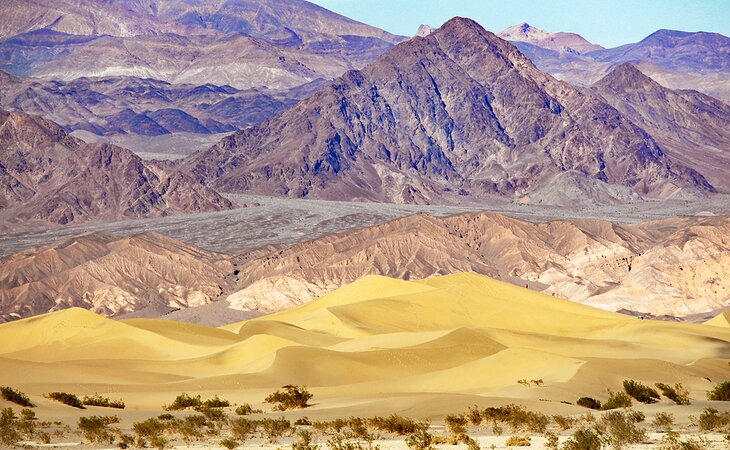
The valley, protected as a national park, covers 3,000 square miles and is known for being the hottest, driest, and lowest point in North America . Roadside lookouts offer stunning panoramas, and hiking trails allow easy access to the terrain.
Many people visit the park on a day trip from Las Vegas . The centrally located Furnace Creek is the main service center in the park and is about a two-hour drive from Las Vegas. This is also where you'll find the park visitor center, campgrounds, restaurants, a store, a gas station, and The Ranch at Death Valley .
On the west side of the park, is Panamint Springs , with a restaurant, gas station, and some limited accommodation. This is a convenient stop if you are entering the park from the west side and a good lunch option if you are visiting Father Crowley Point and Darwin Falls, the two main tourist attractions on this side of the valley.
Determine what you want to see with this list of attractions and places to visit in Death Valley .
Note: Death Valley's roads, trails, and some attractions were badly damaged in August and September by torrential rains. Work is ongoing, and most things should be back up and running by mid-2023.
Also on This Page:
1. sand dunes near stovepipe wells, 2. badwater basin, 3. the racetrack, 4. zabriskie point, 5. dantes view, 6. artist's drive and artist's palette, 7. devil's golf course and artist's drive, 8. harmony borax works and the sand dunes near stove pipe wells, 9. twenty mule team canyon, 10. keane wonder mine, 11. father crowley point, 12. ubehebe crater, 13. rhyolite ghost town, 14. natural bridge, 15. spring wildflowers, 16. devil's cornfield, 17. darwin falls, 18. wild rose charcoal kilns, map of attractions & things to do in death valley, ca, driving routes through death valley national park.
- Organized Tour of Death Valley
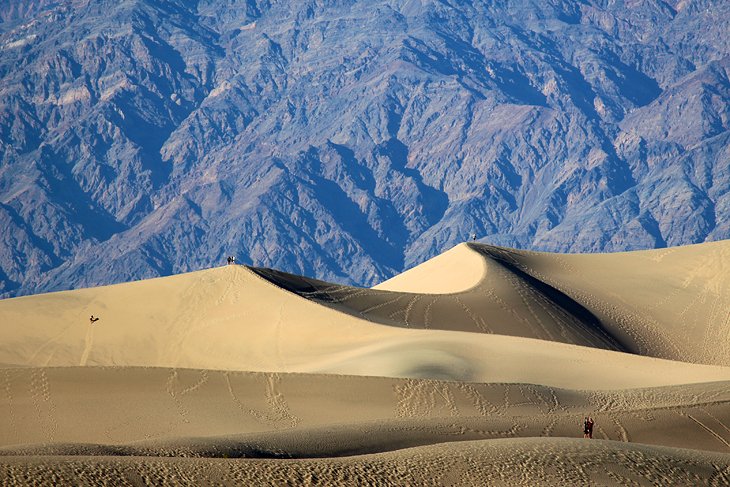
One of the most beautiful sites and most photographed landscapes in Death Valley is the Mesquite Flat Sand Dunes , just east of Stovepipe Wells . In the morning and late afternoon, when the sun hits the sculpted dunes, creating long curving shadows, the views are fantastic. Mountains rise up on the horizon providing the perfect backdrop. For photographers, it's pure magic.
You can walk in the dunes, climb to the highest points, or set up a lawn chair and soak up the desert scenery. On busy days in the spring, there is rarely a dune without a person climbing up or running down, but on quiet days, particularly in January or February, you will likely have the dunes to yourself. If you arrive at the dunes after a windy spell, they will be untracked.
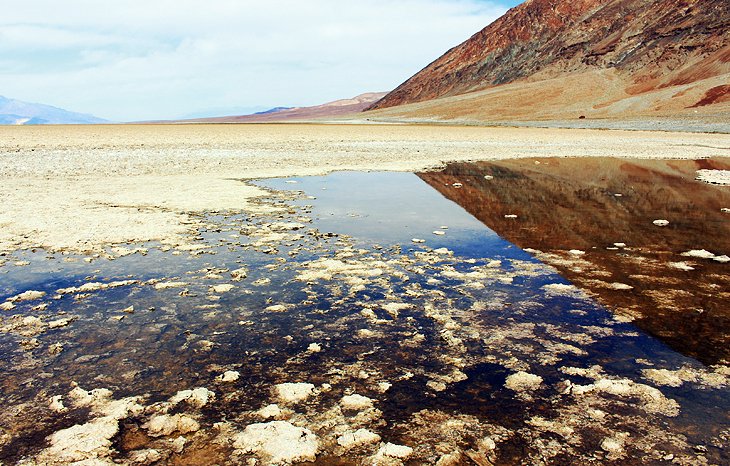
At the south end of Death Valley National Park, Badwater Basin is the lowest point of land in the western hemisphere , at 277 feet below sea level. Needless to say, this area is very hot, even in the winter.
Badwater Lake is a shallow lake surrounded by mountains and rimmed with salt, but you may not always see water here. Depending on the conditions or the time of year, Badwater may be quite full or have very little water. In either case, the area is interesting and there are a number of things to do.
When there is almost no visible water from the shore, you can walk out, seemingly endlessly, across the white salt flat. When there is water, and if the air is still, which it often is in the morning and early evening, the mountains across the valley reflect in the water, and the scene is stunning. This can be a wonderful area for photography. If there is enough water, it's even possible to paddle out on the lake.
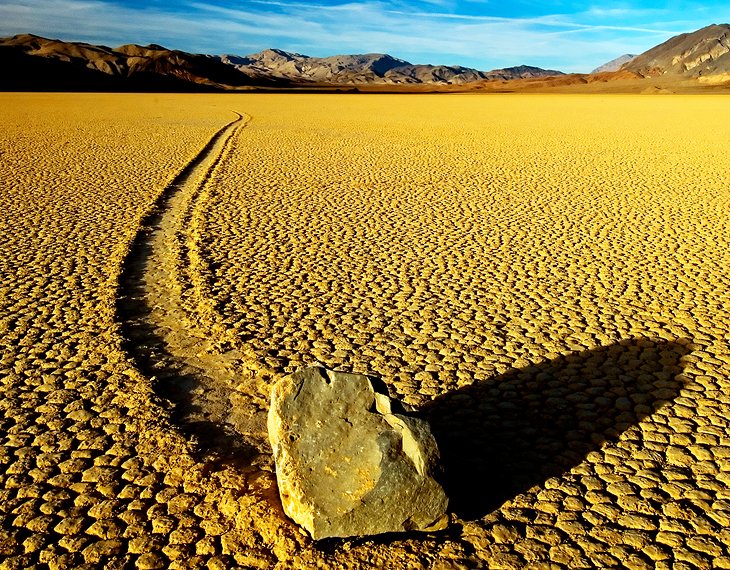
With a four-wheel-drive vehicle , you can take a rugged road that leads to one of Death Valley's most mysterious sights, known as The Racetrack. This area is a huge dried mud bed, where stones of various sizes can be seen with long tracks trailing behind them, as if they have been pushed through the mud.
Speculation existed for years about how the stones were moved. Many thought the stones were pushed along by the wind after rains. However, more recently, with the help of time-lapse photography, it is thought that the stones are actually moved by floating ice pushing the rocks. Regardless of the method, the result is a most interesting sight.
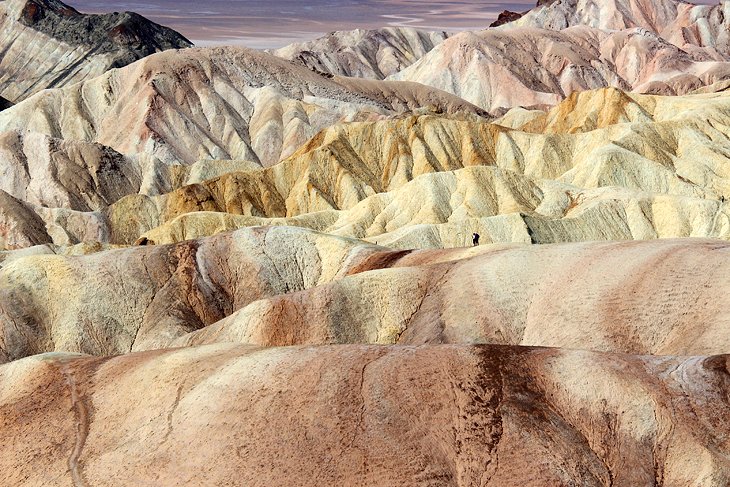
Zabriskie Point looks out over a surreal landscape of undulating, hard-packed ridges of gold, orange, and brown earth. Sweeping views from the lookout extend over this unique formation and beyond to the valley behind and the Panamint Mountains in the distance. The colors are particularly spectacular in the morning or late afternoon.
You can drive to the lookout at Zabriskie Point. A 7.8-mile hiking trail leads out from Zabriskie point, but if you want to get out on the ridges and immerse yourself in the scenery without undertaking a long hike, just wander out a short distance and return on the same track.
You can reach Zabriskie Point by heading east from Furnace Creek on highway 190 for four miles. If you are coming into the park from Las Vegas on the route described above, this is one of the stops on your way to Furnace Creek.
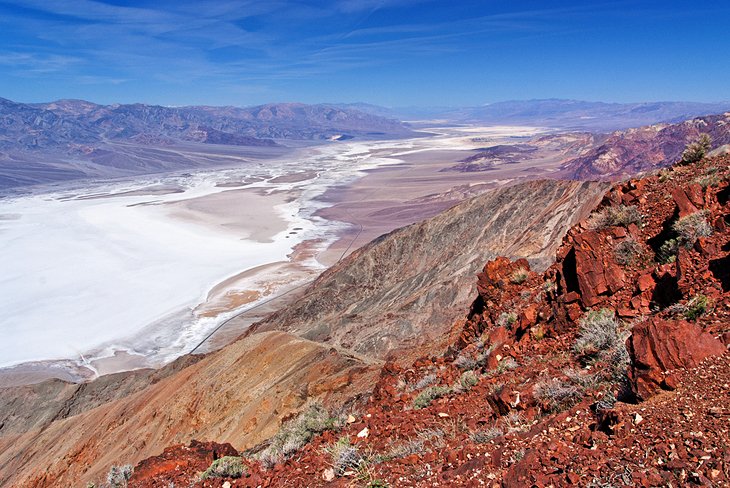
Dante's View offers one of the best overall perspectives of Death Valley. The view from the top looks out over the valley floor, as far as the eye can see, and across to the mountains that line the far side of the valley.
This lookout is a little out of the way but worth the effort. From Zabriskie Point head east on Highway 190 to the sign-posted turn for Dante's View. From the highway, it is a 16-mile drive along a twisty, paved road to the top , which stands at 5,478 feet above sea level. Vehicles on this road must be less than 25 feet in length.
The temperature up here is much cooler than on the valley floor, which can be a refreshing treat on hot days.
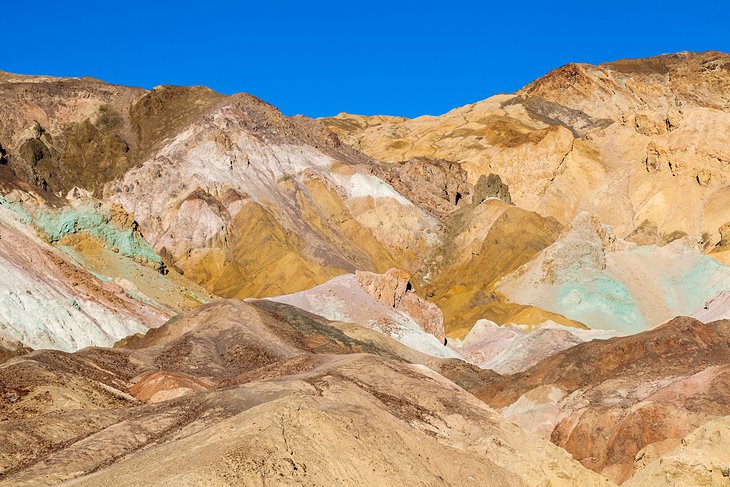
Artist's Palette is an area located along Artist's Drive, a short scenic road that takes you up close to a section of the Black Mountains. Artist's Palette is a colorful section of hillside, with shades that range from orange, pink, and brown to green and turquoise, created by metals in the rock.
Artist's Drive is a one-way, nine-mile paved loop , accessible to vehicles under 25 feet in length. This is a worthwhile side trip and a popular thing to do on the way from Furnace Creek to Badwater, located right off Badwater Road. If possible, try to do this drive in the late afternoon, when the colors are at their best.
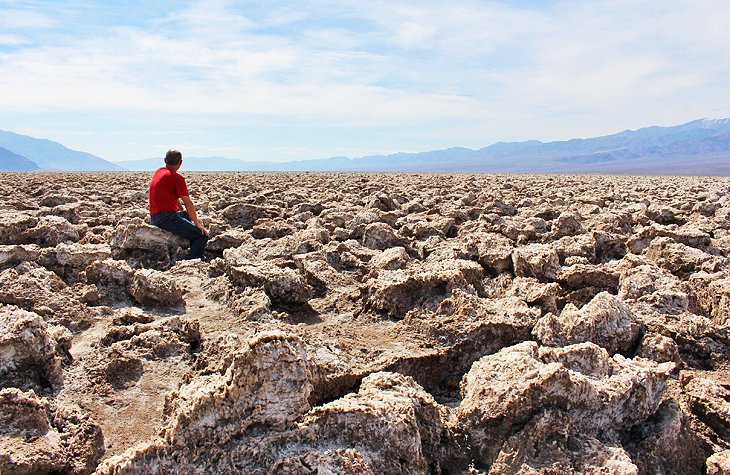
Devil's Golf Course is a flat expanse of sharp salt crystals that form a huge field of jagged salt boulders . It may seem like there isn't much to see here, but the vastness, solitude, and quietness, along with the unusual sight, create a unique experience.
Located south of Furnace Creek, just off the main road heading towards Badwater (Badwater Road) this is an easy stop. From the parking area, you can walk right out onto the field, if you choose.
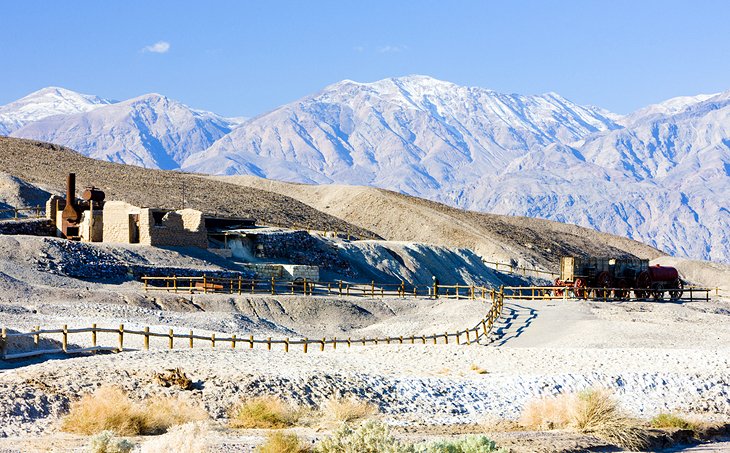
Aaron Winters found borax in Death Valley in 1881. He soon sold his claims to William T. Coleman, builder of the Harmony Borax Works, where borate-bearing muds were refined until 1888. The site of the former operation is located just north of Furnace Creek.
You can wander around the crumbling adobe walls and see the old broiler and some of the vats. Also located here are wagons once used for transporting goods out of the valley. Closed in 1888, this was the first successful borax works in the history of borax mining in Death Valley.
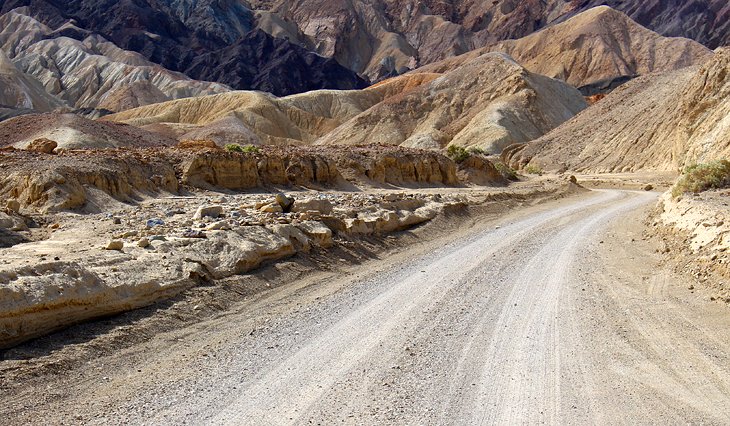
Twenty Mule Team Canyon is a 2.7-mile one-way dirt road that runs through some fantastic scenery. The road is bounded in some areas by rock walls on either side, barren flats, and colorful hills, similar to those found just down the road at Zabriskie Point. The terrain here is different from other parts of the park and reveals the ruggedness of the region.
During the borax days, twenty mule teams were used to haul the borax-filled wagons out of Death Valley, and this road offers some perspective on the type of landscape these vehicles were forced to contend with in the 1880s. However, there is no indication that this specific route was used in this fashion.
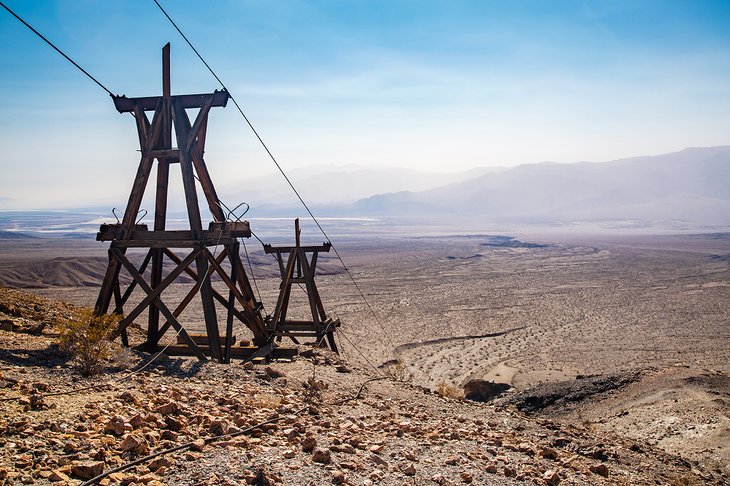
The remains of this historic gold mine can be difficult to get to but worth the effort if you are interested in this type of attraction. You can see the old aerial tramway , which is still intact, along with other structures. The mine is set on a hillside, and views extend across the valley.
Getting to the site involves a drive down a rough dirt road, which is usually passable in a regular vehicle, and a short but moderately strenuous hike from the parking area. The road is just under three miles, and the hike is a quarter of a mile to the lowest section of the tram.
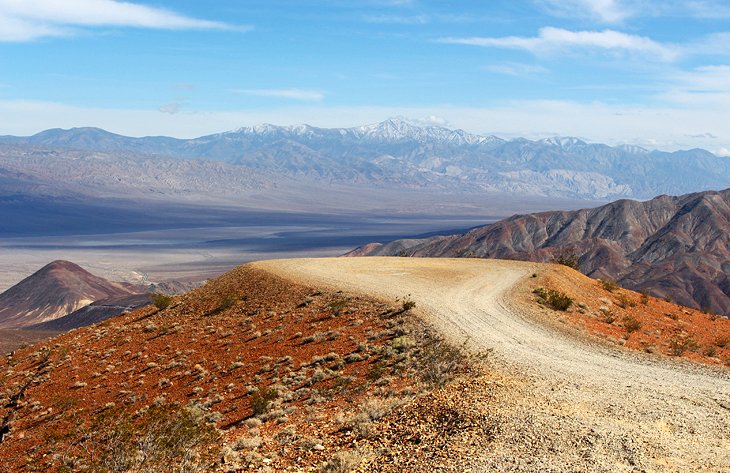
Father Crowley Point is a high lookout on the west side of the park that offers a different perspective than viewing areas on the busier east side of the park. If you are entering Death Valley from the west, Father Crowley Point should be your first stop before the long descent towards Panamint Springs.
There are two parking areas: one right at the overlook and another further back, closer to the highway. The first parking lot is easily accessed right off the main highway, and many people choose to walk the short distance out to the lookout point. The road to the lookout is not paved, quite bumpy, and may require high clearance.
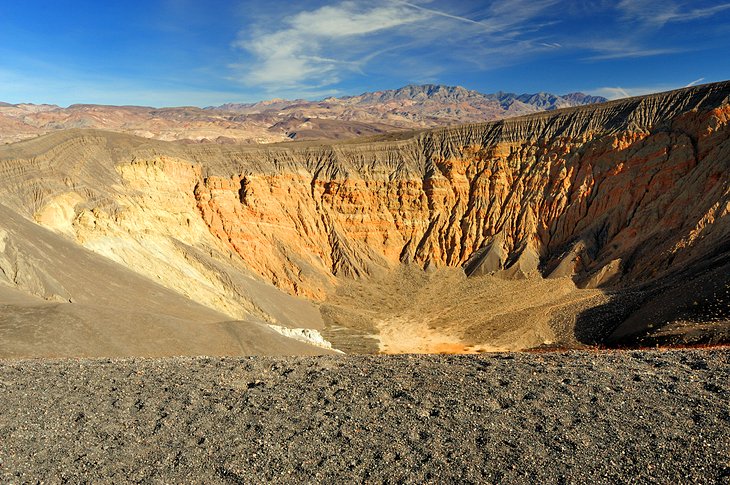
The Ubehebe Crater measures about a half-mile wide and 400 feet deep, and it is the only crater in the area that resulted from a volcanic explosion . It is located at the north end of Death Valley, in the general vicinity of Scotty's Castle, which is closed due to flooding.
The landscape here is different from other areas of the park. The ground is dark, with lava flows and cinders. If you are feeling up for a walk, trails lead down into the crater.
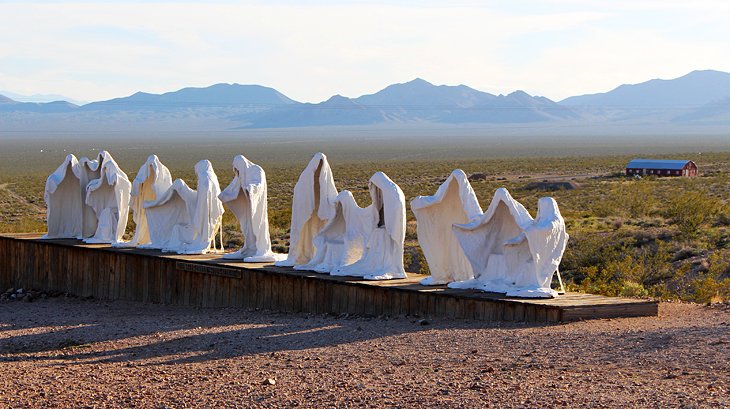
Rhyolite is an abandoned mining town, with remnants of its glory days visible in the crumbling and decaying old buildings. One of the highlights of this ghost town is a unique art installation of ghostly figures erected on the edge of the town. One large piece, standing before a vast expanse of desert, displays ghosts arranged in the form of The Last Supper .
Other pieces are also found here, in what is now called the Goldwell Open Air Museum , including a giant pink lady made of blocks, called "Lady Desert: The Venus of Nevada."
Rhyolite is a good stop on your way out of the park. It is located off Daylight Pass Road (highway 374) just outside the park boundary, on the way to Beatty.
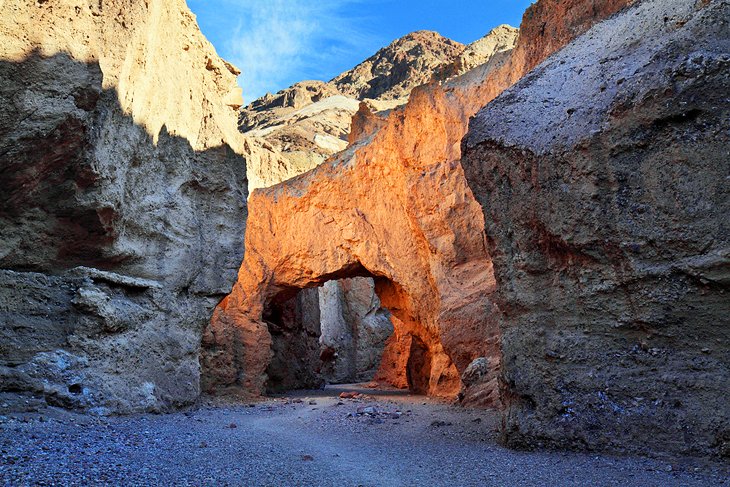
Natural Bridge is, as the name suggests, a large natural bridge set in a canyon, not far from Badwater.
An easy two-mile round-trip hike leads to the end of the canyon, but if you only want to see the bridge, it is located about half a mile from the parking area . In the midday heat, this can still feel like quite a journey, and it may be something you want to tackle earlier in the day. The parking area is located 1.5 miles along a dirt road off Badwater Road.
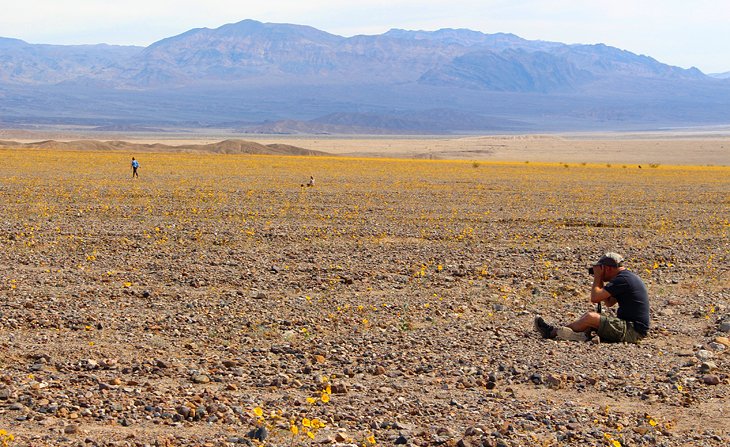
One of the park's biggest attractions is the spring wildflower bloom, which usually peaks in March . Depending on the year, the conditions, and the extent of the bloom, this event can draw thousands of people to the park. To anyone unfamiliar with deserts, it might seem amazing that anything can grow in these hot dry conditions.
On weekends during the bloom, it's not uncommon to see people pulled off to the side of the road all over the park, picnicking on the bare ground, meditating among the flowers, or walking through the fields. Despite the fact that people do this, you should not walk out in the fields and trample the flowers.
One of the best places to visit to see this beautiful display is in the south part of the park around Badwater and up towards Furnace Creek , where a carpet of yellow spreads across the valley floor. Areas further north also see a good display of flowers, usually with a mix of colors that range from white and yellow to orange and purple.
The park visitor center can point you in the right direction and offer information on what is blooming while you are in the park.
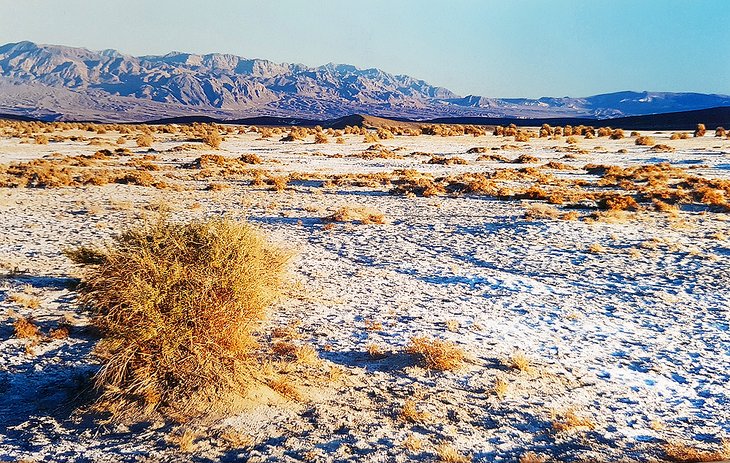
Compared to the rest of the sights in Death Valley, Devil's Cornfield is not necessarily worth going out of your way to see, but it's a sight you will pass if you are driving from the east to Stovepipe Wells and the sand dunes.
Clumps of vegetation that look like tumbleweeds dot the landscape as it stretches out to the distant hills and mountains. Depending on the time of year, the shrubs may be green or dried out to an amber color. Photographers can have some fun in this area, particularly in the late afternoon.
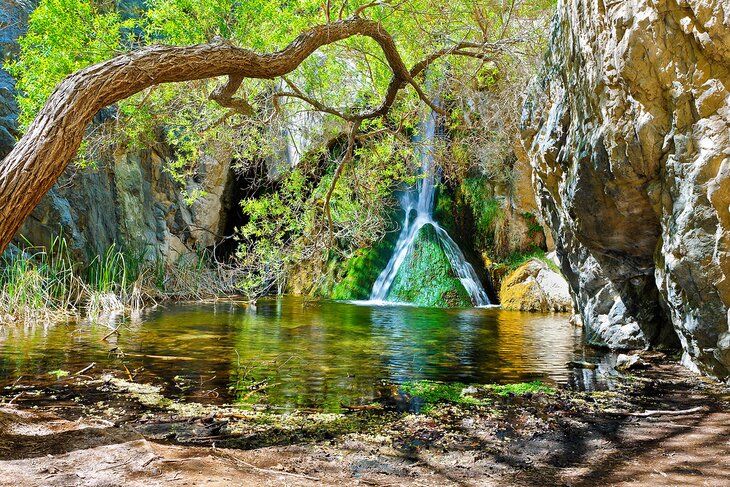
After your trip, when you tell your friends about your experiences in Death Valley and include the fact that you visited a waterfall, they may think you are trying to play a joke on them. However, break out the photos and show them that this amazing natural wonder actually exists.
The trail is 1.9 miles long and with an elevation gain of only 275 feet , most people consider it fairly easy and suitable for all abilities. You'll start out at a valley entrance and as the trail progresses, it gets increasingly narrow. You'll hear the falls before you see them. Although not overly high, the flowing water with a pool below is a very welcome sight in the desert.
Note the trail was damaged during the August 2022 floods. It is still passable but caution is advised.
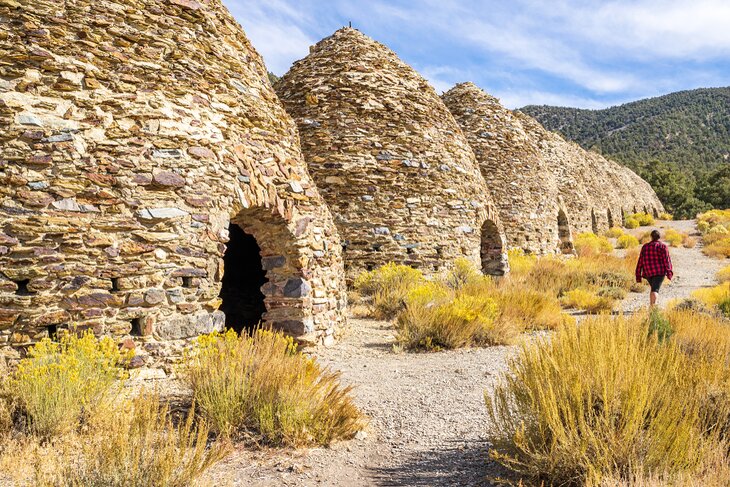
An off-the-beaten-track attraction that, if you have the right vehicle, is worth visiting is the Wild Rose Charcoal Kilns. These beehive-shaped stone structures are in remarkably good shape considering that they were used back to make charcoal when the park area was a mining hot spot at the turn of the 20th century.
The Wild Rose Charcoal Kilns have doors that are open, and you can wander freely in and out of the structures. It's more than likely that you'll have this remote spot to yourself — the road is notoriously bad and suitable for high-clearance 4WD vehicles , only.
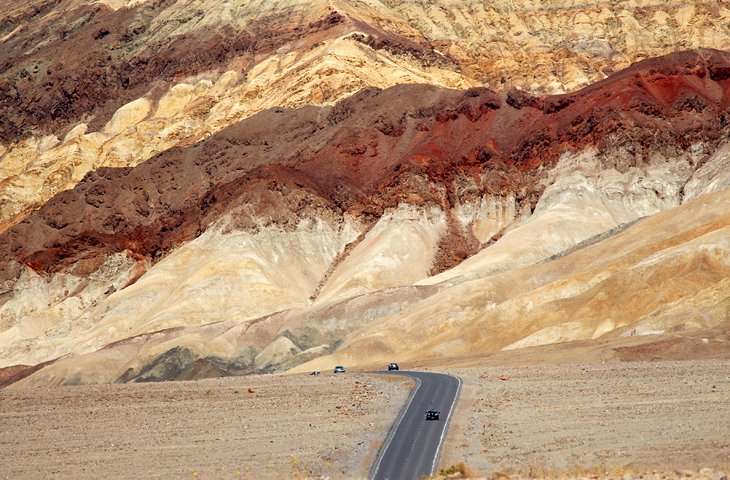
Most visitors come either from California, entering from the west off Highway 395 onto Highway 190, through Panamint Springs, or from Las Vegas, where there are a couple of routing options.
From Las Vegas: You can easily visit Death Valley on a day trip from Las Vegas . The best way to do this is to head out on Highway 160 (leaving from the south end of Las Vegas) to Death Valley Junction, where the road becomes Highway 190, entering the park. This road runs past the turnoff for Dante's View , Twenty Mule Canyon, and Zabriskie Point, and on to Furnace Creek with a park visitor center and some amenities.
From Furnace Creek you can head south to Badwater , passing the pullouts for Desolation Canyon, Artist's Drive (Artist's Palette), Devil's Golf Course , and Natural Bridge . When you have visited Badwater, backtrack via Furnace Creek and beyond to the Harmony Borax Interpretive Trail, Mustard Canyon, and the Sand Dunes near Stovepipe Wells .
If you started early in the day and still have plenty of time, you may want to continue on. It's a little over a half-hour to Panamint Springs and another 20 minutes to Father Crowley Point . After this, you can turn around and head back to Stovepipe Wells, and out of the park on the Daylight Pass Road (374) that leads to Beatty.
Before getting to Beatty, stop at the Rhyolite ghost town to see the ruins of this old mining town and some creative art installations. From Beatty take Highway 95 back to Las Vegas.
If you have time for a second day in Death Valley , you can spend the night in the park or in Beatty. With two days, you'll be able to add on a visit to the Race Track and a few more stops for hiking and sightseeing.

More on California
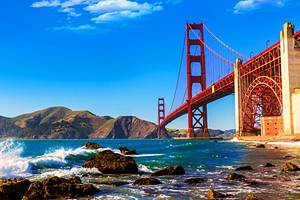

The 14 Most Incredible Things to Do in Death Valley National Park
By: Author Riley (The Parks Expert)
Posted on Published: July 31, 2021 - Last updated: October 21, 2021
Categories Death Valley , California , National Parks , Things to Do

As the largest national park outside of Alaska, Death Valley has a lot to offer. The name implies that there isn’t much to see, but this park is full of life and there’s a wide variety of things to do in Death Valley.
You’ll be amazed by the slot canyons, sand dunes, salt flats, deserts, mountains, and so much more on any trip to Death Valley. It’s also the park of superlatives hosting the nation’s lowest point (282-feet below sea level), the hottest temperature on record (134°F/57°C), and the driest desert (Mojave). You’ll find plenty of things to see in this mind-blowing place. Here are 14 amazing things to do in Death Valley National Park .
This post may contain affiliate links. If you make a purchase, I may earn a small commission at no additional cost to you. For more information, view my privacy policy .
Table of Contents
Logistics of Visiting Death Valley National Park

Before we get into the best things to do in Death Valley , let’s look at the logistics of visiting the park.
Where is Death Valley? Death Valley National Park is located in southeastern California on the border of Nevada. The park is north of Joshua Tree and Mojave Preserve and east of Sequoia and Kings Canyon National Parks.
How much does it cost? There is a park entrance fee of $30 per vehicle or $15 per person if you enter the park on foot or on a bicycle. This fee is valid for seven days. If you have a current America the Beautiful pass, this fee is waived. The park entrance fee does not include fees for tours, camping , lodging, or other services.
Prepare for desert conditions. It’s hot and dry! Make sure you drink plenty of water, no matter what time of year you visit. Dehydration is nasty anywhere, but Death Valley is especially remote. Be safe and take care of yourself when you visit. Furthermore, when the rare rains fall, flash floods can occur. Be prepared to move to higher ground at any time if it begins to rain.
Drive safely. Follow the posted speed limits; many accidents have occurred on the park’s remote roads when assistance is very far away. Drive on designated roads only. Off-roading is illegal . Many roads are unpaved, dirt, or gravel and 4WD, high-clearance vehicles are recommended.
Map of Things to Do in Death Valley National Park

You can click on the map above to view and download the map of things to do in Death Valley in its entirety. If you’re interested in a detailed map of the Furnace Creek area, click here to download one.
The Best Things to Do in Death Valley National Park

1. Badwater Basin

Of all the things to do in Death Valley, this is definitely the main attraction in the park.
Badwater Basin is the lowest point in North America at 282-feet below sea level. There’s a small parking area here, a boardwalk, and a trail to the salt flats. I highly recommend walking the trail into the basin. There, you can see the white hexagon shapes that spread in all directions.
You can also see some outstanding views from here, looking up to the surrounding mountains. Views are best later in the day when the sun is shining on the mountains.
Don’t forget to take your typical tourist photo with the sign! Depending on the crowds, there may be a line of people waiting.
Look closely at the mountain behind the parking lot and you might spot the sign for sea level.
Distance from Furnace Creek : 30 minutes one-way
2. Zabriskie Point

Another one of my favorite things to do in Death Valley, the area around Zabriskie Point is stunning. The main attraction is the rock formation above, juxtaposed by the mountains in the distance. You can also walk a trail below these badlands to take it in from a different angle.
Zabriskie Point is probably most famous for its incredible sunrises and sunsets. Photographers will flock here to snap the perfect shot, so arrive early if you’re hoping to do the same.
From the parking area, you’ll walk a short 1/4-mile paved path to the viewpoint. Another one of Death Valley’s main things to see, you’re basically required to stop here at some point during your visit. There are great hiking trails through the badlands as well.
Distance from Furnace Creek : 15 minutes one-way
3. Devils Hole
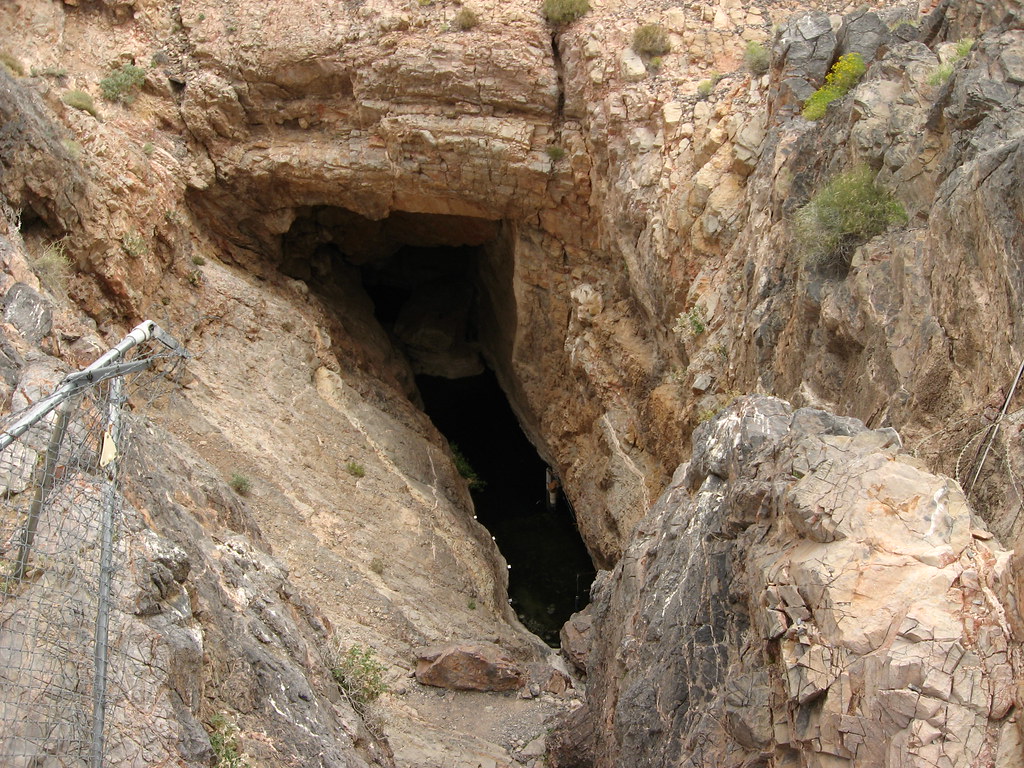
Did you know that there are special species of Pupfish that only live in one small pool?
Here, at a satellite area of Death Valley National Park in Nevada, you’ll find the only home of the Devils Hole pupfish in a pool of water that remains a consistent 93°F.
The Devils Hole pupfish is extremely small and resilient. They are considered critically endangered due to their extremely limited habitat. Attempts have been made to create additional habitats for them, but none have succeeded. In 2013, there were only 35 known to exist. As of 2019, the number has increased to 136.
This is one of the more unique things to do in Death Valley National Park, and one of the least common. This is a great option if you want to avoid crowds. It is a bit farther from the other attractions in the park, so I would save it for when you have extra time.
Distance from Furnace Creek : 37 miles one-way
4. Artists Drive And Artists Palette

When driving back to Furnace Creek from Badwater Basin, take a detour on the one-way Artists Drive. One of the best things to do in Death Valley, I promise you won’t regret the extra mileage.
On the 9-mile drive, you’ll find your jaw falling open as you marvel at the colorful hills. Stop at Artists Palette (pictured above) along the drive to get out and walk around.
Various scenes from the Star Wars IV : A New Hope , like when R2-D2 gets kidnapped by the sand people, were also shot around this area.
This is something you seriously can’t miss when you visit Death Valley.
More Information on Star Wars Filming Locations: click here
5. Devils Golf Course

Near Badwater Basin is another out-of-this-world landscape, the Devils Golf Course. It was named because the terrain is so difficult that only the Devil could play golf here.
Years and years ago, a lake called Lake Manly was located here but has since evaporated. Based on scientific research, it’s possible that these salt and gravel beds have a depth of 9,000 feet!
You’ll take an unpaved road to the parking area, then walk a short, easy distance for the best views. The road is usually suitable for vehicles with 2-wheel drive, but check with park rangers in Furnace Creek to be sure.
Distance from Furnace Creek: 30 minutes one-way
6. Dante’s View

This is one of the most breathtaking scenes in Death Valley that is easily accessible by car.
From the top of Dante’s View, you can see both Telescope Peak and the Badwater Basin, the highest and lowest points in the park, respectively. You can also see a rift in the earth’s crust where the mountains are (slowly) moving in opposite directions.
There is an ADA-accessible viewing platform that is only a short distance from the parking area.
You may also recognize this view from Star Wars IV: A New Hope . This is where Luke Skywalker, Ben Kenobi, and the two droids stop at a cliff and peer over Mos Eisley. In reality, there are no cantinas here, only saltwater basins.
On our trip, we stopped here on our way out of the park and it was the perfect way to say goodbye after two days in Death Valley . After exploring many of the best things to do in Death Valley, consider coming here and overlooking the terrain you’ve traversed.
It’s also another great place for sunset or sunrise.
Distance from Furnace Creek : 1 hour one way
7. Mesquite Flats Sand Dunes

If you’ve ever wanted to take some epic, so-cool-they-seem-fake photos on some sand dunes, this is one of the best things to see in Death Valley.
You’ll pass the Mesquite Salt Flats on Highway 190 on your way to/from Panamint Springs. While you can see the sand dunes from your vehicle, the best way to experience them is to get out and hike around. You’ll drive down a short, unpaved road to a small parking area to begin your walk. The road is decent and usually okay with a 2WD vehicle. If you have the appropriate vehicle, you can also visit the Panamint Dunes for a less-crowded option.
8. Keane Wonder Mine
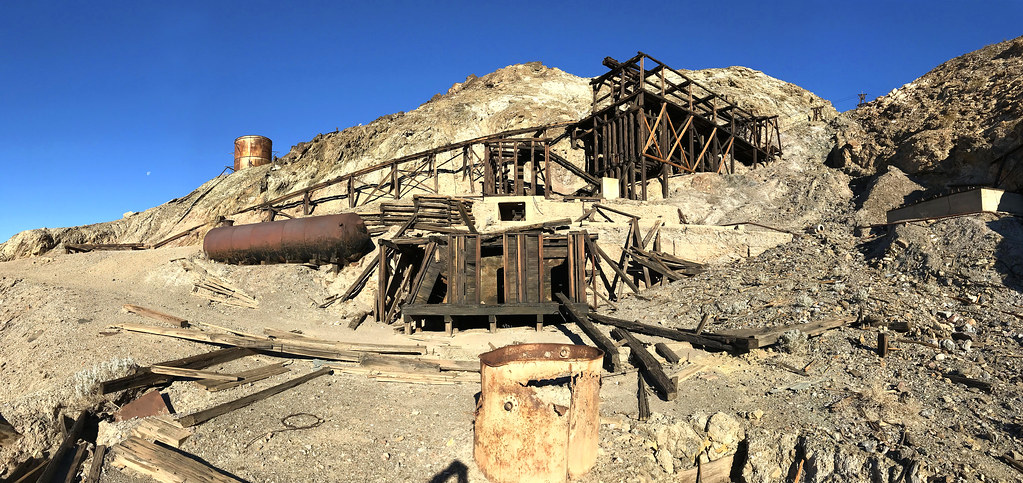
This historic gold mine is over 100-years old, and its trams used to carry up to 70 tons of gold in one day.
You may notice on the map of things to do in Death Valley that this site is currently closed. That may be true for sections, however, there are still other remnants to check out.
Near the parking lot are the Keane Wondermill and Tramway Area, the sites of the mine and camp.
If you do decide to visit, beware of hazards in the area and read this before you go. The road can be rough, so you may want to stop by the Furnace Creek Visitor Center to check conditions before you go.
Distance from Furnace Creek : 35 minutes one-way
9. Rainbow Canyon

If you enter Death Valley National Park on the western side near Independence, you’re in for a treat.
On your way from Independence to Furnace Creek, this is one of the most beautiful places to see in Death Valley. Known to some as “ Star Wars Canyon” and others as “Jedi Transition”, the true name is Rainbow Canyon.
The U.S. Air Force and Navy both use the canyon for low-flight training, and if you stop by you may be lucky enough to watch. There is no public schedule, so you have to luck out with your timing. If you see a plethora of cameras and tripods set up as you drive by, that’s a good sign a flight may take place.
You’ll park near an overlook called Father Crowley Vista Point and take in the view. Even if planes aren’t flying, the scenery is spectacular.
Distance from Furnace Creek : 1.5 hours one-way
10. Ubehebe Crater

This 600-feet deep crater is what remains after a massive volcanic eruption hundreds of years ago. It’s also over a 1/2-mile wide! The volcanic magma mixed with an underground spring causing the water to become steam resulting in such high pressure that an explosion occurred.
This is one of Death Valley’s most stunning geologic features. It’s a bit out of the way and far from other attractions in Death Valley, but worth the trip if you have time.
11. Mosaic Canyon

One of my personal favorite things to do in Death Valley is the hike through Mosaic Canyon. While the trail can be difficult, you only need to hike the first 1/2-mile or so to see some of its most beautiful twists and corners.
You’ll need to drive on an unpaved road to reach the parking area.
This hike can be extremely narrow, and may not be best for people with claustrophobia. There’s also limited shade and no water, so come prepared. For more information and a map, check out this page .
Distance from Furnace Creek : 45 minutes one-way
12. The Racetrack Playa

Of all the attractions in Death Valley National Park, Racetrack Playa may be the most famous.
You’ve undoubtedly heard of the mysterious sailing stones at some point. For years, no one knew what caused these stones to move and leave their “racetracks” behind. In 2017, a documentary was released explaining the cause and how it was discovered (spoiler alert: wind). The area is dry nearly year-round with no vegetation, making the scene even more striking.
The unpaved road to the Racetrack can be very rough. It is essential that you have a high-clearance vehicle to reach the Racetrack, and 4-wheel drive is recommended but not always necessary. Bring extra tires with you as well; many flat tires have been reported on this road. As always, check with Park Rangers for the latest conditions.
Distance from Furnace Creek : 3 hours one-way
13. Scotty’s Castle

Another famous landmark in Death Valley is Scotty’s Castle. While Walter Scott (or “Death Valley Scotty”) claimed to have built the castle with money made from his secret mines, the true artist was Albert Johnson. He built it as a vacation getaway for him and his wife, Bessie.
Sadly, in 2015, damage from horrific flash floods resulted in a closure of Scotty’s Castle. One room in the castle was covered in mud four feet deep!
After restoration work, it was partially re-opened in early 2020. As of this posting, tours are required and only available at certain times of the year. The tours focus on flood recovery. They can be booked here , and fill up quickly.
Distance from Furnace Creek : 1 hour one-way
14. Wildrose Charcoal Kilns

After all of our talk about Star Wars in this post, it may surprise you to learn that this was not one of the filming locations. The minute I saw these huts, I thought of the Star Wars films. They seemed like the perfect homes for reclusive Jedi on Tatooine.
Located in Wildrose Canyon, the kilns were built in 1876 to provide fuel to process silver and lead ore. Today, they’re some of the best-preserved kilns in the Western United States. When you enter, you can still smell the scent of burns.
Driving to the Kilns is one of the best things to do in Death Valley that is off the beaten path, but worth the trip for the scenery and cultural history. It’s also on the way to some great hikes in the park . If you have the time, it’s worth a visit.
Where to Stay in Death Valley
There are a total of five lodges within the park.
- The Ranch : Of the hotels in Furnace Creek, this is the significantly cheaper option. It’s an older hotel, but the location can’t be beaten.
- The Inn : This 4-star hotel is much nicer than the Ranch, and therefore twice as expensive. Be prepared to shell out the cash for any luxury. Located in Furnace Creek.
- Panamint Springs Motel : This place doesn’t have great reviews, but if you’re hoping to save money it may be your best option. Located in Panamint Springs.
- The Inn Casitas : The third property in Furnace Creek is also the newest.
- Stovepipe Wells : There’s a hotel, restaurant, and gift shop located in this small complex just a few minutes north of Furnace Creek in Stovepipe Wells.
Camping in Death Valley National Park

In total, there are nine campgrounds in Death Valley National Park . By far, this is the cheapest lodging in Death Valley. You can read more about the campgrounds here .
- Furnace Creek : This is the only campground that accepts reservations (during the peak winter season). It is open year-round.
- Sunset and Texas Springs : These campgrounds are also located in Furnace Creek.
- Stovepipe Wells : This is another year-round campground in the park. It’s about 30 minutes away from Furnace Creek if you’d like a little quiet but don’t want to be too far away from the center of the park.
- Mesquite Springs : About 1 hour and 15 minutes from Furnace Creek for a more remote experience. Open year-round.
- Emigrant : This is a tents-only campground about 40 minutes from Furnace Creek.
- Wildrose, Thorndike, and Mahogony Flat : Typically closed in winter due to snow, but open in the summer season. Located at higher elevations for some cooler air.
What to Pack for Exploring Death Valley
I’m a big believer in guidebooks. My favorites are the ones written by Lonely Planet as they’re the most detailed while also managing to be the most concise. I have the National Parks guidebook below as well as the USA guidebook and many other worldwide destinations. I download the e-books and then they’re with me everywhere I go on my travels, significantly lightening my load.
I also carry (and collect) the Trails Illustrated maps of national parks. They’re sturdy, waterproof, and provide a great overview. If I’m backpacking or hiking, I’ll purchase a topographic map that is centered on the area I’m in so that I have more detail. But for road tripping or to have the big picture in your hands, Trails Illustrated is the way to go. They create maps for U.S. National Parks as well as international destinations.
Some more favorites include the Falcon Guides for hiking . These detail everything you need to know from how to get to places, trail distances, and elevation changes. Moon Guides are my runner-up to Lonely Planet but still have great information. Last but not least, I love learning about the places I visit by reading about them. I’ll do this through books or vehement internet research, but there’s just something about holding that book in your hands, am I right?
Purchase some of my recommendations below. You can also find more Death Valley-related books and souvenirs on the official website .

Death Valley National Park Phone Case

Death Valley National Park Pennant

Fodor’s Guide to the 63 National Parks

Women’s National Parks Checklist T-Shirt

Map of National Parks T-Shirt

Death Valley National Park Sticker

Death Valley National Park Pin

Death Valley National Park Patch

63 National Parks Water Bottle

Death Valley Sticker

California National Parks Face Mask

Death Valley National Park Map
The 10 hiking essentials.
Every hiker should always carry the ten essentials with them. These include:
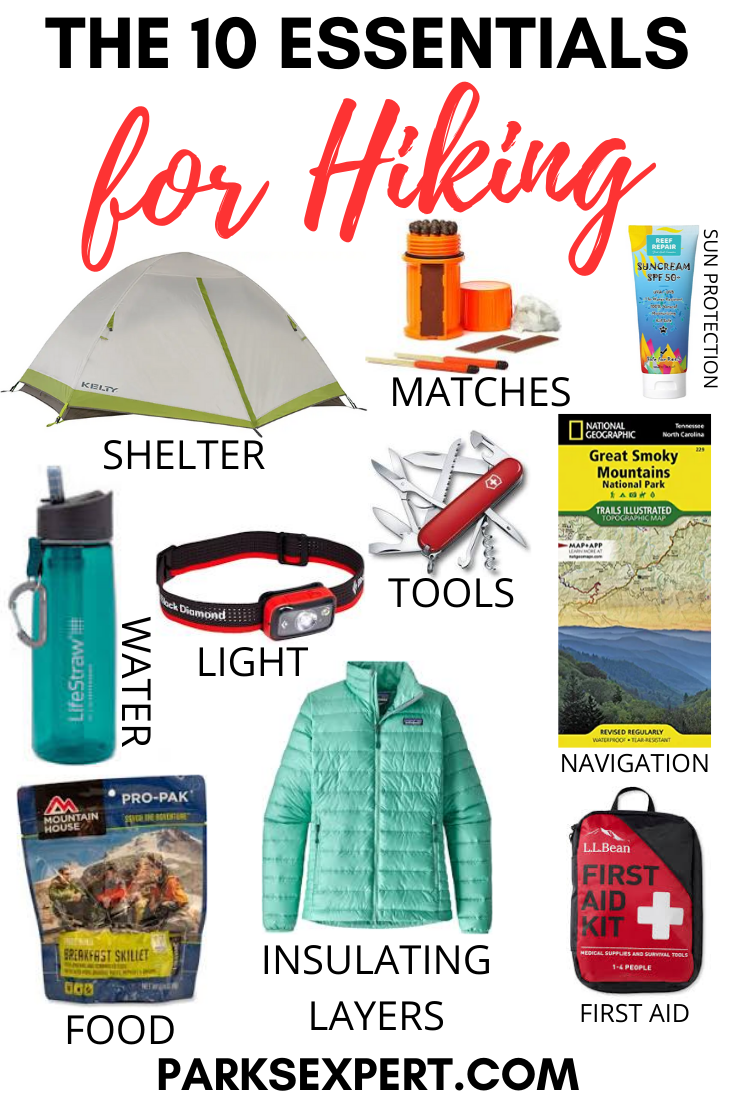
- Navigation systems: map , compass , and/or GPS
- Sun protection: sunscreen and/or ballcap
- Insulating layers: synthetic or down jacket, rain jacket , hat , gloves , and leggings
- Illumination ( flashlight or headlamp )
- First-aid kit
- Something to light a fire: lighter , waterproof matches , and/or fire starter
- Repair kits and tools: pocket knife , duct tape, screwdriver, and/or scissors
- Emergency shelter: tent , bivy , tarp, and/or space blanket
- Nutrition: food for both meals and snacks
- Hydration: water bottle , water treatment ( LifeStraw or SteriPen ), and water
For camping, you’ll want to make sure you pack the basic supplies.
- Tarp or ground cover
- Sleeping bag
- Sleeping pad
- Camp pillow
- Light source: flashlight , lantern , or headlamp
- Cook set , stove , utensil , and fuel
For more of my recommendations, check out my posts on my favorite outdoor gear and best daypacks for women .
Pin Top Things to Do in Death Valley National Park
Well, there you have it – the best things to do in Death Valley National Park . What are your favorites? Is there anything I missed?

Leave a comment Cancel reply
Your email address will not be published. Required fields are marked *
Save my name, email, and website in this browser for the next time I comment.
This site uses Akismet to reduce spam. Learn how your comment data is processed .
Excellent post with quality content! I can’t wait for my trip one day!
Thank you! I hope you get to visit soon.
This is on my bucket list!!! Thanks for the tips and beautiful photos! Keeping this post for later! 🙂
I hope you make it there one day – it’s unbelievable!
I have wanted to visit Death Valley for years, but haven’t made it there yet. The landscape is incredibly striking and the camping looks good too!
It truly is like no place else! I hope you make it there soon.
What a stunning area! I realize there is a lot of life there, but it does look very empty and rocky when you are used to the greens of the Pacific North West.
I really love the names of the places and landmarks! I mean, Dantes View, Rainbow Canyon and Devils Golf Course!? The early settlers had great sense of humor.
It’s a whole different world of life 🙂 There are so many more super creative names! So many go along with the death theme, it’s super interesting.
Death Valley NP looks so interesting. My husband and I are trying to take our kids to as many national parks as we can before they leave home so we’ll most likely visit one of these days.
It was spectacular! There’s so much more to do that lists like this could never encapsulate everything. Truly a gem of the National Park system.
17 Best Things To Do in Death Valley National Park, California
Disclaimer: This post contains affiliate links. At no cost to you, I might earn a small commission if you make a purchase through the links in this article.
Death Valley National Park is known for its many superlatives:
The hottest, the driest, the lowest, the largest.
Death Valley in California is the largest national park in the lower 48 states with over 3 million acres of protected wilderness (only behind Denali in Alaska). It also holds the record for the highest temperature in the world, 134 Fahrenheit which was set in 1913.
Recently, the hottest temperature recorded in Death Valley was 130 degrees in August 2020.
At first glance, you might think that Death Valley is not more than a huge swath of the desert with nothing to offer, but it’s just not true! Death Valley has many awesome hikes, scenic vistas and great biodiversity.
If you are planning your itinerary and are wondering about some of the best things things to in Death Valley, this guide got you covered. Whether you plan to spend one day in Death Valley or the entire week, you will not run out of things to do.
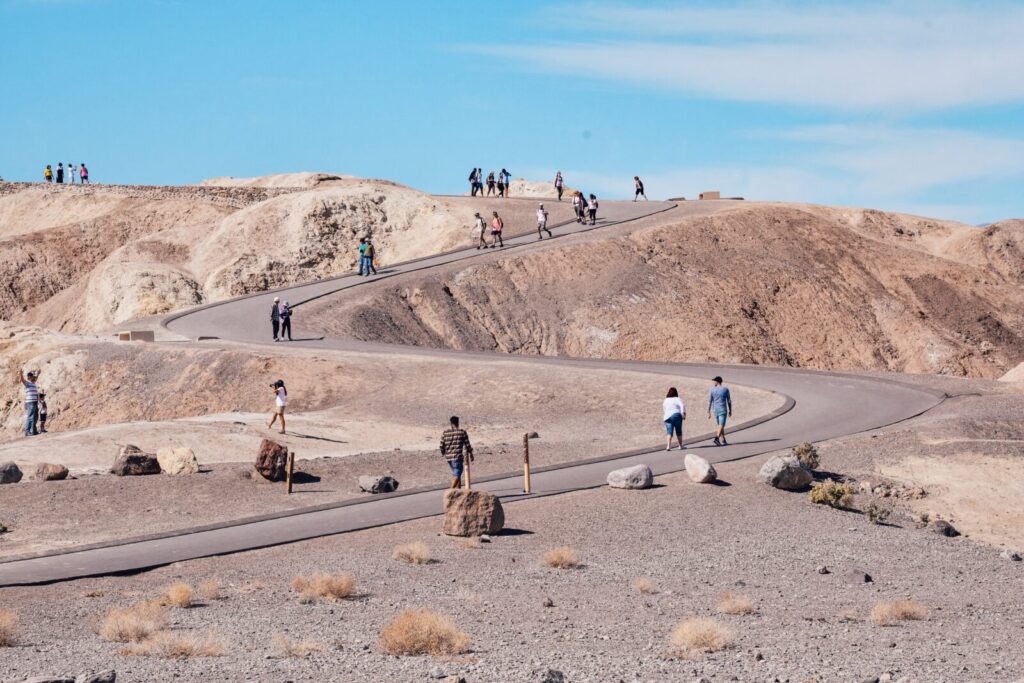
Where is Death Valley?
Most of Death Valley National Park is in southeastern California, near the Nevada border. It’s about 130 miles (2 hours) away from Las Vegas, making it one of the most popular day trips from Sin City, and 258 miles (4 hours and 15 minutes) away from Los Angeles.
Best things to do in Death Valley: a complete overview
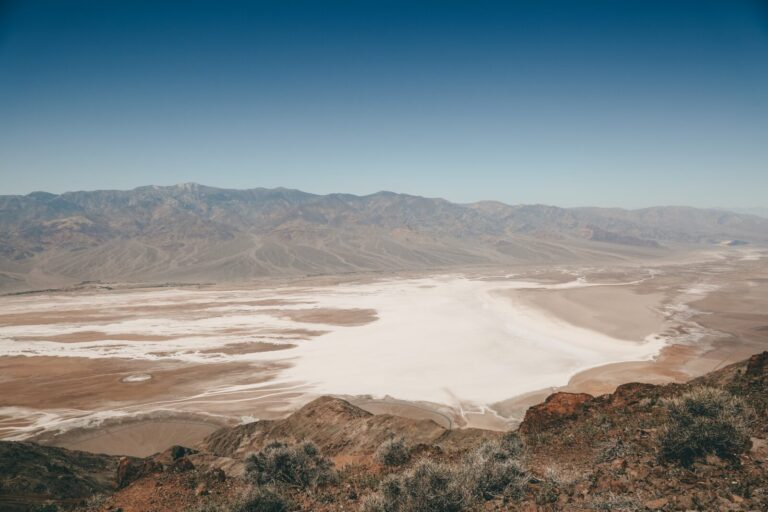
1. Dante’s View
Driving to the highest point, Dante’s View is one of the most incredible things to do in Death Valley and an unmissable stop on your Death Valley itinerary.
To get there, make a left turn on Furnace Creek Wash Road after entering the park from the east and continue for the next 13 miles on the road that gradually goes up a steep hill.
Dante’s View is one of the best photo spots in Death Valley that opens a panoramic view of the salt flats framed by the dark Panamint Mountains. Don’t forget to bring a jacket because windchill can be really strong here.
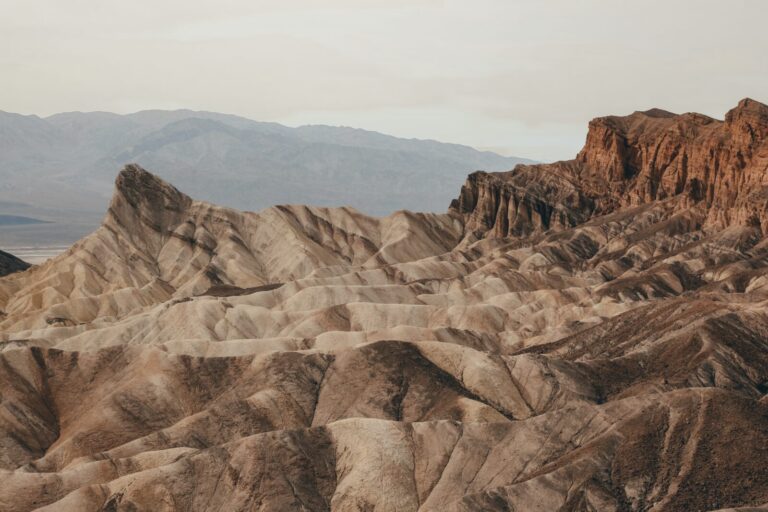
2. Zabriskie Point
One of the most popular stops on many visitors’ Death Valley itinerary, Zabriskie Point is a platform where you can see the badlands formed by erosion of the lake that was here millions of years ago.
A hiking trail below Zabriskie Point goes to Gower Gulch and Golden Canyon and can be accessed from the side of the main trail.
The history of Zabriskie Point dates back to the time when prospectors were mining borax (or white gold of the desert) in the area following its discovery during the California Gold Rush era, and you can read about it when you get to the observation platform of Zabriskie Point.
3. Sunset watching
Sunset watching is one of the most popular things to do in Death Valley, and for a good reason! There’s nothing like the spectacular red, orange and pink colors lighting up the sky. My favorite place to watch the sunset in Death Valley is Zabriskie Point where you can enjoy a stunning panorama of the area in soft glow.
4. Twenty Mule Team Canyon
Located near Zabriskie Point, Twenty Mule Team Canyon is an often-missed spot and one of the most underrated things to do in Death Valley. It is essentially a 2.7-mile road that features some incredible scenery and is surrounded by rock walls, mesas and hills. This road was named after twenty mule teams that were used to transport borax out of Death Valley by wagons.
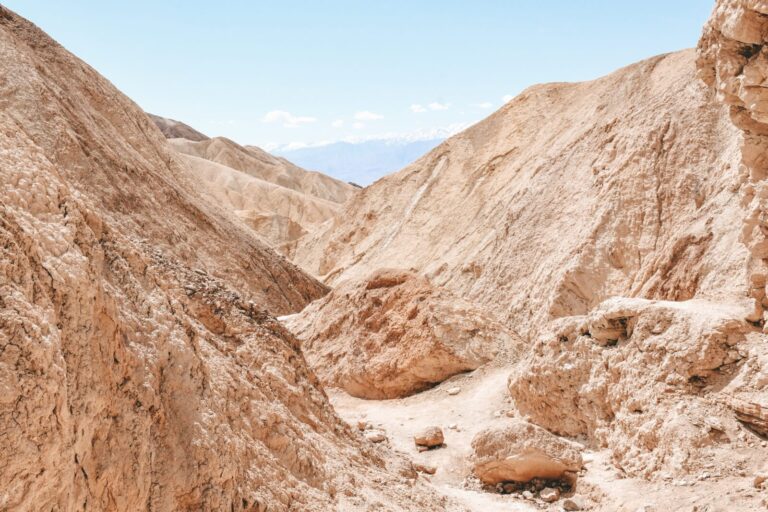
5. Golden Canyon
Continue driving on California State Route 190 and make a left turn on Badwater Road. Your first stop will be Golden Canyon that takes you to Zabriskie Point through the golden-colored hills.
If you don’t want to bake in the heat, take a moderate hike from Golden Canyon to Red Cathedral that is about 3 miles.The Golden Canyon will take you up the narrow trail surrounded by the towering walls. You will have to scramble up the rocks a few times and duck under the ledges.
Hiking through Golden Canyon is one of the best things to do in Death Valley if you want to escape the crowds, as only a few people venture out here.
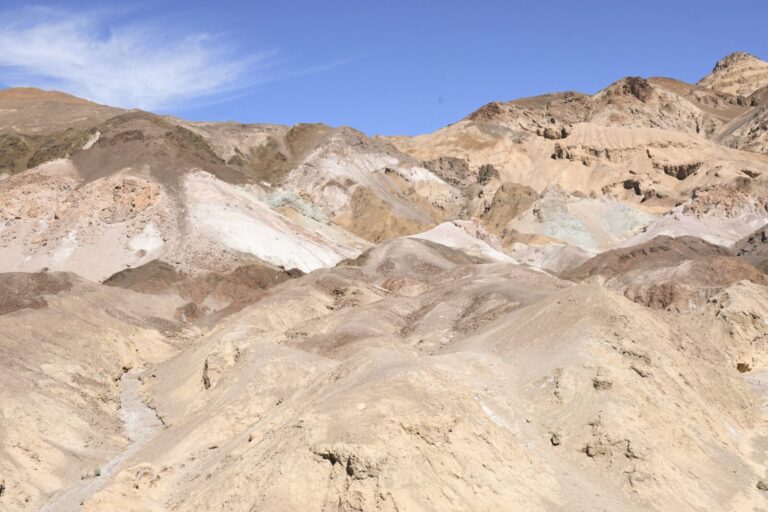
6. Artist’s Drive and Artist’s Palette
This 9-mile scenic drive is one of my favorite parts of Death Valley.
The hues of purple, green, pink and red colors throughout Artist’s Drive are caused by oxidation of metals such as iron and copper. It’s an unmissable stop on your Death Valley itinerary and one of the most amazing things to do in Death Valley if you want to snap a cool shot!
Taking pictures at Artist’s Drive has become one of the most popular things to do in Death Valley thanks to social media, and it’s not uncommon to see a couple of photographers at this spot.
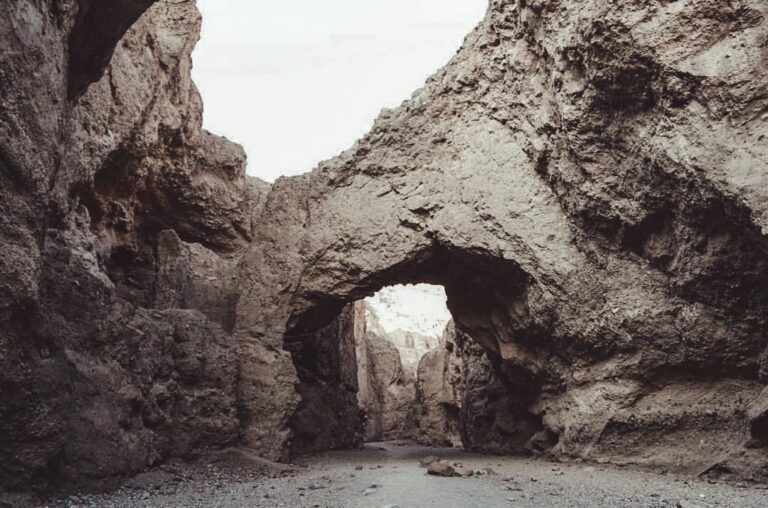
7. Natural Bridge
Natural Bridge Canyon is a short hike through the narrow canyon that features one of the park’s natural stone arches. Another prominent feature of the hike is a dry waterfall that was formed by rain waters flowing down the rock. Visiting Natural Bridge is one of the best things to do in Death Valley, if you want to get away from the crowds, as this spot is never busy.
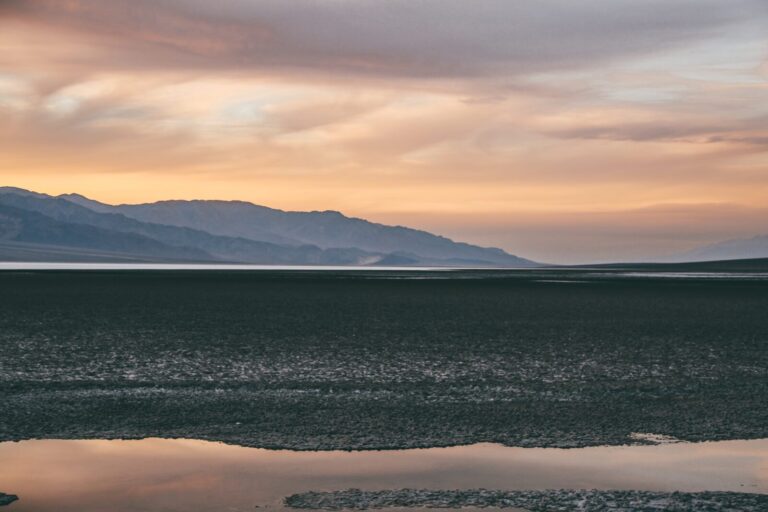
8. Badwater Basin
The lowest point in the United States, Badwater Basin lies 282 feet below sea level and is located on the southern tip of the Death Valley National Park.
Take a look at the water pool and the sign at the entrance before you proceed toward the huge salt flat that stretches for 5 miles. When you walk a bit further, take a close look at the salt formations, and you will be able to see individual salt crystals in the crust on the ground.
What’s interesting is that Mt. Whitney, the highest point in the lower 48 states which peaks at 14,505 feet is less than 80 miles away.
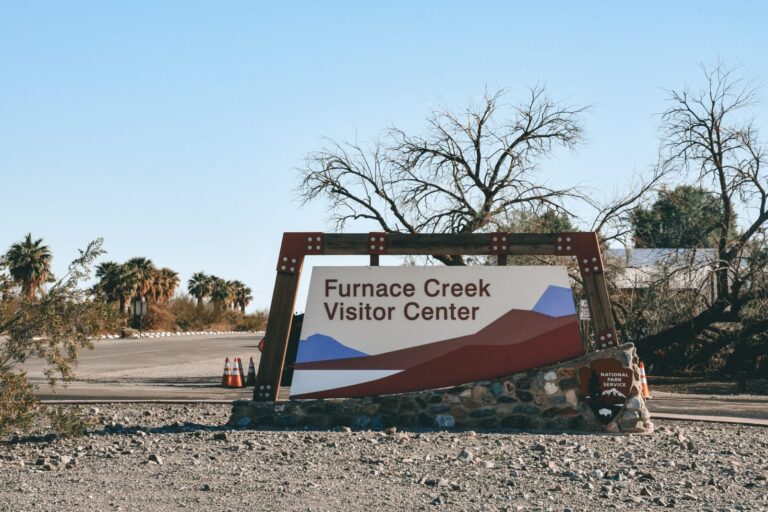
9. Furnace Creek Visitor Center
Along with the visitor center, Furnace Creek also has campgrounds, a gas station, a restaurant and Furnace Creek Ranch , one of the few hotels in Death Valley.
PRO TIP: Cell phone service can be very spotty throughout this national park. Furnace Creek is one of the few places in Death Valley where you can get a signal.
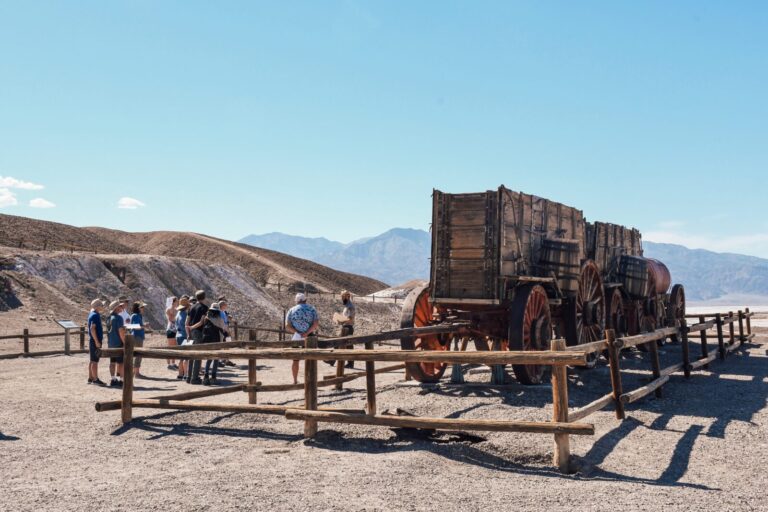
10. Harmony Borax Works
After stopping at Furnace Creek, head north on Highway 190 to Harmony Borax Works. This spot is an outdoor exhibit that shows how borax was mined here in the late 19th century through the colorful display of equipment and The Harmony Borax plant.
Taking a guided tour of the Harmony Borax Works is one of the best things to do in Death Valley if you want to learn the fascinating history of this national park. Guided tours can be arranged at the Furnace Creek Visitor Center.
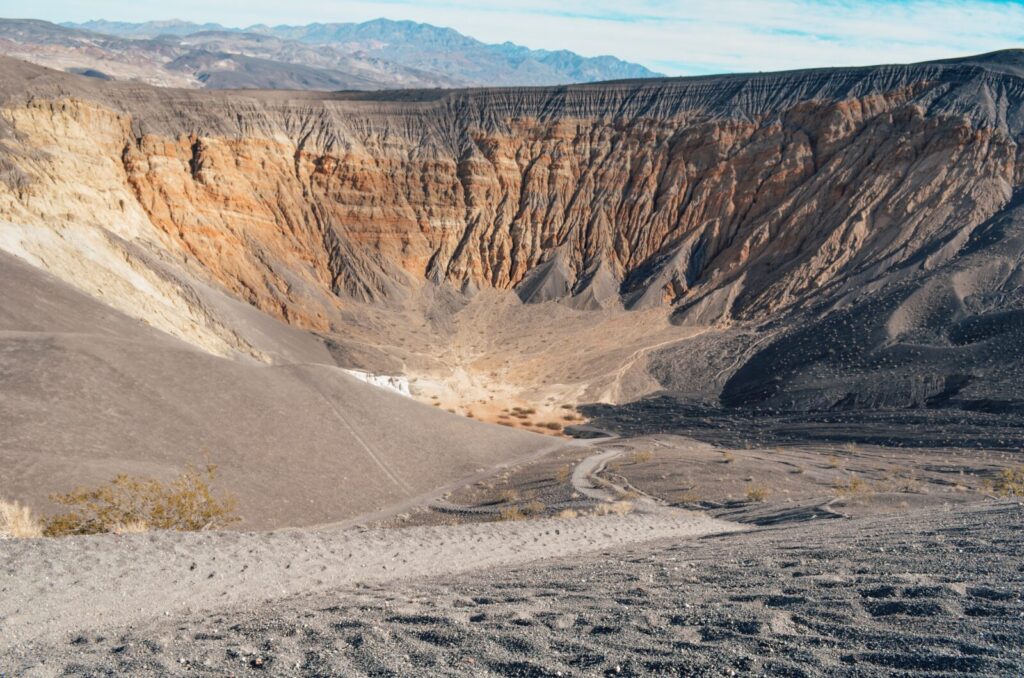
11. Ubehebe Crater
The drive to Ubehebe Crater is about 30 miles from the main state route that traverses through Death Valley. At 600 feet deep and half-mile wide, Ubehebe Crater is a pure wonder to gaze at! Thanks to its remote location, it’s one of the best places things to do in Death Valley.
You can hike around the rim of the crater or down to its bottom. But keep in mind that while the walk down might feel like a breeze, a hike back will require some effort.
12. Mosaic Canyon
Visiting Mosaic Canyon is one of the best things to do in Death Valley, if you want to do some hiking. This is a spectacular 4-mile round trip hike with several sets of cool narrows and cool views all around.
There are also fewer people and less sun thanks to the canyon walls, so it’s a perfect place to escape the Death Valley heat.
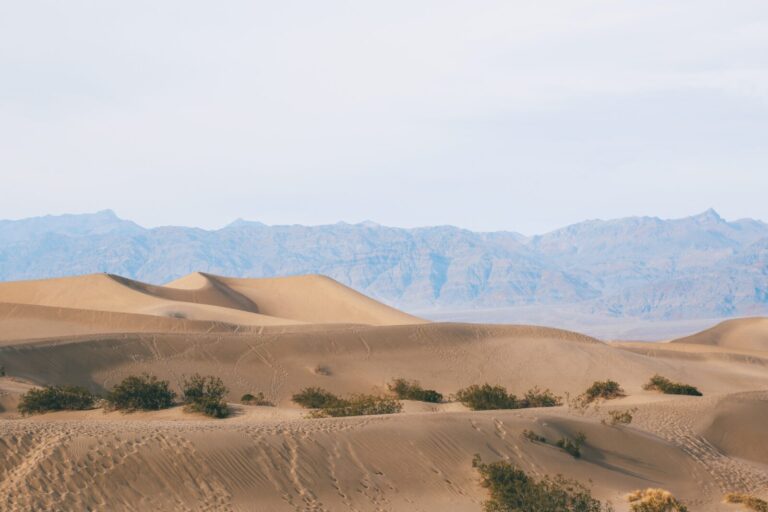
13. Mesquite Flat Sand Dunes
Mesquite Flat Sand Dunes is one of the most scenic spots in Death Valley, and it offers plenty of incredible patterns, curves and lines for photography. Make sure to wear your shoes, especially during summer because the sand can get really hot.
PRO TIP: If you want to visit cleaner, less-crowded sand dunes, head to the remote Eureka Dunes in the upper corner of Death Valley not far from Ubehebe Crater. To get there, you will need a 4X4 vehicle because the road that leads to this spot is very rugged.
14. Charcoal Kilns
Charcoal Kilns are a group of 10 beehive-like structures that are known as some of the well-preserved kilns in the Western United States. Although the drive to Charcoal Kilns is relatively easy and most of the drive is on the paved road, many travelers end up missing this spot on their Death Valley itinerary. The kilns can be accessed from the parking lot and are so much fun to explore!
The paved road turns into gravel during the last two miles, so it’s a good idea to have a high clearance vehicle, if you decide to come here.
15. Darwin Falls
Remember I told you at the beginning that Death Valley is an incredible national parks with a wide array of landscapes and biodiversity?
A few people know that there’s actually a cool waterfall in Death Valley that can be reached by a 2-mile roundtrip hike. To get there, you need to arrive in Panamint Springs on the west side of the park.
16. Stovepipe Wells
Stovepipe Wells is a small unincorporated community west of Mesquite Flat Sand Dunes. It’s also the second place besides Furnace Creek where you can buy food at Death Valley. It has a gas station, a Stovepipe Wells Village Hotel and a campground.
If you are headed to Lone Pine, a town near the western entrance to Death Valley, Stovepipe Wells is your last place to get gas before you begin a lengthy drive along the Death Valley Scenic Byway.
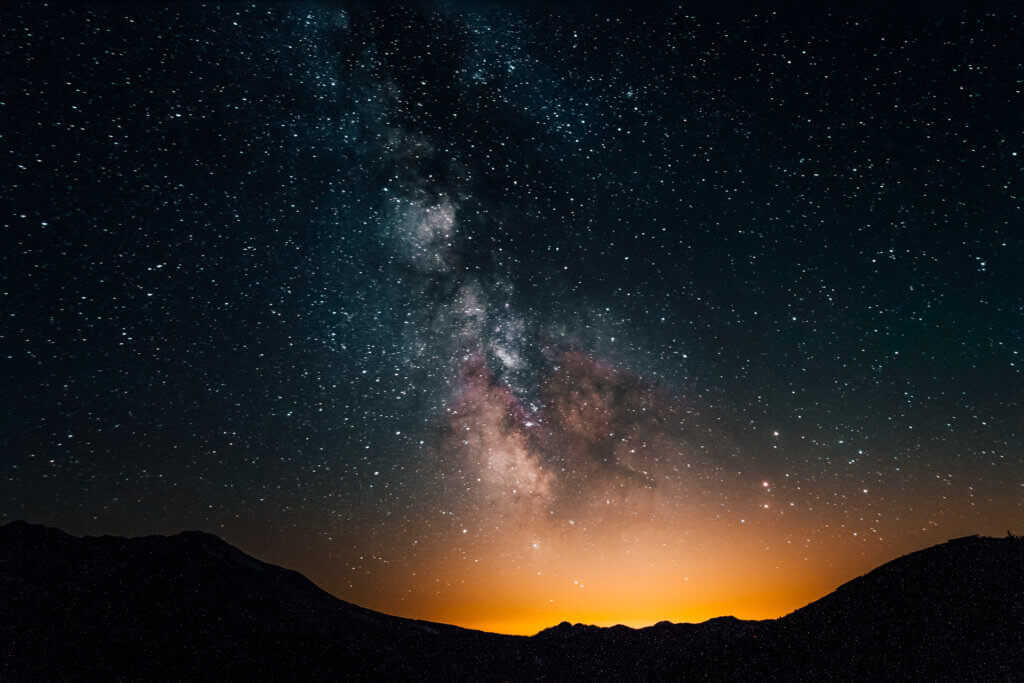
17. Stargazing in Death Valley
Designated as a dark-sky park by the International Dark-Sky Association , Death Valley is one of the best places for stargazing in the United States.
Most of the park is in the wilderness, and has no artificial sources of light polluting the dark sky. It is also far enough from the nearest major cities, Las Vegas and Los Angeles.
Stargazing is one of the best things to do in Death Valley. While the entire national park boasts spectacular dark skies, there are several places in Death Valley that are considered the best for stargazing:
- Badwater Basin
- Mesquite Flat San Dunes
- Harmony Borax Works
Do you have to pay to drive through Death Valley?
All visitors to Death Valley are required to pay a $35 entrance fee per vehicle. You can pay the fee at the meter at the Eastern entrance of the park or at Furnace Creek Visitors Center. Another option is to purchase America the Beautiful National Park Pass for $80 that will give you access to all parks in the U.S. National Park System.
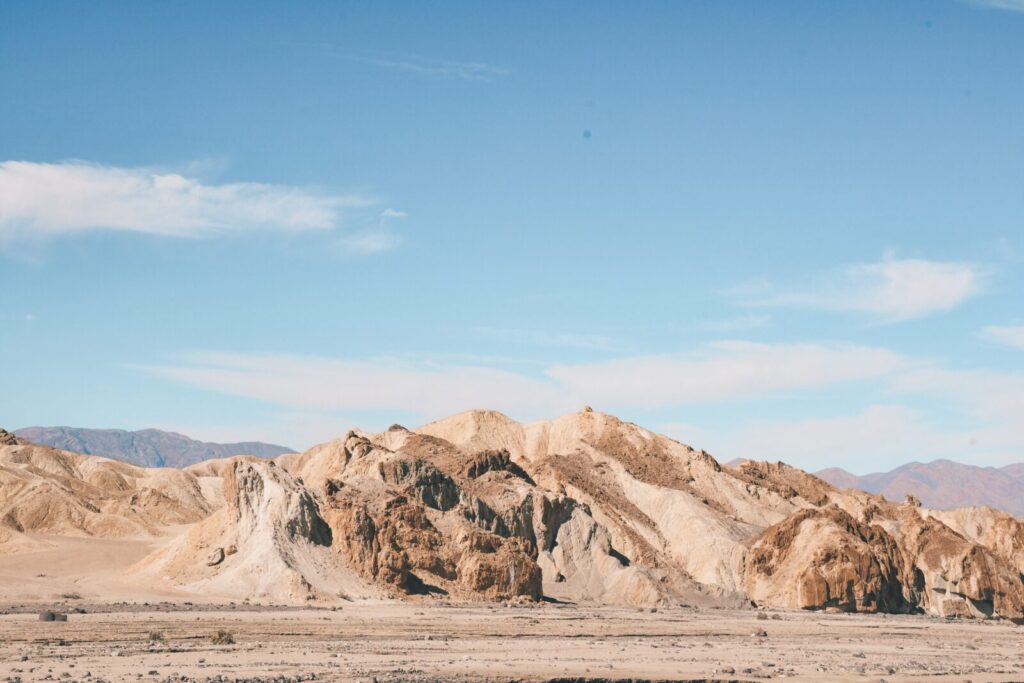
Best hotels in Death Valley
If you are wondering Death Valley places to stay, there are a few things you should know.
While winter in Death Valley is a slow time with fewer visitors, Death Valley hotels can be a bit expensive during summer. To avoid overpaying for a basic room, make your reservation ahead of time.
✅ Death Valley Inn and RV Park – located in Beatty, Nevada, the gateway to Death Valley, this hotel offers hotel rooms and RV spots.
✅ The Inn at Death Valley – one of the lodging options, the Inn at Death Valley has good facilities and spacious accommodations.
✅ The Ranch at Death Valley – another popular hotel in Death Valley that quickly gets booked up in spring and summer.
Best hotels near Death Valley
If you are looking for a budget places to stay near Death Valley, look for hotels in Pahrump or Beatty , the two towns located within one hour of driving from the park’s entrance. They typically offer more budget-friendly prices than hotels in Death Valley and lower occupancy rates.
Saddle West Casino Hotel in Pahrump is a popular option for travelers headed to Death Valley; and if you are driving through Beatty, check out El Portal Motel .
Death Valley campgrounds
- Furnace Creek – The most popular campground at Death Valley National Park, Furnace Creek is located near the visitor center. While it takes reservations, spots tend to fill up quickly due to its popularity.
- Texas Springs/Sunset – Also located at Furnace Creek, Texas Springs and Sunset campgrounds are first-come, first-serve and don’t take reservations.
- Stovepipe Wells – A first-come, first-serve campground, Stovepipe Wells doesn’t require a reservation. It’s open from late fall through spring and is about 30 minutes from Furnace Creek.
If you are looking for more remote campgrounds with cooler temperatures, check out Mesquite Spring, Wildrose and Mahogany Flat that are open from late spring through fall.
Many Death Valley campgrounds are closed in summer because of the hot weather, and some remote campgrounds are also closed in winter because even a hot place like Death Valley can get ice and snow at high altitudes.
During summer, temperatures stay over 100 degrees Fahrenheit even at night, which makes sleeping in a tent very uncomfortable.
PRO TIP: Most national parks in the United States tend to have a higher visitation around major holidays such as the Fourth of July, Veteran’s Day and Memorial Day, and Death Valley is no exception. If you can, plan your trip for other days to avoid the crowds.
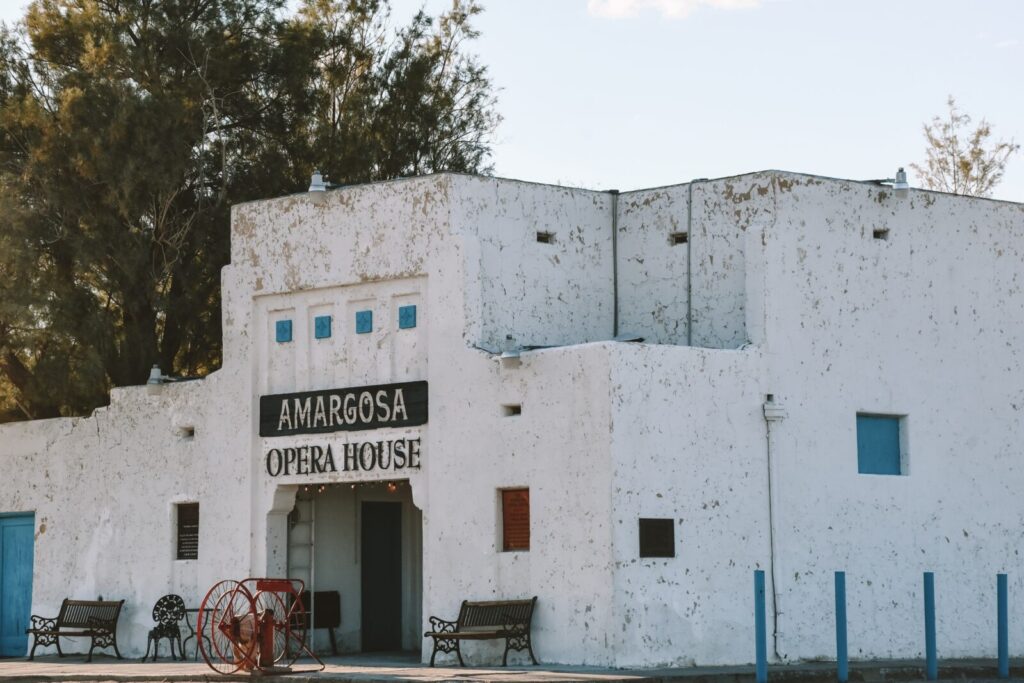
Amargosa Opera House
When you get to the Death Valley Junction located near the eastern entrance of the park, you will see Amargosa Opera House.
Although you might think that it’s just a crumbling old building, Amargosa Opera houses a hotel and a cultural center where ballet performances are hosted during a specific season.
I recommend booking a stay at Amargosa Op era House and Hotel because it’s such a cool experience that you won’t get anywhere else! I think it’s by far one of the best places to stay near Death Valley.
PRO TIP: If you are driving to Death Valley from Nevada, fill up your car in Pahrump or Amargosa Valley because gas prices are high in Death Valley like in many other national parks in California.
Best things to do in Death Valley: FAQ
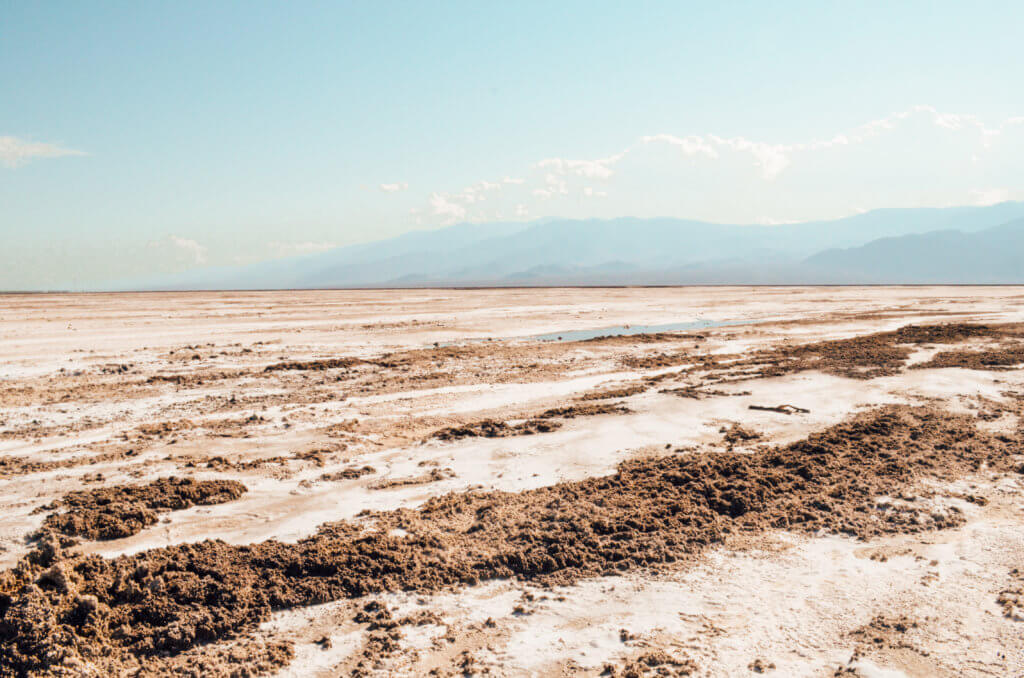
Why is it called Death Valley?
Death Valley has a fascinating history!
For thousands of years, Native American tribes roamed the harsh desert that is today known as the Death Valley National Park.
In mid-1800, when the California Gold Rush fueled mass migration of prospectors to the state, the first group of American-Europeans arrived in the area, as it was trying to make its way to the gold fields.
Lost in the uncharted territory, they were stuck in the valley for weeks, and eventually forced to abandon their wagons and eat some of their oxen to survive.
After the group eventually was able to find its way out, one of the women turned said, “Goodbye Death Valley!”
The moniker has stuck around ever since.
How do I get to Death Valley?
To get to Death Valley, you will need to rent a vehicle . Most travelers drive to Death Valley either from Las Vegas or from Southern California, and having a car rental will allow you to explore the region after visiting Death Valley. I recommend renting your car with DiscoverCars that offers great inventory on many vehicles and very competitive prices!
Death Valley directions
Death Valley National Park straddles the Nevada-California border, but most of Death Valley is located in California’s Mojave desert.
If you drive to Death Valley from California, you will enter the park either from Lone Pine, Baker or Shoshone.If you drive from Las Vegas to Death Valley, you will pass either through Pahrump, Beatty or Amargosa Valley.
How long does it take to drive through Death Valley?
It takes about 2 hours to drive through Death Valley if you are driving from East to West entrance of the park, with the total road trip taking about 120 miles.
What is the best month to visit Death Valley?
March and April are considered the best months to visit Death Valley because of mild temperatures that allow you to spend time outside and camp. If you visit Death Valley during these months, you could also see thousands of gorgeous wildflowers dotting the desert floor. When winter has enough rain, the floral display occurs usually between late February and early March.
What is Death Valley like in summer?
Death Valley weather in summer is no joke.
It’s hot and dry and temperatures can reach 130 degrees!
Even in April, Death Valley temperatures can soar to 90-100 degrees Fahrenheit. Ironically, this national park sees the most visitors during summer thanks to an influx of overseas tourists who want to experience the famous triple-digit heat.
Along with the deserts of Sahara and the Middle East, Death Valley is one of the hottest places on the planet. This means that you are limited in terms of what things you can do in Death Valley in summer because of the harsh weather.
But if you visit this national park in summer, you will see that it is popular with foreign travelers during this time as they stop here as part of their West Coast trip, spending at least one day in Death Valley before heading to Yosemite and San Francisco or Los Angeles.
So don’t be surprised to see full hotels in Death Valley during this time!
What is winter like in Death Valley?
Winter is different. Death Valley in December sees a lot of North American travelers who come here to escape cold weather in their home states. Winter is also a perfect time for hiking in Death Valley as the weather is mild and sunny, but temperatures can still drop during the night, and you can see snow at higher elevations, so bring some layers.
How much time do I need in Death Valley?
Spend no less than 3 days in Death Valley. It’s a huge national park, and driving distances can be long, especially if you want to check out less-visited areas. While it’s possible to get a brief overview of Death Valley in just a day, you will miss out on cool activities like stargazing and exploring more remote corners.
What to do in Death Valley in one day?
If you only have one day in Death Valley, you can choose from some of the most popular things to do in Death Valley like Zabriskie Point, Mesquite Flat Sand Dunes, Badwater Basin, and visit at least one remote site like Ubehebe Crater.
Are there restaurants in Death Valley?
Yes! If you are looking for places to eat in Death Valley, there are a couple of options. Keep in mind that prices here are high and food is average at best, so prepare to pay substantially more even for a mediocre meal. Bring food, water and snacks, if you want to camp or spend a few days in Death Valley.
Here are a couple of options for Death Valley restaurants:
- The Inn at Death Valley – one of the most popular restaurants in Death Valley thanks to its central location, the Inn serves breakfast and dinner
- Toll Road Restaurant – located in Stovepipe Wells Village, this restaurant offers breakfast, lunch and dinner
- The Ranch at Death Valley – another centrally located restaurant, the Ranch serves breakfast, lunch and dinner.
- Panamint Springs Resort – also has a restaurant. Breakfast, lunch and dinner served year-round
Are there gas stations in Death Valley?
Yes, there are gas stations in Death Valley, but I recommend filling up before you come to Death Valley, because gas here is about $1,5-2 more than regular prices.
- Furnace Creek – the most central gas station in Death Valley near visitor center and several campgrounds
- Stovepipe Wells – another gas station in Stovepipe Wells Village near hotels and a restaurant
- Panamint Springs – a more remote gas station
SAFETY TIP: Always have a spare tire when visiting Death Valley. Since many points of interest in Death Valley are hours apart and cell phone service is spotty, you do not want to be stuck here. The cost of towing out of Death Valley is ridiculously high and can be in the thousands of dollars.
Is Death Valley worth visiting?
Yes, Death Valley is worth a visit! Although some travelers dismiss Death Valley is boring and not worth visiting, I couldn’t disagree more with their opinion. Death Valley is one of the most beautiful national parks with unique landscapes that look like a different planet. Exploring Death Valley is a lot of fun, and you should spend a couple of days enjoying this place.
What do I need to wear when visiting Death Valley?
When visiting Death Valley, always wear a hot, light breathable clothes, good hiking shoes and plenty of sunscreen. Carrying plenty of water and at least a couple of snacks in your backpack is a must at all times, because even in winter Death Valley can be super dry and you can get dehydrated very quickly.
Death Valley safety precautions
Death Valley is a beautiful and enigmatic place, but it also can be harsh and unforgiving. High temperatures and burning sun combined with long distances and lack of cell phone coverage in many places require extra caution.
Before you plan your itinerary for some of the best things to do in Death Valley, spend some time studying the area and getting your supplies ready. My survival guide to Death Valley National Park will help you to stay safe on your adventure of a lifetime!
Best things to do in Death Valley: Final Word
Death Valley is one of the most beautiful national parks in California with enigmatic landscapes, clear dark skies and plenty of space for camping, hiking and canyoneering. Make sure to spend a couple of days in Death Valley to enjoy everything that that this national park has to offer.

21 Best Things to do in Death Valley National Park
Written By: ThePlanetD Team
United States
Updated On: April 17, 2023
Planning to visit Death Valley? Get ready! Death Valley is the largest US national park outside of Alaska . It is the hottest and driest place in North America, and Badwater Basin is the lowest spot on the continent. Whew, Death Valley National Park has a lot going on, but that’s not all! Located in both California and Nevada, Death Valley National Park was established in 1994 after holding the title of Death Valley National Monument for five decades. And in 2013, it was fittingly designated as a Dark Sky Preserve.
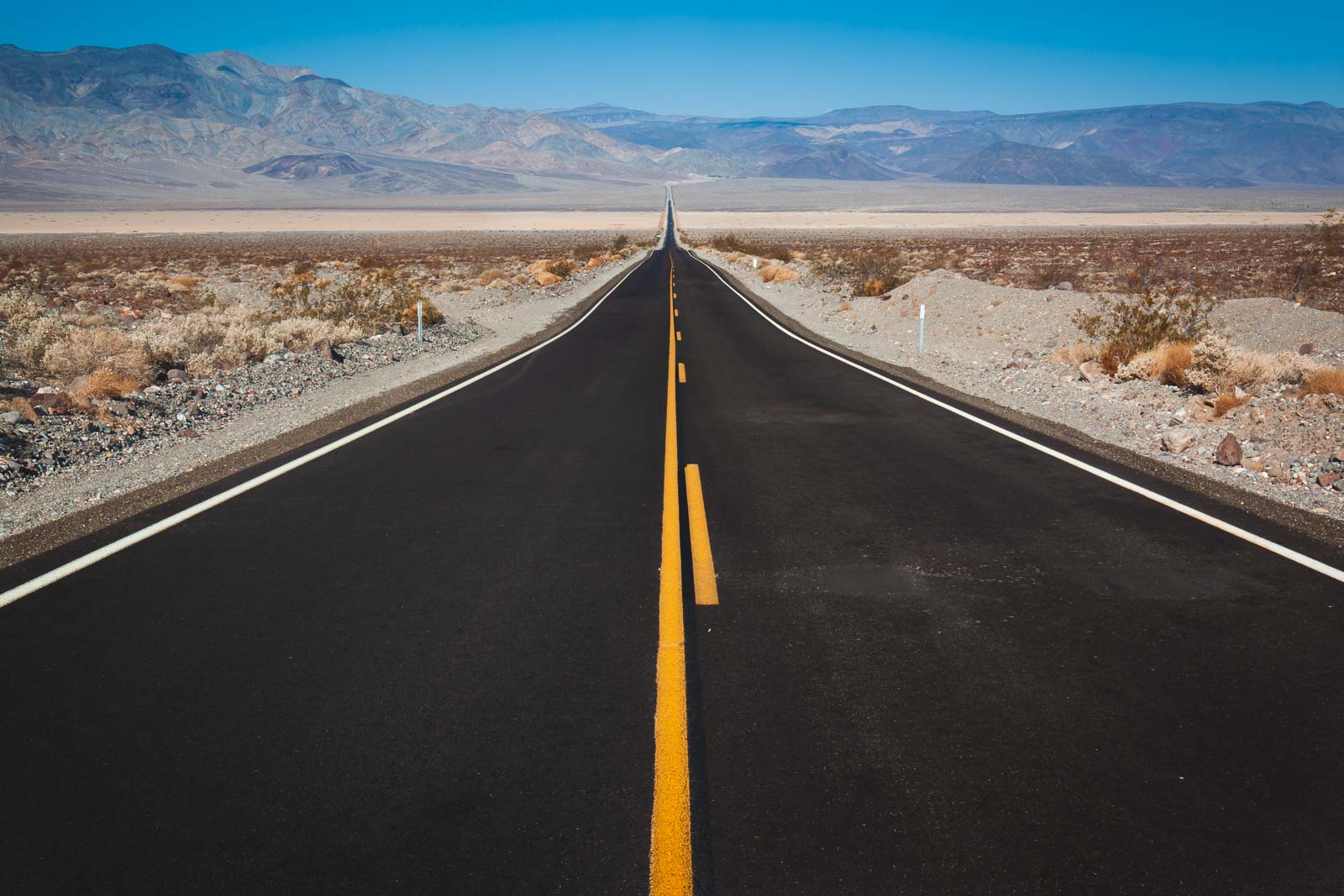
It is easily one of the most memorable places to visit for unique scenery. And as an added bonus, there are many amazing things to do in Death Valley National Park.
Table of Contents
Top things to do in Death Valley National Park
Note: The area has been dealing with extreme weather conditions and some roads are closed in Death Valley due to flood damage. At the time of publishing, many roads are closed including CA 190 west of Stovepipe and Badwater Road and Daylight Pass and Towne Pass are closed. See the National Parks Services Website for up-to-date information.
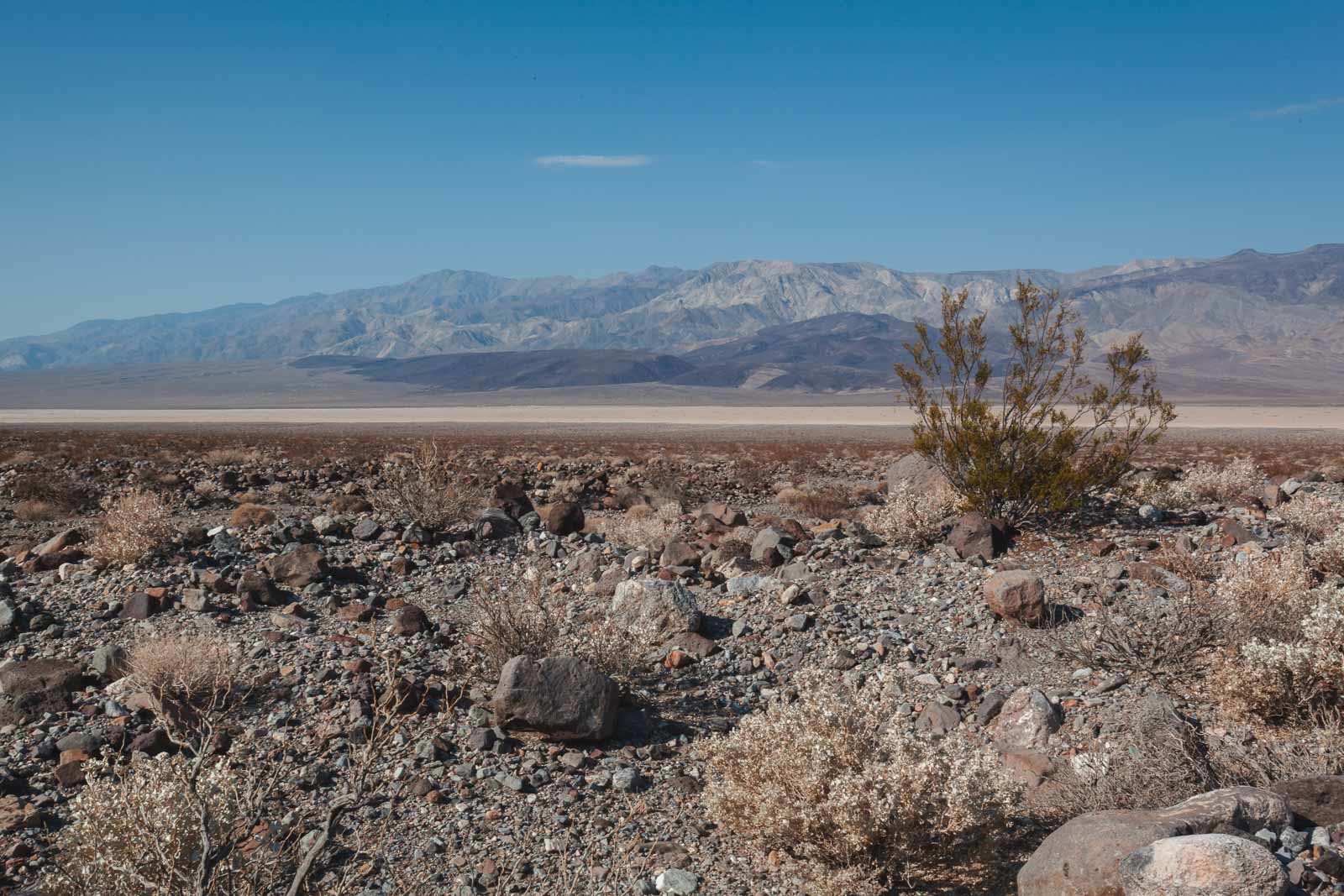
This guide will focus on the best things to do in Death Valley National Park. We’ll cover everything from Natural Bridge to hiking trails along the valley floor. Prepare yourself for some inspiring, exciting things to do in this California national park. If you are doing a self-drive through Death Valley, pick up this GPS driving tour . It highlights many of the top Death Valley attractions.
- make sure to have an ample supply of water before visiting
- stay on paved roads, and let people know where you are going and when you plan to return.
- If you plan on visiting any remote places in Death Valley, consider conveying with two or more vehicles should a breakdown occur.
- Make sure you have a full tank of gas and carry a paper map along with your GPS and cell phone.
1. Mesquite Flat Sand Dunes
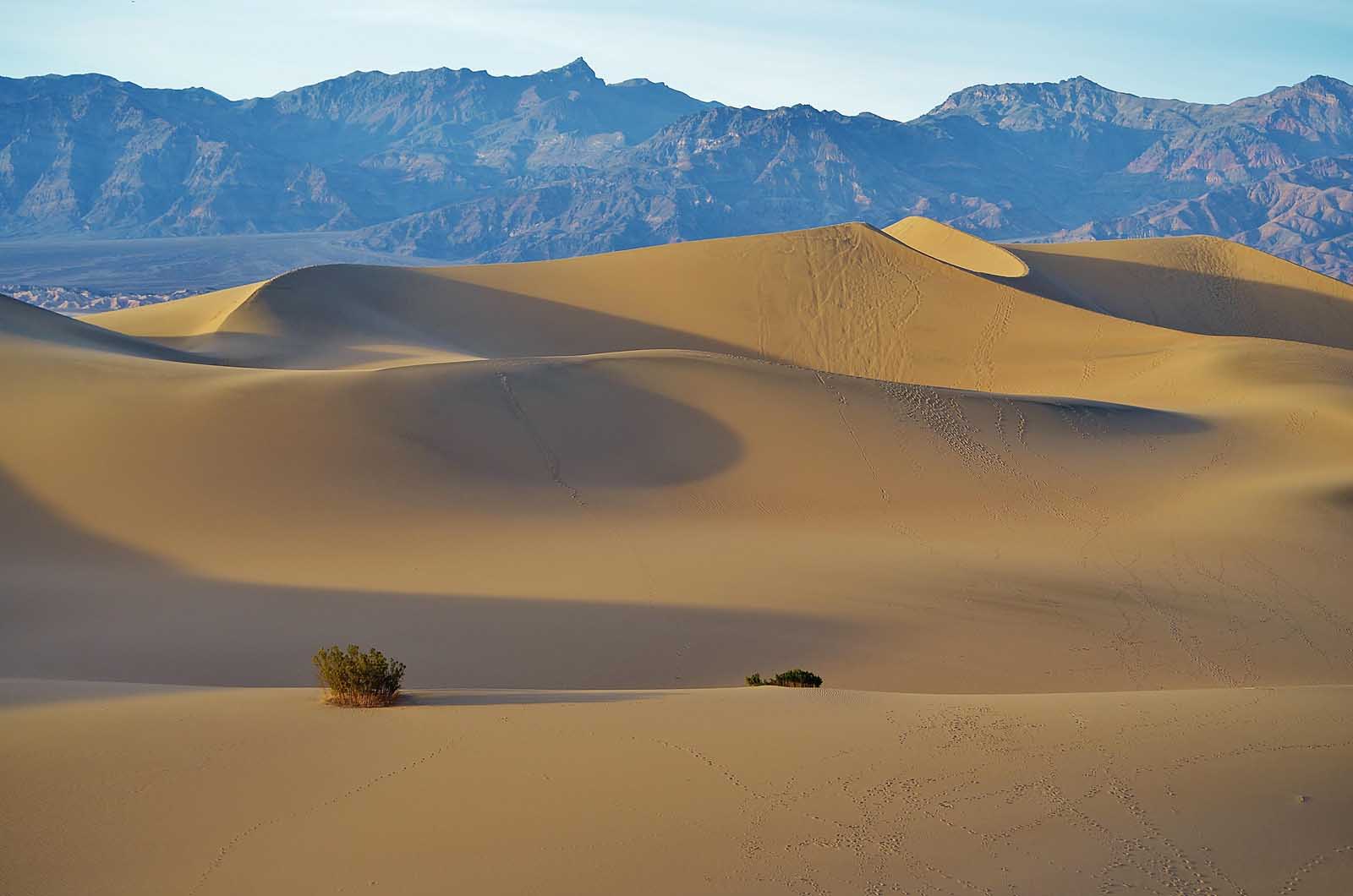
If you are looking for fun things to do in Death Valley National Park, sandboarding at Mesquite Flat Sand Dunes is easily one of the best. Mesquite Flat Sand Dunes are Death Valley’s most popular and easily accessible sand dunes, and some dunes tower as high as 100 feet. Even if you don’t fancy sandboarding, Mesquite Flat Sand Dunes are a great place to release your inner child and attempt to run down the sandy slopes.
Mesquite Sand Dunes are easily reached off the 190, and a reasonably large parking lot is just off the roadside. We suggest getting there early, so the sand dunes are still cool underfoot. There is no sandboarding rentals in the park, so you need to bring your own equipment.
2. Artist’s Palette
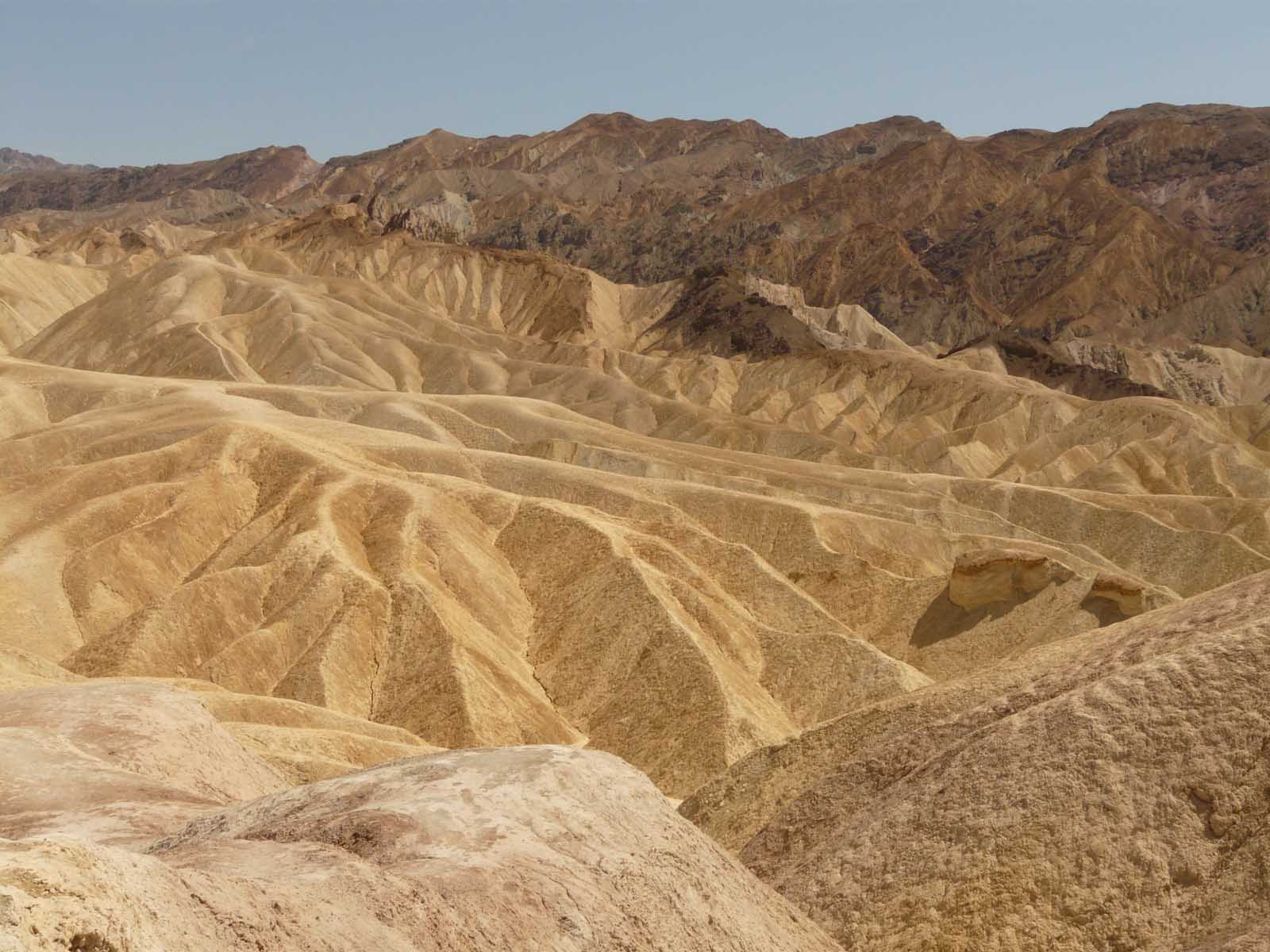
Artist’s Palette is a stunning viewpoint overlooking a collection of pastel-hued hills. The hills turned their unique color after millions of years of oxidation and weathering, and now visitors flock to come to view the phenomenon. The viewpoint gets its name, the ‘Artist’s Palette,’ from the blend of colors.
Artist’s Palette is located on Artist’s Drive loop located, just off Badwater Road. There is a tiny trail from the parking and toilet facilities to the viewpoint itself, and it is very easily reached if you are short on time. The attraction sits along the 9-mile Artist’s Drive loop, which is an attraction in its own right. It is worth allowing extra time to enjoy driving Artist’s Drive at leisure.
Check out this highly rated tour departs from Las Vegas in the early hours of the morning to reach the desert for stargazing and sunrise.
3. Natural Bridge
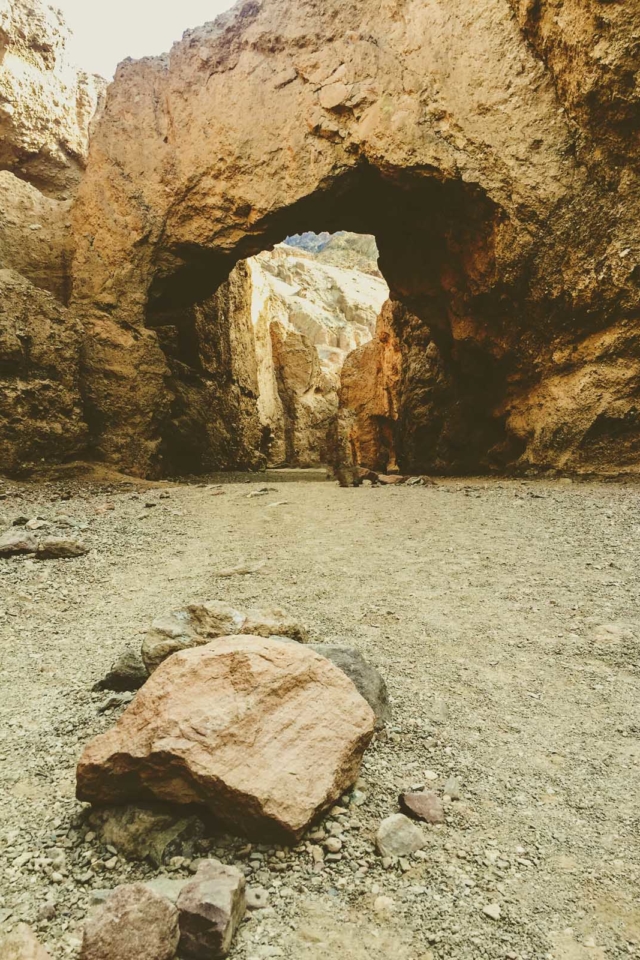
If you can’t make it to the sandstone arches of Arches National Park ; Natural Bridge is a vast, jagged arch that towers 35 feet above the canyon floor. Natural Bridge was formed by a rare series of flash floods over thousands of years. Visitors can hike to the bridge to walk underneath and admire the geological formation in all its glory. Visiting Natural Bridge is one of the most impressive things to do in Death Valley.
You have to hike to Natural Bridge, but the route is only a 2-mile round trip. It is the perfect hike if you don’t want to walk long distances in the heat, are in a rush, or traveling as a family. You also get a beautiful view of the salt flats on the return hike, sure to keep your spirits up.
Natural Bridge Trailhead is accessed via a dirt road off Badwater Road. You’ll find plenty of parking at the end but beware that the dirt road conditions can be rough. It is worth checking the road conditions on the National Park Service website before you attempt it. It is best suited to 4WD because of the likelihood of deep potholes.
This photography tour lets you explore Death Valley by day and night. Besides visiting its sand dunes, canyons, and wildlife, you’ll watch the sunset and stay into the starry night to enjoy the dark sky preserve. Details here
4. Devil’s Golf Course
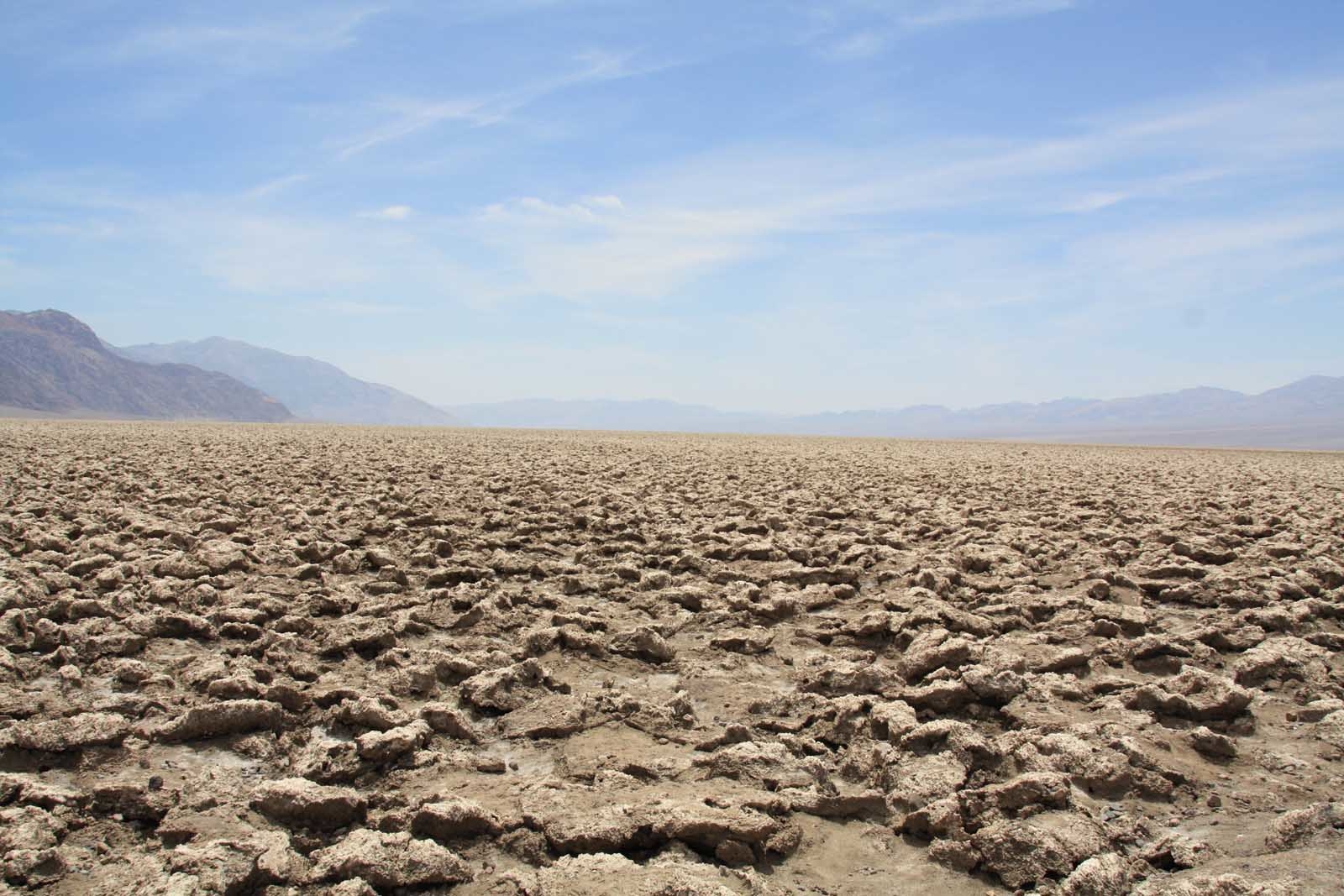
Devil’s Golf Course’s name might have you stumped about what it could be. The attraction is a salt pan, but the floor is so jagged and uneven that an old National Park Service guidebook quipped that ‘only the Devil could play golf there’. The salt pan floor is a far cry from its smooth salt flat neighbor Badwater Basin (which we’ll look at in more detail later), and you’ll find endless stalagmites. Some salt spikes are two feet high, so you’ll be carefully picking your way around a boardwalk rather than walking across the salt pan itself.
The Devil’s Golf Course was once covered by a lake, which evaporated and left behind a thick layer of salt and minerals – creating the natural phenomenon you see today. We highly suggest bringing a camera for this attraction, as it is easily one of the most striking things to do in Death Valley.
This full-day explorer tour by Trekker can be booked from Las Vegas where you hop aboard a custom-built Tour Trekker vehicle with stops including Furnace Creek, Devil’s Golf Course, Badwater, Zabriskie Point, and more
5. Twenty Mule Team Canyon
Twenty Mule Team Canyon is one of the most scenic dirt tracks you’ll see in your life. The short 2.5-mile road takes you through a range of stunning badlands, which are full of pastel colors and uniquely shaped by erosion. The drive may be short, but you’ll want to stop for photographs, so allow at least half an hour to experience it.
Twenty Mule Team Canyon isn’t just famous amongst tourists either. Movie directors have flocked to use the site for major productions, including Return of the Jedi. Star Wars fans should prioritize visiting Twenty Mule Team Canyon when they visit Death Valley.
The scenic drive is easy to reach, and you turn off the 190 onto 20 Mule Team Road before quickly reaching the dirt track turnoff. Twenty Mule Team Canyon is just half an hour’s drive from Furnace Creek Visitor Center. It is well-combined with a visit to nearby Zabriskie Point and Harmony Borax Works.
6. Golden Canyon
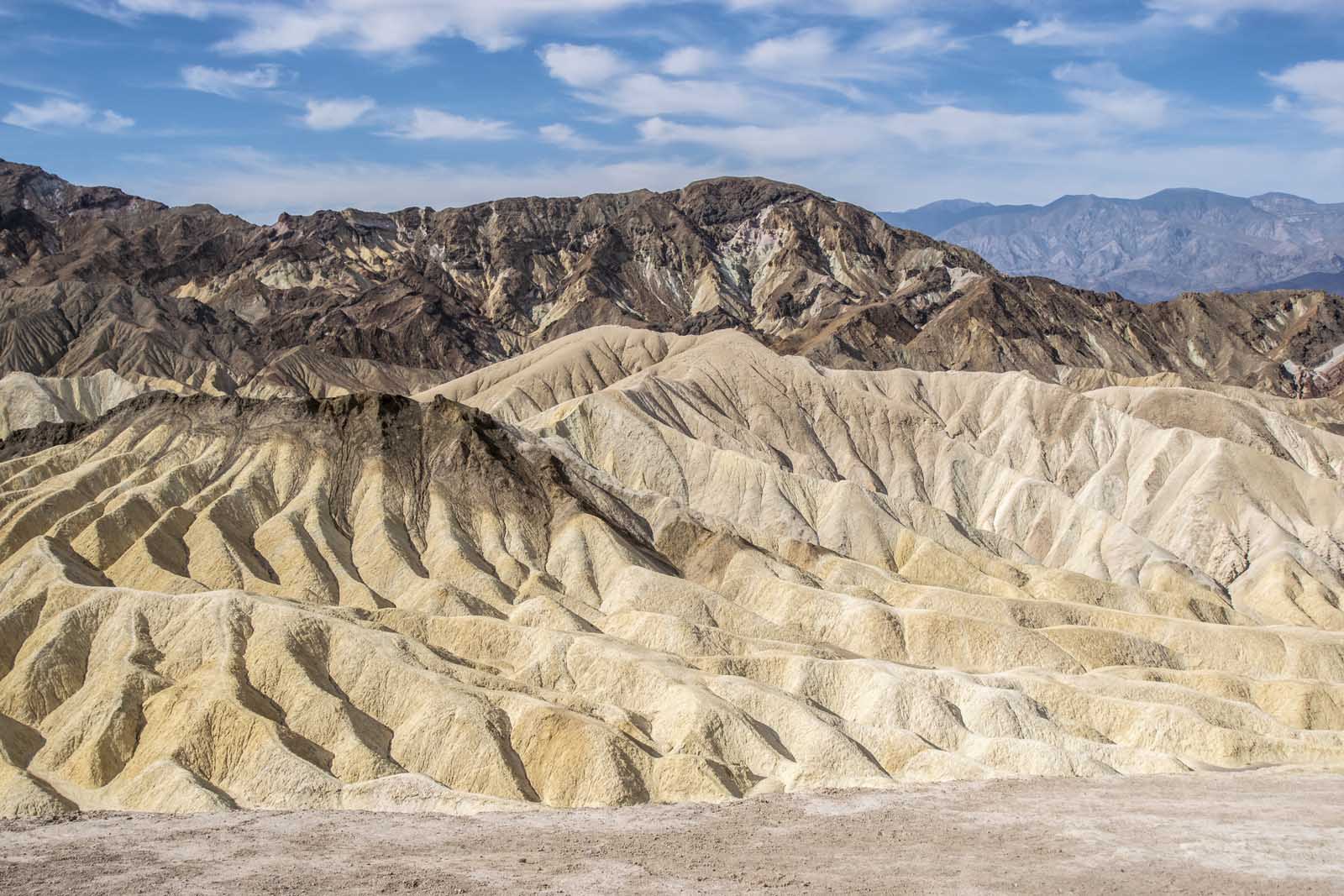
Are you ready for an incredible hike? Golden Canyon Trail is a stunning route through a honey-colored ravine on a clearly marked trail. You’ll want your camera for this one; Golden Canyon’s good looks have attracted the likes of Star Wars movie producers.
The trail is a 2-mile round trip with a short 3-foot rock scramble. The scramble is untechnical and suitable for anybody with good fitness and reliable footwear, so overall, the hike is easy to tackle in Death Valley National Park. Most hikers hike to Red Cathedral as an endpoint, although you can choose to go further if you want an extra challenge.
Golden Canyon is also located just outside of Furnace Creek. The trailhead is just a 7-minute drive from Furnace Creek Visitor Center – making it an easy addition to a busy itinerary. You’ll find a large parking lot and restrooms at the Golden Canyon Trailhead, accessed on a turnoff from Badwater Road.
This highly rated tour offers a full day from Vegas with a private guide and a custom itinerary. And the best part? You’ll have a professional photographer with you taking photos of the entire adventure.
7. Zabriskie Point
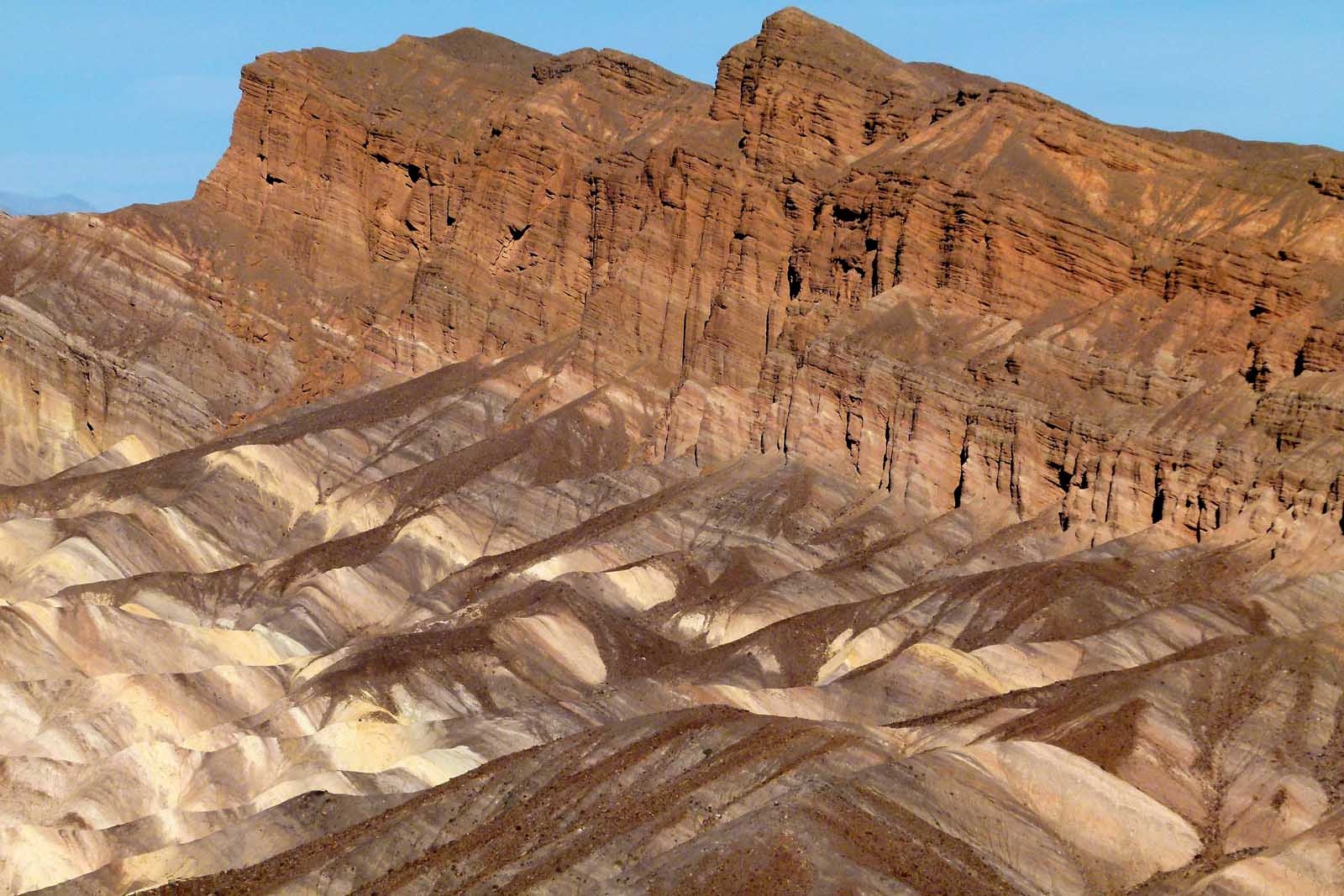
Visiting Zabriskie Point is one of the most beautiful things to do in Death Valley National Park. The viewpoint overlooks hilly, wrinkled badlands tinged in pastel, sandy colors. If you want a sunrise or sunset spot – Zabriskie Point is the one for you.
Zabriskie Point was formed when Furnace Creek Lake dried up around 5 million years ago. The sediments left behind formed the stunning hills, and erosion over the years shaped the landscape into what it is today.
Zabriskie Point is practically on the roadside. You drive on the 190 from Furnace Creek towards Death Valley Junction, turning off into Zabriskie Point Parking Lot to hike the short trail to the viewpoint. It is easy to access and is an excellent place to start your day, conveniently nearby Furnace Creek and the Visitor Center.
8. Badwater Basin
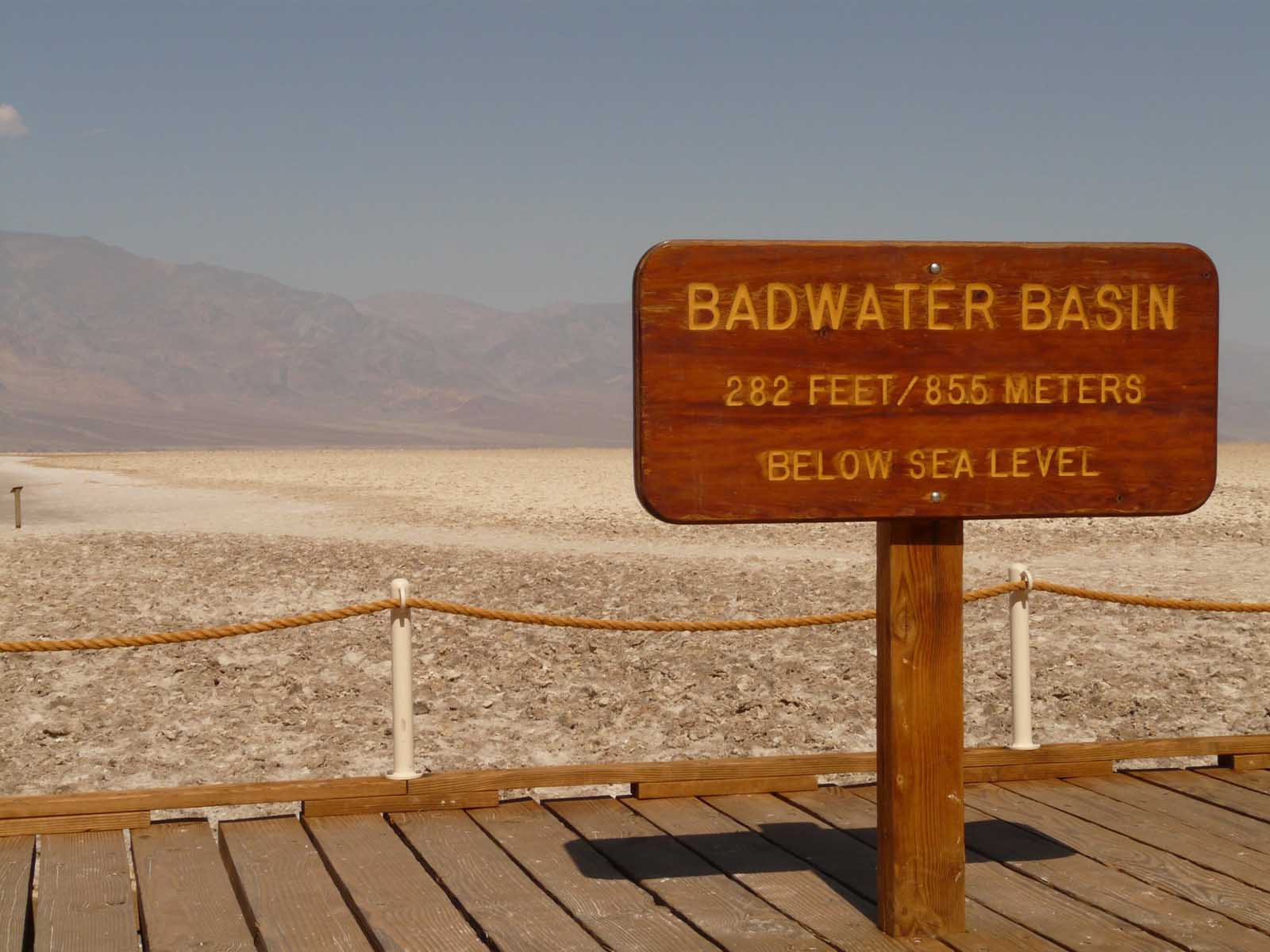
Visiting Badwater Basin is one of the most fascinating things to do in Death Valley. Badwater Basin is the lowest point in North America, at 282 feet below sea level. Badwater Basin has around 200 square miles of salt flats to explore – the largest protected salt flats in the world.
After it rains, Badwater Basin can appear mirror-like as the water reflects off the salt crystals. Badwater Basin looks like snow when it is dry, and the salt flats are arranged in small circular patterns along the valley floor.
Badwater Basin is accessible via a short trail off Badwater Road. You’ll find a toilet block and parking area near its trailhead. Badwater Basin is located extremely close to the Devil’s Golf Course and Dante’s View. Consider combining these three attractions if you drive down Badwater Road to reach Badwater Basin.
9. Scotty’s Castle
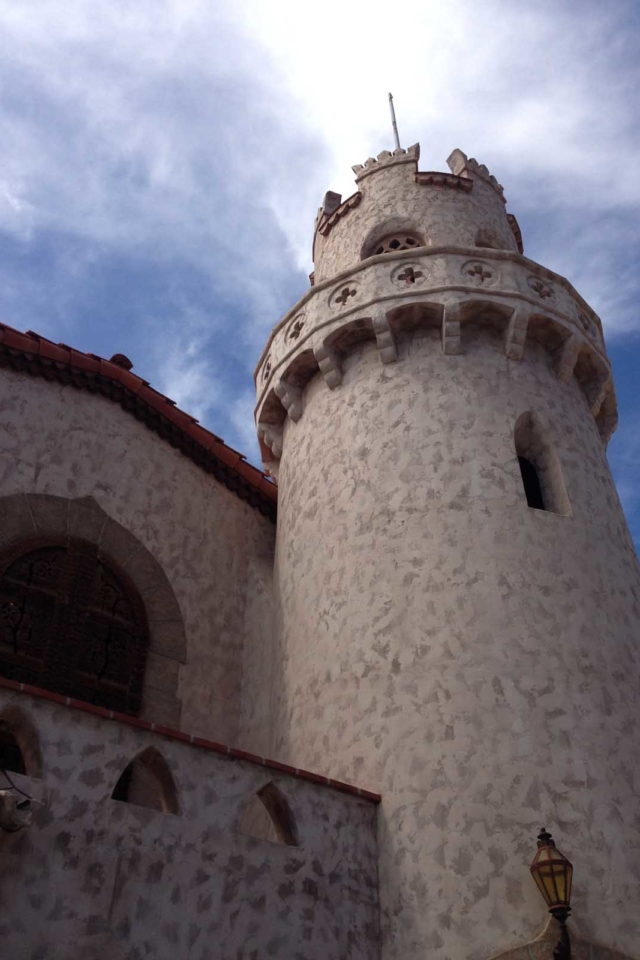
Death Valley isn’t all geology and hiking trails, and Scotty’s Castle is proof of that. The ‘castle’ is not so much a castle but an enormous mansion, and its story is a blend of history and local culture. Visitors can book guided tours of the building today and discover the story in person, but we’ll give you a quick rundown here.
The mansion was built by Albert Mussey Johnson for himself and his wife to use as a luxurious vacation home. However, Walter Scott brazenly convinced the community that he had built it by making money through secret mines in Death Valley. The mansion coined the name Scotty’s Castle, and a cloud of mystery about the mansion’s ‘real story’ is kept alive by local legends.
Either way, the mansion is incredible to tour – whisking visitors back to the roaring 20s and 30s. You can admire extensive woodwork furnishings and details, and sadly also witness the impact of the 2015 floods, which damaged the house extensively in some areas.
10. Darwin Falls
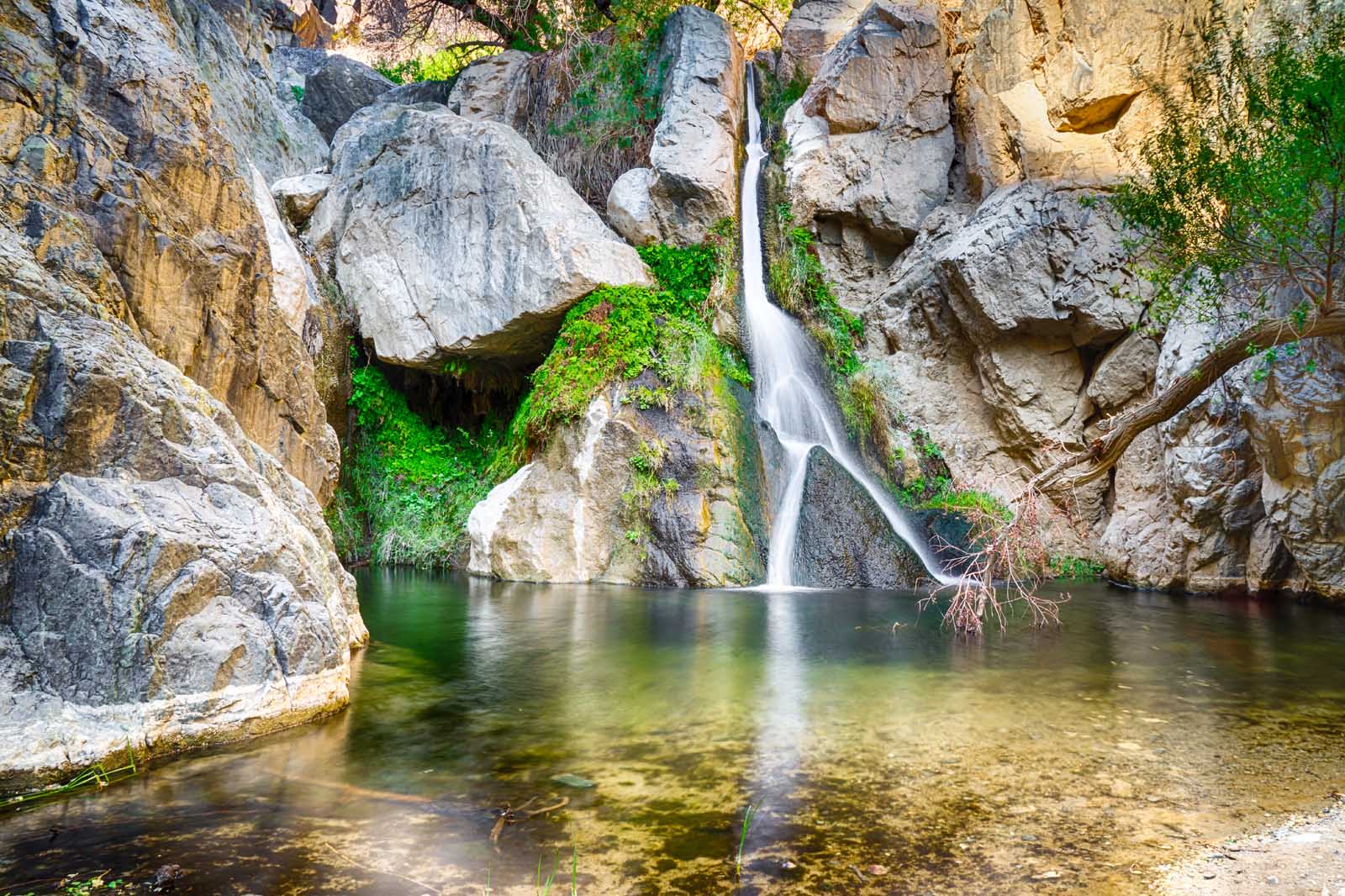
Waterfalls aren’t the most common sight in Death Valley. In fact, Darwin Falls is quite a rare year-round waterfall, as there is only a handful in the national park. The falls are surrounded by life – from flora, including aquatic vegetation, to animals like tree frogs and even bighorn sheep. Darwin Falls is somewhat of a desert oasis, and lifeforms flock to the waters for survival.
Darwin Falls is a stunning sight, and the waterfall drops 18 feet in a pretty cascade. Darwin Falls is accessed by a two-mile round trip hike, which takes around two hours to complete and has an elevation gain of 450 feet. The general advice is to avoid hiking after 10 am in hotter months. You can’t swim to cool off, so aim to hike in the early morning when it is nice and cool.
The trailhead is located off of Old Toll Road on a long dirt track, and there is a large parking lot to use right next to the beginning of the trail. It is worth noting that the track is pretty rough and requires a 4WD vehicle. You may wish to check with a ranger or website for updates on the road conditions.
11. Rhyolite Ghost Town
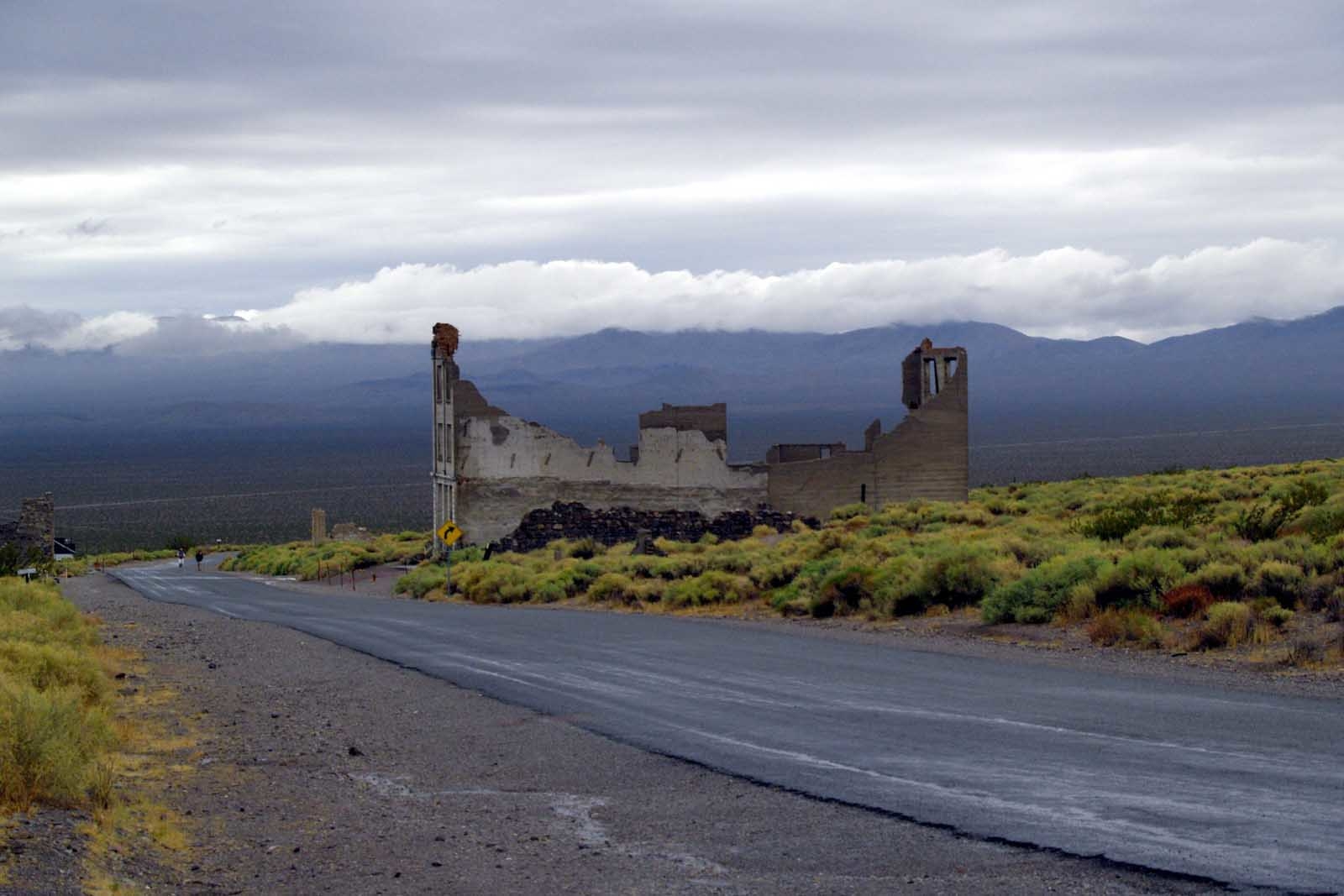
Rhyolite Ghost Town is located just on the outskirts of Death Valley, on the eastern side of the park across the Nevada border. Rhyolite is an old, abandoned mining town, and light and power were turned off for the town in 1916 following the closures of mines and banks. However, nowadays, there is still so much left behind to explore.
The old bank is (just about) still standing, as is the train depot and Tom Kelly’s Bottle House. It is also worth stopping by Goldwell Open Air Museum for an outdoor sculpture garden. Rhyolite is the perfect spot for those interested in history and visiting abandoned sites.
Rhyolite Ghost Town is quite a drive, just over an hour from Furnace Creek. We suggest breaking the drive up by stopping at Hell’s Gate on the way. Hells Gate is a scenic stop to admire Daylight Pass Road’s stunning surroundings and visit the Death Valley National Park Information Area.
12. Eureka Dunes
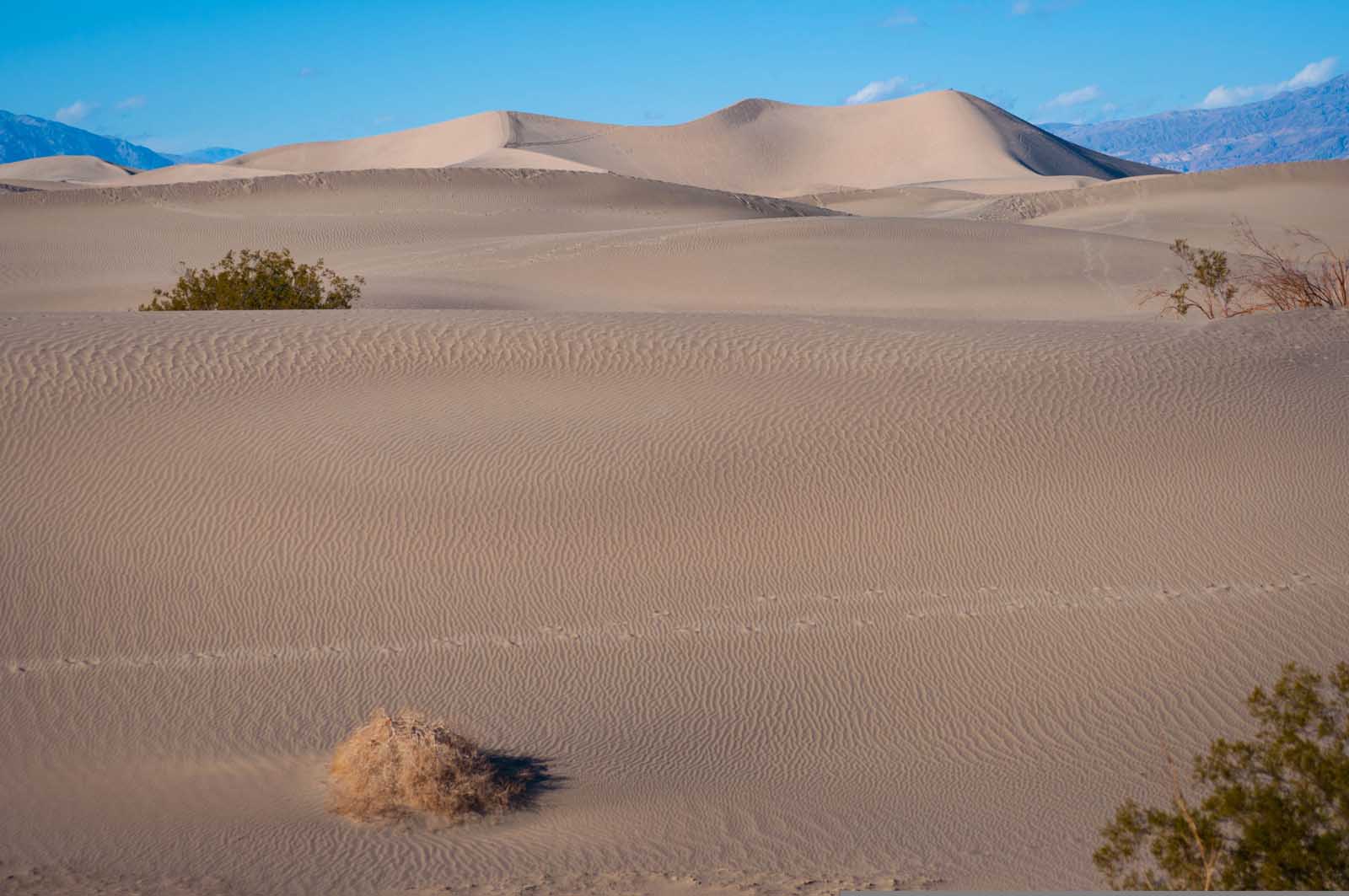
Eureka Dunes are a great attraction for your itinerary. In short, the dunes are massive. They are the largest in California, and some controversially claim they are the tallest in North America. Some dunes rise over 680 feet – don’t be getting ideas about sandboarding, though. Eureka Dunes are closed to sandboarding, sand skiing, and sledding to protect sensitive flora. And who can blame the National Park Service? Eureka Dunes are one of the most impressive natural attractions in the US.
Even though you can’t enjoy sand sports, you can still hike the dunes. Listen carefully while you do, as you may hear the ‘singing sand’. Something about the sand grains moving together creates a beautiful sound, which sounds like an organ bass note. Keep your eyes peeled for desert flora, too, as the dunes are covered in plant life like Eureka Dunes Evening Primrose and Shining Milkvetch.
13. Saline Valley Dunes
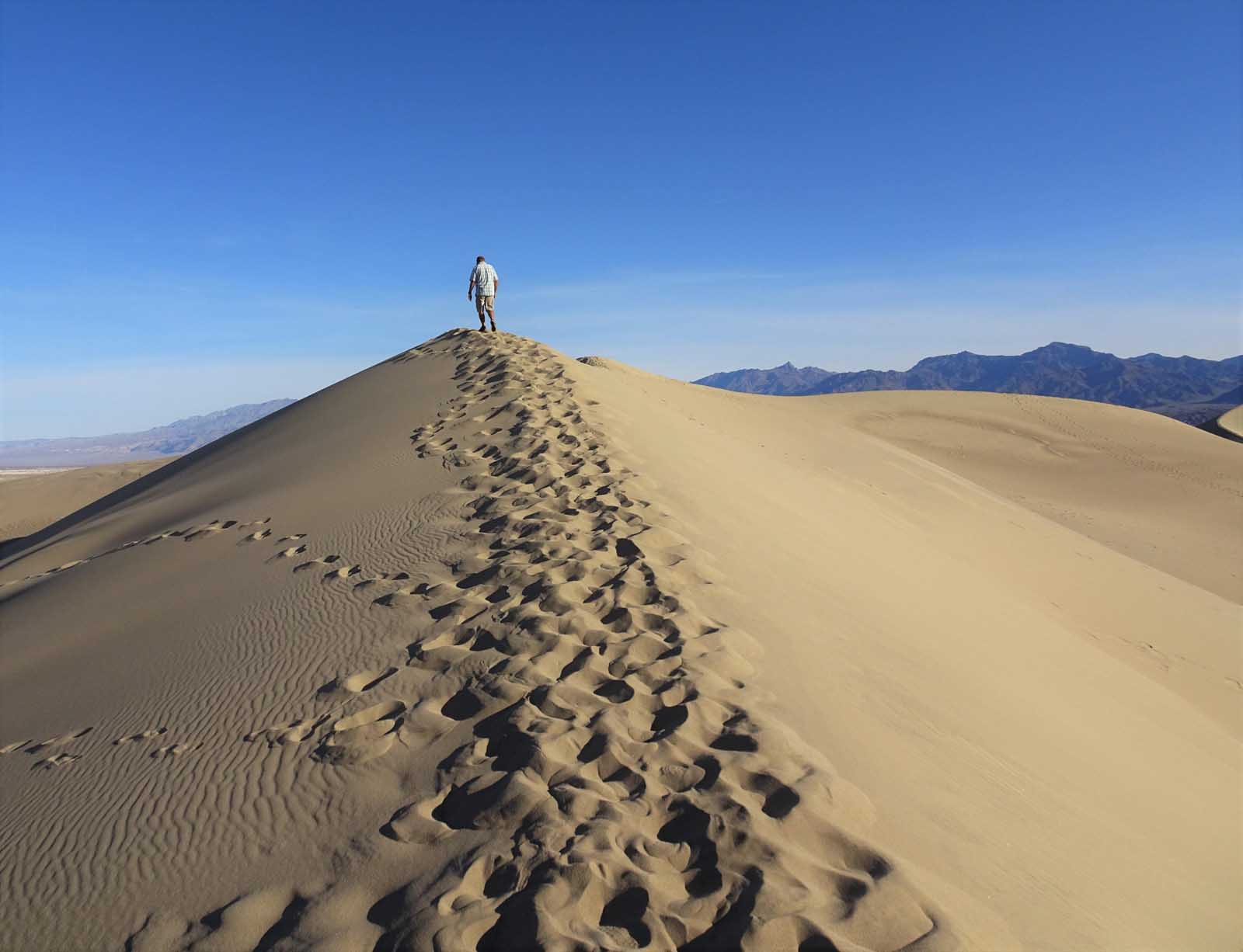
Visiting Saline Valley Dunes is one of the lesser-known things to do in Death Valley National Park. These sand dunes are much lower than the others in Death Valley, and although sandboarding is permitted, the dunes are also much more suited to hiking.
Death Valley’s sand dunes cause quite the stir, despite only covering 1% of the national park. Saline Valley Dunes and Mesquite Flat Sand Dunes are the only dunes that allow activities like sandboarding. Choose one of these sand dunes if you want to try sand sports . Saline Valley is ideal for those who want to get further off the beaten track and prefer attractions with fewer crowds. The dunes have the stunning 10,000 feet high Inyo Mountains as a scenic backdrop.
Getting to the dunes requires a fun, but demanding drive down a rough road, often inaccessible due to flash floods and snow. The road is located off Saline Valley Road and requires a vehicle with high clearance and 4WD. The adventure begins before you even reach the parking lot.
14. Telescope Peak
We have covered the lowest point in Death Valley (Badwater Basin), but what about the highest point? Well, that would be Telescope Peak. Telescope Peak is the tallest mountain in Death Valley and the perfect challenge for hiking and climbing enthusiasts.
Hiking the mountain is no mean feat, and you’ll tackle 3,000 feet of elevation in a 14-mile, 7-hour round trip. The trailhead is located at Mahogany Flat Campground, and reaching it is an adventurous mission. You need a 4WD to access the campground and parking area, and you’ll get a taste of rough (almost off-road) track driving before you even begin your hike. We recommend staying at Mahogany Flat Campground the night before and after your walk to maximize your daylight and energy levels.
While technically a single-day hike, we recommend setting aside at least one evening to camp overnight at the campground. Still, Telescope Peak is easily added to your itinerary. It is also right next to the Wildrose Charcoal Kilns – a brilliant attraction to combine with your hike.
15. Harmony Borax Works
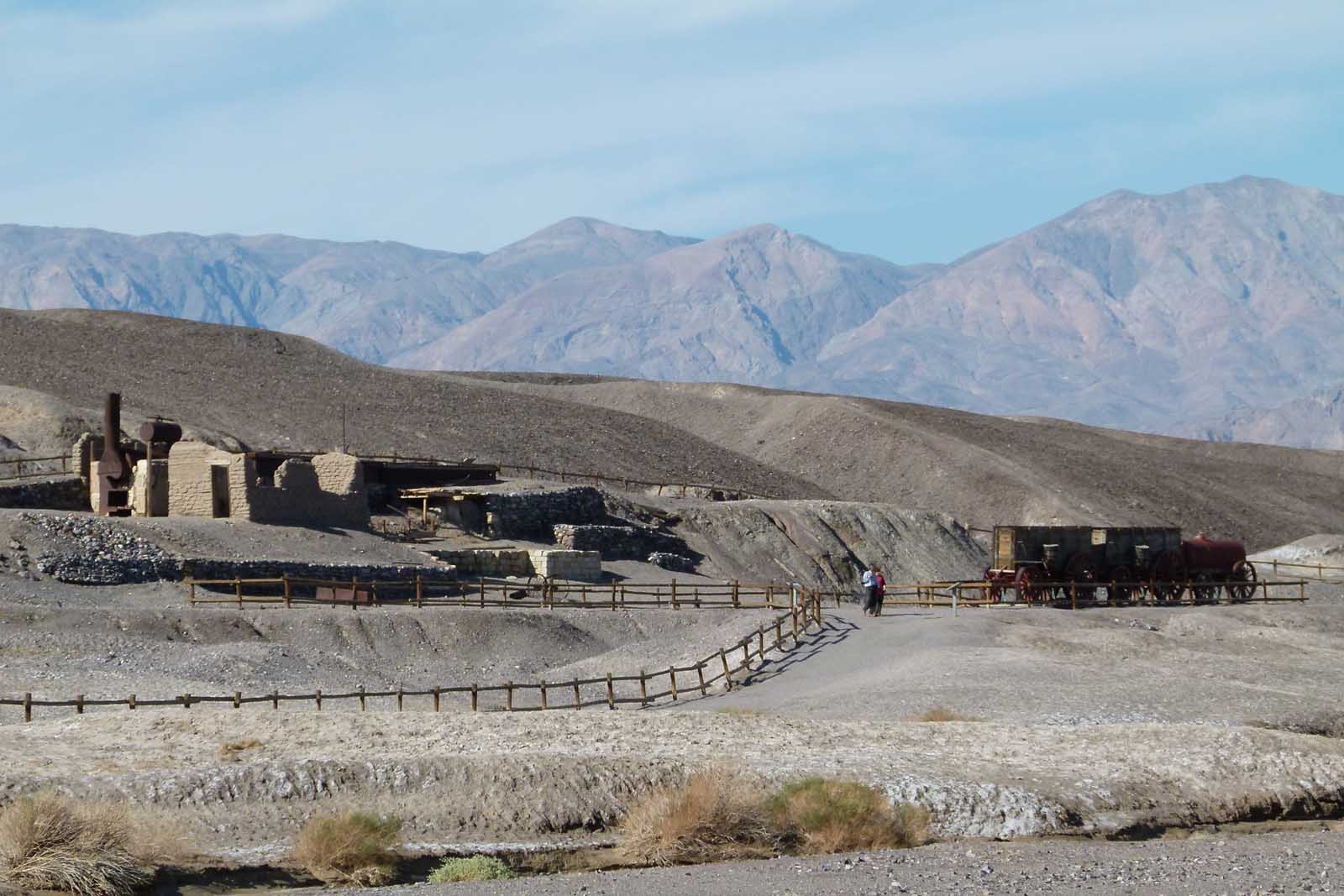
Have you heard of the Harmony Borax Works before? The borax plant was once a thriving business, with 40 employed workers and three tons of borax produced daily. The company was located in Furnace Creek and massively contributed to the town’s popularity and growth in the late 19th century. Nowadays, you can walk around the site on a paved 0.4-mile loop – stopping to read informative panels and view displays along the way.
Visiting Harmony Borax Works is one of the most historical things to do in Death Valley National Park. And while the site is small, it is officially held on the National Register of Historical Places and is a well-known tourist attraction. The wagons from Harmony Borax Works coined the name ’20 mule teams’ because they used large groups of mules to transport all the borax. You may recognize the phrase from Twenty Mule Team Canyon.
16. Manzanar National Historic Site
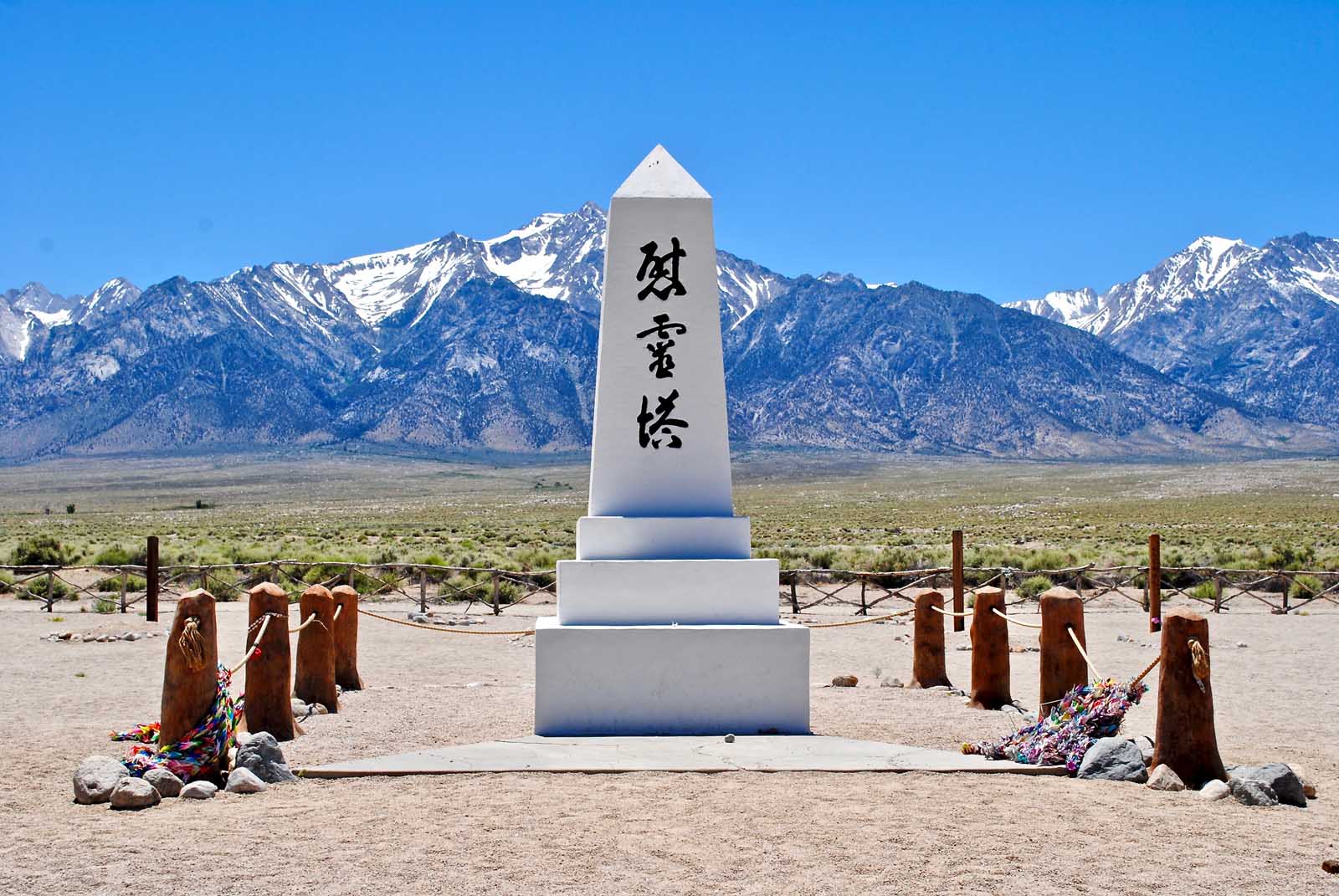
Manzanar is another incredible attraction located just outside the national park boundaries. If you are staying on the outskirts or taking a California road trip , it is well worth stopping by Manzanar. The site was one of ten sites where Japanese Americans were incarcerated during World War II. It is a fascinating, often harrowing place to discover a part of history that isn’t as widely covered.
You can visit anytime between sunrise and sunset, perhaps booking a guided tour if you want a more informative, interactive experience. If you were planning on climbing Mt Inyo, the site is also en route to the trailhead, so don’t rule out Manzanar straight away based on distance.
17. Mosaic Canyon
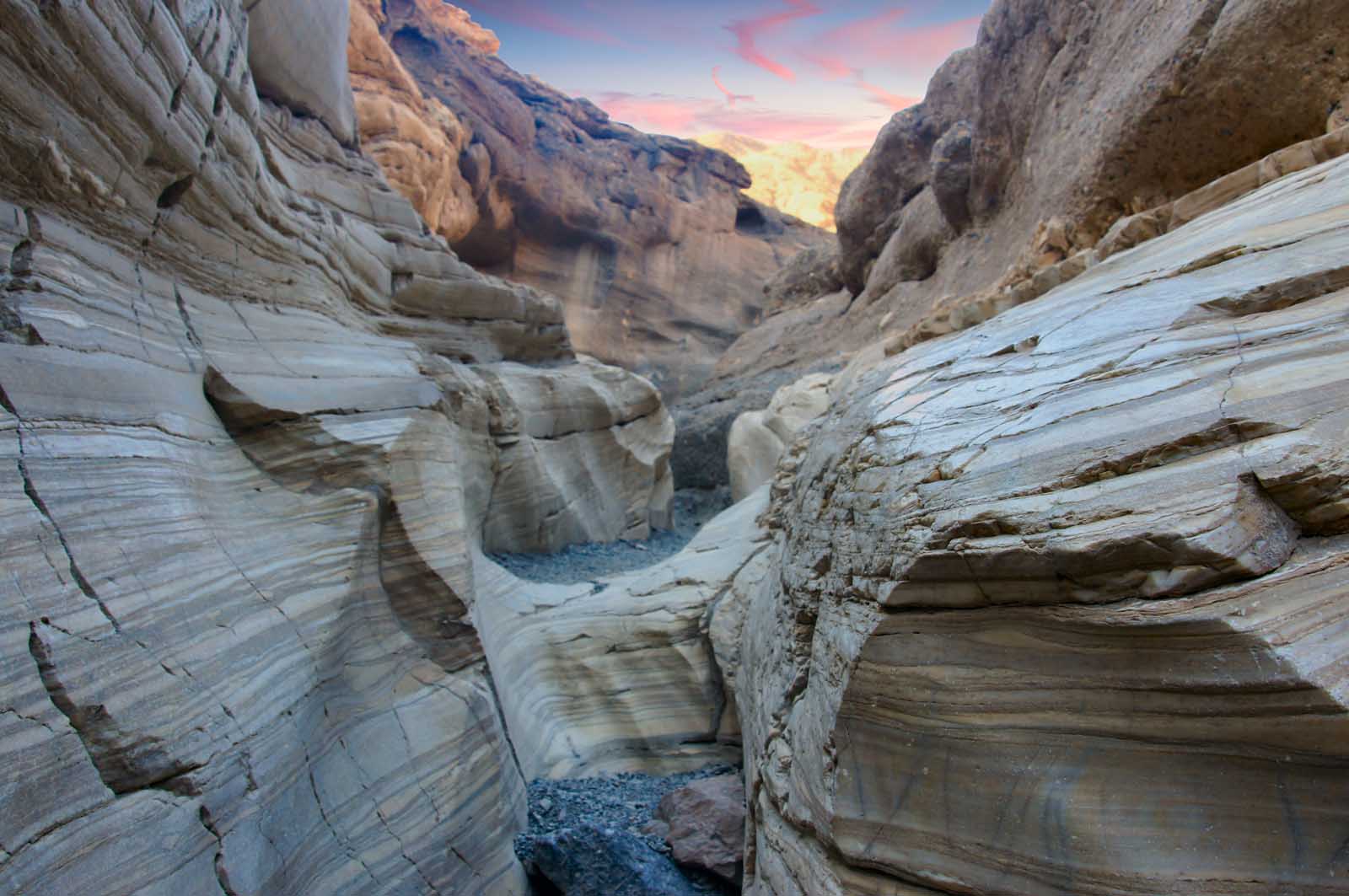
Ready for another beautiful canyon? Mosiac Canyon is a deep ravine formed by flash floods over millions of years. It gets its name from its unique walls, where flood waters full of grit have polished the marble walls, and tiny fragments have become locked in natural cement.
The route is by no means easy. It is rated as a moderate to difficult hike and requires a lot of boulder scrambling and an adventurous spirit to pass certain sections. However, where there is a will, there is a way, and you’ll just need a decent fitness level and good shoes to complete this trail. The trail is around 4 miles out and back; you should allow three hours to complete it.
18. Wildrose Charcoal Kilns
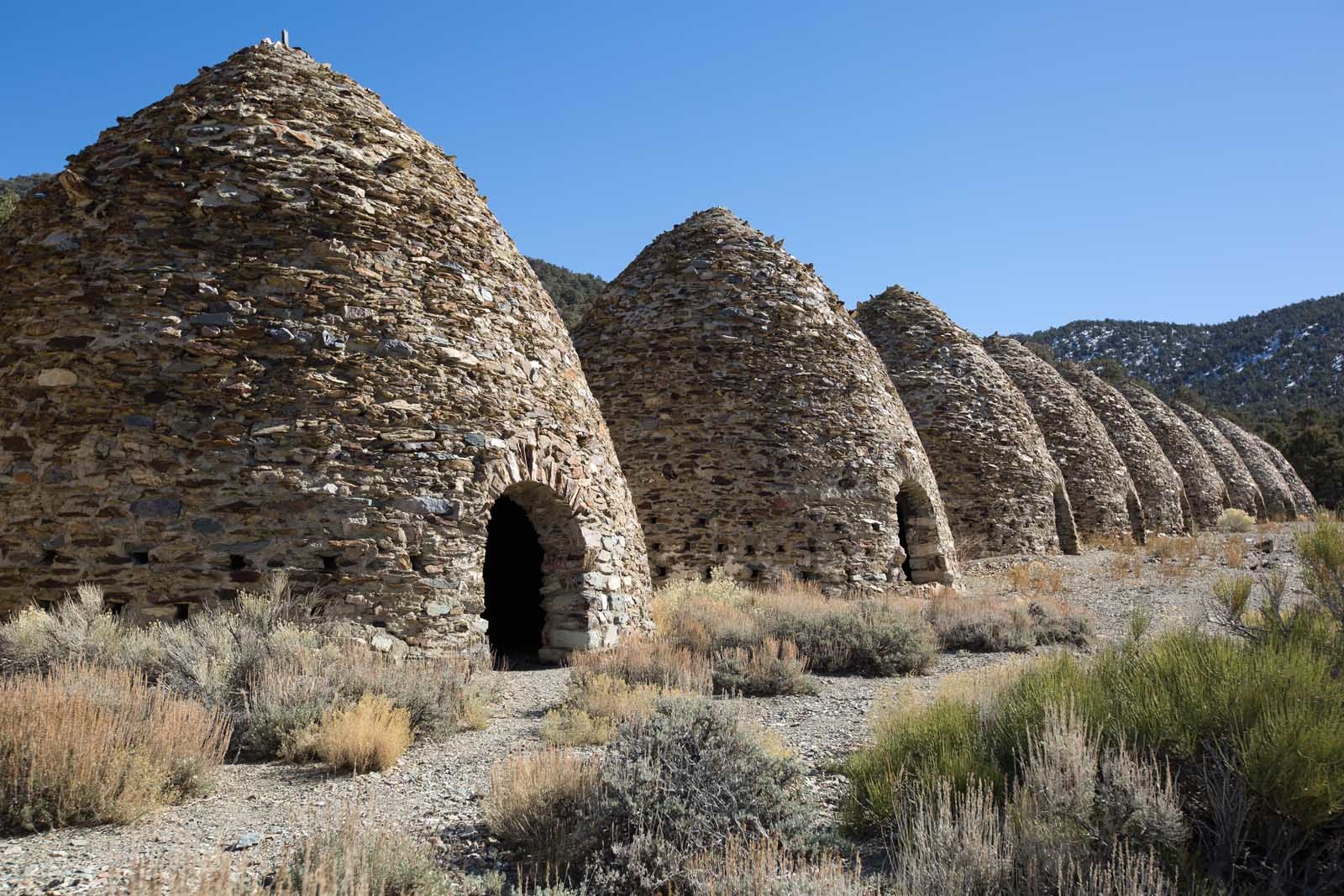
Do you remember us mentioning that Wildrose Charcoal Kilns were near Telescope Peak? Well, the kilns are attractions in their own right. The kilns look like bizarrely shaped houses and have a large hole at the front where you can enter inside. They were built in 1877 to create charcoal for local mines, but they have long since been retired. Now, Wildrose Charcoal Kilns are empty – apart from when a tourist like yourself stops to poke their head in and take a look.
There are ten kilns, all structured in a single line and about 25 feet high. The kilns are in excellent condition, which makes them fantastic for tourists and has kept them firmly marked as worthy attractions in Death Valley. If you’d like to learn more about the early mining industry, Wildrose Charcoal Kilns are a great way to do so.
19. Ubehebe Crater
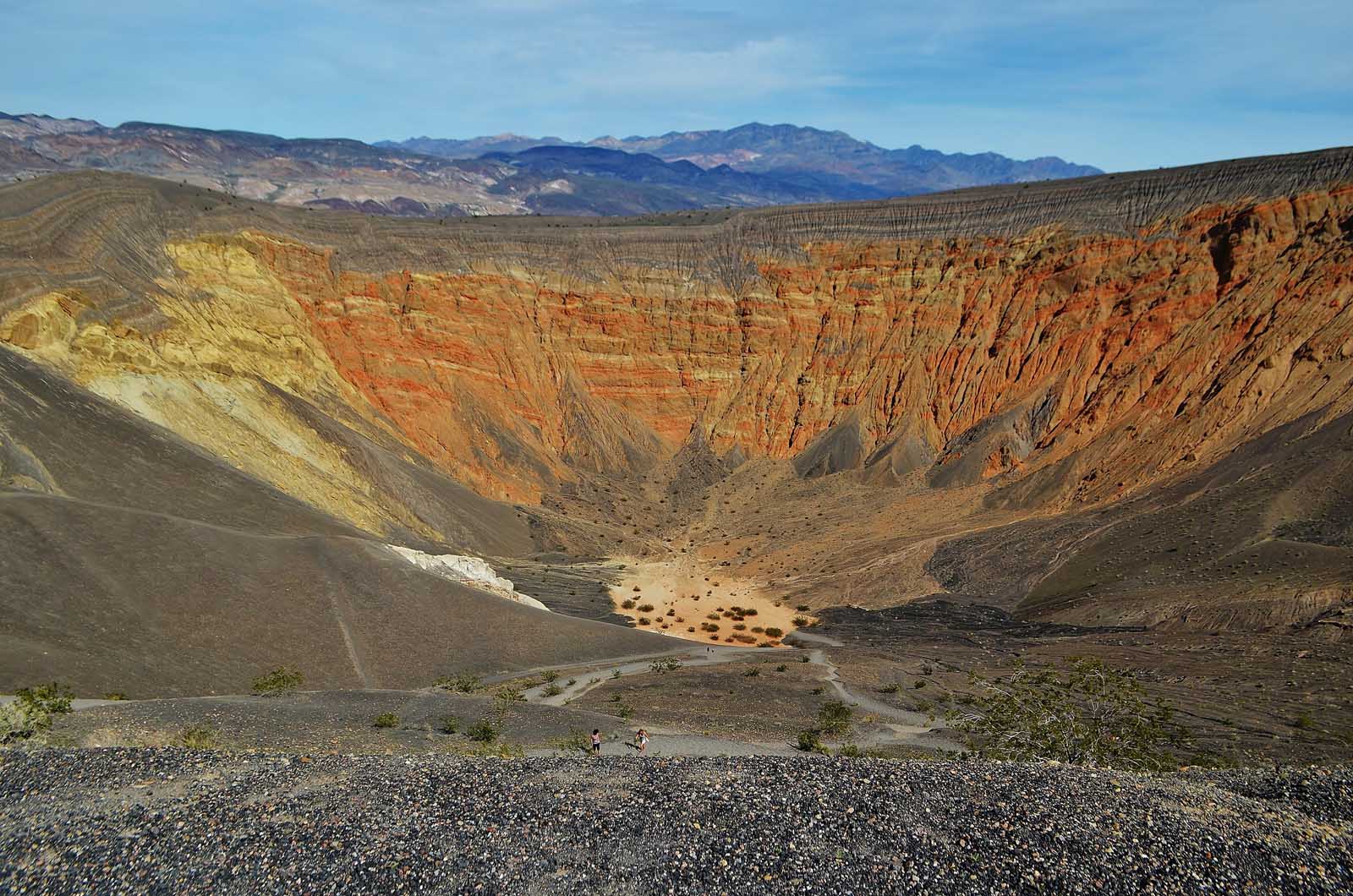
Ubehebe Crater should be at the top of your to-do list if you’ve never seen a volcanic crater. Ubehebe Crater is enormous. It is quite the sight, 600 feet deep and half a mile wide. Ubehebe Crater is still an ashy, dark gray color, which adds to the dramatic appeal.
If you want, you can hike down to the bottom of the main crater. However, you should remember that hiking back up is exhausting and highly strenuous. Walking around the crater rim is a lot easier. However, it is still classed as a moderate hike because of the uneven footing. Take your time on the Ubehebe Crater Rim Trail, and plan lots of breaks to prevent slipping and injury. The 2-mile loop may not be long, but it pays to take your time – plus, you’ll have stunning views while you rest.
20. Racetrack Playa
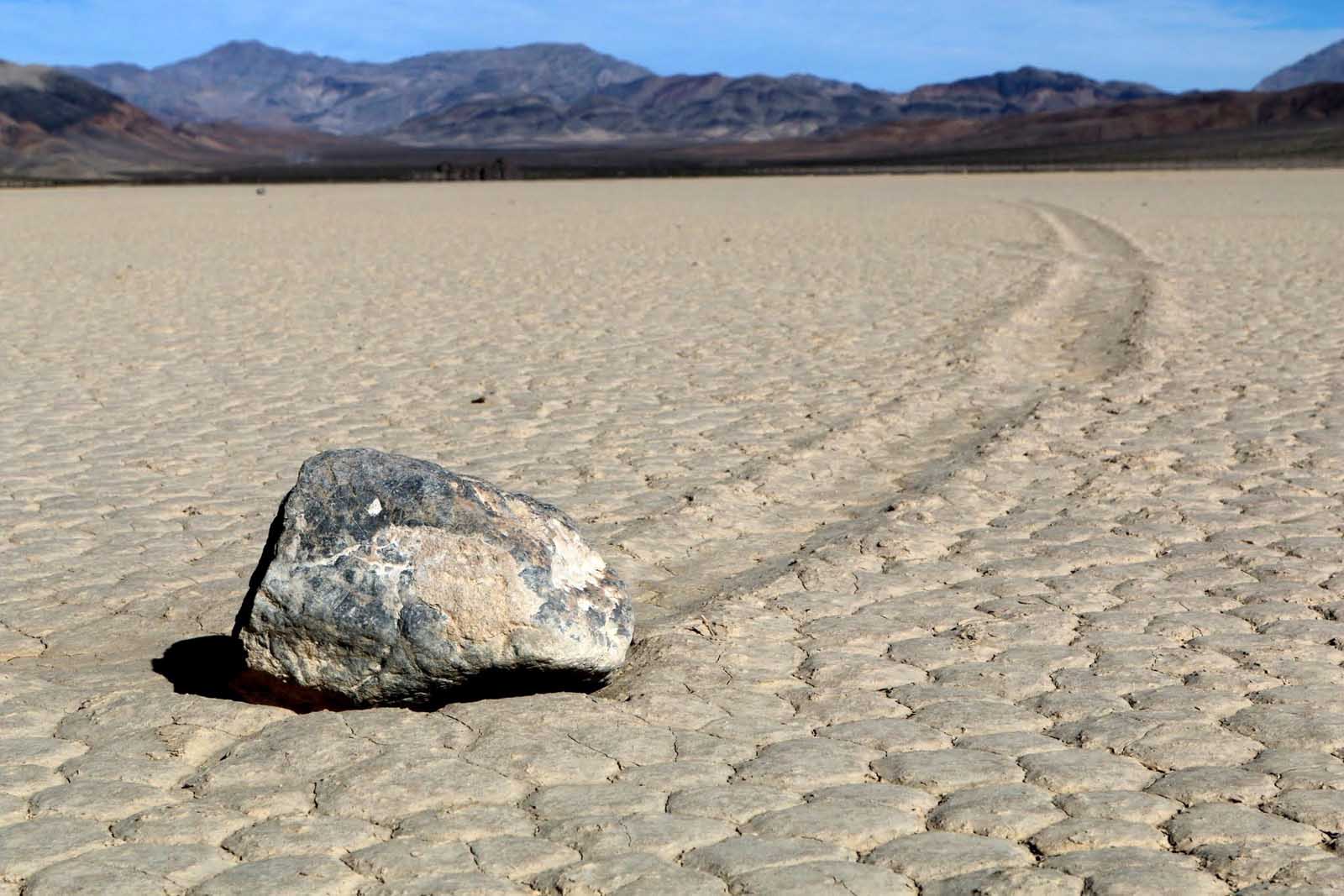
Have you ever wished that you could walk on the moon? If so, Racetrack Playa is one of the best things to do in Death Valley National Park. The dry lake is a scene from the moon landing and is a dramatic, lunar-like landscape to explore and get fantastic pictures of.
Racetrack Playa gets its name from its sailing stones, which are enormous rocks moved by a combination of rain, making the ground slippery and wind pushing the rocks along. The tracks that the sailing stones leave look like race tracks – giving Racetrack Playa its name. It is widely believed that nobody has ever seen the rocks moving, but who knows? Maybe you’ll get lucky.
21. Dante’s View
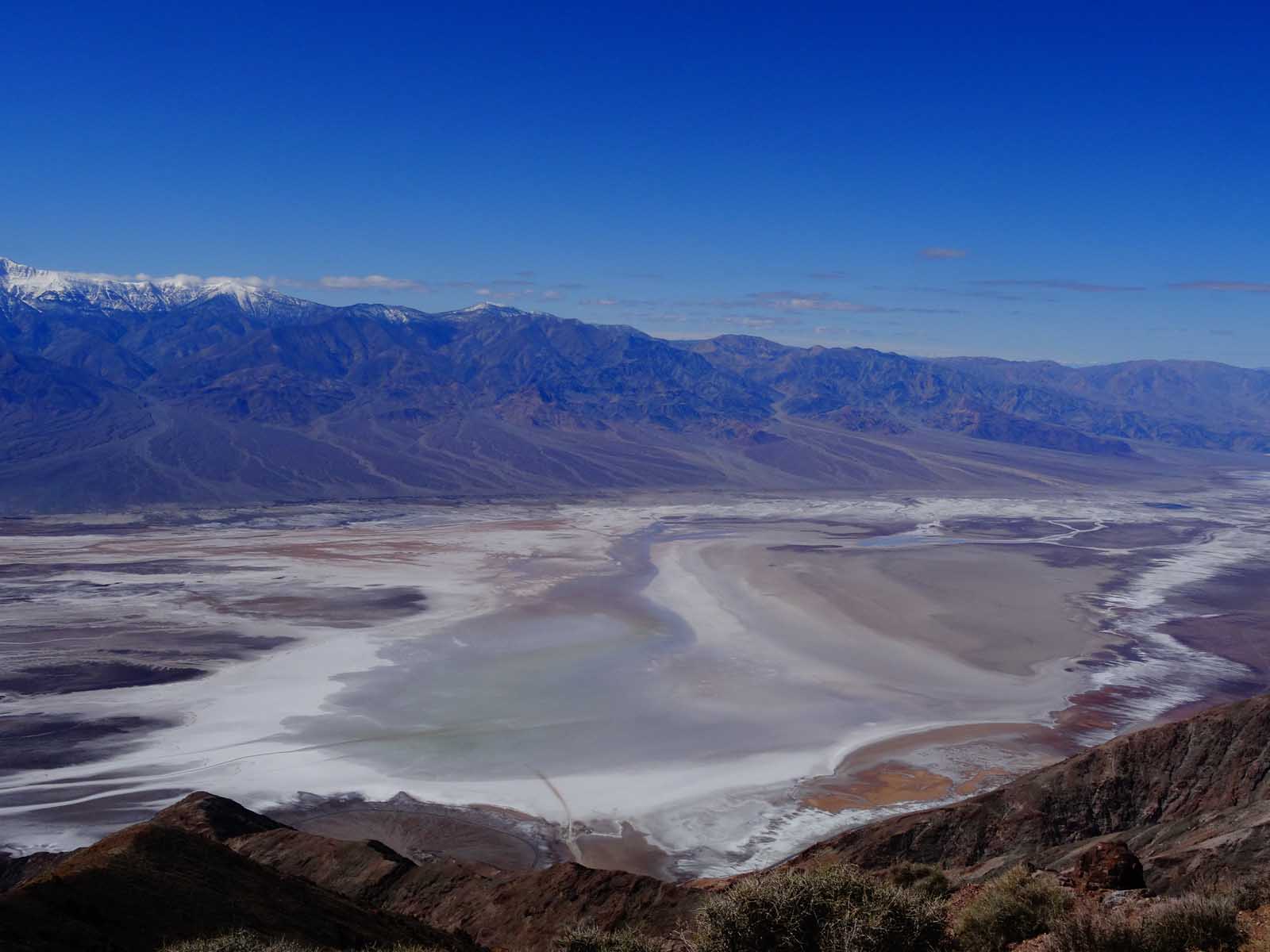
Dante’s View is a scenic viewpoint that towers 5,575 feet above Badwater Basin and sits on a ridge of the Black Mountains. Surrounded by mountains and perfectly fanned by the light breeze, you can enjoy spectacular views over the landscape and dramatic salt flats below. Visiting Dante’s View is about enjoying a different perspective, and viewing Badwater Basin from above is truly humbling.
Dante’s View is popular at all times of the day. Sunrise and sunset are understandably sought-after times, and the salt flats look stunning illuminated by first and last light. However, you can also visit at night for incredible night sky views. In case you didn’t know, Death Valley is an International Dark Sky Park famous for its stunning night sky. Head to Dante’s View after a busy day of sightseeing to relax and unwind under bright constellations and shooting stars.
Death Valley FAQs
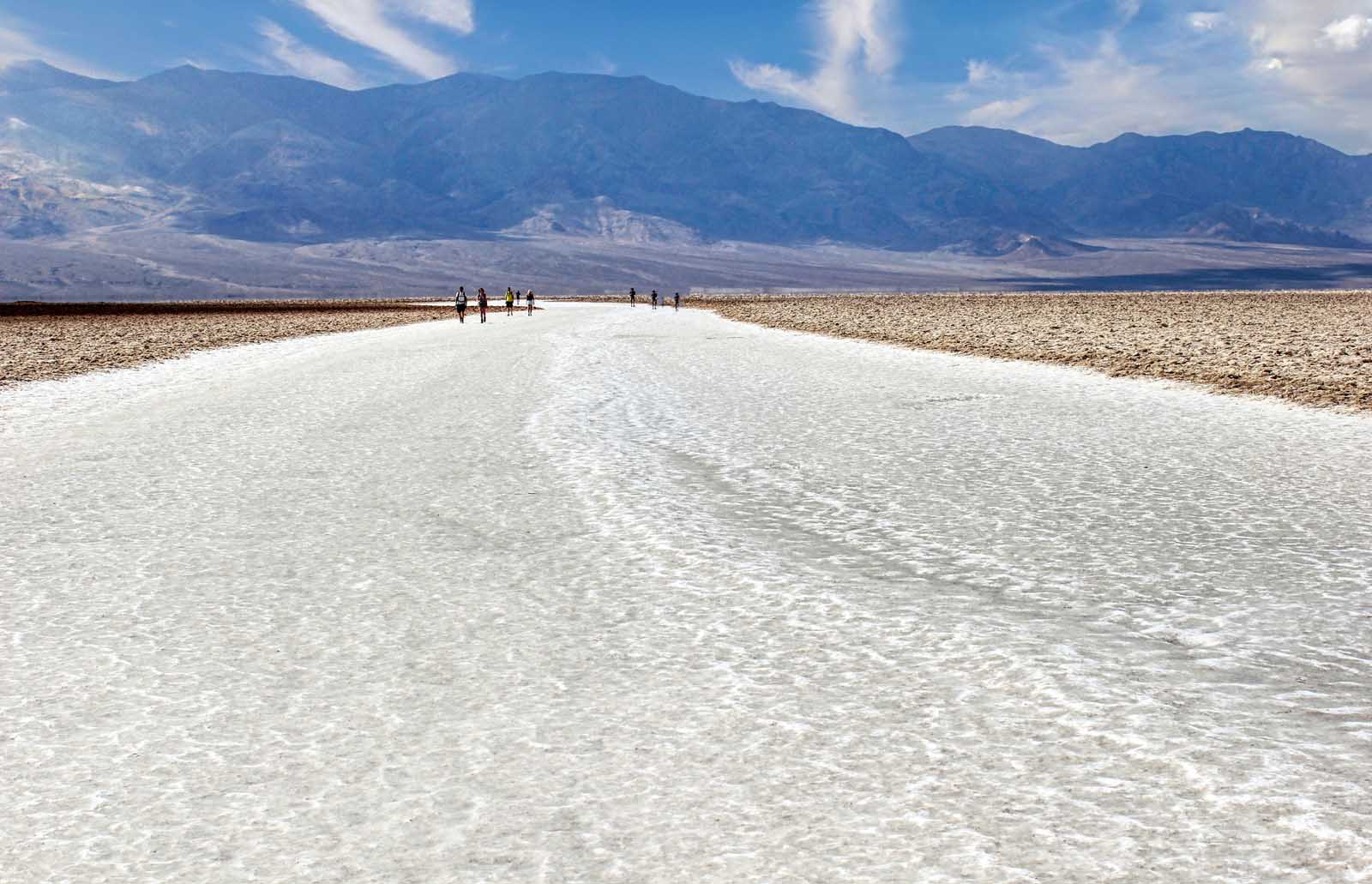
Now that we’ve covered all the best things to do in Death Valley National Park let’s look at some essential information. These are the most common Death Valley FAQs; let’s dive straight in.
How to get to Death Valley
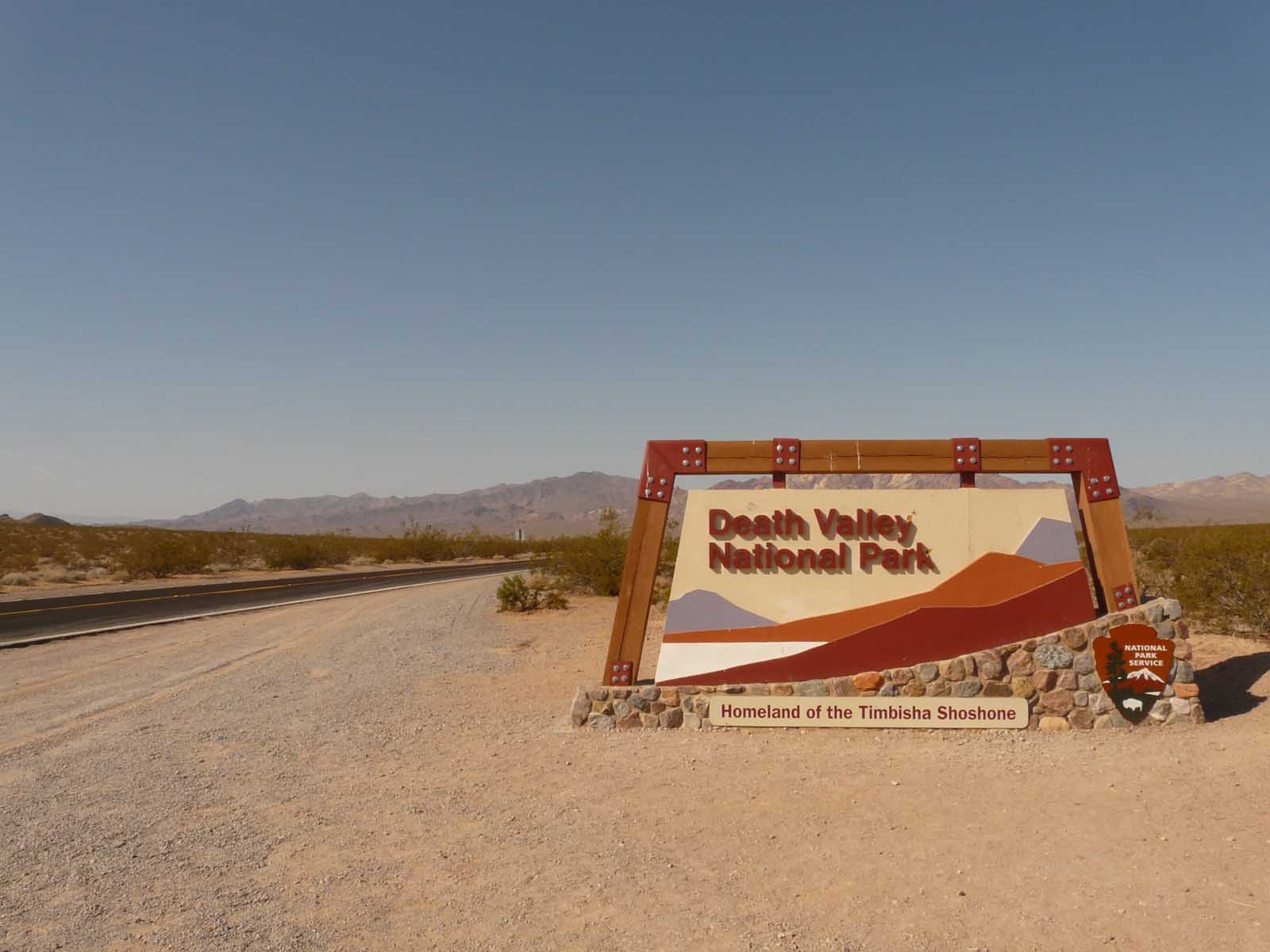
First off, let’s establish Death Valley’s location. The national park straddles the California/Nevada border, although most of the park falls in California.
Because of Death Valley’s inland location, the easiest way to reach the national park is to fly into Las Vegas. Those wanting the quickest way to Death Valley should fly into Las Vegas Airport, hire a car to drive to Death Valley, or book a guided tour.
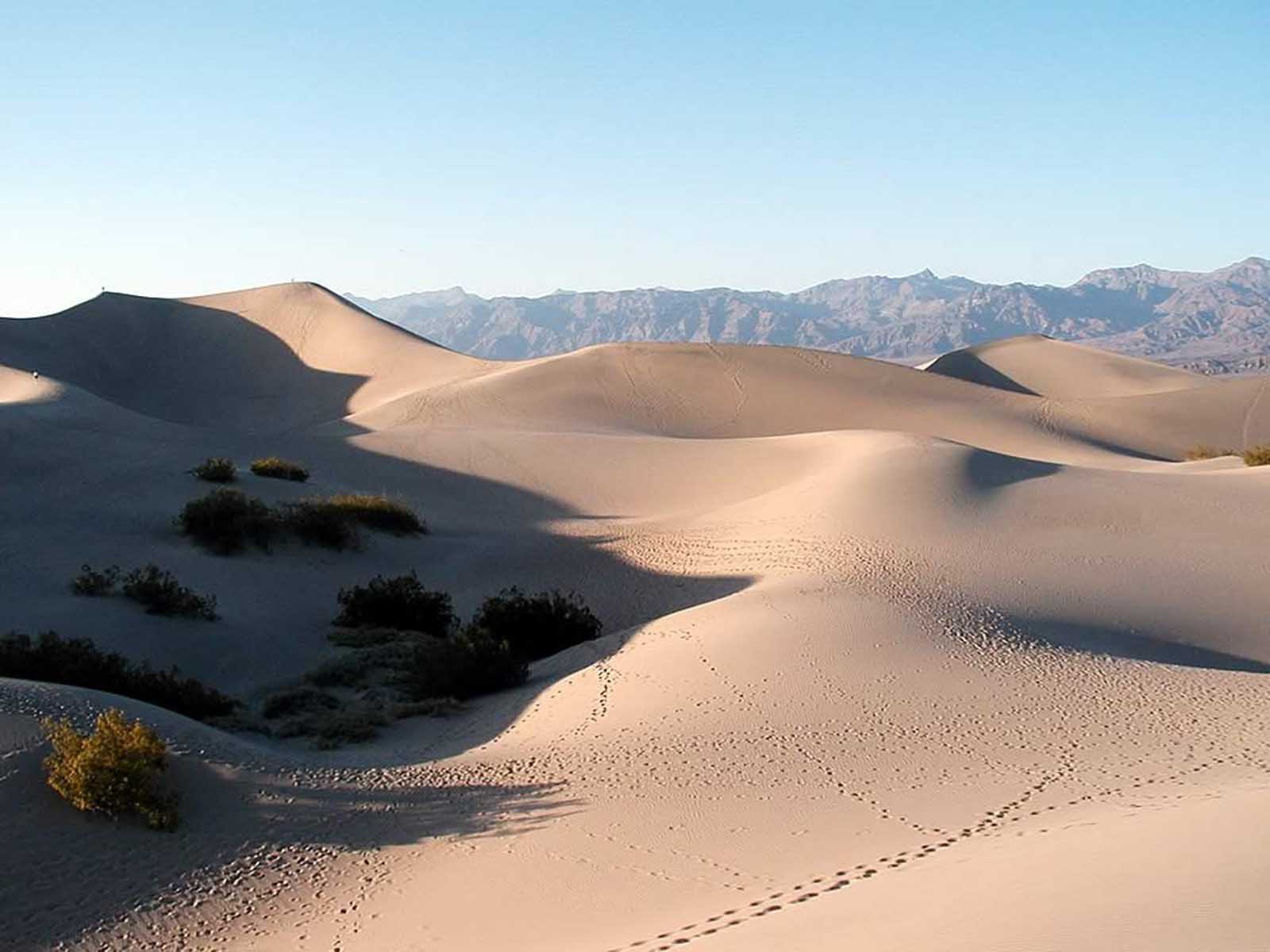
Of course, if you aren’t on a time limit, you could get your adventure on and take a California road trip, perhaps exploring Northern California along the way. If you are really up for an adventure, you could extend your trip and finish in Las Vegas – where you can fly home. Death Valley is ideally located for a road trip; if you have the time, this is the most fun way to get to the national park.
Getting around Death Valley
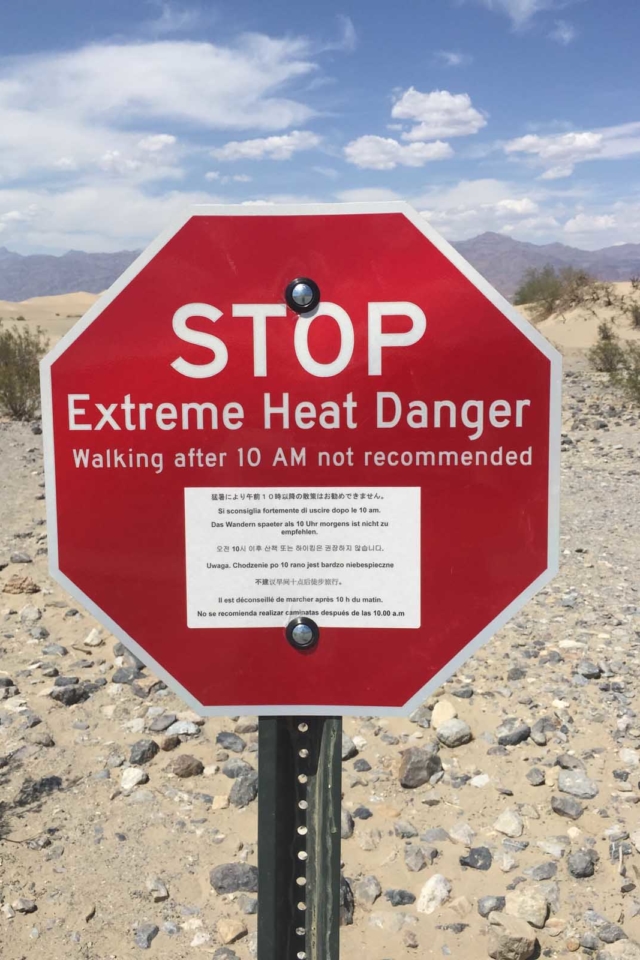
As the largest national park, Death Valley’s public transport system leaves much to be desired. You won’t find any public buses or shuttles, so your only option is to purchase a guided tour or rent a car to drive around.
Allow a day to get around Death Valley and see your top few attractions. And, if you don’t want to drive for so many hours in a single day, it is worth finding overnight accommodation to maximize your experience.
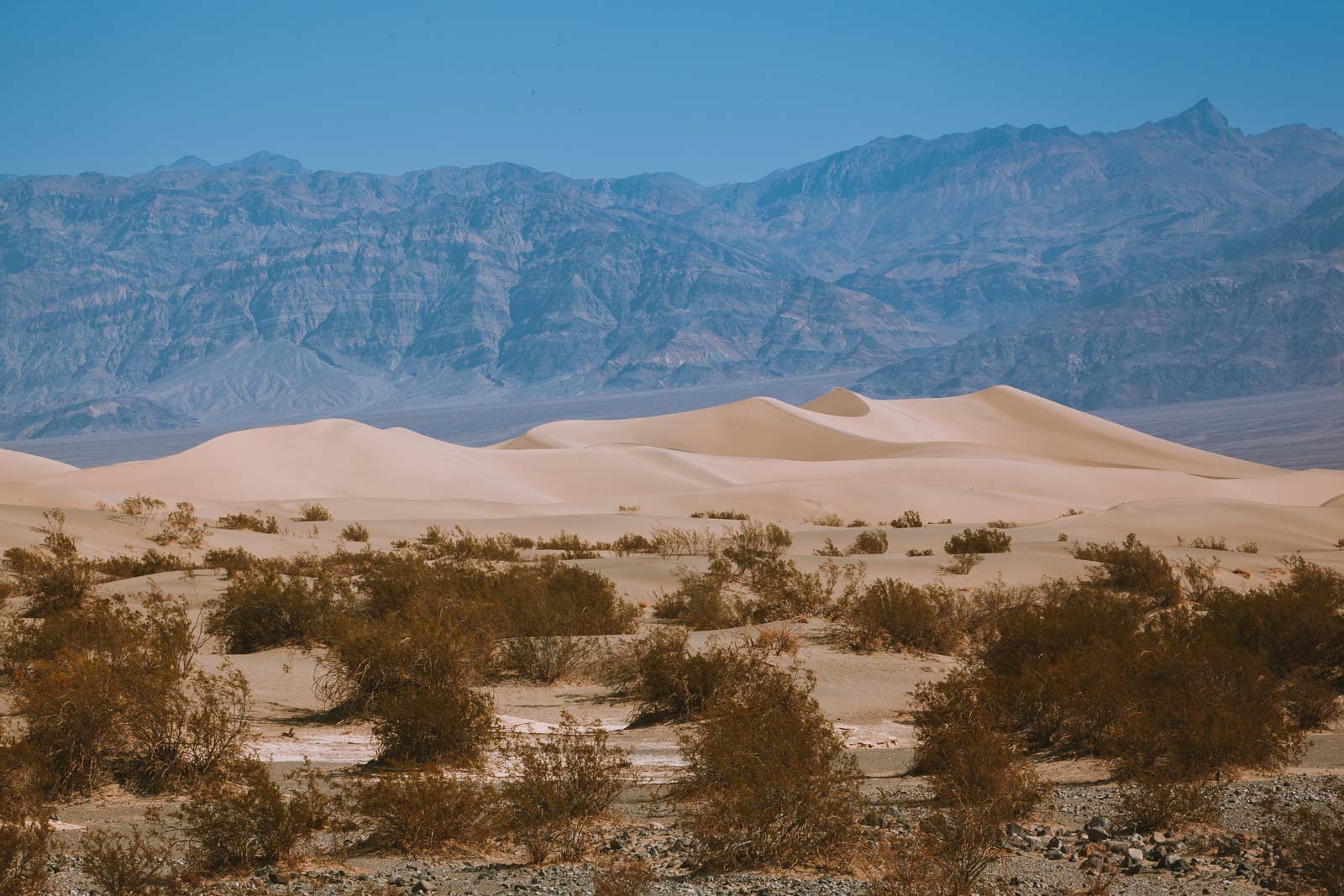
Before you set off driving or on your tour, it is always worth checking for road closure and trail updates in Death Valley online. The desert landscape might be beautiful, but you don’t want to drive the length of Daylight Pass Road before realizing you’ve got to turn around. Remember that gas stations are also limited in Death Valley. If you pass Furnace Creek, top up at the Furnace Creek Gas Station – one of the most centrally located options and accessible gas stations to combine with sightseeing.
Where to stay in Death Valley
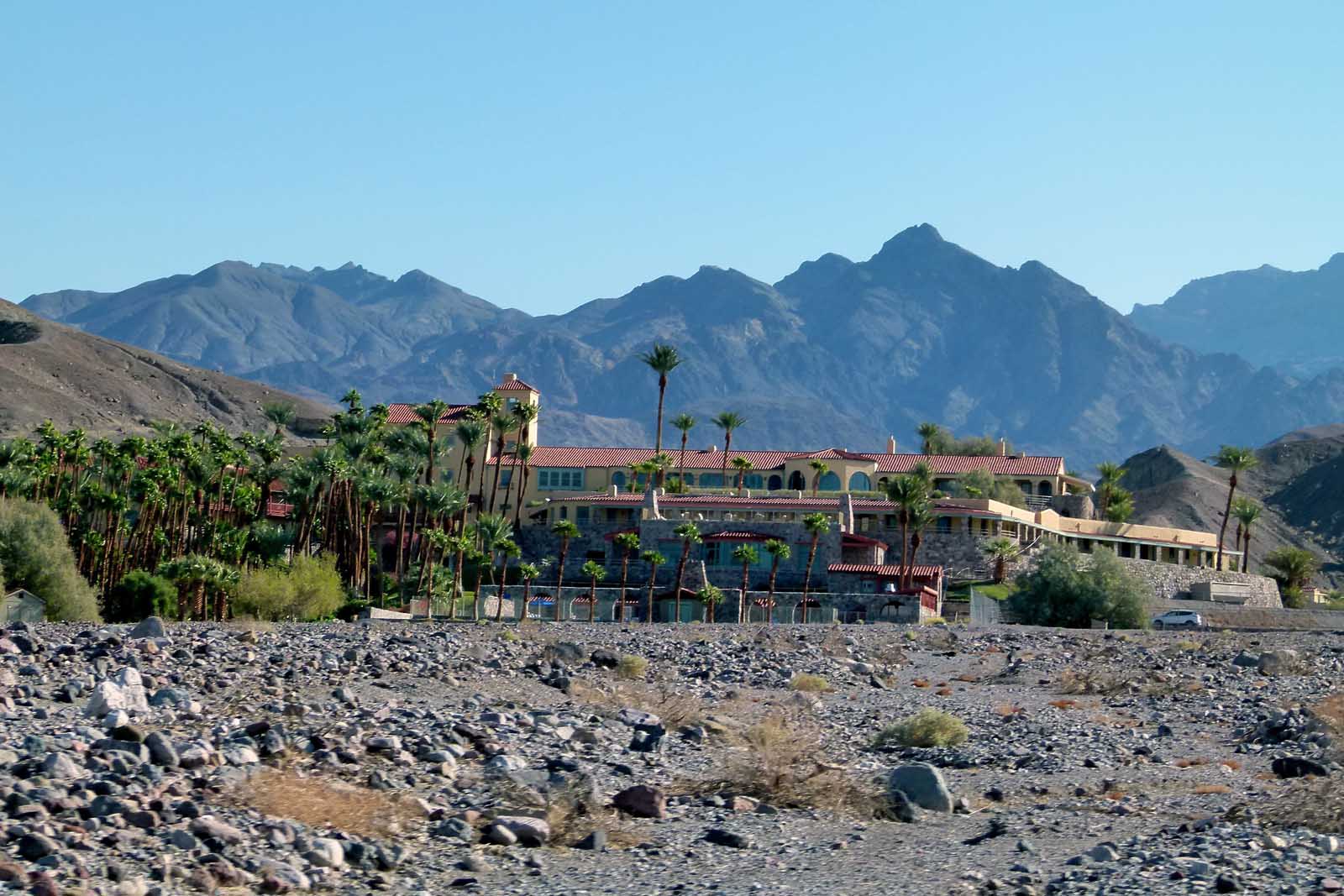
So, where should you stay in Death Valley? These are our top recommendations that you could choose from.
Budget: Panamint Springs Resort
Panamint Springs Resort is a budget traveler’s ideal spot in Death Valley. The resort is family-run and offers an impressively flexible range of accommodation choices, including a campsite, a selection of cabins, and standard hotel rooms.
The resort has its own gas station, general store, and shower facilities for campers. Plus, there is a breakfast buffet served daily. It is the perfect place to base yourself if you want budget-friendly accommodation within the boundaries of Death Valley National Park.
Mid-Range: Delight’s Hot Springs Resort
Delight’s Hot Springs Resort sits just outside Death Valley and is the perfect base for easy access to the national park. The resort has four spring water swimming pools – two indoor and two outdoor to which guests have 24-hour access. There is also a free parking area and a 24-hour reception desk.
Delight’s Hot Springs Resort has a perfect balance of affordable luxury, attentive hospitality, and a convenient location.
Luxury: The Inn at Death Valley
The Inn at Death Valley might be listed as a three-star property but don’t be fooled; this is the best luxury option in the national park. The location is dreamy, and you’ll be in the center of Death Valley, just outside Furnace Creek. The property offers a range of rooms, suites, and a bungalow, so you can always splash out for a bit of extra luxury.
Guests receive access to a sauna, a fully equipped gym, two spring-fed pools, a golf course, and tennis courts. Death Valley isn’t known for its urban amenities, so having a hotel with plenty of recreational activities is a huge bonus.
The best time to visit Death Valley
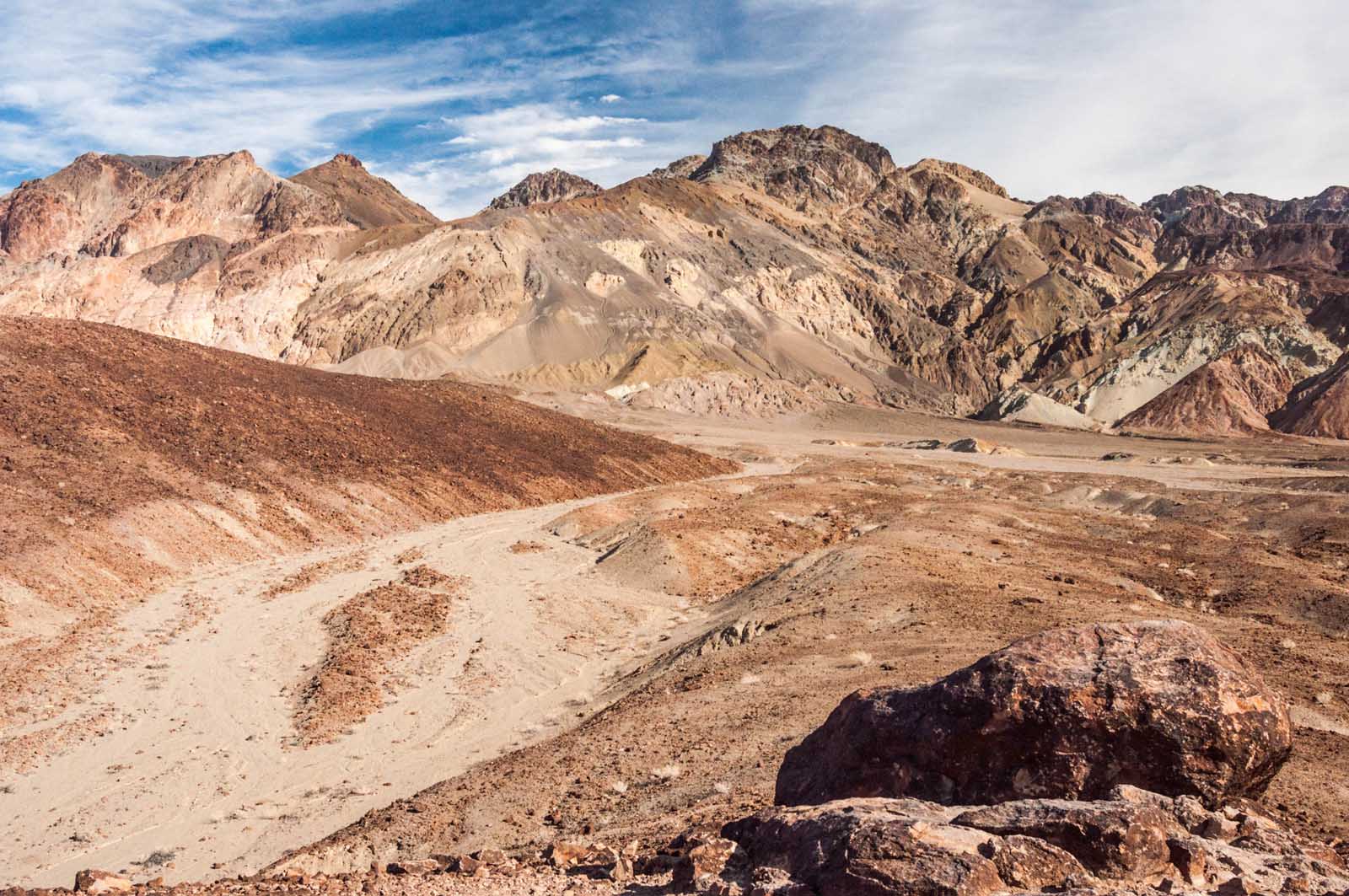
Death Valley makes a great destination in early spring. The temperatures are cool, the wildflowers are out, and it is the best time to comfortably enjoy all the things to do in Death Valley National Park. It can get a little busy, as this is the most popular time to visit Death Valley, but it is worth the crowds for the beautiful conditions. Late March and April are the best months in spring.
October is your month if you have your heart set on avoiding crowds. You won’t get the wildflowers. However, autumn brings cooler weather that is perfect for exploring the valley floor. Visiting Death Valley in October is a pleasant, quieter experience.
When should you avoid Death Valley? Well, it doesn’t take a genius to figure out that the summer is not the best time to visit Death Valley. In summer, the California desert is unhospitable and unpleasantly hot. Stick to visiting in March or April if you don’t mind the crowds and October or November if you don’t mind missing the spring bloom.
Final Thoughts
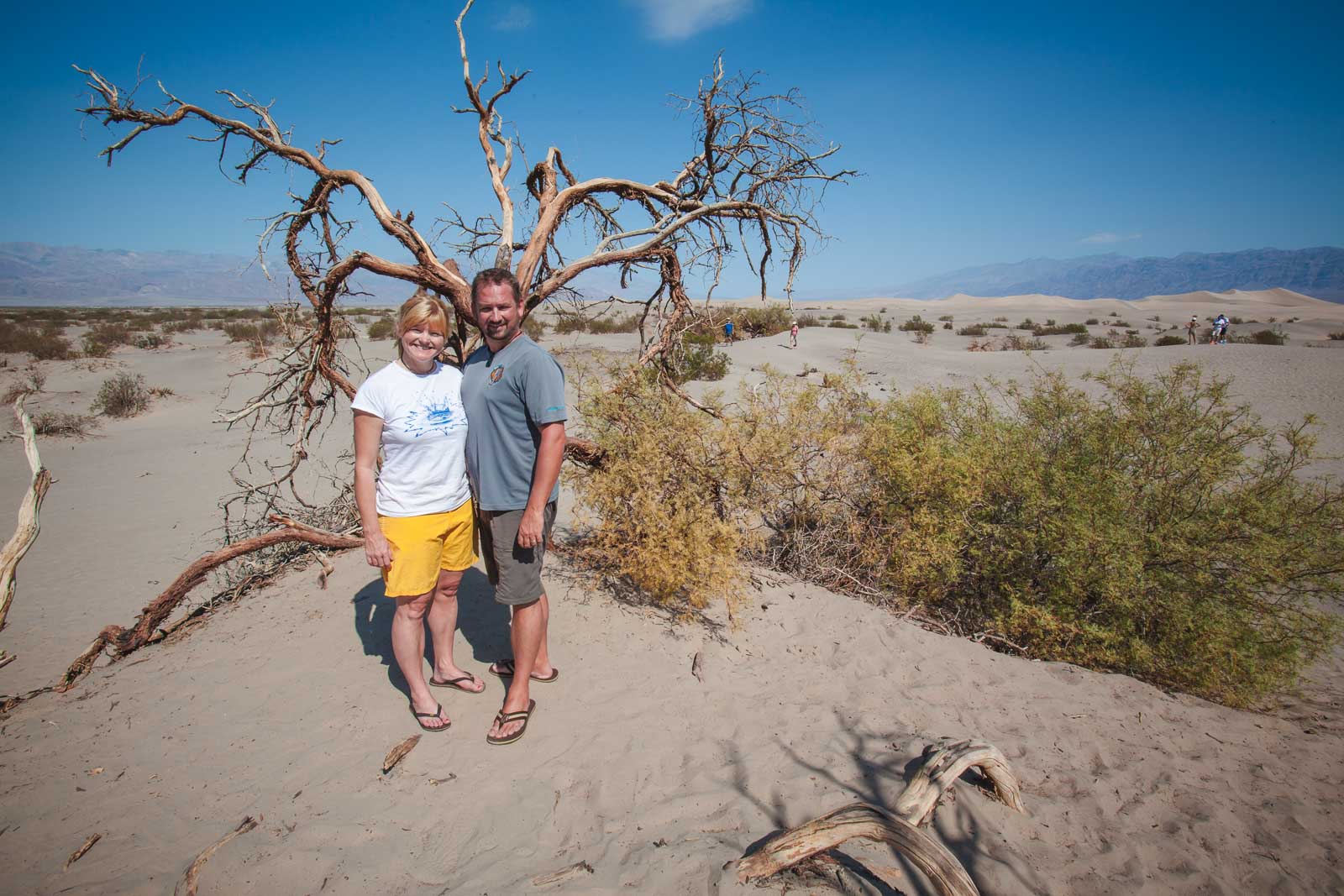
Once you’ve visited Death Valley, you should definitely return for a second visit. There are so many things to do in Death Valley National Park, and even visiting Death Valley in different seasons can drastically change your experience. The national park has some of the best hikes in California . It is also within driving distance of other fantastic national parks like Yosemite .
We hope you have a fantastic time in Death Valley. Take our advice and experience as many of its attractions as possible. These Death Valley ‘things to do’ are sure to guarantee you a memorable trip.
Plan Your Next Vacation to California With These Resources
- 25 Things to do in San Jose, California
- Where to Stay in Yosemite
- 16 Best Cities in California
- 24 Of The Best Beaches in California
- 15 Best Hikes in California – Inspiration to Get Outdoors
- 7 Epic Places to Visit in Northern California
- 20 Great Things to do in Monterey, California
- 25 Best Things to Do in Los Angeles – Hollywood, Hikes, And More
- 15 campgrounds in Big Sur, California
Travel Planning Resources
Looking to book your next trip? Why not use these resources that are tried and tested by yours truly.
Flights: Start planning your trip by finding the best flight deals on Skyscanner
Book your Hotel: Find the best prices on hotels with these two providers. If you are located in Europe use Booking.com and if you are anywhere else use TripAdvisor
Find Apartment Rentals: You will find the cheapest prices on apartment rentals with VRBO .
Travel Insurance: Don't leave home without it. Here is what we recommend:
- Allianz - Occasional Travelers.
- Medjet - Global air medical transport and travel security.
Need more help planning your trip? Make sure to check out our Resources Page where we highlight all the great companies that we trust when we are traveling.
You May Also Like
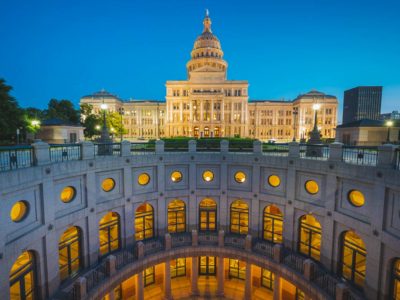
26 Best Things to Do in Texas We Recommend in 2024
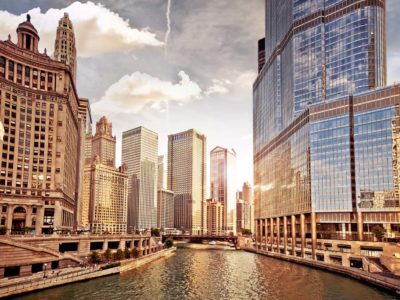
Where To Stay in Chicago (2024): 6 Best Areas For Every Budget
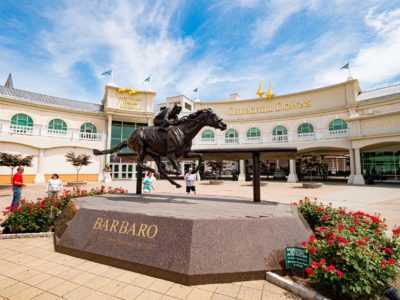
26 Best Things to Do in Louisville, Kentucky in 2024
About ThePlanetD Team
Guest writers for The Planet D offer insider tips and information on destinations that they are experts in. We can't be everywhere at once, and it is important to have the highest level of travel information from local writers and experienced travelers.
Join thousands of others who get our monthly updates!
Leave a comment cancel reply.
Save my name, email, and website in this browser for the next time I comment.

The Coolest Things to do in Death Valley!
The name Death Valley brings with it a mystique, a note of fear. Growing up, I saw media images and heard stories that scared me. Death Valley seemed like one of those places you could go and get lost, and as the name says, die. But the truth is, Death Valley is a beautiful place with a unique ecosphere that is teeming with its own kind of life. There are a ton of things to do in Death Valley, and there are also some super cool things to do in Death Valley.
Death Valley is not only unique in the National Park Service, in its environment of extremes, it is also unique in the world, being in a Unesco International Biosphere Reserve, and an International Dark Sky Park. It is a place everyone should see and experience! There are things to do in Death Valley that cannot be done anywhere else in the world!
Yes, there are certainly dangers in the park, but more often than not, they are caused by foolishness and a lack of preparation. Check out the National Park Service Safety Tips, if you are wondering what risks do exist, and if you are interested in more information about the park’s uniqueness, check out our Interesting Facts about Death Valley .
While Death Valley may be known for being the home of the hottest place on earth, from November through early April the temperatures are typically quite pleasant. Not only can you drive Death Valley Road, you can also get out and explore the surreal landscape and environment, and experience all of the cool things to do in Death Valley, without falling into heat exhaustion! That is the best time to visit Death Valley.
If you are planning to include your time at Death Valley as part of a National Park road trip, you may want to visit Yosemite next as it is the shortest drive, at just over 3 hours. Other options include visiting Joshua Tree, at 4 hours away, Sequoia Kings, at 5 hours, and Grand Canyon at just over 6 hours drive to the south rim.
All the Cool Things to Do in Death Valley, and Nearby
We are not going to talk a lot about those famous places you have heard of. Yes, we will mention them, briefly. If you wanna know about the regular stops, read our Death Valley Day Trip Itinerary. But if you are here, you probably want something above and beyond what everyone else does, we are going to give you some entirely different things to do in Death Valley! We are excited about that!
Be Typical Seeing all the Big Name Attractions

This is one of the most popular activities in Death Valley. Yes, we had to at least mention the most common thing once, since everybody does it! Badwater Basin, Zabriskie Point, Artist’s Pallet, I won’t go through them all here. The truth is, most of them ARE pretty cool things to do in Death Valley, but they are not unique. You should probably see them either way. If you want to know all about them, or you only have a day, check out our Death Valley Day Trip. If you have more time for unusual things, keep on reading here.
Be Immortalized on Social Media
Get some excellent photos and some fun selfies at some of the parks most Instagram worthy, Snap Chattable and TikToking locations. Some spots we suggest- Zabrieski Point, Artist’s Palette, Red Cathedral, Badwater Basin (at the sign and on the flats), Harmony Borax Works, Mosaic Canyon, Devil’s Cornfield, Mesquite Sand Dunes, Teakettle Junction, and Dante’s View. There are amazing photo opportunities throughout the park, with the surreal desert landscape. When you are done you may want to travel of all of the other fabulous Instagram spots in the California desert!
Be Guided on a Ranger Led Tour

Offered only between November and March due to weather, ranger led tours and informational talks take place in various locations, and cover topics from geology to wildlife, to history. While this might not be one of the most unique things to do in Death Valley, the topics themselves are generally unique to the park. Tours are based out of the Furnace Creek Visitors Center, and the Death Valley History Association.
Be Promoted to Junior Ranger (- or help the kids do so.)
The Junior Ranger Program is an excellent part of several US National Parks, including Death Valley. Pick up a booklet at a ranger’s station, and let it lead you through the attractions, and a fun learning adventure. After completing the activities, children up to age 12 are sworn in as Junior Rangers, and awarded a ranger pin. I helped my grandsons achieve theirs at Mammoth Cave National Park.
Be Adventurous in a Slot Canyon

Slot canyons offer one of the most scenic and surreal hiking venues in the desert environment. Most people envision hiking Antelope Canyon, but many people are unaware that Death Valley National Park features several of these stunning canyons. Mosaic Canyon is one of the most popular among hikers, located just outside of Stovepipe Wells, and Titus Canyon, which is accessed from highway 374 before entering the park, is loved by hikers and 4 wheelers alike.
Be Exploring at a Volcanic Crater

There are dormant volcanoes all across the western United States, but there are few craters that are open and accessible. While you can see cinder cones at Lassen Volcanic National Park and Craters of the Moon , Ubehaha crater in Death Valley is much easier hike. The name originated with local Native Americans, and means appropriately, big basket in the rock. Being a Maar volcano, the crater was formed by an explosion of ground water heated by the magma below, and not lava, which accounts for its lower, broader surface.
** The roads to Ubehaha Crater are currently closed due to flash flood damaged. The National Park Service hopes to have them reopened soon.
Be Spooked at a Ghost Town

Anyone with a fascination for abandoned places can’t pass up a good old-fashioned ghost town. There are several boom to bust ghost towns in and around Death Valley with varying degrees of remnants. The most well-known and easily accessible is Rhyolite, outside of the park boundaries, but there are several others within the park that can only be accessed by hiking. Other well known and accessible towns include Skidoo, Panamint, Keeler, and Cerro Gordo.
Be Entrepreneurial at Old Mines
Death Valley and the surrounding mountains are a land of would-be millionaire miners, seeking gold, silver, borax, salt and even talc. A plethora of mines were abandoned and have fallen into varying degrees of ruins. The tools and equipment left behind offer intriguing exploration and photo opportunities. The Keane Wonder Mine, which produced over a million dollars worth of gold, is the most well-preserved and easily accessible.
Be Ecological Seeing Critically Endangered Fish

Death Valley is the natural habitat of 5 different species of pupfish, which are entirely unique to the region, found nowhere else on the planet. Their small habitat makes the particularly at risk due to human developments, and all species are protected. It can be quite exciting to find and observe this tiny fish that only exists here. The easiest to find is the Salt Springs Pupfish, by hiking the boardwalk trail that leads to the headwaters of the spring.
Be Soothed by Natural Hot Springs
There are several developed sites for hot spring soaks within Death Valley. The easiest to access is the Furnace Creek Inn pool, which is piped hot springs water. Saline hot springs offer a more out in nature approach, and are clothing optional, but require 4 wheel access. Nearby towns of Teacopa and Shoshone also have hot springs options. Natural hot springs are heavenly, and definitely one of the most relaxing things to do in Death Valley.
Be Amazed by the Stars
As a Dark Sky Park, Death Valley National Park and the surrounding the communities are committed to protecting the night-time skies and nocturnal animals from light pollution. This makes the park one of the best places in the US to get out and see the stars, so make sure you can spend some time outdoors after dark. If you have lived your life in a relatively urban area, the brilliance of the Milky Way will astound you!
Be Challenged by the Lowest Elevation Golf Course in the World
Yes, there is a golf course in the midst of Death Valley, at the Furnace Creek Resort. It is an 18 hole par 70 course, best for winter and spring trips to the valley. The course was recognized by Golf Digest as one of “America’s 50 toughest golf courses.” It is said that the below sea level elevation results in slightly more gravity and barometric pressure, that results in a distinct difference in ball response from the normal above sea level courses.
Be Educated by the Area Museums

Although the park is not overflowing with museums, there are a few in the area that are interesting and worth checking out. The Furnace Creek Visitors Center has educational displays about the geology and history of Death Valley, as is typical of all National Park Visitors Centers. Right next door is the Harmony Borax Works Museum, which offers an interesting look into the history of the only long-term profitable mining venture in the valley. The nearby town of Shoshone also has a museum with a number of artifacts related to mining and the railroads in the area.
Be Bounced by a 4 Wheeler

Death Valley offers some very gorgeous 4 wheeling roads, that lead to places that cannot be accessed by regular vehicles. There are routes that challenge even the most skilled drivers, but make for a day of fun and beauty. Some of the routes also access remote campgrounds, for those seeking an overnight stay. You can rent a jeep right in the park at Farabee’s, in Furnace Creek.
Be Pop Culture Savvy at the Star Wars Sites

The Furnace Creek Visitors Center can provide a map of filming locations from the original Star Wars movies, which used Death Valley to create the harsh environment of Luke’s home planet Tatooine. You see Luke and the droids wandering across the dunes in the original movie. Later, approaching the inhospitable lair of Jabba the Hut was also filmed in a different location. Shoot, the super Star Wars buffs could replicate the scenes, making it the funnest thing to do in Death Valley! You can be sure someone has already done this, and they give the inside word on the Star Wars locations.
Be Encultured by the Native Shoshones
The native residents of the area are the Timbisha Shoshone Tribe, and paying a tribute to their culture while visiting their tribal lands is appropriate. You can do so at Timbisha Shoshone gift shop and Furnace Creek Cultivation Cente r. Buy native arts at the gift shop, and learn a bit about their culture. Some of the small local businesses are native run as well, such as the Hawaiian Shave Ice. If you venture to the west of the park, the tribal office can be found in the town of Bishop, California.
Be Mesmerized by a Waterfall in the Desert

On the far west side of the park, high in the mountains, you can see the only year round flowing waterfall in the park. It is a striking contrast to the surrounding desert, making it a wonder even for those who are not typical waterfall lovers. Take Old Toll Road off of 190 just south of Panamint Springs, which is accessible by car. The waterfall will be a short hike from the parking area.
Be Awed by the Best View in the Park

People seldom think of the mountainous portions of Death Valley, overlooking a significant aspect of its wonder. There are peaks on both the east and west of the valley offering striking views. But nothing compares to the view from Dante’s Peak, with the salt flats below. The best part is there is no climbing or hiking required to take it in.
Hike One of the Steepest Vertical Rises in the US –
These hikes are for the serious and experienced hikers, but there are trails from the valley floor at Badwater Basin, to some of the highest peaks in the park, including Telescope Peak. Plan for an all day adventure, as this is a 15 mile uphill trip one way, followed by a 15 mile downhill trip. Get further information at the Furnace Creek Visitors Center.
Be Creeped Out at Barkers Ranch –
We know some people have to do the creepy things, so seeing Charles Manson’s last hideout may be the creepiest thing to do in Death Valley. The ranch is on the far west side of the park, but the easiest access is taking Warm Springs Road from West Side Road, in the salt flats. Access from west of the park in the ghost town of Ballarat requires a 4×4. In either scenario, a portion of the trail must be hiked, despite the strange fact that Manson himself drove a school bus to the ranch. Be sure to check road conditions at one of the ranger stations before attempting to access the roads.
Be Entertained at the Armagosa Opera House –
Although not in the park, the Armagosa Opera House has long been one of the Death Valley curiosities. Former Broadway performer Mart Becket came upon an abandoned social hall in the dying town of Death Valley Junction in 1967. The Junction had once been home for the workers of the Pacific Borax Company. Marta purchased the hall, and transformed it into the Opera House. Although a lot has happened in the meantime, performance are again held each week. Check the upcoming performances.
Be Intrigued at the Cerro Gordo Peak Salt Tram –
Located outside of the park in the mountains along the western edge, the salt tram was a technological wonder in its time. Built to carry salt from one side of the mountains to the other, the peak station, and many of the enroute stations, are still entirely intact. Located off the Cerro Gordo to Swansea Road, to ensure access, the safest bet is to use a 4 wheeler.
Be Sweetened by the Treats at China Grove Date Farm
In the nearby town of Teacopa, the date farm is a fun stop that reveals how ingenuity can lead to a profitable enterprise even in inhospitable conditions. The orchard section of the farm is quite beautiful. There is also a very small museum, and a shop where delicious baked goods made with their own home-grown dates, can be purchased.
Be Charmed by the Small Town Shoshone

Shoshone calls itself the gateway to Death Valley, but it is a charming town in its own right. There is a small general store, a cafe with some delicious food, and bar, and a museum highlighting the towns once thriving history with mines and a railroad stop. The town also has a wetlands nature reserve, known to be the habitat of numerous species of waterfowl, its own unique species of pupfish, with bird watching trails.
Be Enlightened at Manzanar Internment Camp –

If you have never heard of Manzanar, it is no wonder. It reveals a side of US history that many are unaware of, or many choose to turn away from. Manzanar is one of several internment camps used to detain Japanese American citizens during WWII. A visit to Manzanar brings a sobering recognition that as a people, we are capable of such fear driven actions against our own neighbors.
Is that all the things to do in Death Valley?
Not by any means! I keep remembering more even as I start summing up this list of cool things to do in Death Valley. But, I have to stop somewhere. If you find you have done all of these, and want even more, leave a comment! I am sure I can can share more ideas. And, don’t forget, all of the traditional activities you might hope for on a National Park are there as well.
Getting to Death Valley
Part of the attraction of Death Valley is its remoteness, but this means there are not any simple ways to access the area. Las Vegas is the closest major city, being about a 2 hour drive, while Los Angeles is about a 4.5 hour drive if traffic is not bad.
Flying into either of these cities and renting a car is the easiest way to get to the park and surrounding areas. If you only want to make a Day Trip, coming from Las Vegas is the best option. But it could make a great Southern California weekend getaway from LA or San Diego.
If you are driving from elsewhere in the US, Interstates 15 and 40 pass closest to the park.
Entrance into the Park
$30 for 7 Days, effective June 1st, 2018. This permit allows all persons traveling with the permit holder in one single private, non-commercial vehicle (car/truck/van) to leave and re-enter the park as many times as they wish during the 7-day period from the date of purchase.
Fee can be paid at self-serve kiosks at major park attractions, or at the any of the Ranger Stations throughout the park. The easiest to access is the station at Furnace Creek.
Lodging Options for Enjoying the Cool Things to Do in Death Valley
Comfortable lodging is available at 4 locations within the park.
- Furnace Creek Inn
- Furnace Creek Ranch
- Stovepipe Wells Village
- Panamint Springs Resort
You can find your perfect lodging for Death Valley here!
Lodging is also available in nearby towns.
There are several different campgrounds within the park, at different elevations and with differing levels of development. Some have full RV hook up sites, while others are tent only. Back country camping is also available. Check the National Park Service website for full details.
Ready to Experience some of the Cool Things to Do in Death Valley??
Death Valley is an incredible and unique place in the world, one that you must experience at least once! If you are more traditional, or in a hurry, use our Death Valley Day Trip Itinerary.
But if you are more adventurous and have a bit of time, we hope these Cool and Unique Things to do in Death Valley included something that appeals to you! And if we missed any, we would love to hear about them!
If you want to let others in on the secret, go ahead and Pin this!

About the Author

You know me, Roxanna Keyes, sometimes referred to as FoxyRoxyK, the founder of Gypsy With a Day Job. I was 50 before I really began to experience all the world has to offer. I really don’t want you to wait so long! That is why we share so many stories about so many amazing destinations. We want to help you plan the trips of your dreams, and make your budget. Be sure to check out our destinations pages, to find the places you want to go. You can plan some amazing trips, with LOTS of things to do. If our stories don’t give you the info that you need, let us know. We will try to get it for you! Help us out and share our stories when you can.
Share it Forward:
Related stories, you might also like:.
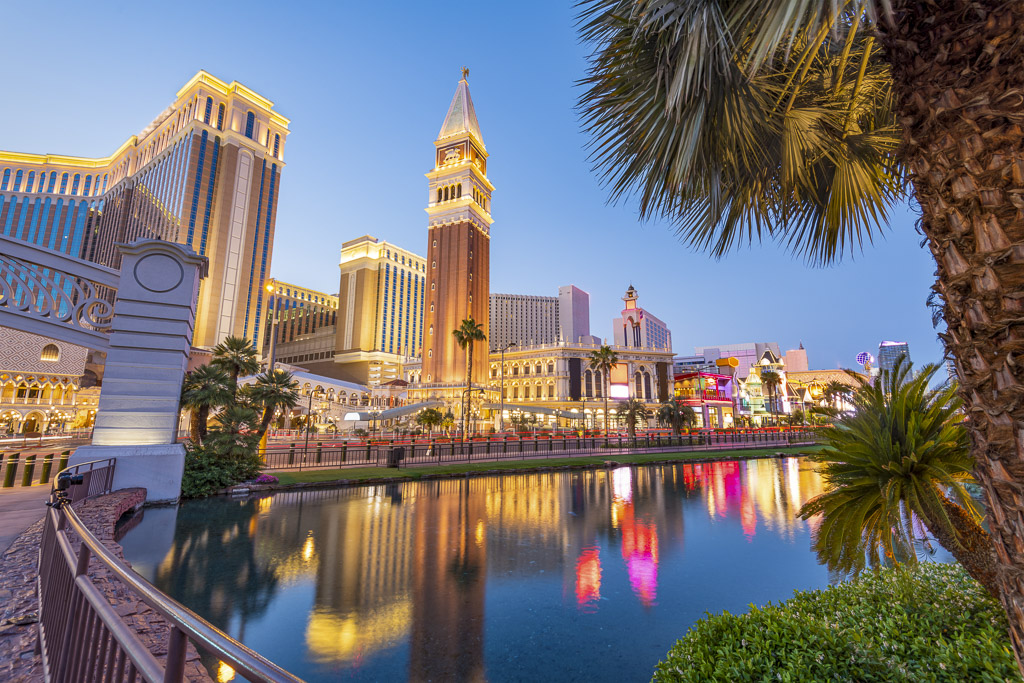
Las Vegas – 57 Free Things to Do for All Types of Travelers
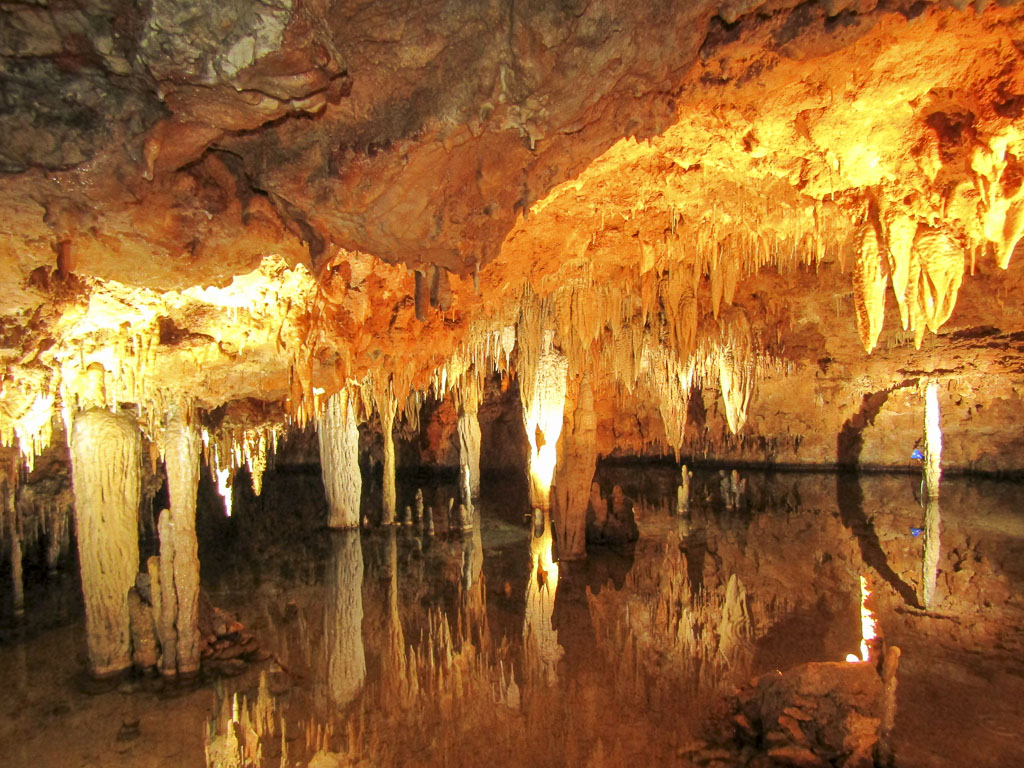
30 Things to Do At and Near Meramec Caverns
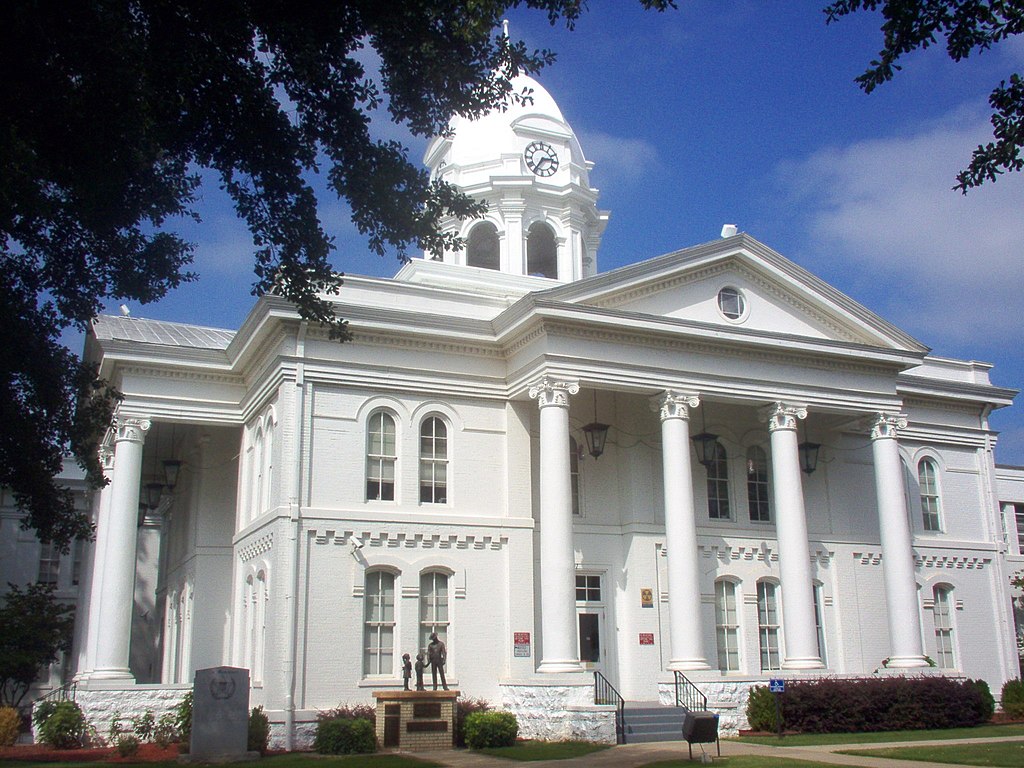
Go Beyond Muscle Shoals, with A Weekend in The Shoals
6 thoughts on “ the coolest things to do in death valley ”.
- Pingback: Death Valley Facts- 25 Cool, Curious, and Fun Facts About Death Valley.
- Pingback: Day Trips from Las Vegas -The Ultimate List of Excursions from Las Vegas
Please list the places in Death Valley area that will have gas. Thanks
Hello Rozella, I apologize as I did not think of it with this article, as I had mentioned them in our related post on a day trip from Las Vegas to Death Valley. I will have to add them to this article when I get time! Inside the park grounds, there are only 3 places where you can get gas, Furnace Creek, Stovepipe Wells, and Panamint Springs. All of these stations are visible from route 190, but expect to pay almost $2 more than normal a gallon. Near the park, the towns of Shoshone, CA, and Beatty, NV, both have gas stations, and also Amargosa Valley, which is the junction of US route 95, and Nevada route 373. Enjoy your visit to Death Valley!
Thanks for this detailed & informative post! I had no idea Death Valley had slot canyons. Definitely adding these things to my Death Valley bucket list!
Thanks for all the suggestions. Will be bookmarking this for our next trip.
Leave a Reply Cancel reply
Your email address will not be published. Required fields are marked *
Sign up to receive our latest articles, when they're released!

6 Must-See Places & Best Things to Do in Death Valley (+Map & Tips)
By Author Jurga
Posted on Last updated: October 25, 2023

Death Valley at the border of California and Nevada is one of the most visited National Parks in the USA . You may have heard that it’s the hottest and driest National Park and that the lowest point of North America can be found here. But there’s so much more to Death Valley than that. And there is more to see and do in Death Valley than it looks at first sight!
In this article, we share some of the most beautiful places to see in Death Valley and the best things to do for first-time visitors.
We only focus on the VERY BEST sites that are worth your time the most if you only have a few hours or a day in Death Valley. If you plan well and – depending on the season – you can easily see them all in a day. Although, spending at least one night here can be a special experience too!
Good to know: All these Death Valley must-sees are accessible in a regular car (so no 4WD is needed). However, some are not accessible for larger vehicles (RVs, motorhomes).
At the bottom of this article, we also included a few additional suggestions for places to visit and things to do in Death Valley if you have more time .
But if you are visiting for the first time and want to see the best that Death Valley has to offer, then this list will help you do just that. Despite covering just 6 sites and a rather small area, you’ll see a big variety of landscapes and jaw-dropping sceneries that will make a long drive to Death Valley more than worth it!
To help you plan your time, we also include a map and practical info , as well as some useful tips for your first visit to Death Valley. Take a look!
Important update for spring 2024: While most of the main landmarks are accessible, some secondary roads in Death Valley NP are still closed due to last year’s flooding. If you are planning a trip soon, be sure to check the official website for up-to-date conditions.
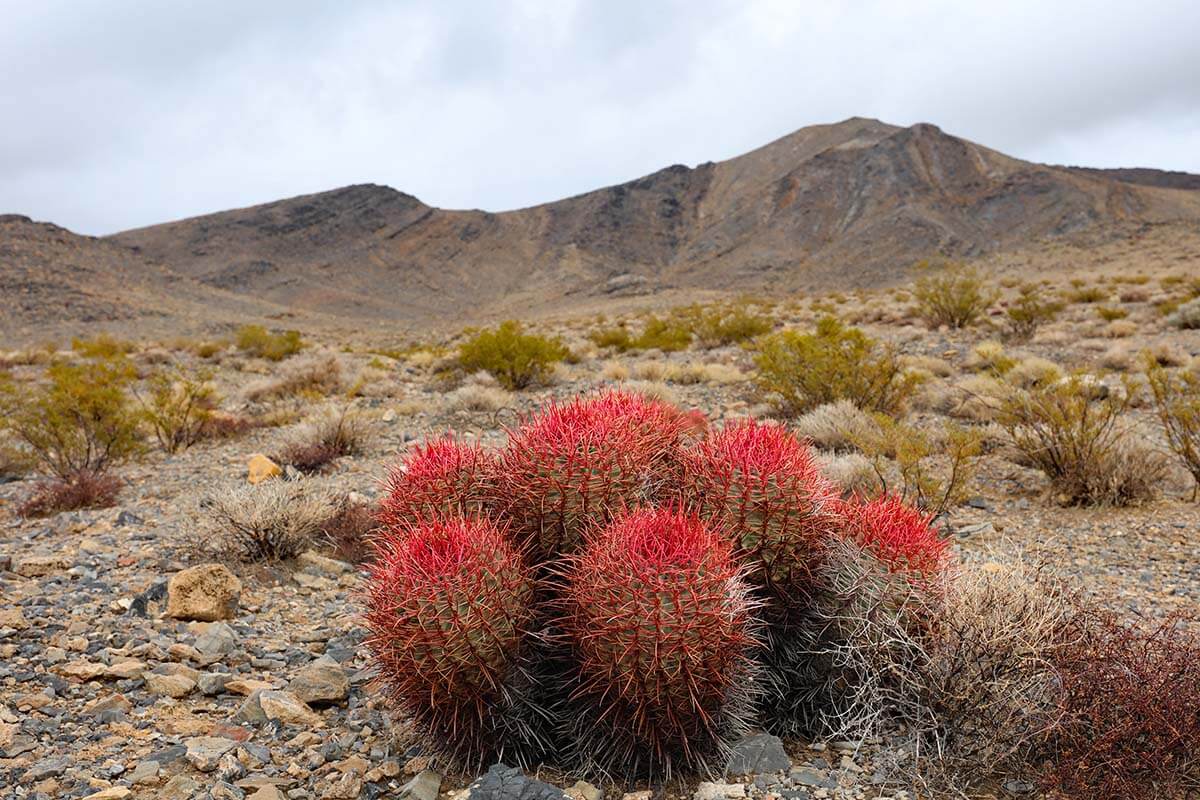
These are the best places to see and things to do in Death Valley:
1. Zabriskie Point
No matter how much time you have in Death Valley – just passing by, visiting on a day trip from Las Vegas, or staying for a few days – Zabriskie Point is not to be missed! This is one of the most beautiful places in Death Valley, with stunning views of multi-colored badlands all around you.
The scenery here is absolutely breathtaking and you can enjoy wide panoramic views of a very large area. This is a desolate and somewhat unearthly landscape, but it looks magical. Golden-brown mudstone hills have distinct shapes, which are formed by erosion and rare but intense water flows.
No two visits here will be the same because all the different shades and tints of color change depending on the light. If you are staying in Death Valley for a few days, consider coming here at different times of the day. Zabriskie Point is one of the nicest places for both – sunrise and sunset in Death Valley.
But there is one more reason why we list Zabriskie Point as number one among the best places to see in Death Valley, and that’s its convenient location and ease of visiting. Located just next to the main road (I-190), the viewpoint is just a short walk from the car. Even though it’s an uphill walk, it’s really not strenuous and takes just a few minutes.
However, if you are visiting Death Valley in the hottest summer months, even this short walk can feel exhausting. Be sure to use sun protection and take some water with you! We once stopped here in July and the moment you step out of the car, it feels like walking into an oven…
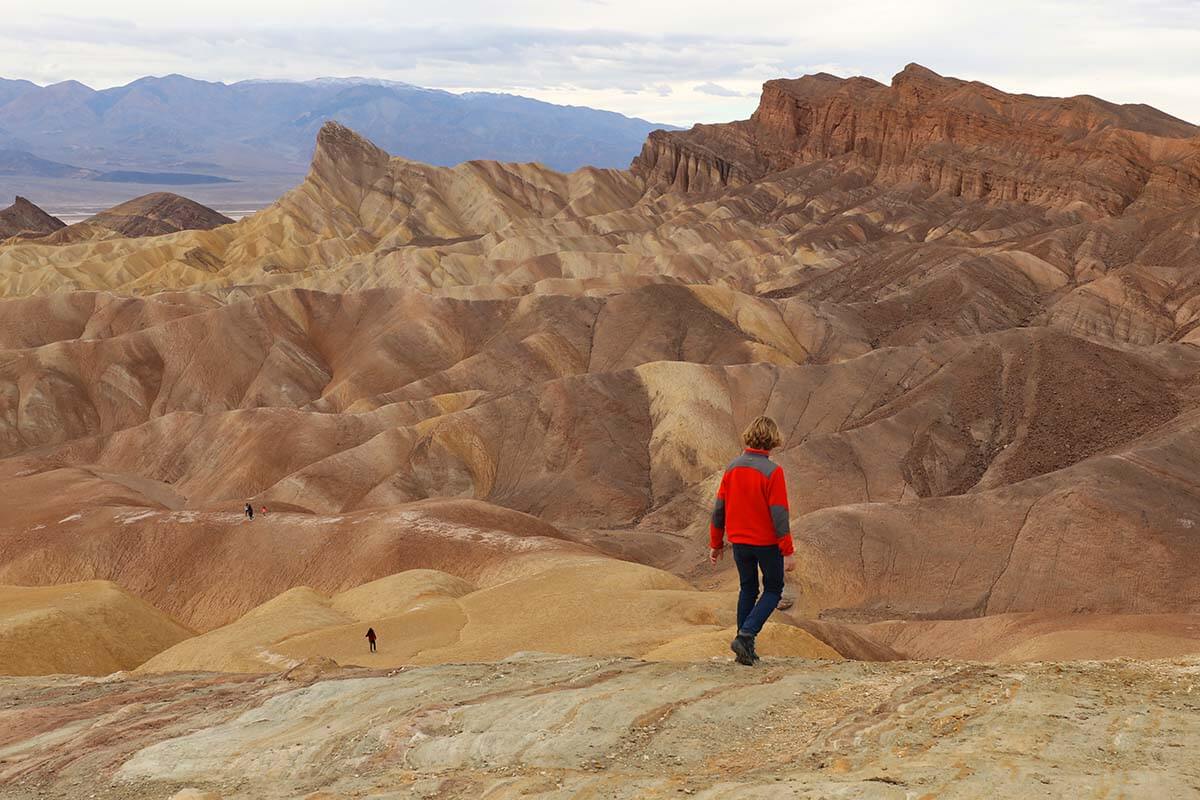
Good to know: Zabriskie Point is one of the most popular places to see in Death Valley. In the peak season (winter months), it can get really busy here.
That being said, we recently visited Death Valley on New Year’s day and had no difficulties finding parking. Also, the area is so big that people spread out beyond the main viewing terrace and it doesn’t feel crowded.
How much time do you need: You can spend as little as 10 minutes here, or you can stay much longer, hike around a bit, etc. The kids love walking up and down these ‘strange’ hills.

2. Badwater Basin
At 282 feet (85.5 meters) below Sea Level, Badwater Basin is the lowest point in North America and one of the lowest elevations on earth. This is the place that made Death Valley famous and is one of the most visited sites in the park.
And indeed, Badwater Basin is absolutely worth a visit. Not just to take a picture of the sign and say ‘been there done that’, but for some of the most unique landscapes you’ll ever see in your life!
Just a few thousand years ago, this place was the site of a 30 ft (9 meters) deep lake. As it evaporated, it left a thick layer of salt. This is what you see here today – a vast salt pan stretching for several miles.
Interesting to know: Badwater Basin gets its name from a surveyor mapping the area. He was glad to find a water pool where his mule could drink, but the animal refused to because the water was too salty. So he wrote on his map “bad water” and the name stuck.
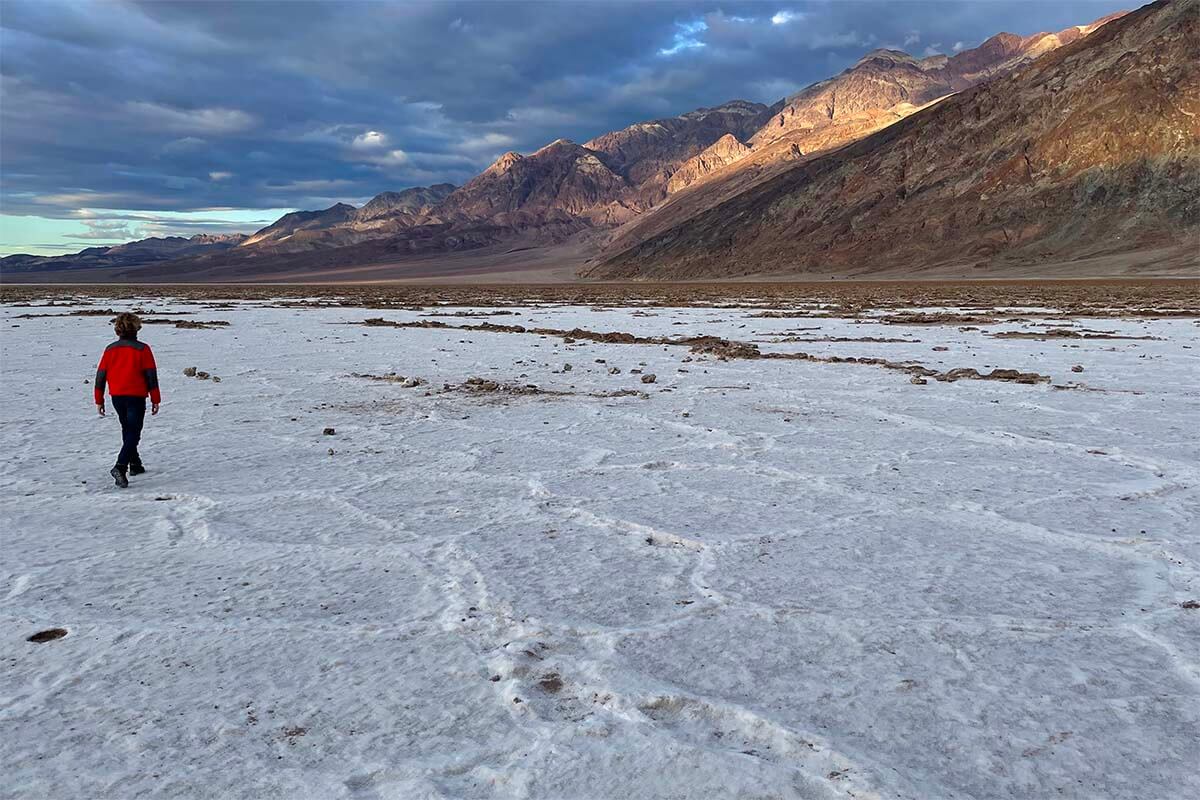
Good to know: Badwater Basin is large, but you shouldn’t just walk anywhere you like. There is a designated parking area (I indicated it on our map). Here, you will find a few boardwalks and a nice straight path leading you to the saltpan.
How much time do you need: If you just want to take a picture of the sign and look around a bit, 10-15 minutes will be enough. However, keep in mind that you have to walk about half a mile in order to reach the main salt pan. If you walk really fast and it’s not too hot, you need about 15 minutes to get there from the car parking. More realistically, you will need 20-30 minutes just to reach it. If you also count the time to look around, take pictures, and walk back, you need about 1 hour for a visit here.
This can be really daunting if it’s hot and I don’t think I would attempt this walk during the day in the summer months… Remember, this is the hottest place in the U.S.!
The good thing is that even if you don’t go all the way, you can see plenty of salt crust closer to the car parking area.
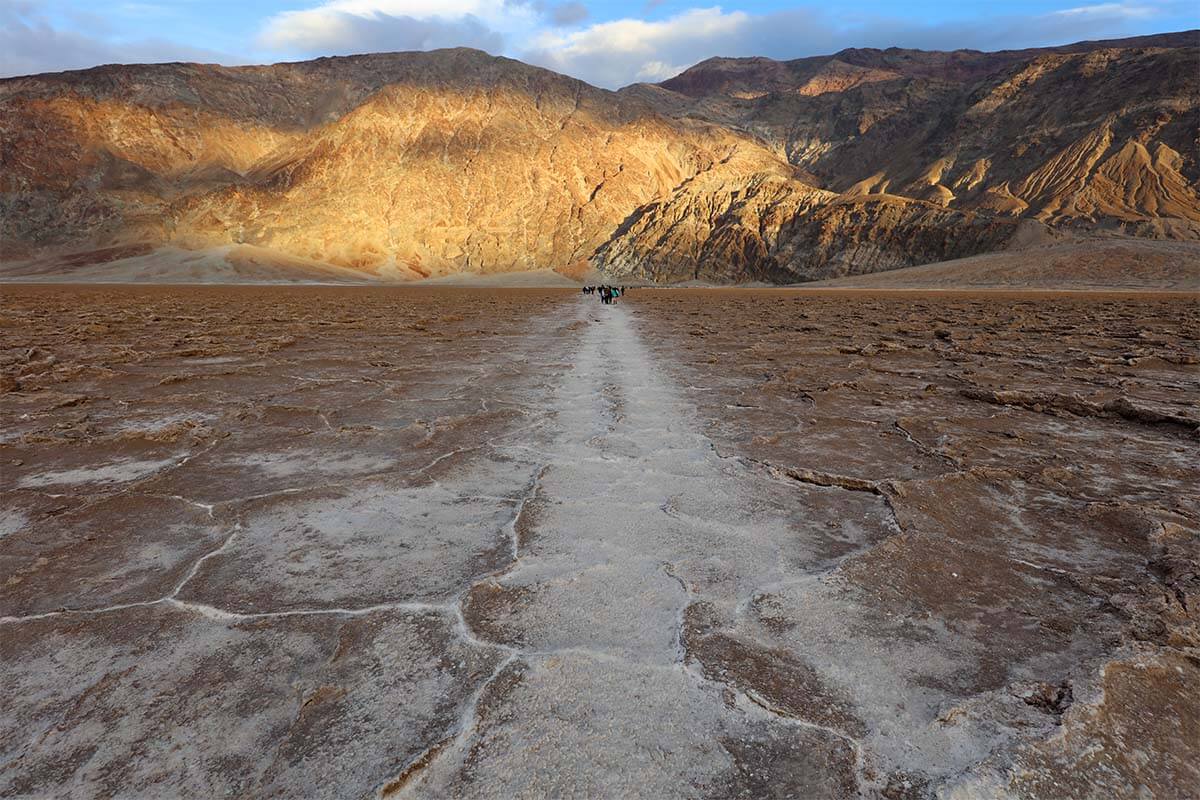
3. Artists Drive & Artists Palette
Artists Drive is another must-see in Death Valley. This is a scenic one-way drive just off Badwater Road. This road is about 9 miles (14 km) long and takes about 20-25 minutes to drive without any stops.
There are a few places where you can stop along the way, but it’s really more about the surreal scenery and the thrill of the drive itself than about the stops. But since you are here anyway, be sure to stop at all the main viewing areas where you can get out of the car and enjoy the colorful scenery around you.
The nicest place here (and one of the must-sees in Death Valley) is Artists Palette , which is the second bigger stop that you’ll come across. Parking is quite limited so you may need some patience.
But the reason why we list Artists Drive so high on this list of top sights in Death Valley is the road itself. With twists, turns, ups and downs, and narrow passages cut out between the rocks, driving here makes you feel like you are part of the unearthly scenery around you.

TIP: Take it slow – not just to enjoy the surroundings, but also for your safety. Also, don’t stop on the road because there are some places where visibility is really limited as you emerge from a sharp corner or drive over a steep hill.
Good to know: Because you don’t even have to get out of the car (or just for a quick photo stop), this is one of the very best things to do in Death Valley in any season. Also in the summer when it’s too hot for anything else, Artists Drive is a great place to visit because you can enjoy it from the comfort of your car.
Important! Please note that cars over 25 feet (7.6 meters) are not allowed on Artists Drive. Even though the road looks perfectly wide at first, there is a good reason for this. The second half of the drive is really not suitable for longer vehicles.
How much time do you need: Count 30-45 minutes for Artists Drive with a few photo stops. Of course, you will need more time if you decide to go for a walk and explore more.
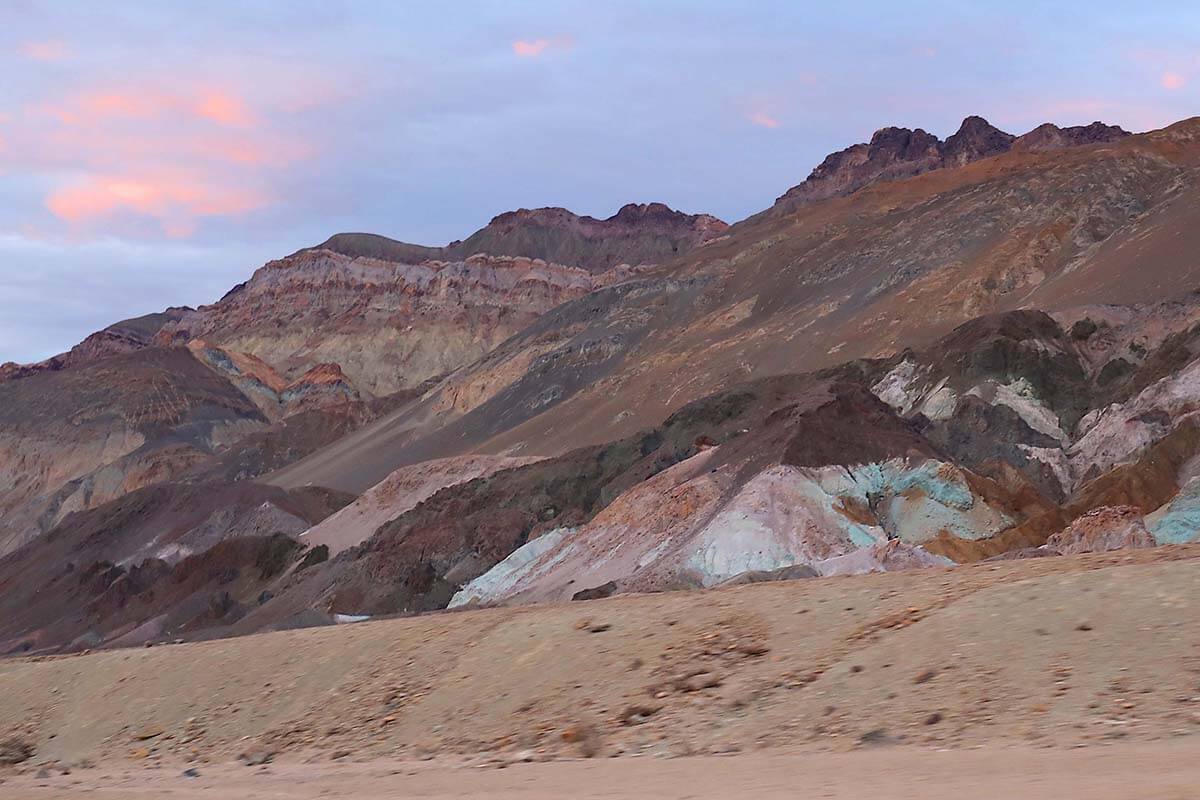

4. Mesquite Flat Sand Dunes
No visit to Death Valley would be complete without at least a quick stop at Mesquite Flat Dunes . Surrounded by mountains on all sides, some of these sand dunes are up to 150 ft (46 m) high.
This is yet another must-see place in Death Valley showing you yet another facet of the incredible diversity of landscapes in this desert park.
Also here, there is a designated parking area, from which you can walk straight into the dunes. The highest dune is about 1 mile from here, but you have to cross lots of sand and smaller dunes to get there, so it’s not a quick walk. Even if it’s not too warm, you should count at least 2 hours round-trip.
But you really don’t have to go that far in order to enjoy the scenery. Even if you just walk 5-10 minutes from the car, it’s a really nice stop on any Death Valley itinerary!
Keep in mind that the sand dunes will look quite different depending on the light. The white sand can turn bright orange with the rising or setting sun.
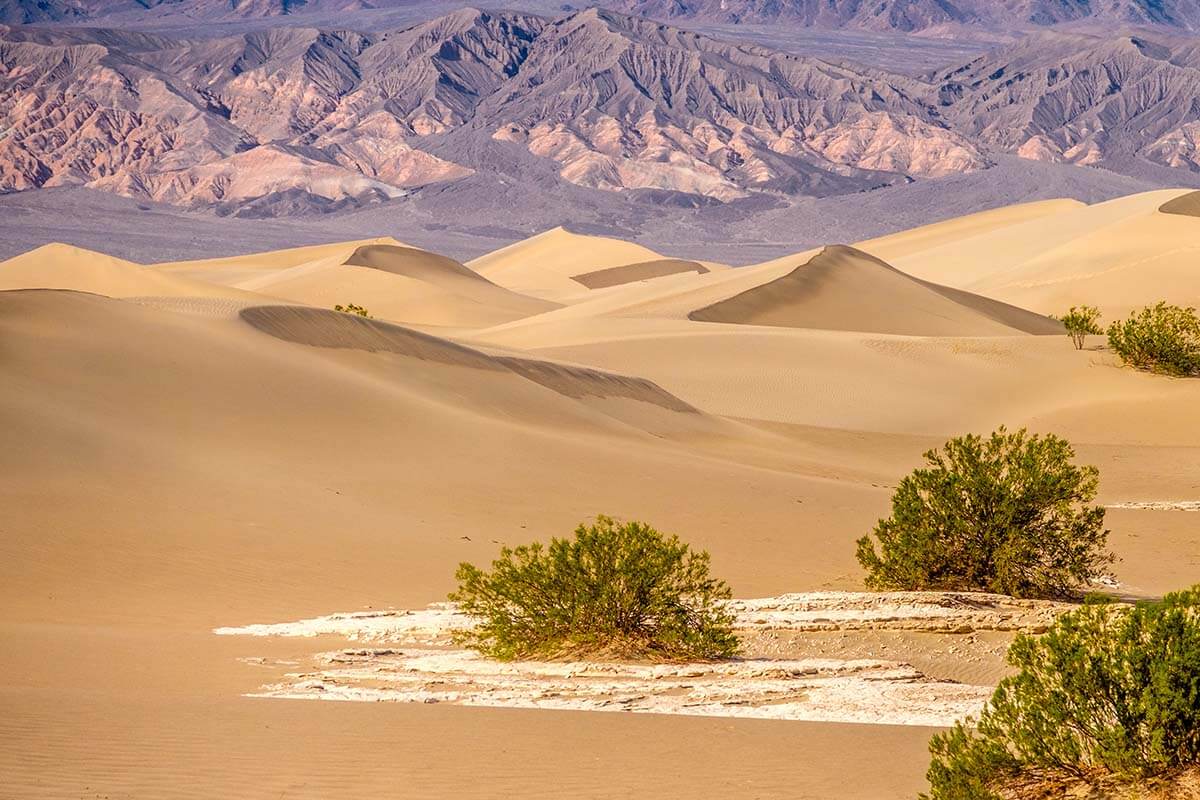
TIP: Sand dunes are spectacular at sunrise and at sunset. These are also the best times of the day to walk around here. It can be very dangerous when it’s hot! If you hike, be sure to do it during the coolest times of the day and carry lots and lots of water.
You can also visit here at night and the dunes are a popular place for Full Moon hikes or stargazing when it’s New Moon. However, be aware that desert wildlife is active at night, so watch out for sidewinder rattlesnakes.
How much time do you need: You can spend 10 minutes here or 2-3 hours – it’s really up to you. Mesquite Flat Dunes are located just next to the main road near Stovepipe Village in the heart of Death Valley, so at least you don’t need much extra time in order to drive here from all the other main sights in Death Valley.

5. Mosaic Canyon
Mosaic Canyon , just near Stovepipe Wells and Mesquite Sand Dunes, is another place that should be high on your Death Valley bucket list. This canyon is a geologic wonder and walking inside it is a really special experience.
While the Mosaic Canyon hiking trail is about 2 miles one-way, you only need to hike about half a mile in order to see the most impressive part of the canyon. And because there is lots of shade from the rocks all around you, this short walk is even doable when it’s warm (but avoid doing any hiking in Death Valley on summer days!).
Good to know: The first part of the trail is rather easy with a few knee-high stones/rocks to climb on the way. However, if you decide to walk beyond the narrow part of the canyon and all the way to the end, be prepared for some serious scrambling (you really need good hiking shoes!).
Because the trail goes a bit uphill, it takes more time to get there than to come back. We explored just the narrow part of the canyon and stopped where it got really wide. We walked for 20 minutes to get there and just 10 minutes to get back.
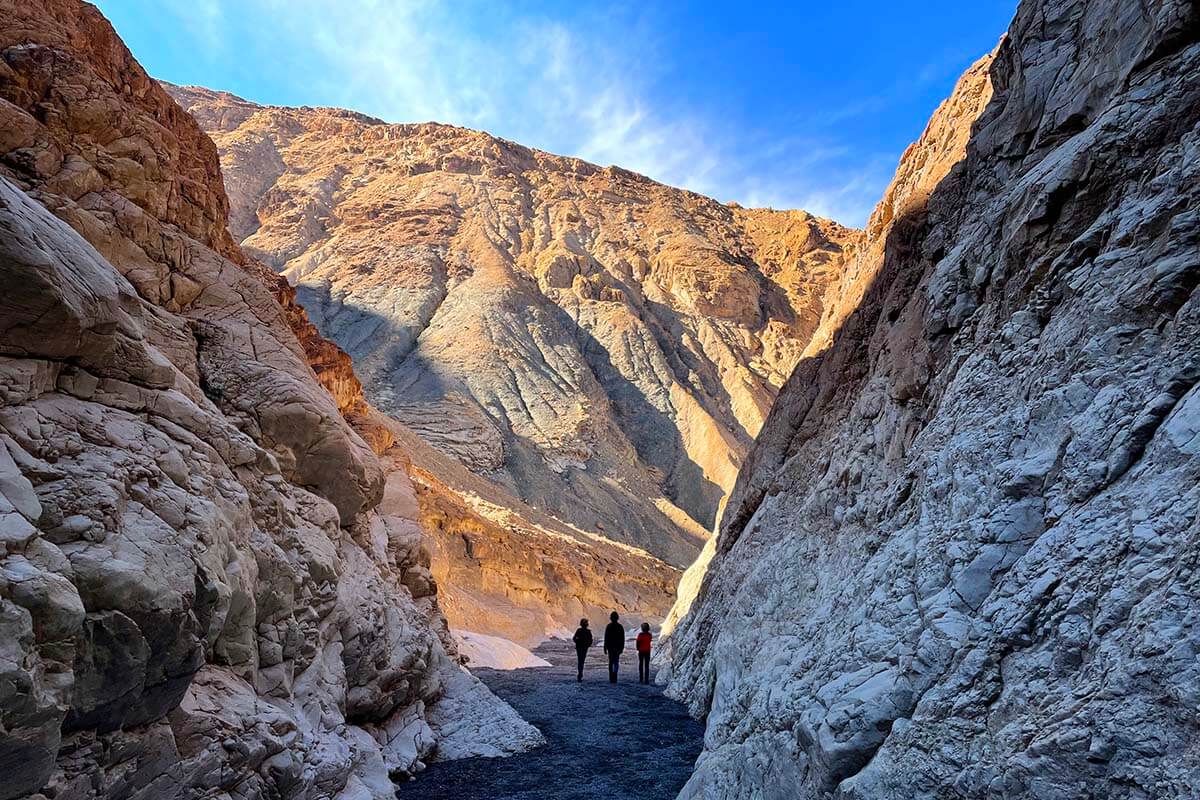
How much time do you need: If you only walk about half a mile, you need about 30 minutes for a visit here. If you decide to hike the entire trail (only recommended in winter), it can easily take 3 hours or even longer depending on the temperatures and your condition. Also here, be sure to pack plenty of water!
It’s important to note that you have to drive the 2-mile Mosaic Canyon Road in order to reach the trailhead. This is a pretty rough gravel road. We saw a few regular cars here, but an SUV or a 4×4 would be better here.
Also, don’t count on GPS or Google Maps for guiding you here. But Mosaic Canyon Road is really easy to find – it’s just southwest of Stovepipe Wells. I indicated this road on our map below to help you find it.
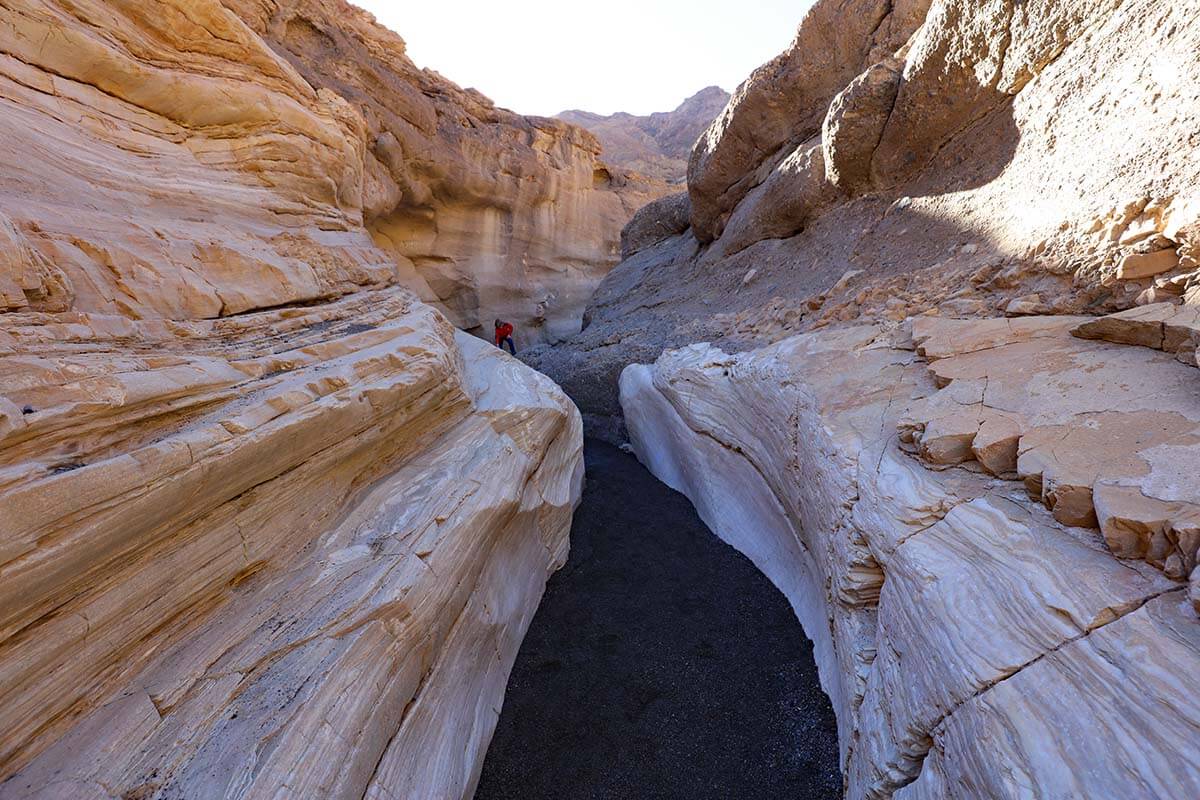
6. Dante’s View
One of the highest easily-reachable viewpoints in the park, Dante’s View is a lookout point offering stunning aerial views of Death Valley. From here, you can see mountain ranges and flat desert valleys stretching for over 110 miles.
The scenery here is truly impressive, giving you an even better appreciation of how much diversity there is in Death Valley.
There is a large car parking and viewing area, so you can see great views without having to walk much at all. However, if it’s not too hot (or too cold and too windy as it was when we visited), you can also climb Dante’s Peak, to the right of the parking. It’s about 10-15 minutes hike to the top and the views should make up for it.
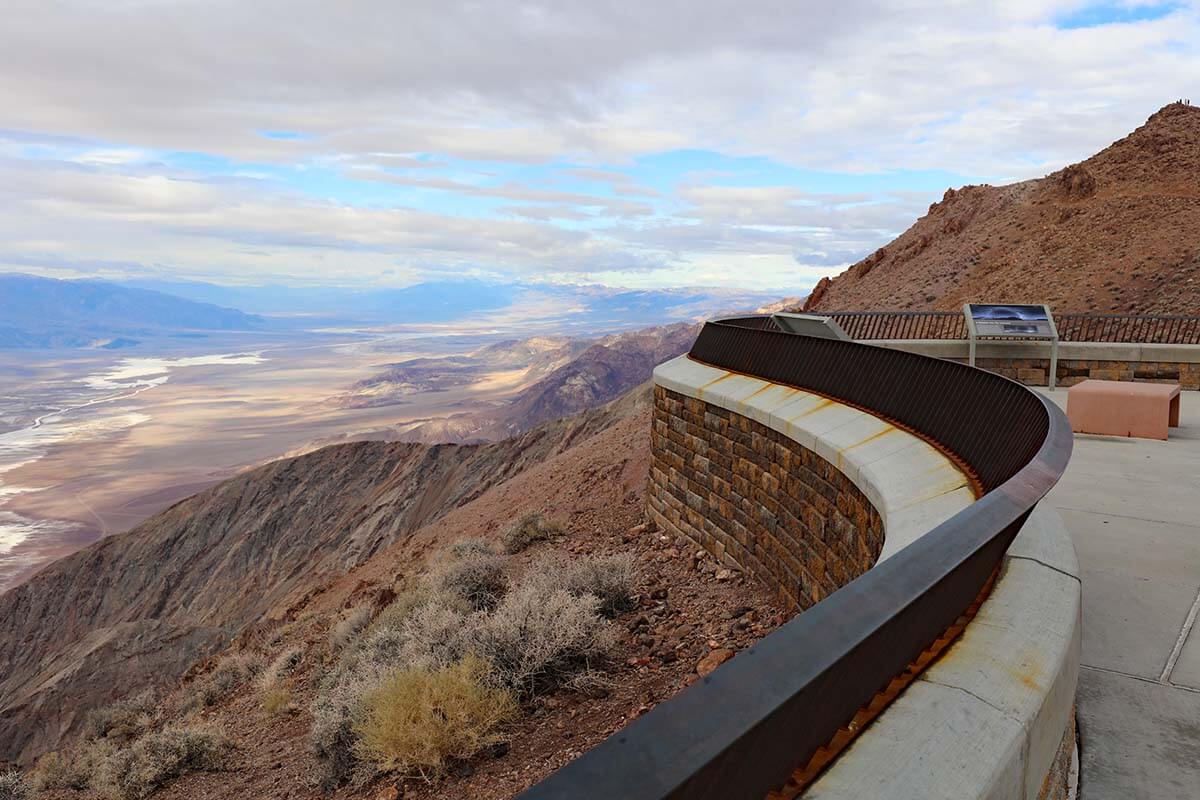
Interesting to know: Towering just above the Badwater Basin, Dante’s View is 5,000 feet higher than the valley floor. That’s a huge difference, not just in terms of elevation or scenery, but also in terms of temperature!
When we were here in January, it was FREEZING cold at Dante’s View with temperatures of just 39 F (4°C) and such a strong wind that we could hardly stand on our feet. We needed winter jackets, gloves, and hats just to walk around at the viewpoint, not even to mention attempting a hike to the peak. In the meantime, it was 65 F (18°C) at Badwater Basin and we ended up in t-shirts after a walk…
How much time do you need: Dante’s Peak is located 13 miles south of Hwy 190. It’s quite a big detour to get here, and driving alone will take you at least 20 minutes one-way. In addition, if you just stop at the viewpoint, you should add about 10 minutes. If you also hike to the lookout on top of the hill, add at least 20-30 minutes extra. Obviously, you will need more time if you decide to do even more hiking in the area.
So realistically, you need at least 1 hour for a visit here. But it’s totally worth it!
Good to know: Also here, the last part of the road is prohibited for vehicles over 25 ft (7.6 m). You can leave your RV/motorhome at the parking lot and walk the last bit, but whether you would want to do this, depends on the temperatures.
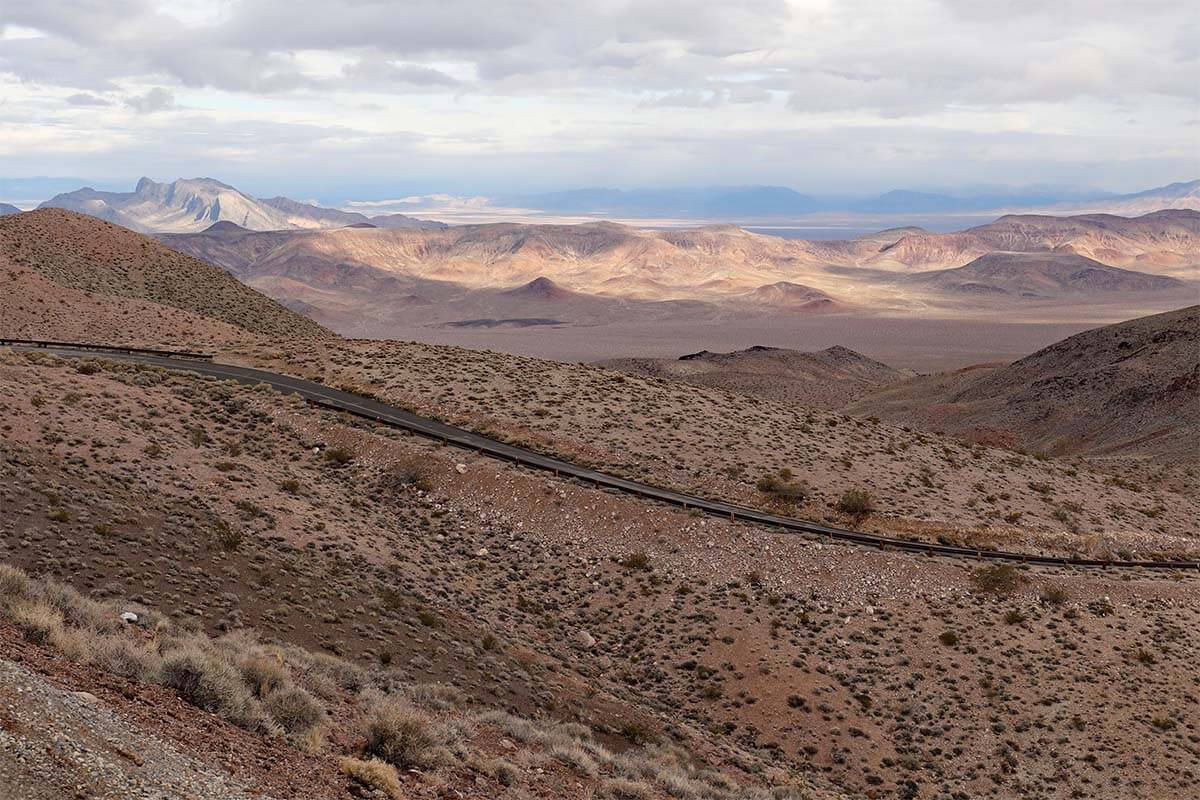
Now that we covered the must-sees in Death Valley, here are a few additional recommendations for places to see and things to do if you have more time.
More Places to See & Things to Do in Death Valley
Stretching over 3.4 million acres (almost 14,000 sq km), you can imagine that there is a lot more to see and do in Death Valley National Park than just the 6 top places mentioned above.
There are countless hiking trails, ghost towns, gold and borax mines (it’s not the best idea to visit them inside though), sliding rocks, and even hot springs and golf (!)…
However, most visitors don’t have the time to explore more, and often it’s simply too hot as well.
Anyway, if you have more time and are looking for more things to do in Death Valley , here are a few additional suggestions.
Ghost towns, machinery, and the remains of the old mining operations
- Harmony Borax Works. This is an old mining operation where you can still see some remains of machinery and buildings from over 100 years ago. It’s a short interpretive trail close to the highway and makes a nice stop just a short drive north of Furnace Creek.
- Furnace Creek. At Furnace Creek, just behind the general store, you can also find some old machinery and interesting objects from the mining days at Death Valley. There is an old train, carts, etc.
- Wildrose Charcoal Kilns. These are old ‘ovens’ used to produce charcoal. They look like cute little houses and make for some nice photo opportunities. However, it’s quite a bit of a detour. Also, the last few miles of the road are a bit rough. When we visited in the winter, we had to skip this because rangers told us that snow chains were needed because of recent snowfall (yes, also this is Death Valley!).
- Ghost towns. In the past, Death Valley had lots of mining sites with small towns built around the mining activity. Today, you can visit some of these ghost towns (Ballarat, Leadfield, Panamint City, Rhyolite), but their conditions vary. Some of them have old dwellings and machinery, but there are also a few where there’s hardly anything left…
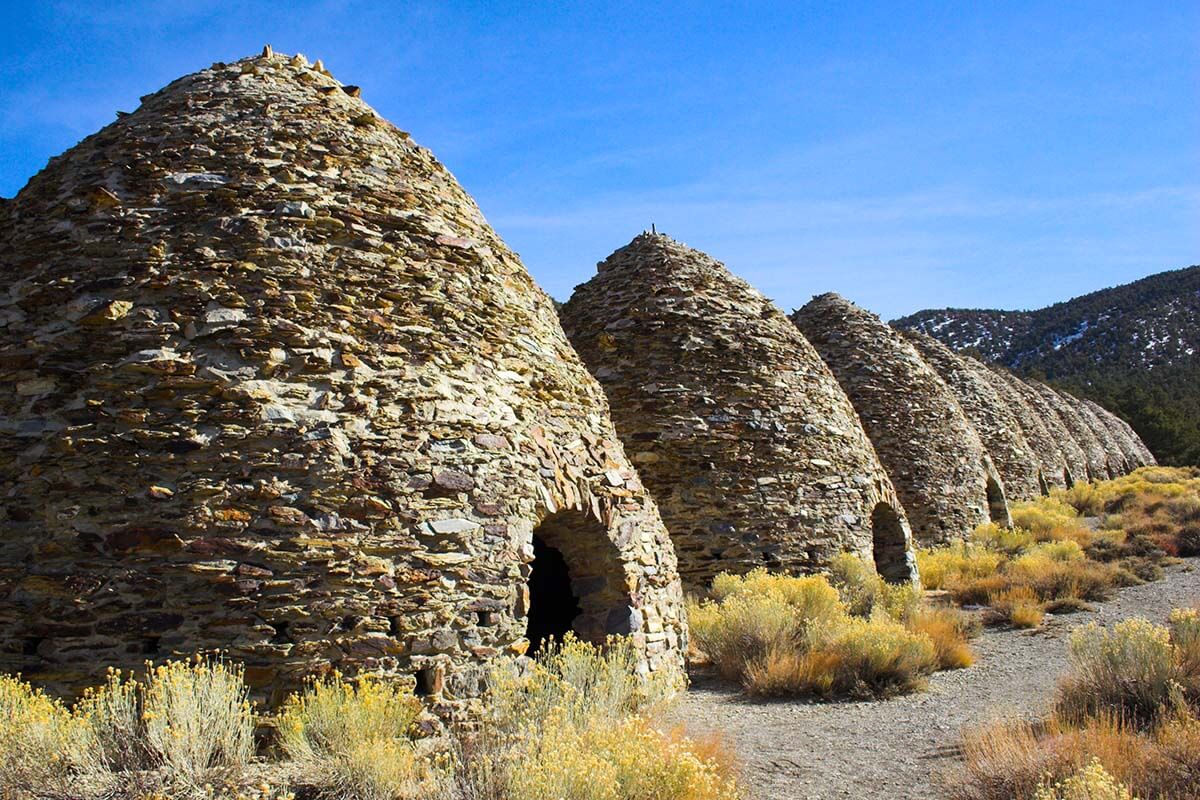
Scenic Views
- Devil’s Golf Course. Crystalized salts have formed some very strange jagged formations, sort of small salt spires. If you want to see some more unique scenery in Death Valley, this can be a nice quick detour on your way to Badwater Basin.
- 20 Mule Team Canyon. This scenic area is located right on I-190 just before you reach Zabriskie Point. There is a short gravel road that takes you into the canyon, which is quite nice (a high-clearance vehicle is recommended, but some people seem to do it in a regular car too). Since it’s a loop road, you get back on the main road again soon. Most people just park next to the main road and walk around a bit.
- Ubehebe Crater. This is a really impressive crater and you can see it straight from the parking area. However, it’s located in the northern part of Death Valley, quite a bit out of the way from the main attractions.
- Father Crowley Vista Point- Rainbow Canyon. This is a nice viewpoint to check out if you find yourself on the western side of Death Valley (e.g. if driving to/from Los Angeles or Sequoia NP).
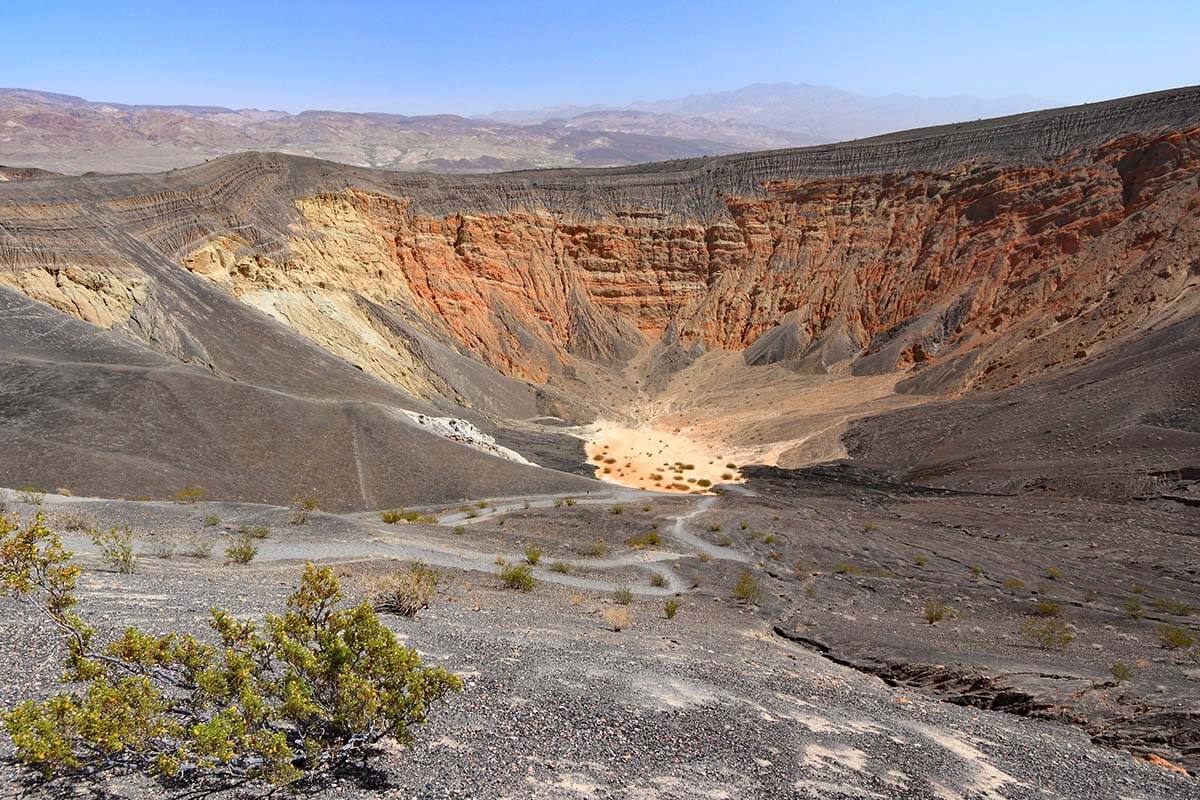
Active things to do at Death Valley National Park
- Horseback riding. There are several places where you can go horseback riding in Death Valley. Especially in the winter months, this can be a great experience and a nice, easy way to explore more surreal landscapes. One of the best centrally-located horse stables can be found at Furnace Creek (next to The Ranch/Oasis Resort ). They offer 1 or 2-hour rides.
- Biking. If you like slow travel, you can also explore Death Valley by bike. Among several other places, rental bikes are available at the above-mentioned resort at Furnace Creek. You can choose between regular road bikes or e-bikes and rent them for half a day, a day, or even a few days. I’d only recommend this if you are visiting in the winter and have plenty of time. There are also bike tours available – you would have to do some additional research on that if interested.
- Swimming. Death Valley has several hot springs. However, most of them are located further away from the main area with the most interesting sights. Anyway, the best places to go for a swim are The Inn At Death Valley and The Oasis/The Ranch Resort at Furnace Creek. Their pools are filled with spring-fed warm water. We were here at New Year and the outdoor pool was warm enough for a swim. It’s not hot though, so perfectly enjoyable in the warmest months as well. However, the pools are only accessible to hotel guests. Another (very simple) accommodation with hot springs is Delight’s Hot Springs Resort in Tecopa, just outside the southeast corner of the park, close to Shoshone.
- Golf. In addition to Devil’s Golf Course (which is obviously not a golf course at all), there is an actual golf course in Death Valley as well. You can find it at Furnace Creek. It’s a bit surreal to see green grass in the desert, but avid golfers will enjoy playing golf on the lowest-elevation course in the world. In the summer, you have to start at 6-7 am or it gets too hot!
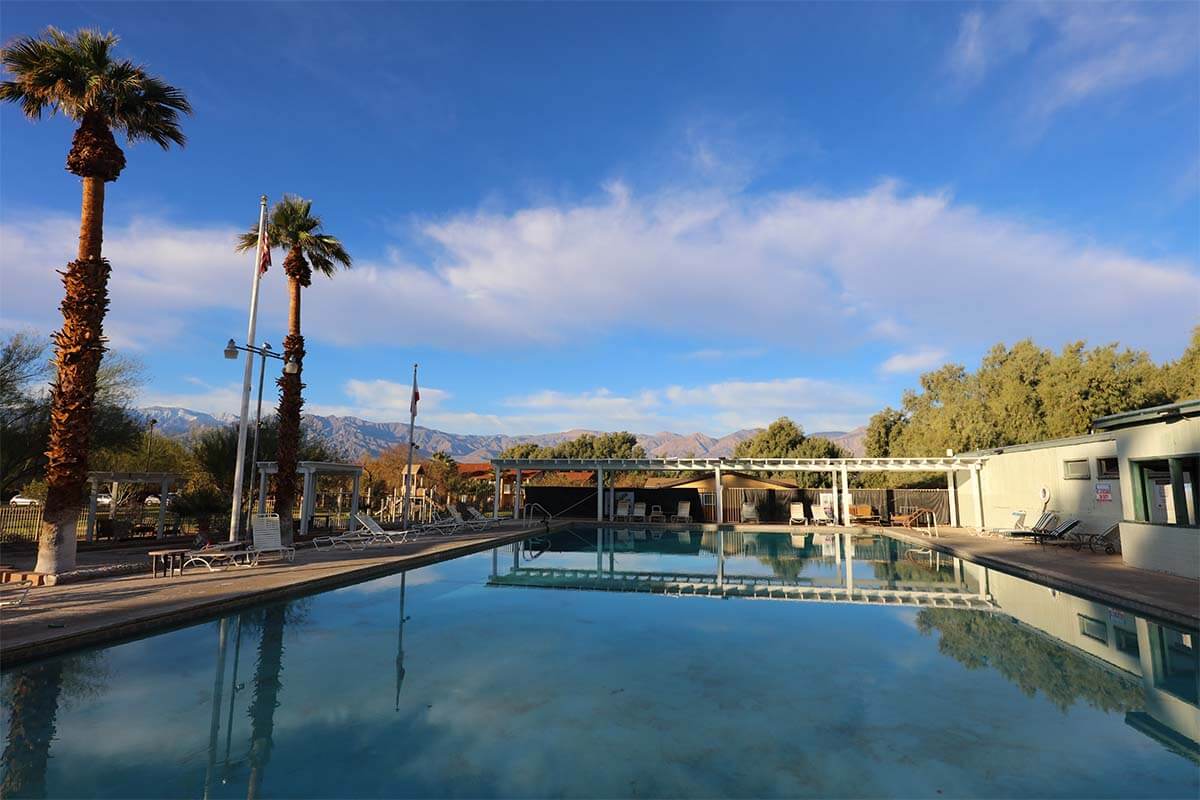
To help you get a better idea of where everything is located, we created this map indicating all the sites mentioned in our article.
As you can see, all the very best places to visit in Death Valley are located rather close to Furnace Creek, in the center of the park.
This area is just a bit over 2 hours away from Las Vegas and so it’s possible to see these top sights in a day (by car or with an organized tour ). In fact, this is one of the best day trips you can do from Vegas !
How to use this map: Use your computer mouse (or fingers) to zoom in or out. Click on the icons to get more information about each place. Click the arrow on the top left corner for the index. Click the star next to the map’s title to add it to your Google Maps account. To view the saved map on your smartphone or PC, open Google Maps, click the menu and go to ‘Your Places’/’Maps’. If you want to print the map or see it in a bigger window, click on ‘View larger map’ in the top right corner.
Practical Information
- Death Valley is the dryest and hottest place in the USA. If you are visiting in the summer, your feet can literally start to burn through your shoes! So adjust your expectations and itinerary based on the season when you visit and don’t do stupid things like hiking in the middle of the day in the summer. Also, always carry plenty of water !
- There is a fee to visit Death Valley and you can get a pass at the visitor center (so not at the entrance of the park). If you have the annual National Parks Pass ( America the Beautiful Pass ), it’s also valid here.
- Death Valley has limited facilities , but you can find fuel and food stores here too. However, everything is very expensive here. It’s best to fill up your tank before you arrive, and you may also want to bring your own snacks/picnic. This will save you money, but also time.
- Because of its size and limited facilities, you need a car (or a motorcycle/RV, etc.) in order to visit Death Valley.
- While the main roads in Death Valley are really good, many side roads are unpaved and in varying conditions. It’s always a good idea to check if your rental car insurance covers gravel roads (most don’t) and it’s even more important to ask park rangers for up-to-date information about the specific places you plan to visit! Also, driving off-road is forbidden!
- When planning your sightseeing at Death Valley, keep in mind that in summer it’s very hot during the day and you won’t be able to do much after 10-11 am. And in winter, the days are short and it gets dark very early (it’s pitch dark from +- 5 pm around New Year).
- You can visit Death Valley in 1 day from Las Vegas , but it’s a long drive (and lots to see when you get there). So be sure to leave early so that you can make the most of your time. If you are only coming for a day from Vegas, consider booking an organized tour . They will bring you to all the top spots in the most efficient way and you’ll be able to rest on your way there and back.
- If you want to, you can spend a night here (or a few, depending on what you want to do). The most conveniently located hotels are The Oasis Resort (aka The Ranch) and The Inn At Death Valley (former Furnace Creek Inn). They are both beautiful resorts with all the amenities you might need. But – like everything else in Death Valley – quite pricey. We stayed at The Oasis/The Ranch when road-tripping between Las Vegas and LA and it allowed us to explore everything at a slower pace.
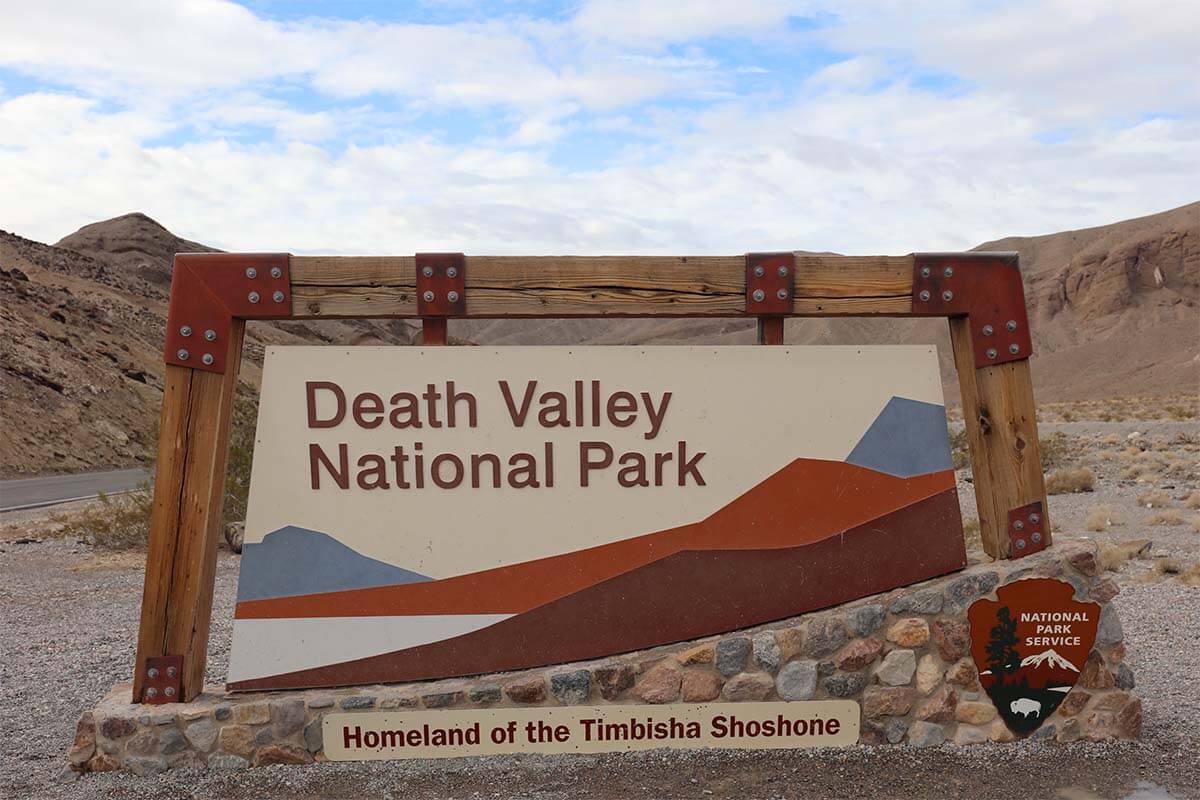
I hope that this guide gives you a better idea of what to expect and what to see in Death Valley National Park. Have a great trip!
TIP: If you are road-tripping in Southwestern USA , you may want to check our other travel guides to a big variety of destinations in the region. Take a look via the links below!
- Best things to do in Las Vegas
- One day in Las Vegas itinerary
- Las Vegas travel tips
- Best day trips from Las Vegas
- One day in Grand Canyon
- Where to stay in Grand Canyon
- Grand Canyon South Entrance
- Grand Canyon in Winter
- Top places to see in Arizona
- Best things to do in Sedona
- Sedona day trip from Phoenix
- Monument Valley
- Grand Canyon – Antelope Canyon – Horseshoe Bend itinerary
- Arches and Canyonlands National Park 1-day itinerary
- Moab itinerary
- Zion – Bryce Canyon itinerary
- Phoenix – Scottsdale Itinerary
- LA Itinerary
- San Diego Itinerary
- Best things to do in Arches National Park
- Best things to do in Canyonlands National Park
- Best hikes in Zion National Park
- Where to stay in Zion National Park
If you found this post useful, don’t forget to bookmark it and share it with your friends. Are you on Pinterest? Pin these images!
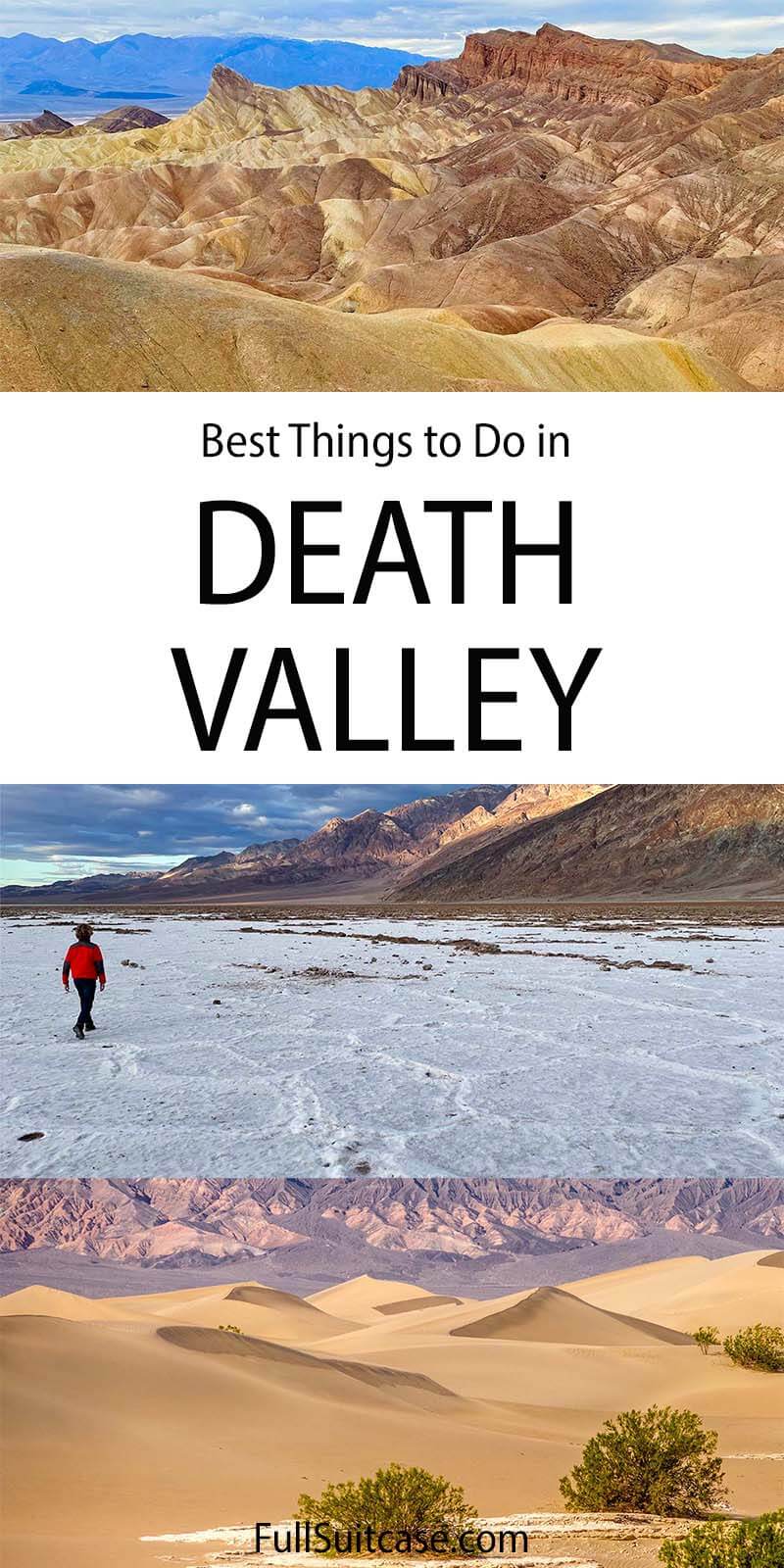
More travel inspiration for USA National Parks:
- Best Things to Do in Yellowstone
- Grand Teton – Yellowstone Itinerary
- Yosemite Travel Tips
- Glacier National Park Itinerary
- Rocky Mountain National Park Itinerary
- Olympic National Park Itinerary
- Acadia National Park Itinerary
- Yellowstone National Park Itinerary
- North Cascades National Park
Seasonal guides:
- National Parks to Visit in January
- National Parks to Visit in February
- National Parks to Visit in March
- National Parks to See in April
- National Parks to See in May
- National Parks to Visit in June
- National Parks to Visit in September
- National Parks to Visit in October
- National Parks to Visit in November
- National Parks to Visit in December
This site uses Akismet to reduce spam. Learn how your comment data is processed .
Advertiser Disclosure
Many of the credit card offers that appear on this site are from credit card companies from which we receive financial compensation. This compensation may impact how and where products appear on this site (including, for example, the order in which they appear). However, the credit card information that we publish has been written and evaluated by experts who know these products inside out. We only recommend products we either use ourselves or endorse. This site does not include all credit card companies or all available credit card offers that are on the market. See our advertising policy here where we list advertisers that we work with, and how we make money. You can also review our credit card rating methodology .
The Ultimate Guide to Death Valley National Park — Best Things To Do, See & Enjoy!
Amar Hussain
Senior Content Contributor
765 Published Articles
Countries Visited: 63 U.S. States Visited: 9
Editor & Content Contributor
146 Published Articles 727 Edited Articles
Countries Visited: 35 U.S. States Visited: 25
Keri Stooksbury
Editor-in-Chief
29 Published Articles 3079 Edited Articles
Countries Visited: 45 U.S. States Visited: 28
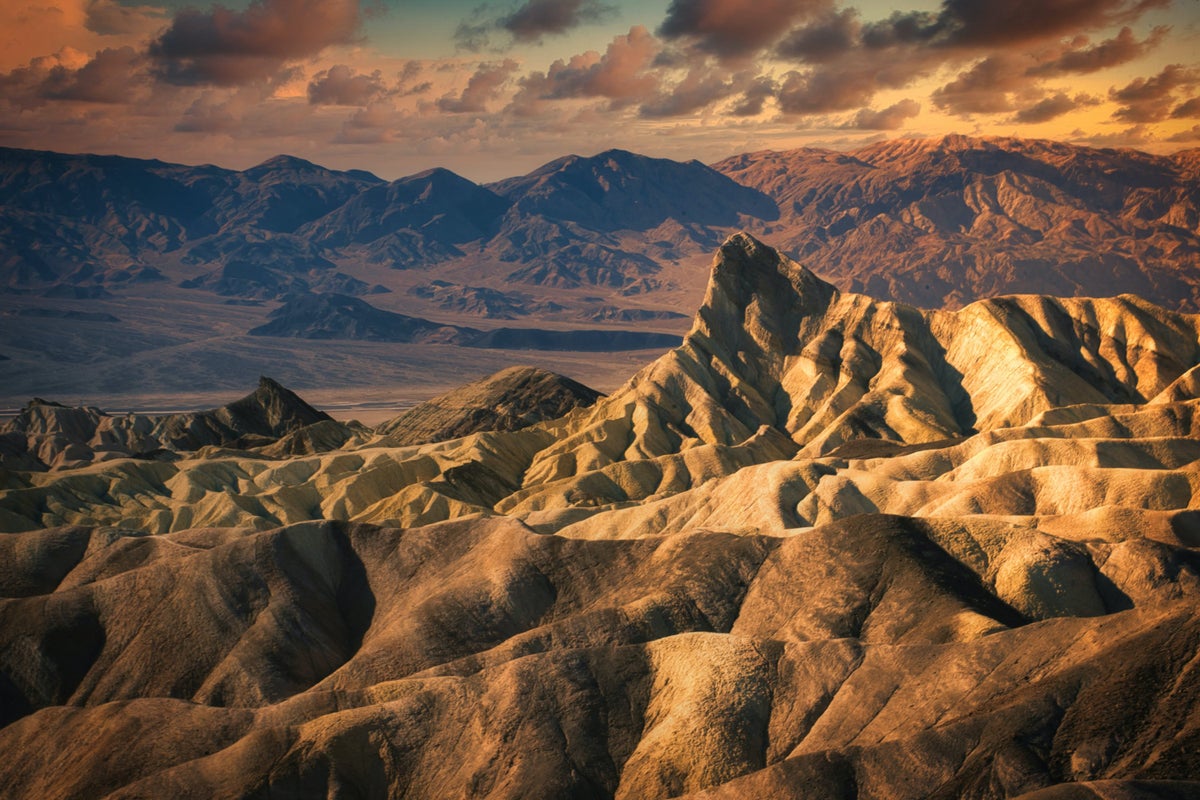
Where Is Death Valley National Park?
Nearest airports to death valley national park, driving to death valley national park, taking the train to death valley national park, getting around death valley national park, artists drive, badwater basin, dante’s view, darwin falls, furnace creek visitor center, mesquite flat sand dunes, mosaic canyon, the racetrack, ubehebe crater, wildrose charcoal kilns, best time to visit death valley national park in the winter, best time to visit death valley national park to avoid crowds, best time to visit death valley national park for wildlife, cheapest time to visit death valley national park, annual events in death valley national park, inside the park, beatty, california, lone pine, california, shoshone, california, badwater saloon, the inn at death valley dining room, toll road restaurant, 1. a new park is born, 2. largest park in the lower 48 states, 3. original inhabitants, 4. a miner’s paradise, 5. the history of the name, 6. lights, camera, action, 7. a hidden castle, 8. hottest place on earth, 9. a rare fish, 10. “death valley days” tv series, final thoughts.
We may be compensated when you click on product links, such as credit cards, from one or more of our advertising partners. Terms apply to the offers below. See our Advertising Policy for more about our partners, how we make money, and our rating methodology. Opinions and recommendations are ours alone.
Death Valley National Park stretches across both California and Nevada. This national park is the hottest, driest, and lowest national park in the United States.
It’s also the largest national park in the lower 48 states and contains nearly 1,000 miles of roads that wind through the park and take visitors to the amazing sites and attractions. Each year over 1 million visitors come to explore this massive, mesmerizing park.
Let’s dive into the best things to see and do in this special place.
How To Get to Death Valley National Park
Death Valley National Park spans 2 states: California and Nevada. This park is located about 4.5 hours from Los Angeles and approximately 2.5 hours from Las Vegas . The park stretches over 3,422,024 acres and features plunging canyons, rugged mountains, and rolling sand dunes.
There are 10 airports within 200 miles of Death Valley National Park. However, several are small and only available to privately chartered planes.
Harry Reid International Airport (LAS) , Los Angeles International Airport (LAX) , and San Diego International Airport (SAN) are the 3 closest major airports to Death Valley National Park. Let’s look at these 3 major airports and see what they offer to help you decide which one to utilize.
Harry Reid International Airport (LAS)
Harry Reid International Airport is 111 miles away from Death Valley National Park. This airport is located in Las Vegas.
LAS sees flights from dozens of national and international airlines, including Aeromexico, Allegiant, American, British Airways, Delta, JetBlue, Southwest, United, and more. The extensive mix of airlines provides nonstop flights to many major domestic and international destinations.
Los Angeles International Airport (LAX)
Los Angeles International Airport boasts a seemingly endless list of international and national airlines, including Alaska, American, British Airways, China Airlines, Delta, Southwest, Spirit, United, Volaris, and more. Together, these airlines provide hundreds of flights every day to destinations around the world.
LAX is located 192 miles away from Death Valley National Park . It takes approximately 4.5 hours to drive from the airport to the park.
The airport also offers numerous amenities for travelers, such as dining and shopping opportunities, as well as several shuttles and buses to help travelers get to and from the airport.
San Diego International Airport (SAN)
San Diego International Airport is located 341 miles from Death Valley National Park. It takes a little over 6 hours to complete this journey by car .
SAN has nonstop flights to dozens of destinations around the globe on a long list of domestic and international carriers, including Air Canada, Alaska, British Airways, Frontier, Southwest, Spirit, Sun Country, and more. This airport is a great option as long as you don’t mind spending the extra time in the car to reach Death Valley.
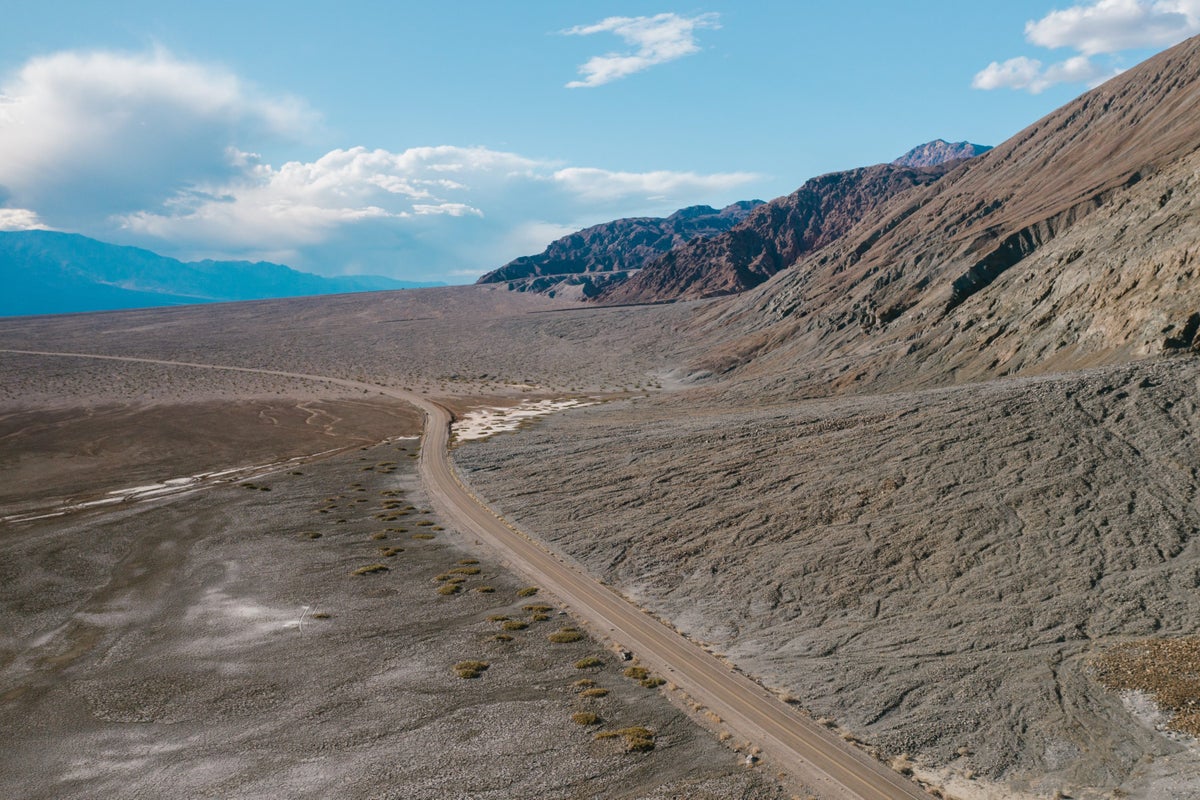
Most travelers who visit Death Valley National Park come from Los Angeles or Las Vegas. There are several ways to get to the park from both of these cities, each providing a one-of-a-kind experience. Let’s look at some of the options.
From Los Angeles
Those traveling from Los Angeles have 2 options for arriving at Death Valley National Park, both of which will take around 4.5 hours . The first option is to take CA-14 north to Cantil, Redrock Ransburg Road to US-395 to CA-178, and then CA-192 to Death Valley.
The other option for those coming from Los Angeles is to take US-10 toward San Bernardino and then follow US-15 until you arrive at Baker. From Baker, you’ll use CA-127 which leads to Death Valley Junction. Finally, take CA-190 to the park’s entrance.
From Las Vegas
There are 4 different routes to Death Valley from Las Vegas that travelers can take. The park calls them the Fastest Route, the Easiest Route, the Ghost Town Route, and the Most Scenic Route.
The so-called Fastest Route follows Interstate 15 South to NV Highway 160 West toward Pahrump, Nevada. From there, follow Bell Vista Road until you reach Death Valley Junction, California. Then, take CA-127 to CA-190 and drive 30 miles to Furnace Creek Center. This route should take about 2 hours.
Amtrak provides train services to Barstow , California, for those who want to experience traveling by rail. Barstow is 142 miles from Death Valley National Park, and you’ll need to rent a car there and then drive about 2.5 hours to the park.
Bottom Line: Driving from Barstow is about the same as driving from the nearest major airport, making this an excellent option for those who prefer ground travel or who want a break from driving long distances.
The only way to get around in Death Valley National Park is by personal vehicle. There are no forms of public transportation to or in the park .
There are several ways to enter the park. Two entrances are paved, and the rest are on dirt roads. The main road running east to west through the park is CA-190. The main roads running north to south are North Highway and Badwater Road.
The National Park Service website has a wide variety of printable and interactive maps for travelers planning their park adventures.
What To See and Do in Death Valley National Park
Death Valley National Park has plenty to experience, see, and do. There’s no shortage of sights and attractions, from hiking trails to fascinating natural wonders. Let’s take a look at the top attractions in this phenomenal park.
The most scenic drive in Death Valley National Park is Artists Drive . This drive is a 9-mile stretch of paved road that winds through the hills of Death Valley. Driving on this popular road is the perfect way to see many stunning sights in the park without walking too much.
The hills are colorful and are formed by volcanic deposits that have built up over the years. This scenic drive is stunning anytime during the day, but if you’re looking for a memorable experience, driving this route during the afternoon light will provide you with the most dramatic bursts of colors .
This is an excellent area for driving, but it’s also a popular route for people on bicycles. It’s essential to be aware of those sharing the road with you and be on the lookout for bicycles and pedestrians throughout your drive.
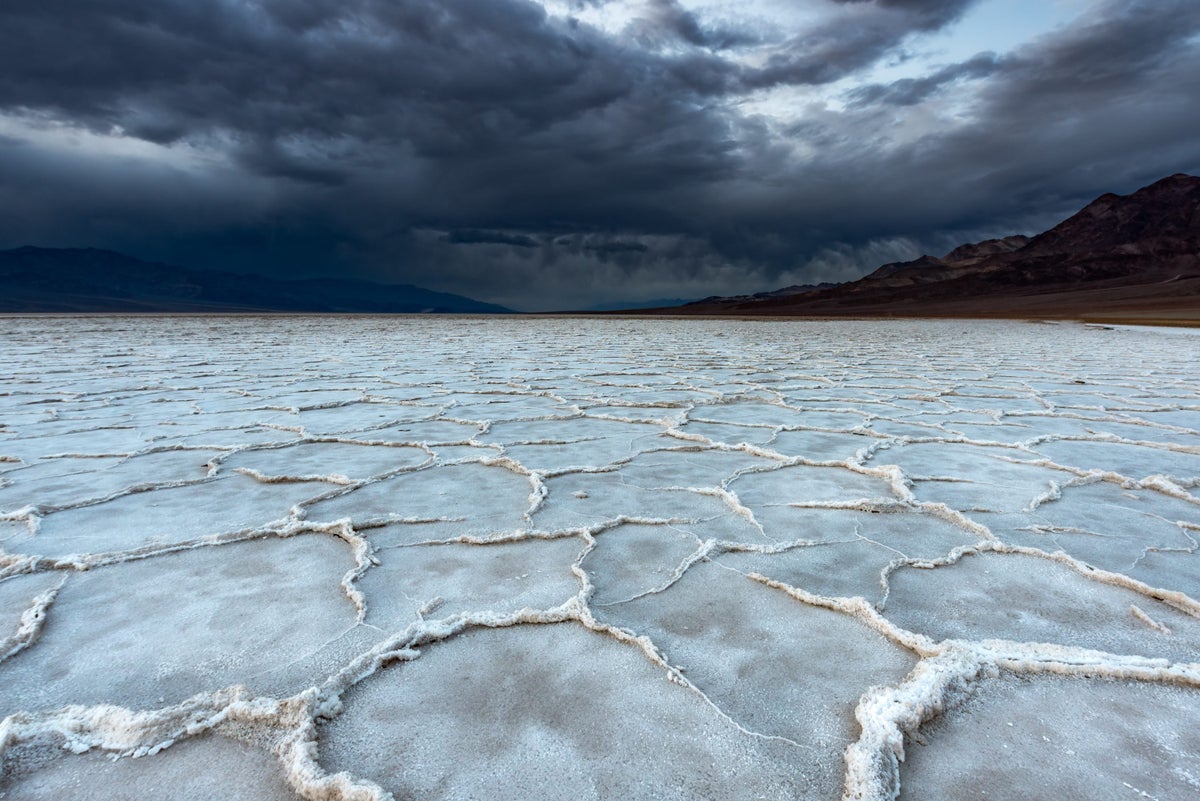
Badwater Basin is a pool of shallow, salty water over 280 feet below sea level. This is the lowest point in North America . The large salt flats cover nearly 200 square miles of land.
Stories from the past suggest that Badwater Basin received its name when a surveyor’s mule refused to drink the water from the spring-fed pool near the boardwalk you see today.
While not exactly hospitable to many creatures, there are plants and animals that thrive in this environment, including the pickleweed plant and a specific type of snail unique to the area.
This popular attraction at Death Valley National Park is an excellent location for taking photographs. This park area features a boardwalk, making it accessible to wheelchairs and strollers.
If you’re looking for the best view, venturing for a quick and easy walk out to the salt flats is where you will get the best views of the breathtaking area . When you’re in the midst of the salt flats, you’re surrounded by the towering Black Mountains and the Panamint Range.
Dante’s View is one of the most popular sites at Death Valley National Park. This overlook is located off CA-190 and provides sweeping 360-degree views of the southern Death Valley basin.
Dante’s View stands at 1,669 feet tall and is in the Furnace Creek area of the park. Incredible sights that can be seen from this overlook include the Owlshead Mountains, the Funeral Mountains, the Panamint Range, and the Green Water Range.
Death Valley National Park is home to Darwin Falls , which stands 18 feet tall and is surrounded by thriving plant life. Many visitors are surprised to learn that a stunning waterfall can be found in the middle of the desert park .
Darwin Falls is a popular hiking area with a nearly 2-mile trail that takes around 45 minutes to hike from start to finish. Standing in awe of this roaring waterfall will create memories that will last a lifetime.
Furnace Creek Visitor Center is an excellent place to learn about Death Valley National Park, ask park rangers questions, and purchase permits and national park passes.
There are also numerous exhibits and a 20-minute film that teaches about the natural and cultural history of the park. There is an on-site bookstore where you can shop for souvenirs.
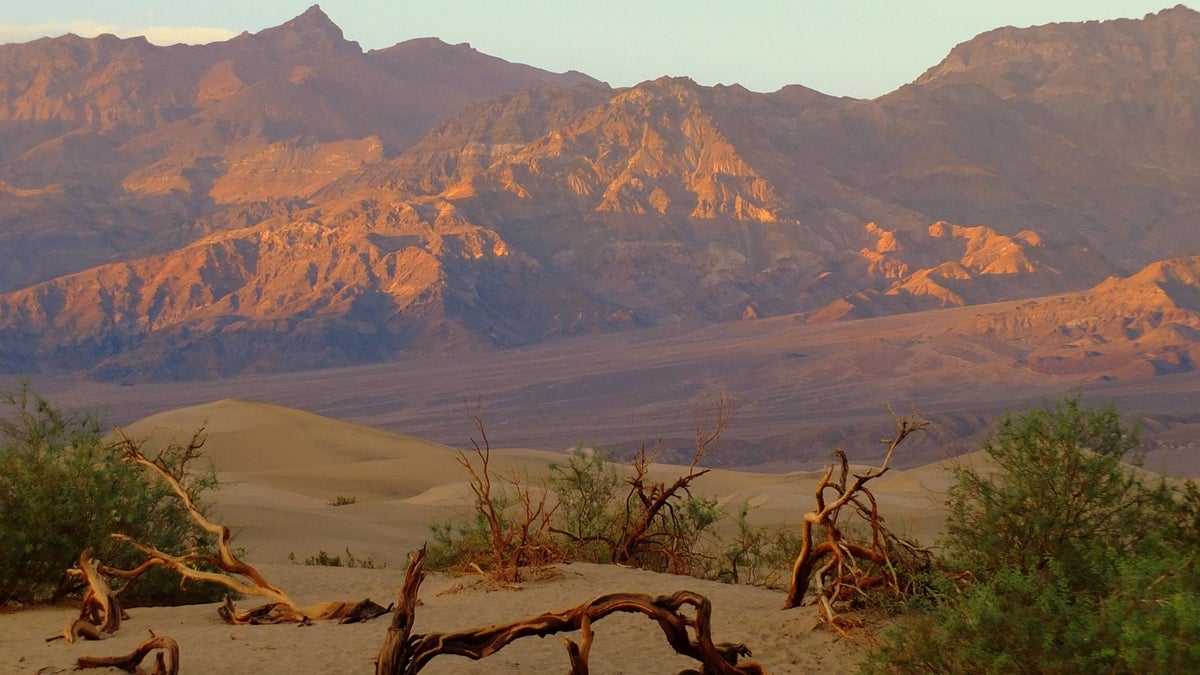
Mesquite Flat Sand Dunes are another must-see attraction in Death Valley National Park. Named after the mesquite tree, the area’s dunes are created by the wind which steadily moves the sand and the mountains, which keep the sand from being blown too far.
Many animals make their home in this park area, including kangaroo rats and sidewinder rattlesnakes .
There’s no official trail in this area, so it’s critical to stay on the lookout while exploring . It’s also important to note that if you see a burrow of one of these animals, it’s best to leave it alone so that the animal can continue living undisturbed.
This area is incredible to visit at sunrise and sunset. It’s also an excellent place to stargaze and enjoy the famous night skies at Death Valley.
Mosaic Canyon is a favorite of many visitors to Death Valley National Park. It boasts numerous slot canyons and offers the opportunity to get up close and personal with the incredible geology found in Death Valley.
One of the most remarkable features of this area of the park is the primary rock found in this area of the park. Mosaic Canyon Breccia is a type of natural cement that holds pieces of many other kinds of stones together and gives the appearance of a tile mosaic.
This trail is a great site for climbing — perfect for enthusiasts and adventurers who love a challenge . The hike through Mosaic Canyon starts off easy, but many sections and side trails are rigorous.
Bottom Line: There are tight squeezes, massive boulders, and other types of obstacles that will be encountered along the way. If you’re up for the challenge, this trail won’t disappoint.
The Racetrack is located between the Cottonwood and Last Chance Mountain ranges. This area of the park is a remarkable mixture of beauty and mystery.
This attraction is a “playa,” or a dry lake bed, and is notorious for its sliding rocks. In the past, people believed that the natural phenomenon of sliding rocks was caused by playful spirits and extraterrestrial activity . However, science has proven that a combination of high winds and winter ice causes the stones to move across the playa.
This is an exciting sight to behold that will leave you mesmerized. If you plan to visit this area, it’s imperative to protect the surface of the playa as it is very fragile. It’s vital to only drive in marked areas and to leave the rocks alone . When it has been raining and the playa is wet, it’s critical to stay out of muddy areas and refrain from leaving footprints.
Ubehebe Crater is a massive crater formed by a volcanic eruption. It is thought that the crater was created by an explosion that happened about 2,100 years ago. This crater is 600 feet deep and half a mile across.
Ubehebe Crater is easy to view from the parking area near its rim, but most park visitors enjoy hiking to get a closer look. The rim trail is relatively easy and about 1.5 miles round-trip. This rim route also showcases several smaller craters, including Little Hebe.
Visitors can also walk to the bottom of the main crater. The walk to the bottom of this enormous crater is easy, but the trip back up can be quite strenuous.
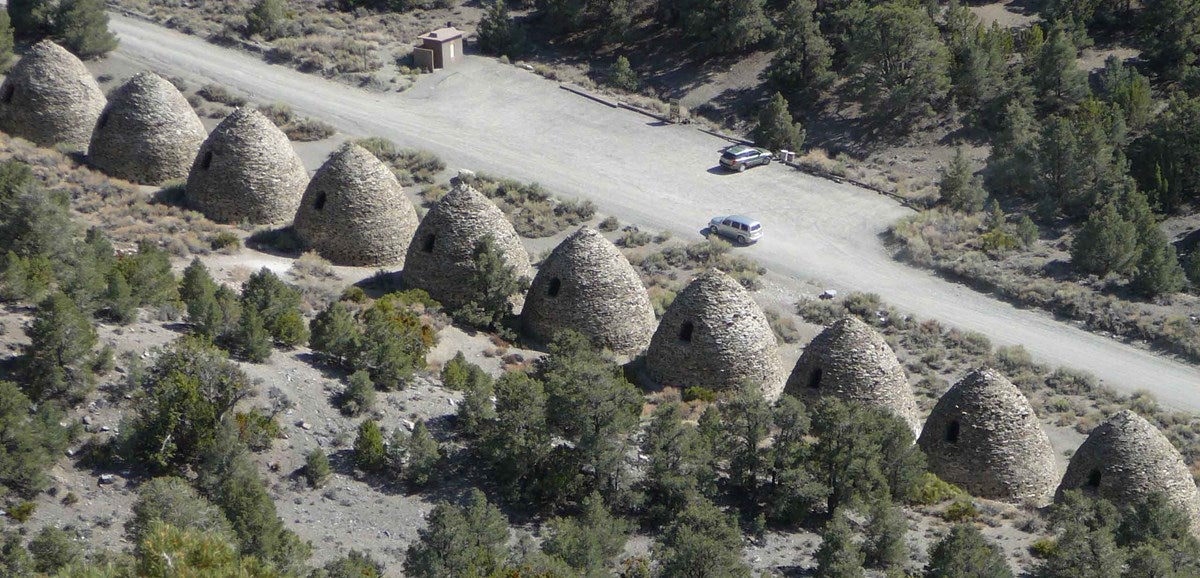
A major attraction at Death Valley National Park is the Wildrose Charcoal Kilns . These beehive-shaped historic structures were built and used starting in 1877 by a mining company that produced charcoal and turned Death Valley ore into silver .
These kilns were only used for a few years, which is why they remain in such good condition today. These structures stand 25 feet high and are said to be some of the best examples of historic kilns in the western U.S.
Best Times To Visit Death Valley
A trip to Death Valley National Park will be one to remember for the rest of your life, no matter when you visit. However, there are better times to visit than others if you are hoping to experience specific activities. Below are the best times to plan a Death Valley National Park trip.
February is the best winter month to visit Death Valley National Park. The temperatures are warmer, with lows in the upper 40s and highs in the mid-70s. Not only is the weather ideal during February, but the crowds are much lighter . However, there is a greater chance of rain.
December is the best month to visit if you’re looking for the fewest crowds. Temperatures range from the low 40s to the 70s, making it an ideal time to visit with few crowds and pleasant weather.
There are plenty of activities for adventurers during the winter months, such as snowshoeing to Telescope Peak and being able to explore the dunes without the miserable heat.
If you’re hoping to see the wildlife that makes its home in Death Valley National Park, planning a trip in the fall is best. November is an excellent month to visit the park. The crowds start dissipating, so the chance of spotting wildlife is higher . The weather is also agreeable, making it a great time to hike and camp.
Planning an early summer trip to Death Valley National Park is a great way to be frugal while traveling. Late May or early June is an optimal time to visit Death Valley. The park is less crowded at this time which makes for a less stressful visit.
Hot Tip: Lodging rates and flight pricing is typically less expensive in the early summer months.
Several annual events take place in Death Valley National Park. There’s an event available for every adventurer, from marathons to astronomy events. Let’s take a look at some of the exciting events that take place in this park each year.
Death Valley ’49ers Annual Encampment
Death Valley ’49ers Annual Encampment happens every November. Volunteers host this event at a non-profit organization that aims to spread awareness and appreciation about the Death Valley area. This event features live music, craft fairs, and presentations that pay tribute to the people and history of the region .
Death Valley Dark Sky Festival
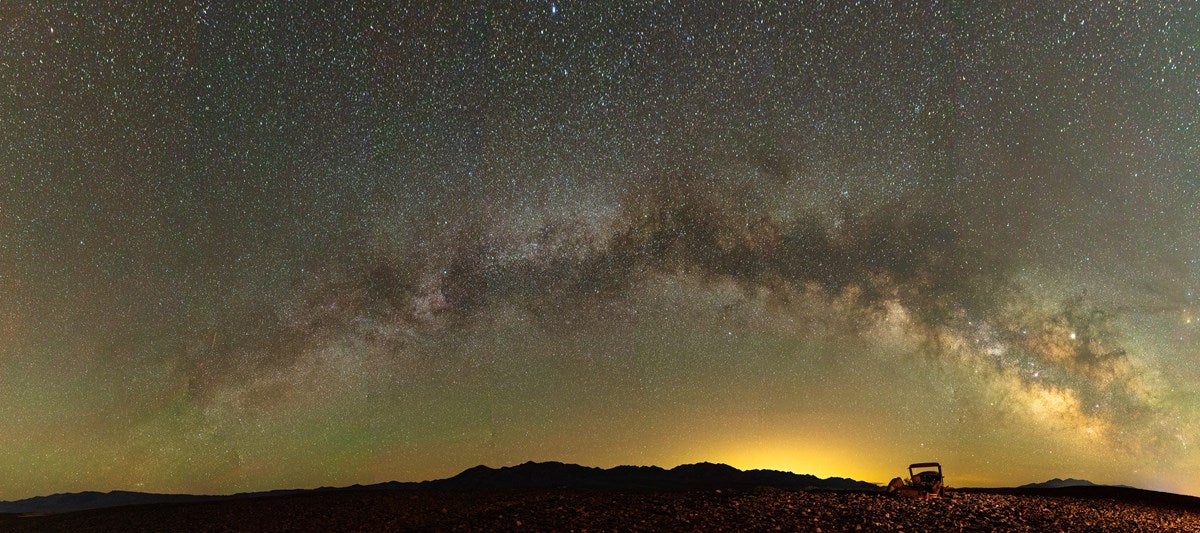
Each year in February, visitors can come to the Death Valley Dark Sky Festival to experience an incredible stargazing event.
Death Valley has received the highest ranking of darkness by the International Dark-Sky Association. It is designated as a Gold Tier Dark Sky Park, and guests can visit during this festival to learn about the night sky and the park’s landscapes.
Death Valley National Park partners with Death Valley Natural History Association and other organizations, including NASA’s Goddard Space Flight Center and California Institute of Technology, to provide this incredible astronomical event each year.
Death Valley Trail Marathon
Death Valley Trail Marathon is a half-marathon and marathon that takes place each year in December. The races begin in the town of Beatty and take runners on a gravel course through the scenic wilderness of Death Valley National Park. This event has been taking place for over 30 years and provides a one-of-a-kind, unforgettable experience at Death Valley National Park.
Where To Stay in Death Valley National Park
Lodging won’t be a problem when visiting Death Valley National Park. Options are abundant both in and near the park . Whether you prefer camping, staying in a lodge, or being pampered in a luxury resort, you can find exactly what you’re looking for.
Let’s check out the different accommodations found in and around Death Valley National Park.
Death Valley National Park has a variety of campgrounds and 4 different areas where visitors can lodge during their park visit. These lodging areas include Stovepipe Wells Village, The Oasis at Death Valley, The Ranch at Death Valley, and Panamint Springs Resort . Here’s a look at the lodging options available inside the park.
Camping at Death Valley
There are 4 types of campgrounds available at Death Valley National Park, including developed campgrounds , primitive campgrounds , private campgrounds , and backcountry campgrounds .
There are 7 developed campgrounds throughout the park. Each of these campgrounds is accessible by a paved road . These campgrounds also have water, toilets, and trash services provided.
The primitive campgrounds are accessed by unpaved roads and have no services available for campers. There are 5 such campgrounds available. The National Park Service does not run the private campgrounds within the park.
These campgrounds include Stovepipe Wells RV Park, Panamint Spring Resort, and The Ranch at Death Valley. Camping in one of the private campgrounds requires a reservation in advance.
Hot Tip: Backcountry camping is available in many parts of the park as long as you camp a mile or further from any paved or dirt roads. Free permits are available and required for several areas for backcountry camping.
The Inn at Death Valley
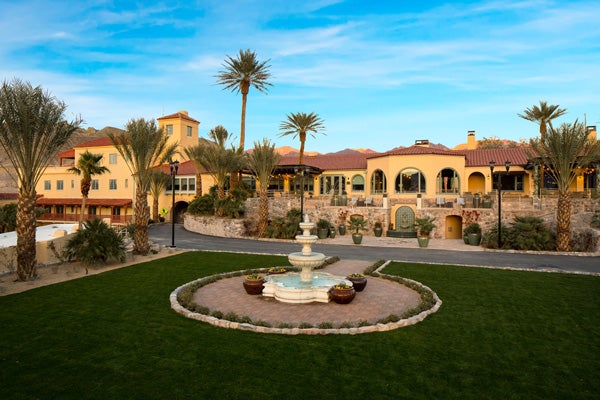
The Inn at Death Valley is a historic inn offering luxury accommodations. It’s located in the Furnace Creek area of the park. Known as the crown jewel of Death Valley, this historic inn has been providing incredible accommodations since 1927 .
The Inn at Death Valley is an AAA-rated 4-Diamond Resort with superior amenities such as brand-new guest rooms and a spring-fed pool, and you can even get massages on site.
Panamint Springs Resort
Panamint Springs Resort is located in the Panamint Springs area of the park. This resort is small and rustic and gives guests a western-style experience.
This resort features 14 historic motel rooms, a cottage, 9 brand-new cabin-style motel rooms, and tent cabins . Camping services are available in this resort area. There are full hook-up sites and sites for tent camping as well. Another draw to the Panamint Springs Resort area is the local restaurant, bar, and gas station in a general store.
The Ranch at Death Valley
The Ranch at Death Valley has been serving visitors since 1933. This hotel has 275 rooms and is well known for its lively atmosphere and for providing exciting activities in Death Valley.
This facility is located next to the visitor center. It has incredible facilities, such as a brand-new restaurant, an ice cream and coffee bar, a general store, and a saloon that feels like it’s been pulled from a western movie.
The Ranch at Death Valley used to be a working ranch but has transformed into a family-friendly lodging option. This ranch offers activities such as horseback riding, carriage rides, Jeep rentals, and an 18-hole golf course . The Ranch at Death Valley is a perfect place to unwind and relax while exploring this incredible national park.
Stovetop Wells Village
Stovepipe Wells Village offers resort-style accommodations and a few sites for RV camping. This area features a 90-year-old historic hotel that is a visitor favorite. This park area provides a tribute to the American West Gold Rush era.
Towns Near Death Valley National Park
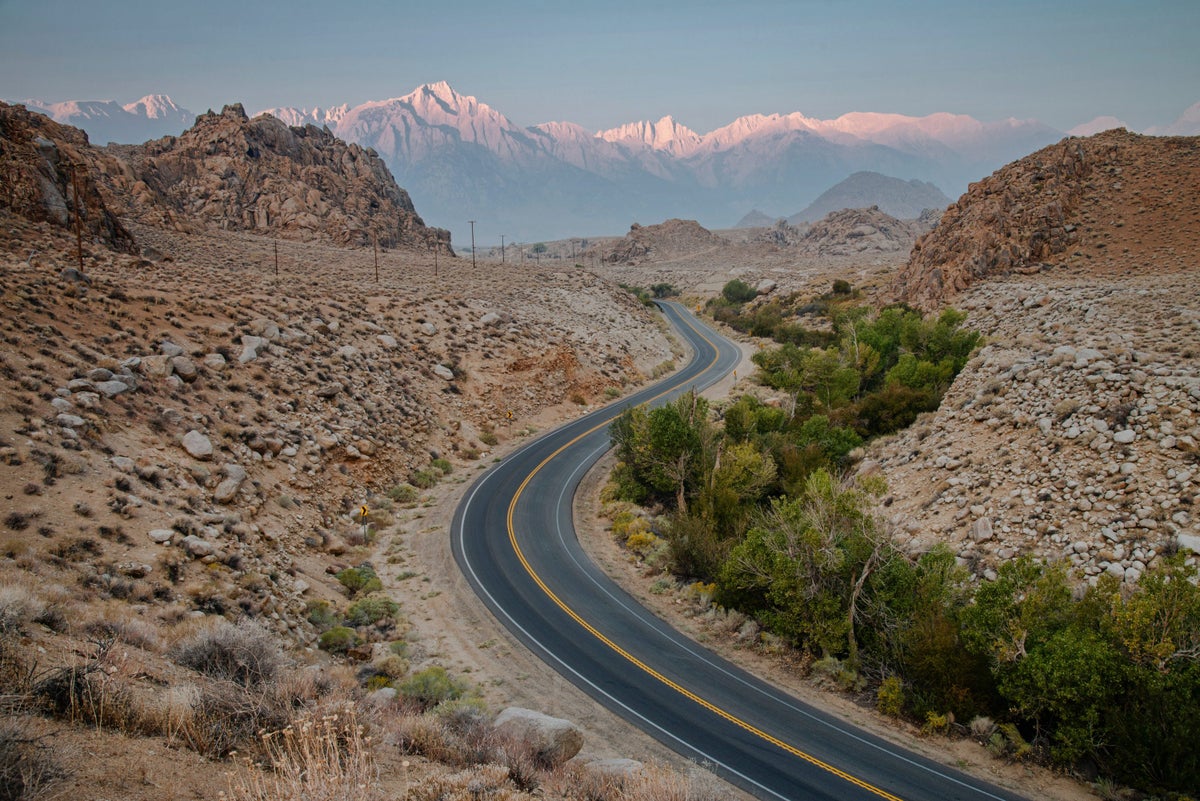
There are several towns near Death Valley National Park that are perfect for those who prefer lodging nearby. Three well-known cities that are great places for setting up a base camp include Beatty, Lone Pine, and Shoshone . From historic motels to RV campgrounds, there’s something for every traveler near Death Valley National Park.
The town of Beatty is known as the gateway to Death Valley . This small town is just 20 minutes from the park’s Hell’s Gate entrance. Beatty is a former mining town with many sights and activities on offer, including museums, living historians that reenact life during the 19th century, and more.
Beatty has unique lodging opportunities, including a hotel for extraterrestrial enthusiasts (the Atomic Inn) and several small motels and RV parks. Beatty also has an incredible array of unique restaurants, from classic hometown diners to cafes to Wild West saloons.
Lone Pine is 2 hours from Death Valley National Park and an ideal destination for those who seek adventure. Located between the Inyo and Sierra Nevada mountain ranges, this town is brimming with history and adventure .
There are plenty of lodging options in town, and plenty of dining options, including gourmet restaurants, pizza parlors, Mexican restaurants, saloons, and cafes.
This town is known for its adventure opportunities, such as exploring the surrounding mountains, hiking, climbing, and visiting museums, such as the Museum of Western Film History , and shopping in the historic downtown area.
Shoshone is a desert town an hour away from Death Valley National Park. Historically, this town was a railroad center and a place for local miners to rest and relax. Since then, Shoshone has become a gateway town for those visiting the park.
This town has many lodging opportunities, such as retreats, historic cabins, and RV parks. Shoshone has several dining options, with the Crowbar Café and Saloon being a visitor favorite.
The opera house has a variety of exciting programming to offer visitors throughout the year, and there are many opportunities for outdoor adventures, such as hiking, golfing, and horseback riding.
Where To Eat in Death Valley National Park
There is a great number of dining options in Death Valley National Park. Every lodging area has at least 1 restaurant on offer. From saloons and watering holes to fancy dining rooms, there’s something for every palate at Death Valley National Park. Let’s look at 3 popular places to get a bite to eat.
Badwater Saloon is open daily for lunch and dinner. This restaurant is located in the Stovepipe Wells area. Badwater Saloon serves an outstanding menu of American cuisine , featuring burgers, salads, and sandwiches.
This saloon also offers an impressive selection of wine, specialty cocktails, and Western spirits. This is the perfect place for park guests to enjoy a good meal and company and refuel from their park outings.
The Inn at Death Valley Dining Room is another incredible option in the Oasis resort area of the park. This dining room serves a menu featuring classic dishes with the exciting flavors of cactus, date, pomegranate, and citrus sprinkled throughout many dishes on the menu.
This dining room is open for breakfast and dinner daily and is a more formal establishment. Reservations are required in advance, and the dress code is resort attire.
Toll Road Restaurant provides visitors with a unique culinary experience. This restaurant is one of the finest restaurants in Death Valley National Park.
The restaurant is open daily for breakfast, lunch, and dinner . With generous portions of delicious food and exceptional service, Toll Road Restaurant should be at the top of your list of things to do while visiting Death Valley National Park.
Death Valley National Park Facts
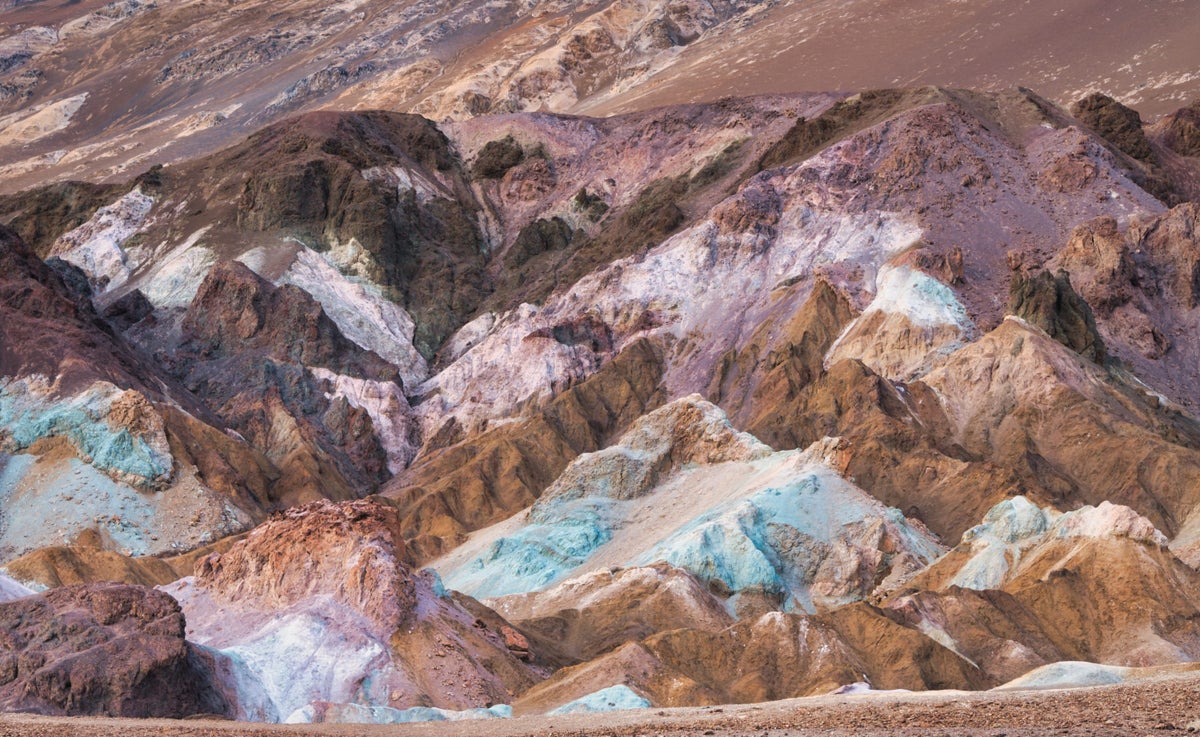
Before Death Valley was established as a national park, it was a national monument. Death Valley was designated a national monument in 1933, and decades later, in 1994, Congress declared it a U.S. national park.
Death Valley National Park is the largest national park found in the lower 48 states. This park is located in California and Nevada and spreads over 3.4 million acres across the desert landscape.
The Timbisha Shoshone Tribe originally inhabited Death Valley. They were hunters and gatherers who believed all their needs could be met by living off the land. They gathered the pinyon pine nuts and mesquite beans found in the area. Because the land was so special to this group, they had many sacred places throughout the park. These areas are still considered sacred today.
Death Valley National Park has been an ideal location for mining for over a century. An abundance of minerals has been found in this area , including silver, gold, tungsten, ore, copper, lead, zinc, borax, and antimony. In 2005, the last mining operation closed its doors.
In the winter of 1849 to 1850, a group of pioneers became lost in the Death Valley area. One group member died during this time, and the others felt the same would happen to them. The men assumed their location would be their grave.
Fortunately, the rest of the lost pioneers were rescued by 2 Good Samaritans. Once they found their way and headed for home, 1 man said, “Goodbye, Death Valley.” The nickname stuck, and so became Death Valley.
Death Valley National Park has been a popular location for dozens of movies and television shows over the years. Some of the most popular movies filmed in the park include “Star Wars: Episode IV – A New Hope” and “Star Wars: Episode VI – Return of the Jedi.”
A castle can be found in Death Valley National Park. Grapevine Canyon is home to a hidden castle called Death Valley Ranch, nicknamed Scotty’s Castle.
This castle was built as a vacation getaway by a man named Albert Mussey Johnson. Walter Scott, a local cowboy and friend of Albert’s, convinced everyone that Johnson built his home with money from secret mines in the area. This dream home can still be visited and toured today. It gives a glimpse into what life was like during the 1920s and 1930s.
Furnace Creek, located in Death Valley National Park, is the hottest place on earth . The highest recorded temperature in this location was documented in July of 1913 when the thermometer hit 134.1 degrees.
Death Valley National Park is home to a rare fish called the Devil’s Hole Pupfish. These fish are iridescent blue and can be seen in Devil’s Hole, which is a geothermal, water-filled cave system in Death Valley. These native fish are at risk of becoming extinct, with the most recent count finding just 175 fish.
“Death Valley Days” was a television series based on and filmed in Death Valley National Park. The episodes would tell stories of key people and events in Death Valley and had some famous hosts, including President Ronald Reagan.
Death Valley National Park is a part of the U.S. you won’t want to miss. Don’t be fooled by its name because Death Valley pulses with life, wonder, mystery, and beauty. Explore Death Valley National Park and discover the adventure, history, and stunning natural beauty that awaits you.
Frequently Asked Questions
Are there fees for visiting death valley national park.
A pass must be purchased upon entering the park. A pass costs $30 per vehicle and provides access to the park for 7 days.
How long should I plan my trip to Death Valley National Park?
This park is massive and has many different areas to explore. Much of the park can be explored in 2 to 3 days, but an ideal trip would be 4 to 7 days. An extended trip provides a less rushed experience and more time to explore various sites.
What is the weather like in Death Valley National Park?
Winter temperatures can get as low as 15 degrees, and summertime highs typically reach up to around 120 degrees. The highest recorded temperature has been 134.1 degrees. It is very dry in the park, so you don’t have to worry about experiencing much rain on your trip to Death Valley.
Can I bring my dog to Death Valley National Park?
The National Park Service does not recommend guests bring their dogs to Death Valley National Park due to the heat and natural dangers. While there are some areas where dogs are permitted, most park areas do not allow dogs.
Was this page helpful?
About Amar Hussain
Amar is an avid traveler and tester of products. He has spent the last 13 years traveling all 7 continents and has put the products to the test on each of them. He has contributed to publications including Forbes, the Huffington Post, and more.
INSIDERS ONLY: UP PULSE ™

Get the latest travel tips, crucial news, flight & hotel deal alerts...
Plus — expert strategies to maximize your points & miles by joining our (free) newsletter.
We respect your privacy . This site is protected by reCAPTCHA. Google's privacy policy and terms of service apply.
Related Posts
![death valley national park places to visit Virtual Tours of the 63 Iconic U.S. National Parks [2024]](https://upgradedpoints.com/wp-content/uploads/2022/11/Arches-National-Park-View.jpg?auto=webp&disable=upscale&width=1200)
UP's Bonus Valuation
This bonus value is an estimated valuation calculated by UP after analyzing redemption options, transfer partners, award availability and how much UP would pay to buy these points.

20 Incredible Things to do in Death Valley National Park
Ready to discover epic things to do in Death Valley National Park? Incredible sunrises, salt flats and scenic drives await.
Death Valley National Park is a straight-up epic destination. No if, no buts, no quibbles.
If you’re planning on visiting Death Valley for the first time, let me tell you, you’re in for a ride.
The name might sound a little grim, but the reality is a series of landscapes that are out of this world – from watching a kaleidoscopic sunrise light up the valley basin to hiking into the midst of multilayered canyons – Death Valley is packed with amazing landscapes for you to explore.
It’s one of my favourite destinations in California – a slice of Martian terrain plopped in the state’s far eastern reaches.
That’s enough about me though. Let’s help you plan your trip to Death Valley.
This guide takes a deep dive into the must-see sights in the park – from better-known places like Badwater Basin to hidden gems like the Charcoal Kilns. I also cover a series of practical tips to help you with planning your own visit at the end of the article.
Ready to delve into all the incredible attractions that bring visitors back to this formidable piece of the planet year after year? Of course you are. Let’s go.
Although the park has reopened, many of the roads and attractions in Death Valley are closed after the flooding in summer 2023. Check the National Park’s website for up-to-date information before you go.
Best Things to Do in Death Valley National Park
Catch the sunrise at dante’s view.
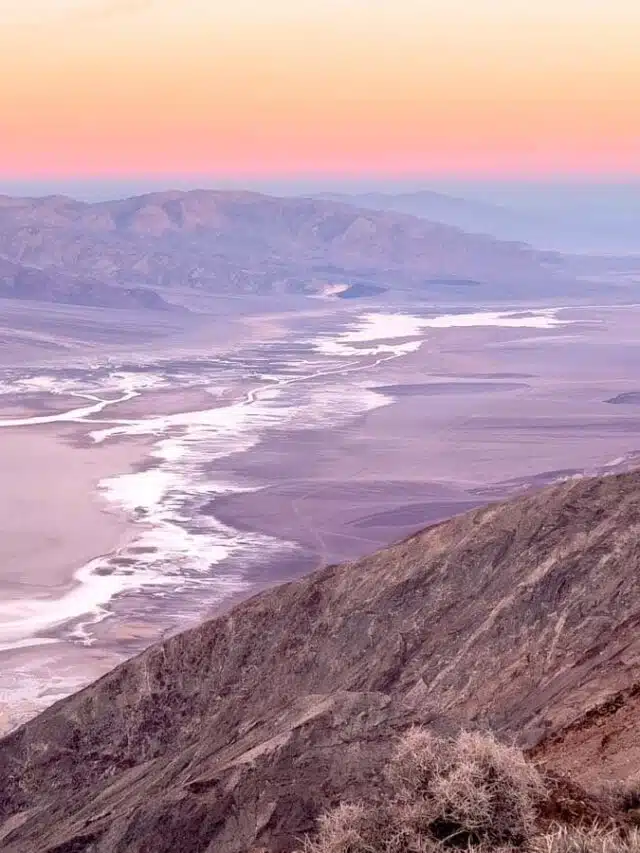
If you only have time to take in one EPIC viewpoint in Death Valley, make it Dante’s View.
The views alone guarantee Dante’s View a spot in any guide to the top spots in Death Valley National Park, but when you throw a spectacular sunrise into the mix and it’s almost unbelievable.
What’s the draw? Trundle up in the car to the viewpoint’s lofty 1,670 metres, to look down over the breadth of Death Valley… all the way across the Badwater Basin to the mountains on the far side.
It’s a little out-of-the-way to get to, but the view alone is worth it. The browns and oranges of the mountain rock contrast the silky whites and purples of the Basin, making it seem like you’re gazing upon a winding river of milk. Stunning!
I’ll warn you – it is freezing at sunrise (seriously, I thought my ears were going to fall off) so wrap up warm and bring a hot drink – you’ll want to be up here for hours.
Hang Out At America’s Lowest Point: Badwater Basin
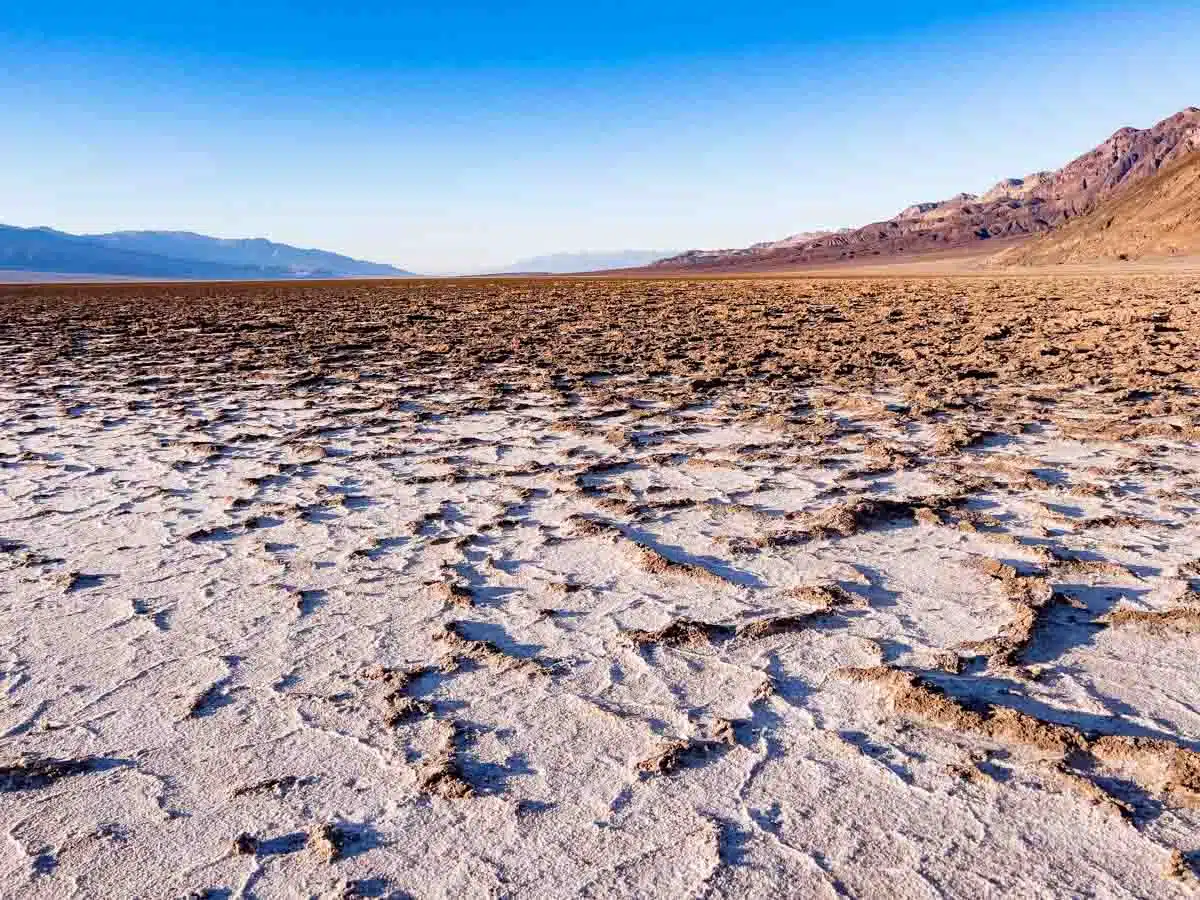
When it comes to Death Valley attractions, Badwater Basin is always going to be high on the list.
At 86 metres (282 feet) below sea level, Badwater is the lowest point in North America.
That’s not all though – Badwater Basin just so happens to be a vast salt flat. Hundreds of intricate geometric shapes tessellate like sunlight on the bottom of a pool – all in all, it’s a fascinating sight that looks more like it belongs in Bolivia than in good ol’ California.
Its unique geography not only paves the way for some weird views, it also means that Badwater has a few tricks up its sleeve – for example some of the hottest temperatures on Earth have been recorded here, with highs of 56℃ (134℉).
Most people just take a few steps beyond the boardwalk. But if you’re like me, you’ll want to walk the 1.8-mile path into the heart of the basin to fully ensconce yourself in the shimmering, salty vista.
It’s super easy to get to, but the parking lot fills up fast, so get there early.
Visiting Badwater Basin, Death Valley National Park’s Spectacular Salt Flats
Marvel at the Views from Zabriskie Point
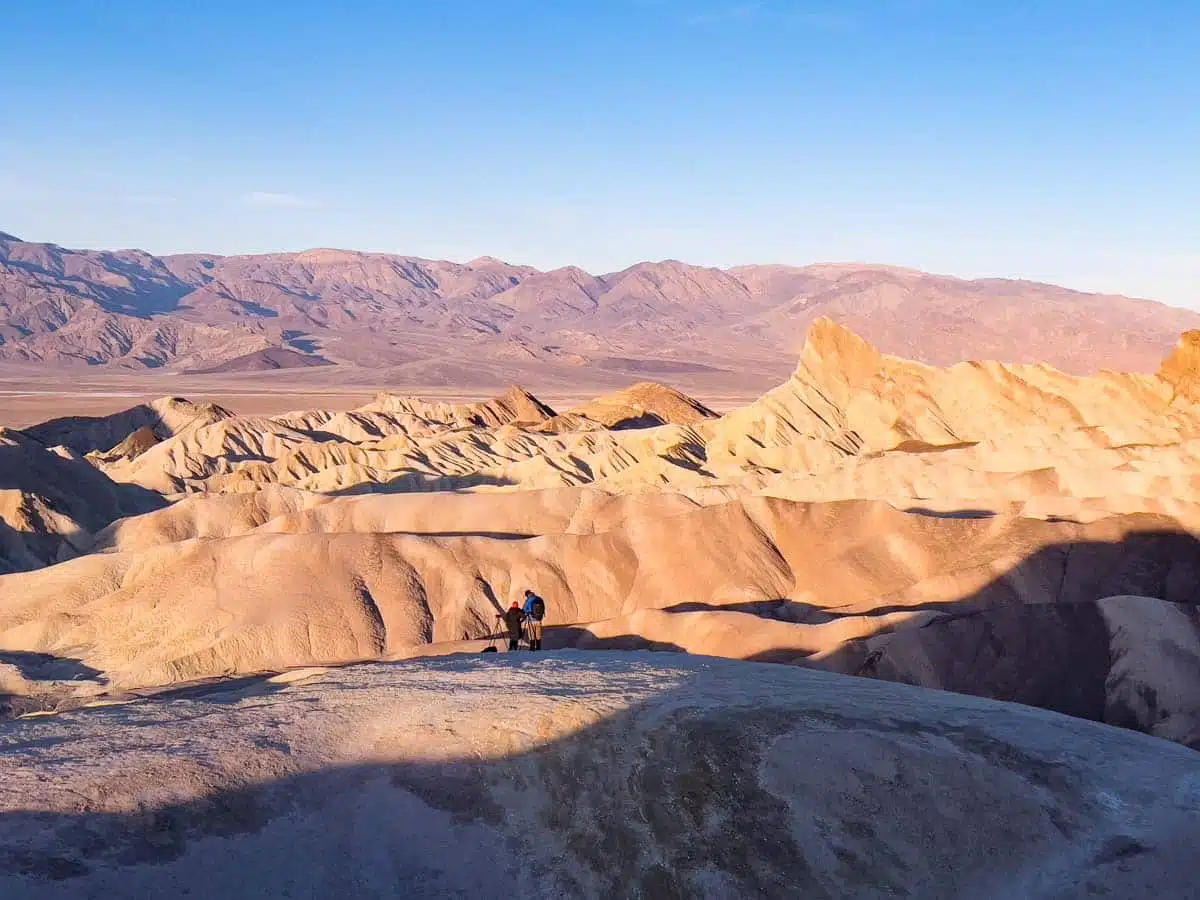
Zabriskie Point is another of Death Valley’s epic attractions. Just a short hike from the parking lot, it boasts one of the park’s most glorious vistas.
Can you conjure up images of jutting multi-hued stone carved by wind and water? Zabriskie Point overdelivers – with a dramatic panoramic view of the valley that is, quite frankly, obscenely pretty.
Sure, it’s pretty, but what are you actually looking at? The remains of Furnace Creek Lake, a lake that dried up millions of years ago, leaving a tableau of gullies and ridges in its lake.
It’s popular, so prepare yourself for crowds if you come during peak season.
You may also want to bring a warm jacket, as it’s at a much higher elevation than the floor of the valley, so it can get chilly depending on the season.
Hike Over The Mesquite Flat Sand Dunes
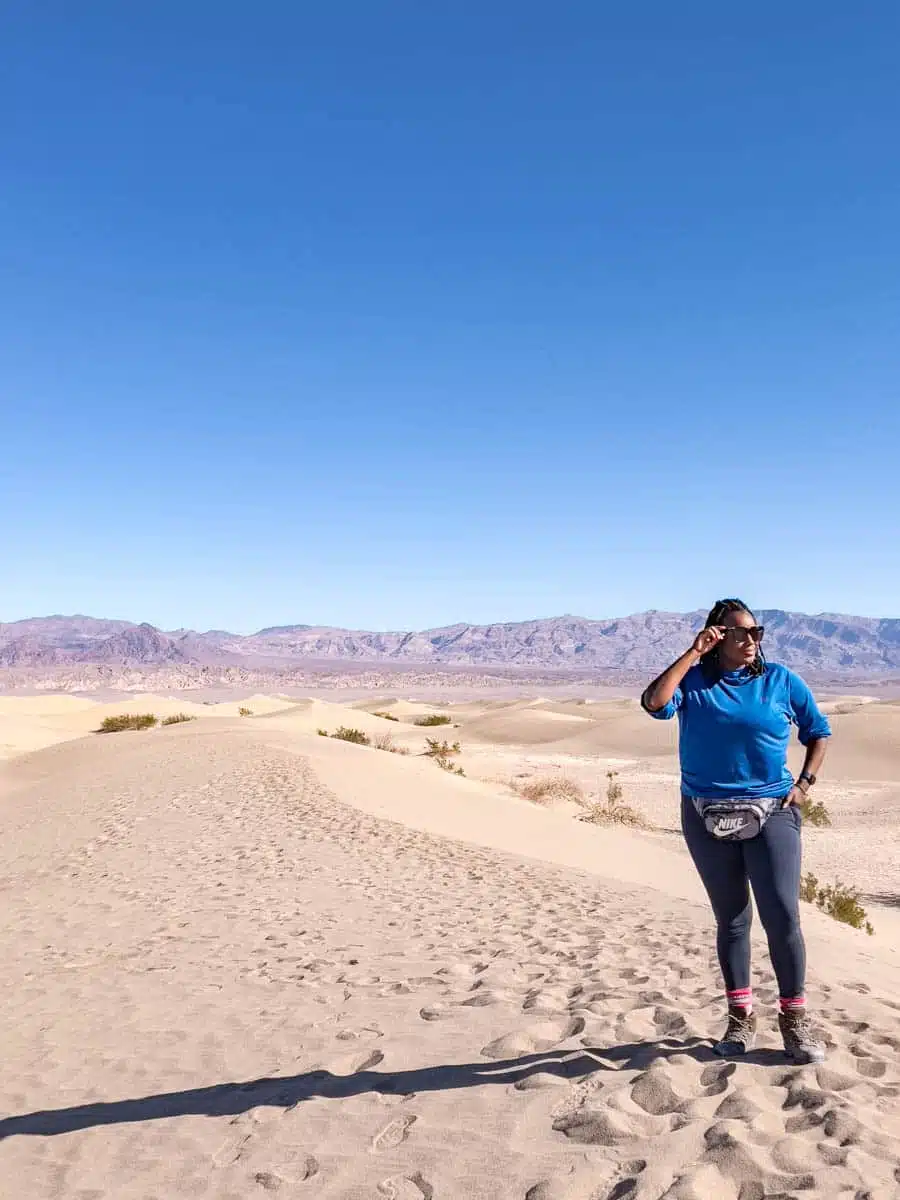
Although Death Valley is actually home to five dune fields, the Mesquite Flats are the most popular.
With majestic purple mountains in the distant background and golden dunes before you, it’s a photographer’s dream come true.
Strike out onto the dunes from the parking lot as far as you like, but – be warned – walking in loose sand, particularly in the heat, is no easy task, so save some energy for the return trek.
That said, the further out you get, the more solitude and better views you get… isn’t that always the way.
The heat and the sun are no joke – ensure you’re well protected from the sun and have plenty of water. Don’t venture further than you can safely return.
See the Volcanic Remains at Ubehebe Crater
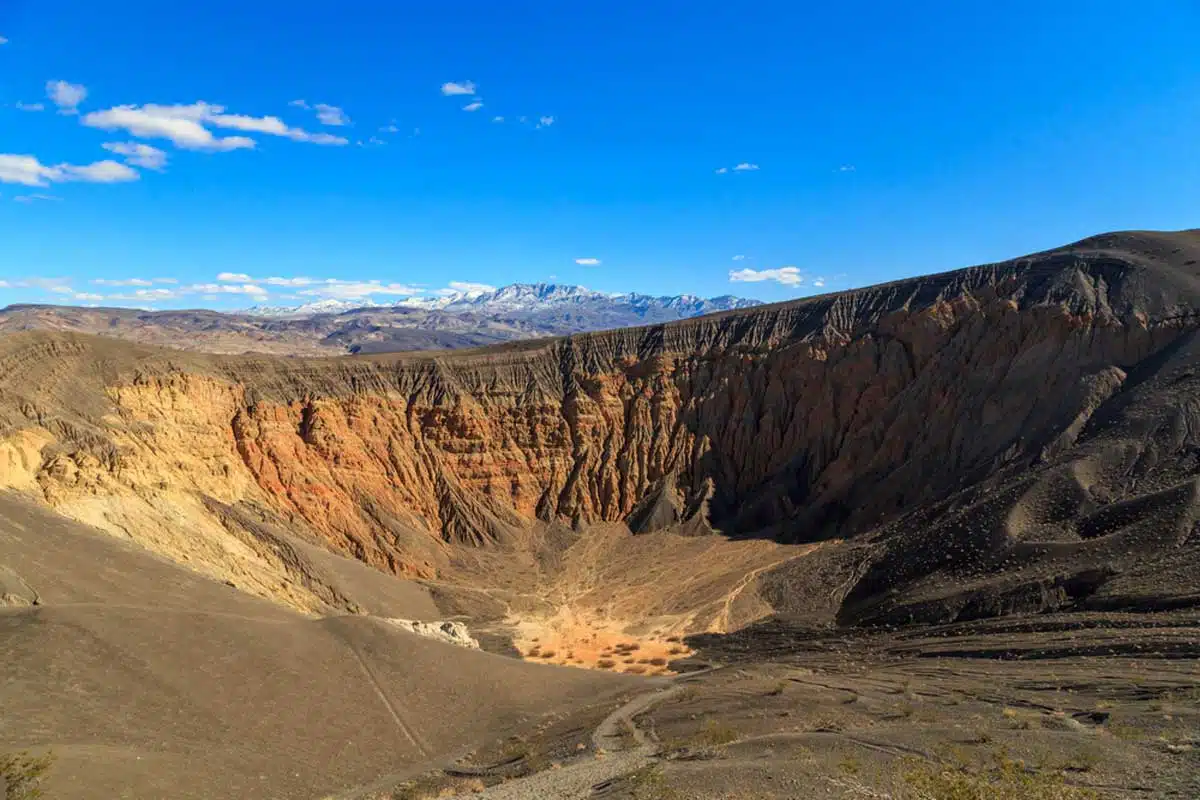
Ube-what-now? It’s pronounced “oo-beh-heh-bee ” and looks like a meteor’s strike zone, but Ubehebe is a volcanic crater in the valley.
It’s a maar volcano crater – in other words a crater created by a steam explosion as magma rises towards the earth’s surface and meets groundwater, building in pressure until it explodes, leaving a crater in its wake.
You can hike around the rim (a mere 1.5 miles), trek down to the crater, or admire the view from the parking lot. Be warned, it can be tempting to descend into the crater, but the ascent can be tough – make sure you’re prepared with lots of water and sturdy shoes.
Although Ubehebe is the most iconic of the craters in Death Valley, there are others in the park too – including nearby Little Hebe, which was created by the same process.
The crater was closed on my most recent trip to Death Valley in November 2022 due to flash floods on the road to the crater. Check with the NPS if it’s open before attempting to go.
Walk in the Footsteps of History in Death Valley’s Ghost Towns
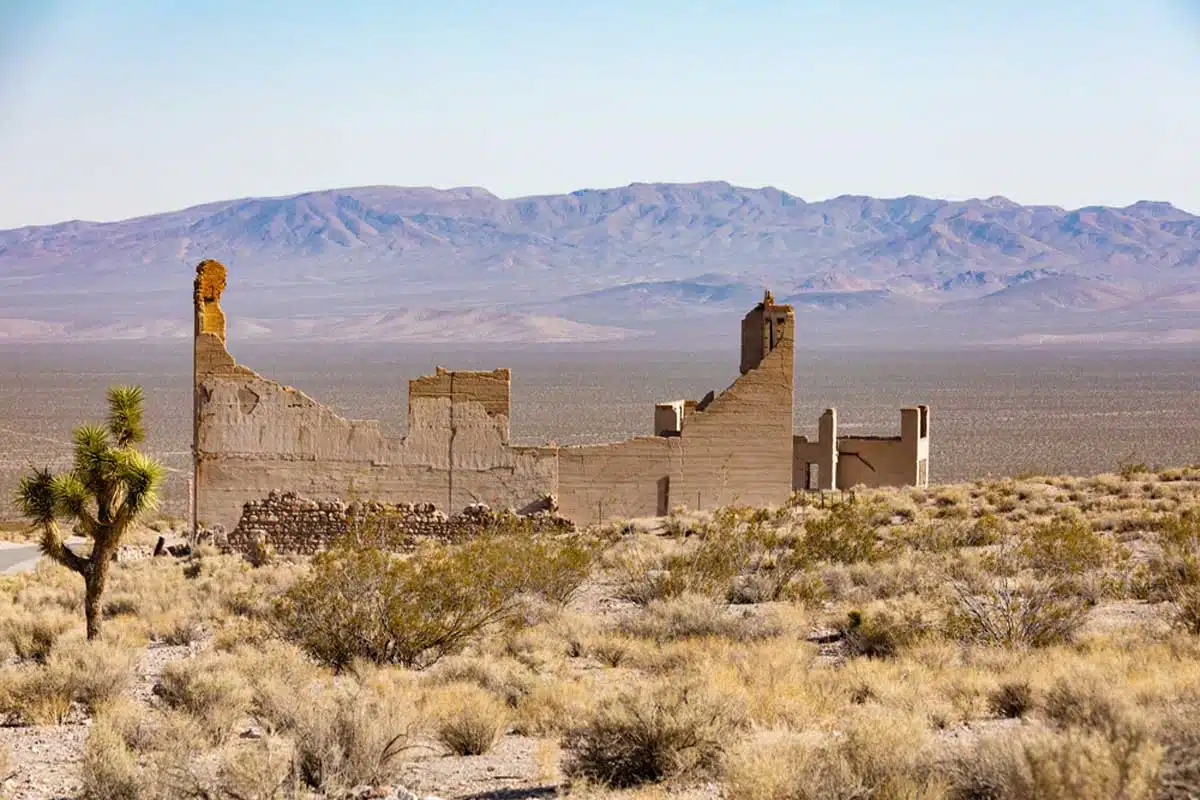
Were it not for the smattering of so-called “ghost towns” spread across the park, it would be hard to believe that these inhospitable plains were once home to small communities of people drawn in by the gold, copper and other precious minerals that were mined in the region.
Visiting the ghost towns is a fascinating experience, pulling you into the remains of history, relics of the area’s Boom and Bust era.
Rhyolite is the best-known ghost town which is funny given that it’s not even in Death Valley and actually sits across the state line in Nevada. At its peak, the town had a population of 5,000 and even had its own Opera House before the gold ore ran out and people moved elsewhere.
Others like Ballarat, Leadfield, Chloride City and Skidoo are smaller in comparison, but no less interesting.
PS. Think you’ve heard the name Ballarat before? It’s famous for being the place where Charles Manson hid out in the 1960s.
What You Need to Know About Death Valley’s Ghost Towns
Check Out the Devil’s Golf Course
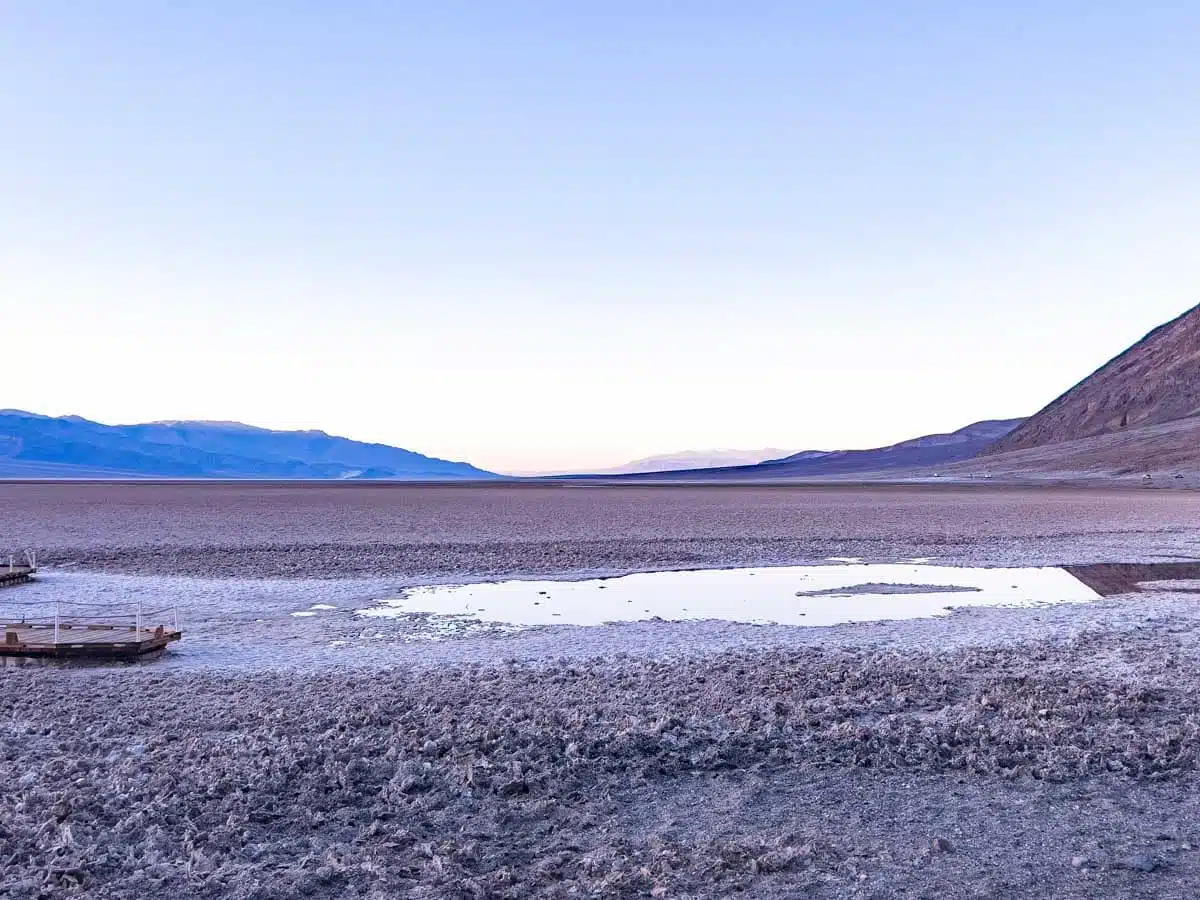
Imagine a landscape maintained by the worst groundskeeper ever and you’ll come close to conjuring up an image of the Devil’s Golf Course.
Looking like the divets of a thousand golfers pockmark the earth, it’s actually a lumpy salt (not-so) flat that forms part of Badwater Basin.
You’re not allowed to actually walk on the Golf Course – probably down to the sharp salt crystals on many of the mounds and the fact that doing so damages the unique ecosystem.
Nonetheless, it’s worth a quick visit as you can see the area from the path leading from the parking lot to Badwater Basin.
Tackle The Mosaic Canyon Hike
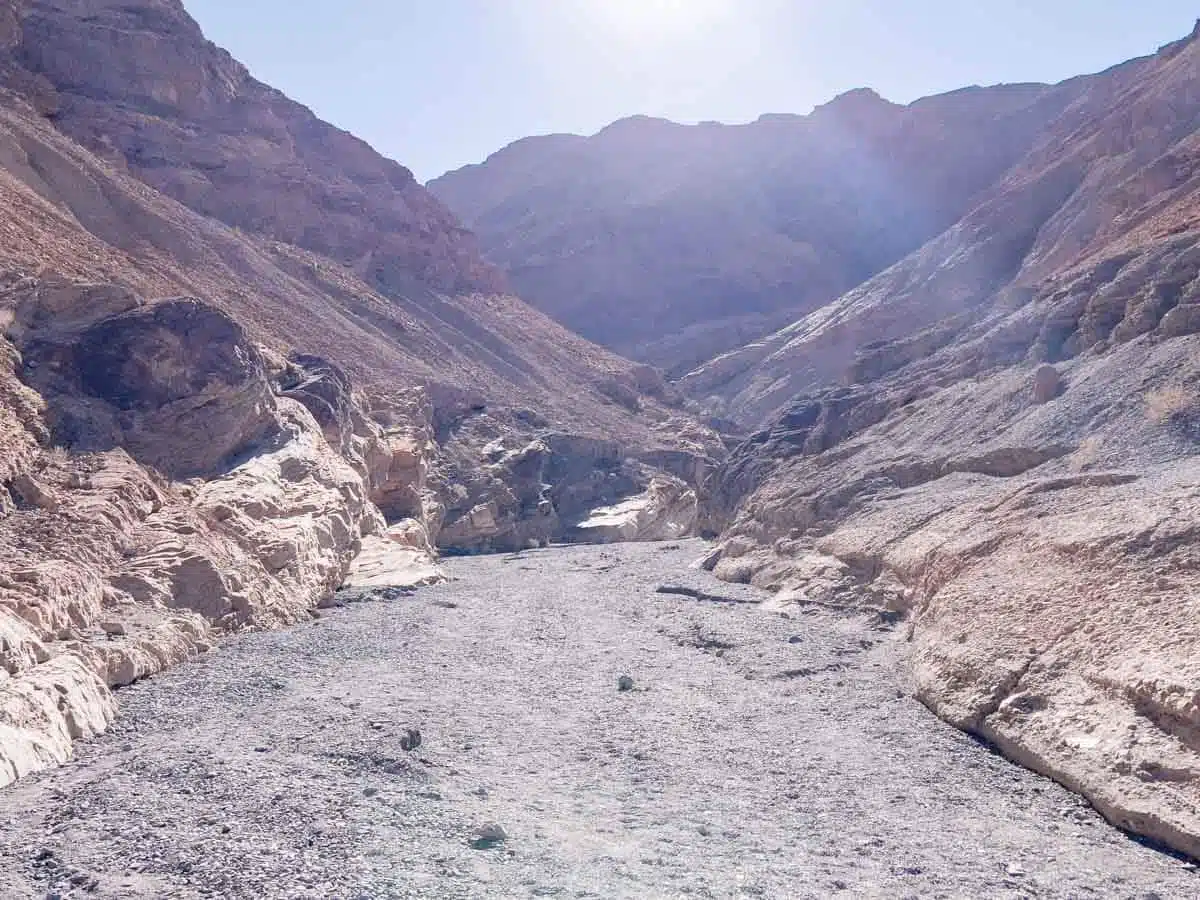
Newsflash! There are tonnes of hikes in Death Valley and tackling as many as you physically can is one of the most fun things you can do during your visit.
Don’t stress though – many of the hikes, including Mosaic Canyon are relatively easy and big enough on the wow factor to keep you distracted during the uphill stretches.
This moderate 4-mile hike takes around 2-3 hours, with plentiful snapshots of shiny slickrock and gleaming marble that give the canyon its name.
Kick things off by delving into the narrow canyon, which twists and turns before opening up into a wider plain. Safe to say that this hike isn’t short on different views and perspectives, and there’s just enough rock scrambling to keep things interesting.
See the Lee Flat Joshua Tree Forest
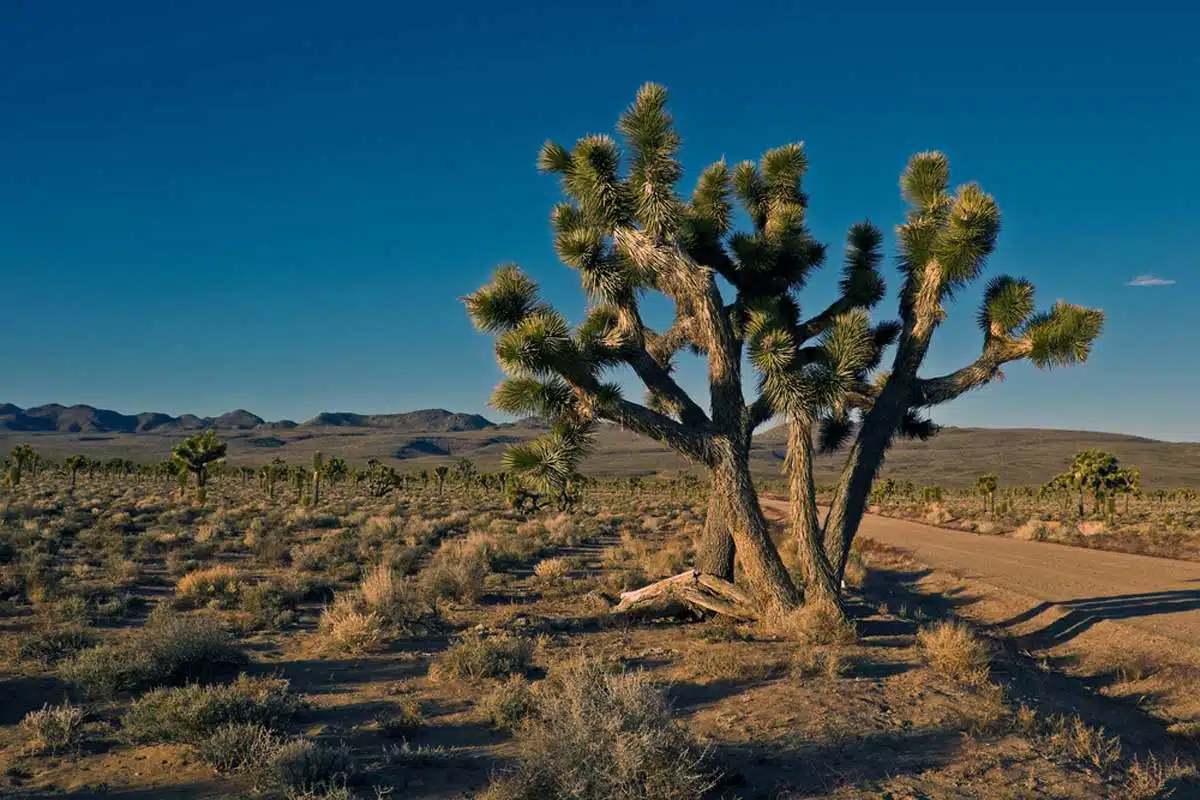
That’s right, folks — Joshua Tree National Park isn’t the only place to spot the weird and wonderful specimens of flora that are Joshua Trees.
Death Valley has its own Joshua Tree forests, the largest of which is the Lee flat Joshua Tree Forest. It’s near the western entrance to the park and sits at a higher elevation than the valley floor.
This means it has an almost completely different climate to what you find at Badwater Basin — a difference of 20°C or more in temperature between the two isn’t uncommon.
Visit at sunset, when the golden hues sweep over the brush and trees from across the purple mountains.
Set Off on the Golden Canyon and Gower Gulch Hike
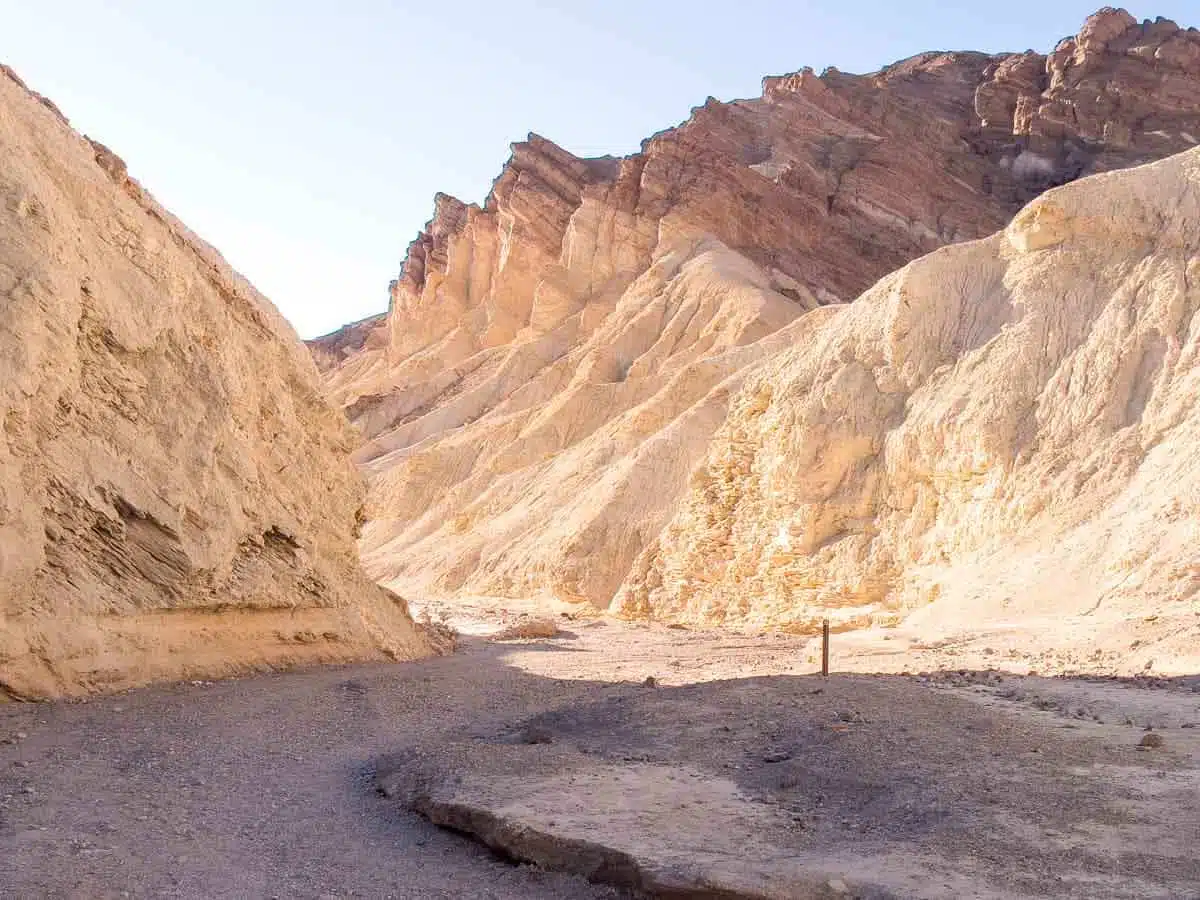
The Golden Canyon and Gower Gulch Hike is a relatively easy hike at 4.4 miles long and is a must if you’re visiting Death Valley for the first time. It’s one of my favourite easy out-and-backs in the park.
There’s only a little elevation and a bit of scrambling at the end – expect for it to take 2-3 hours in total – more if you stop to gawp at the fantastic views of the valley as I did.
The hike is named after the golden mudstone that makes up the beautiful formations that surround you during the larger part of the hike. I’m willing to bet that you’ve never seen as many shades of red and orange fanned out across one landscape.
Continue on towards Manly Beacon for the most exciting (and difficult) part of the trail, which comes with stunning views — they even rival even the grandeur of Zabriskie Point with their multicoloured formations.
Visit the Harmony Borax Works
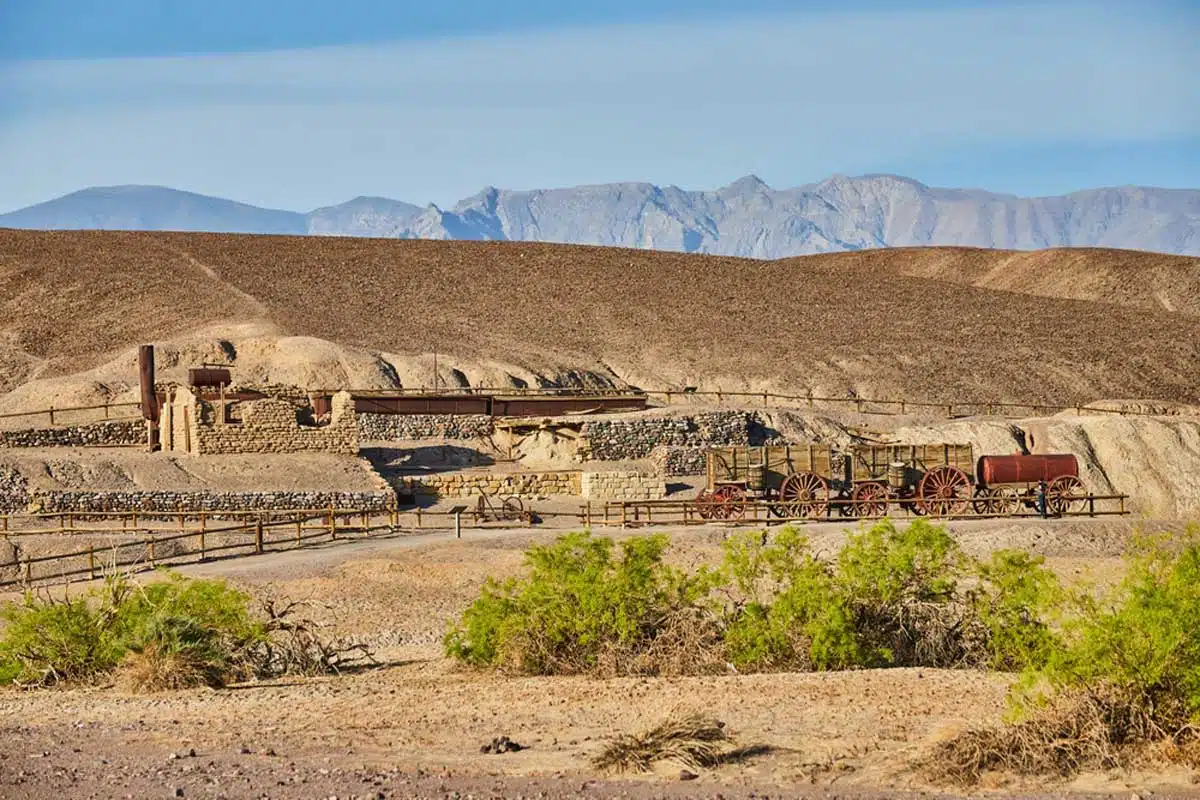
Any history buffs here? Death Valley might be best-known for its eye-popping landscapes, but dig deeper and you’ll find a rich seam of historical sights and the tales that go with them.
The Harmony Borax Works are one such place. By the late 19th century, Borax had come to be known as the “white gold of the desert” thanks to the fact that it was used in an increasing number of important products. This, in turn, kicked off a wave of prospecting in some of the country’s harshest locations – including (you guessed it) Death Valley.
Aaron Winters found borax on this site in 1881 and sold his claim to William T. Coleman, who built the Works where they refined borate-bearing mud until 1888. Although Borax was still in high demand, the difficult logistics of the site led to the works’ closure at that time.
Take a stroll around the site, taking in crumbly adobe walls, the old broiler and a couple of old wagons that have lasted the test of time, the last witnesses to a bygone era.
Cruise Along Artist’s Drive & Artist’s Palette
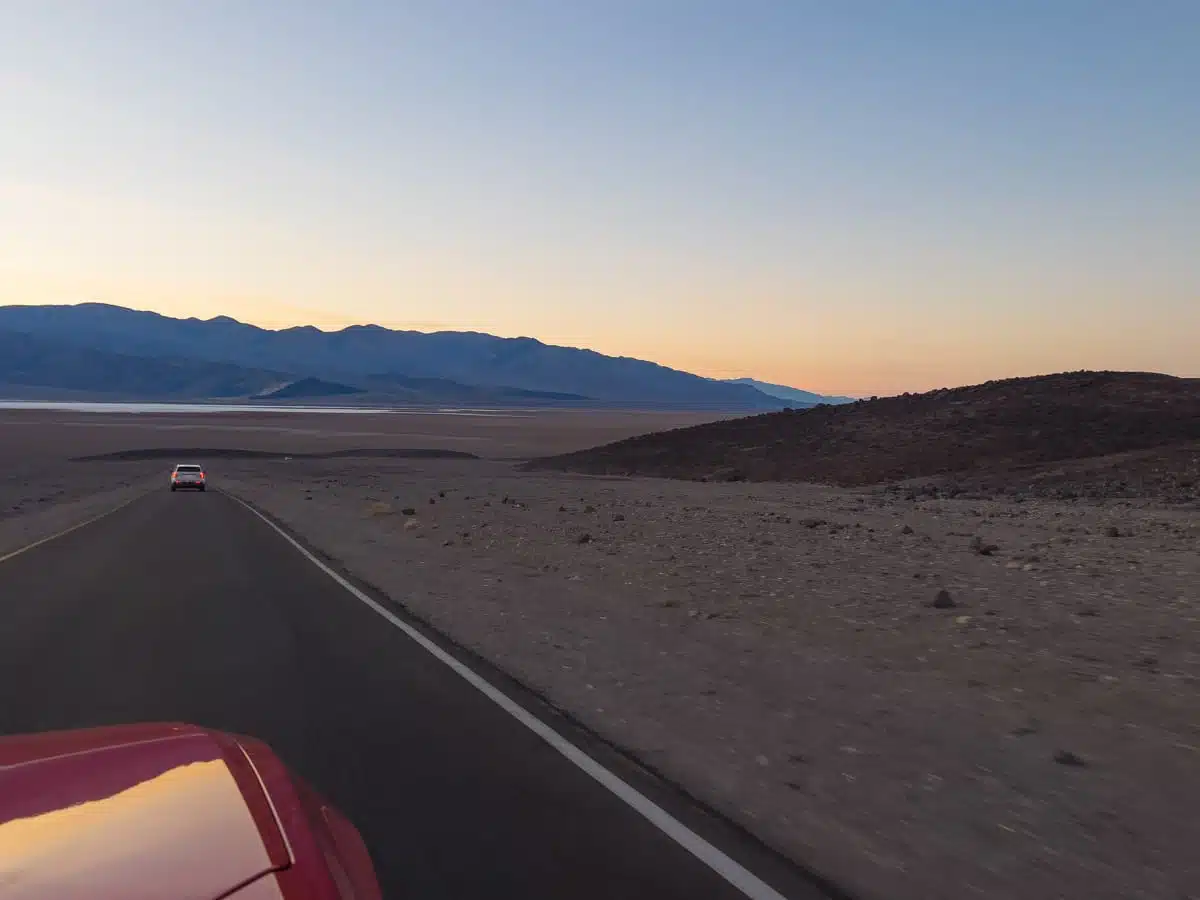
Another one of my highlights in Death Valley, Artist’s Drive is a 9-mile-long drive through some of the park’s most unique and scenic landscapes.
Although it offers plenty of spots for opportune photo-taking, stopping at Artist’s Palette is one of the best things to do in Death Valley by a long shot.
The hills change from brown and orange to a mix of pink, aqua, purple and white – the result of the oxidation of different metals in the soil. There’s a parking lot nearby, so you can ogle the gorgeous site up close.
Artist’s Drive runs from south to north and is one-way. The drive takes about half an hour without stops but factor in more time to be able to get out and explore.
Hike to Natural Bridge
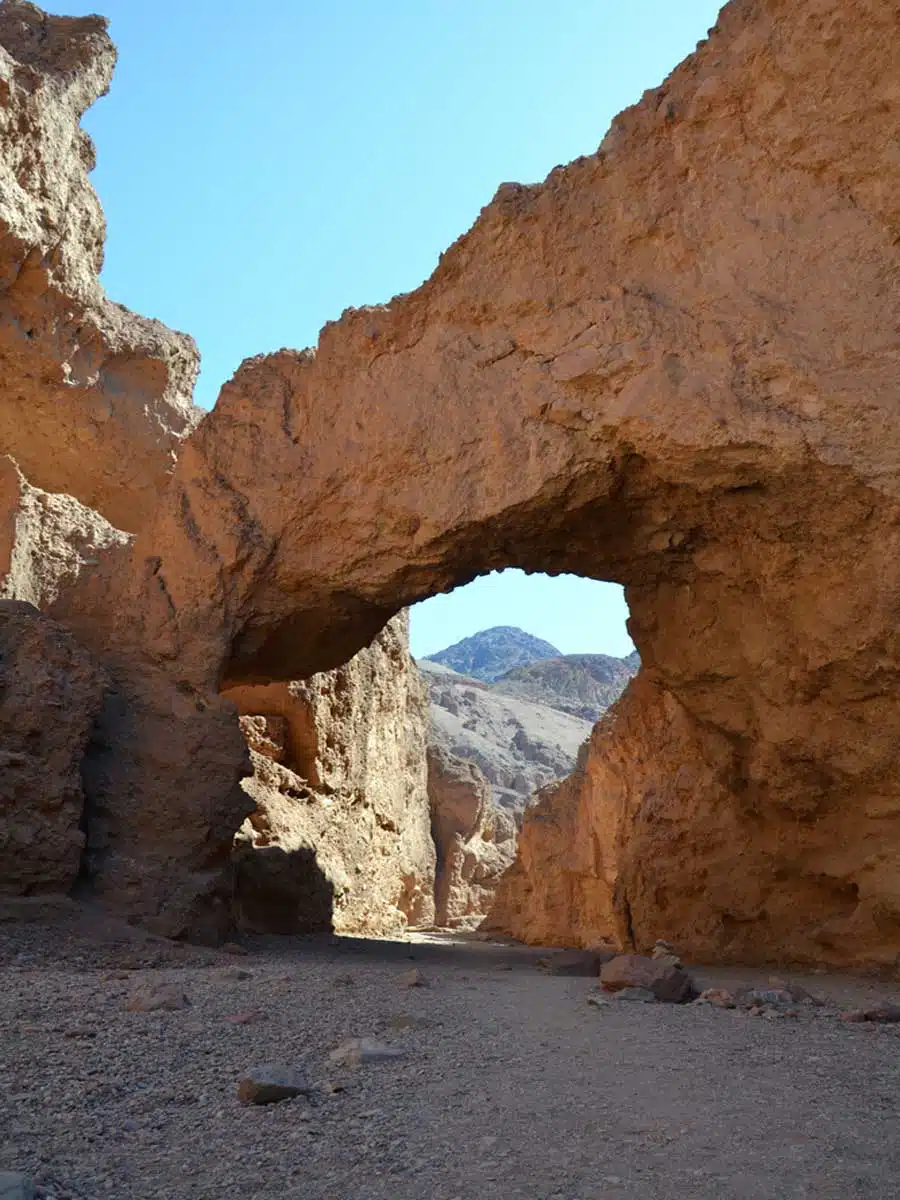
Make time to hike out to Natural Bridge – one of the many unique geological features within the park. It’s not far from Badwater Basin and is only about half a mile from the parking area.
The hike is fairly easy and takes about an hour. I won’t lie, as the actual hike goes, it’s not one of the most exciting in the park, but it’s worth it to see the Natural Bridge.
This isn’t a hike to tackle midday, though — early morning or late in the afternoon is better to avoid being in direct sun for the entire trek.
Getting There
Head south on Badwater Road from Furnace Creek. The well-marked turnoff to the trailhead on Natural Bridge Road is about 13 miles along. The bridge is 0.5 miles along an easy path from the trailhead.
Take the Twenty Mule Team Canyon Road Scenic Drive
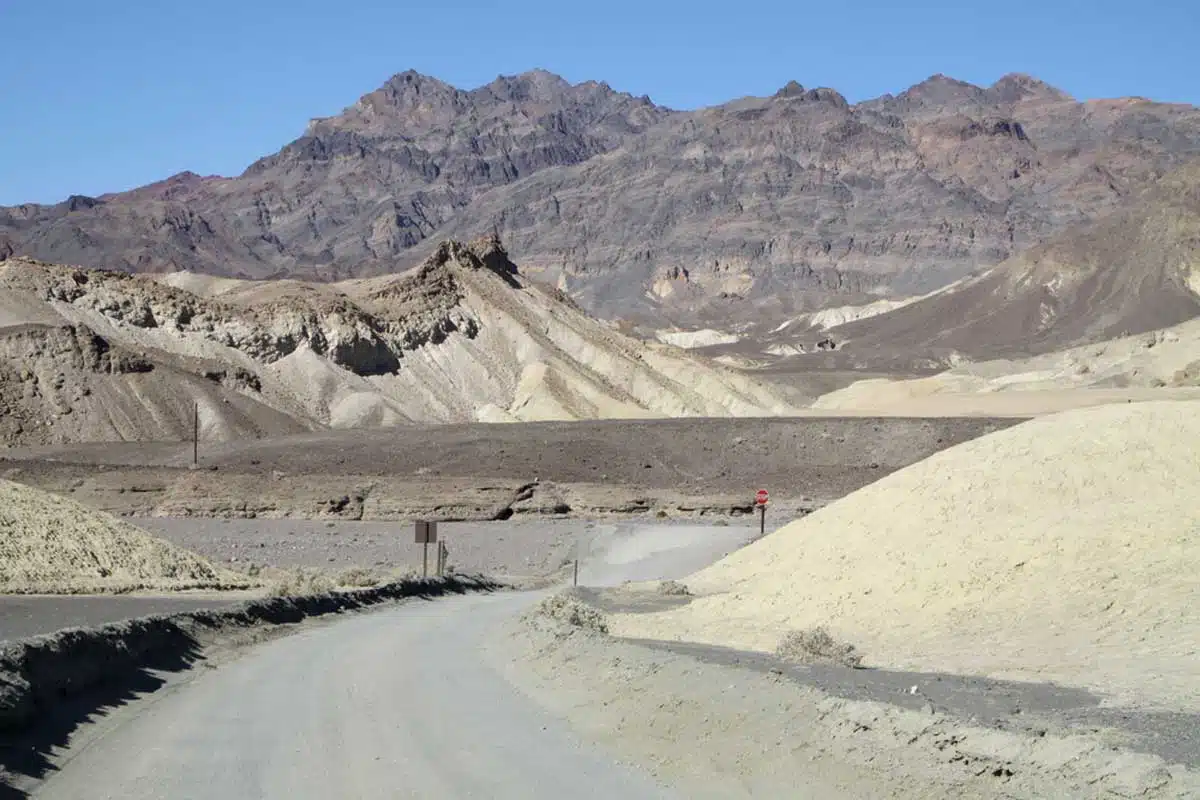
A one-way road through white and yellow mudstone hills, you might think a 30-45 minute drive through Twenty Mule Team Canyon could be a bore.
But the landscapes it offers are incredible! No desert brush obscures the gorgeous rock formations here.
Many small hiking trails splinter off the road, so you can park up and tackle those you fancy for even more epic views of the wind-carved mudstone from the top.
Go Stargazing
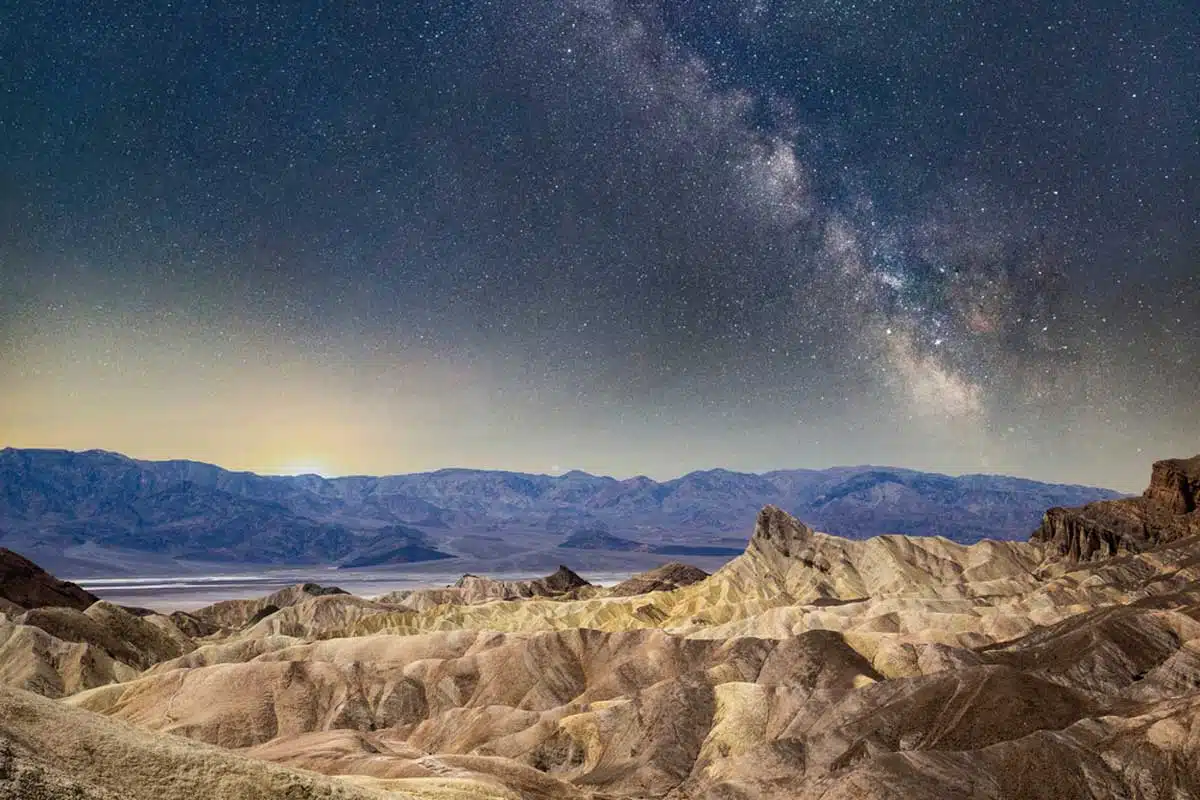
Death Valley has been designated as a Gold Tier International Dark Sky Park, meaning it’s one of the top places for stargazing, not only in the United States , but in the world.
It’s no secret how much I love watching the wonder of the night skies and the nights I spent stargazing in the park were unforgettable.
You can’t really go wrong with locations – if you can see a large stretch of sky, chances are it will be a good place. That said, Badwater Basin, Mesquite Flat Sand Dunes and the Harmony Borax Works are all great choices. Bring your camera for epic nighttime Milky Way photography.
The park often hosts star parties during the winter months, where rangers and astronomers guide visitors through the wonders of the night sky via telescope viewings, guided walks and talks. Check the park’s calendar for upcoming events.
See Darwin Falls
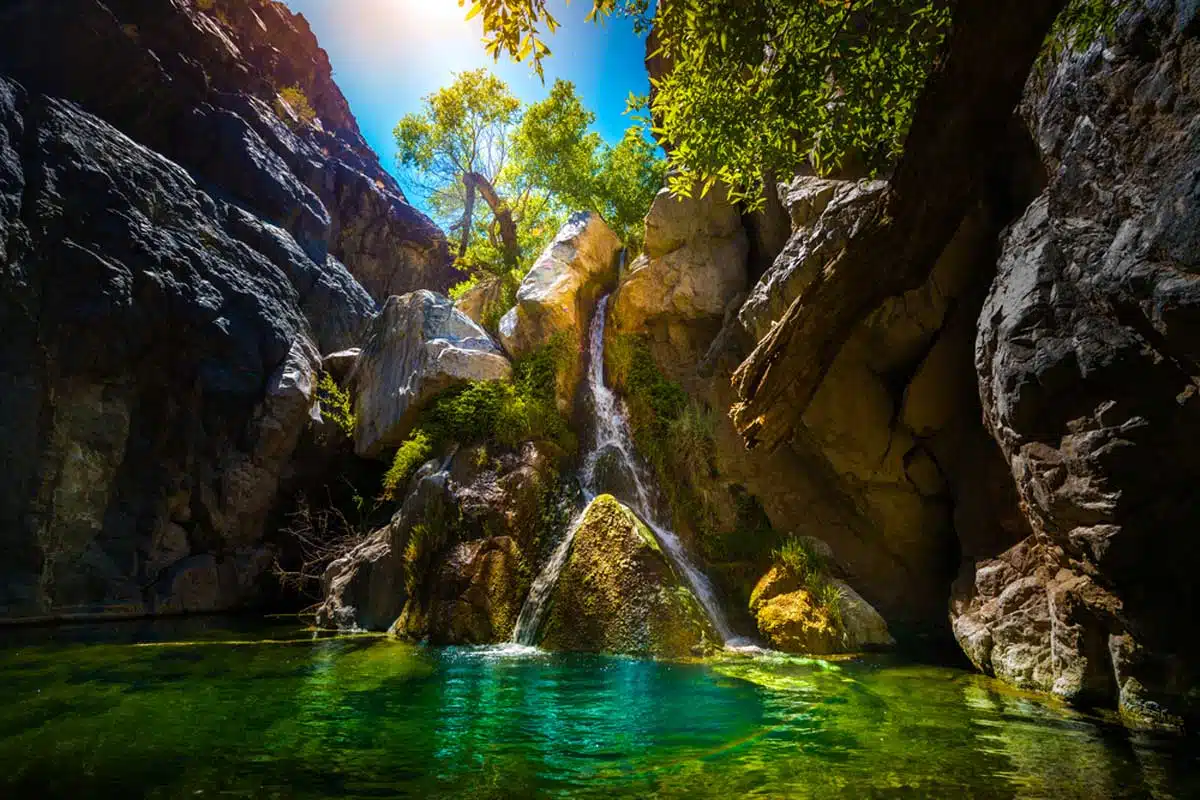
Believe it or not, Death Valley National Park, one of the hottest places on Earth, has a year-round waterfall, Darwin Falls.
That fact alone makes Darwin Falls a must-see spot. Sure, you’ll have to hike along a trail to find it… one so dry that you might doubt that it exists at all, but eventually, you’ll see a small creek complete with dragonflies and frogs croaking.
That’s the first sign of what’s to come – an unlikely waterfall surrounded by greenery that wouldn’t look out of place in the Amazon. Unsurprisingly, it’s a hub of biodiversity in the park, with plants and animals not found elsewhere in Death Valley, surrounded by willows and cottonwoods.
While most visitors make it to the Lower Falls and leave it at that, you can also hike to the Upper Falls. It’s a bit more challenging but is also a lot more secluded.
It’s an easy 2-mile (3.2km) round trip hike from the Darwin Falls parking area. Wear sturdy footwear as the trail is quite rocky.
Take a Trip to The Eureka Dunes
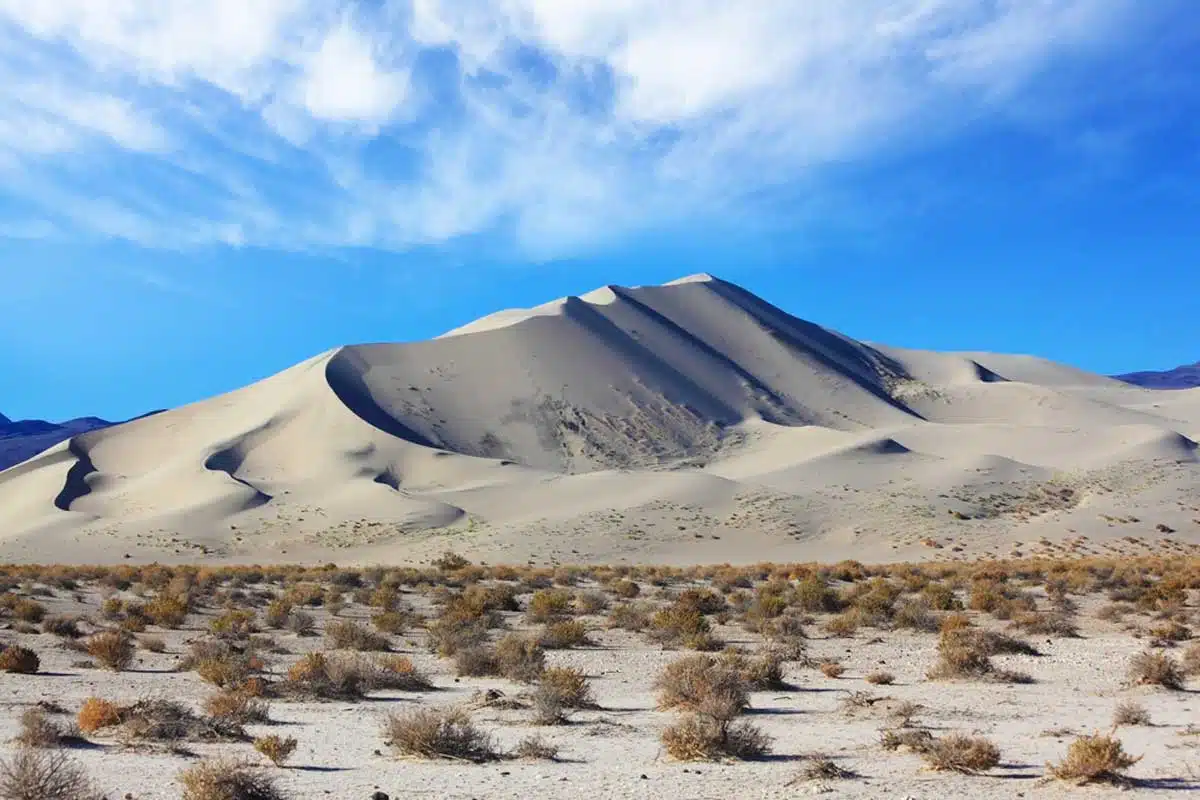
I know I talked about the Mesquite Flat Sand dunes earlier in this guide, but you should also make time to see their quieter counterparts, The Eureka Dunes.
The Eureka Dunes are more remote, but IMHO they’re the most beautiful dune field in Death Valley.
Located at an elevation of 914-metres, they’re the tallest dunes in California, framed by the stunning backdrop of the Last Chance Mountains.
The most curious thing about them though? They sing.
Yes. The dunes sing . It may not be the latest Taylor Swift hit, but under the right conditions, they sound out with a bass reverberation similar to a pipe organ emanating from under your feet. Who wouldn’t want to experience this baffling phenomenon that has scientists scratching their heads?
Prepare yourself for some challenging climbing when you visit Eureka Dunes – they’re tall and climbing them is a mean task. Bring lots of water, wear a hat and pile on the sunscreen.
See the Skidding Stones at Racetrack Playa
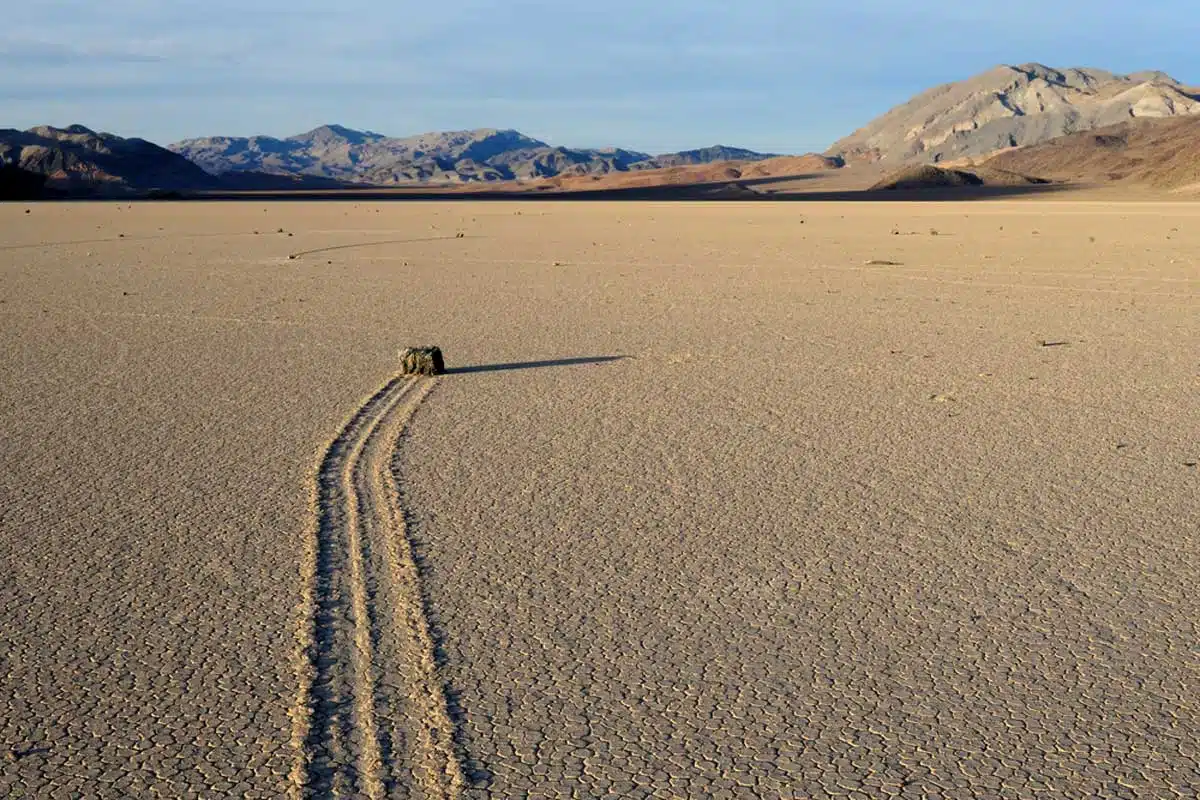
I think that by now we’ve established that Death Valley has more than its fair share of slightly… bizarre places, but Dunetrack Playa is up there with the best.
Perhaps you’ve heard of them — the mysterious large rocks that seem to glide across a dry lakebed, leaving enigmatic trails behind them though no one ever sees them move.
They’re called the sailing stones and how they manage to move was kind of a mystery. Scientists have been studying them since the early 1900s to figure out this phenomenon, and it seems that in 2014 they finally sorted it out, attributing the movement of the stones to a unique interplay between ice, water and wind.
Driving the 27 miles over the unpaved road in a high-clearance 4×4 is a small price to pay to see the Racetrack and its slow-motion racers.
The playa surface is fragile, so stick to the roads and don’t touch the stones. Also, bring a spare tyre or two just in case — that road can be brutal.
Do the Grotto Canyon Hike
The Grotto Canyon hike is a 2 – 4 mile round trip hike that you should try if you like a challenge.
It’s a quiet trail that navigates through narrow canyons and will have you scrambling over difficult obstacles. The first half of the hike sees you through a canyon, climbing over some tricky rock sections.
About halfway, you’ll hit a 2.4-metre chimney — it’s the “ oh hell no ” point of return for many hikers. But if your legs are up to the climb, give it a go and complete the hike.
See The Charcoal Kilns
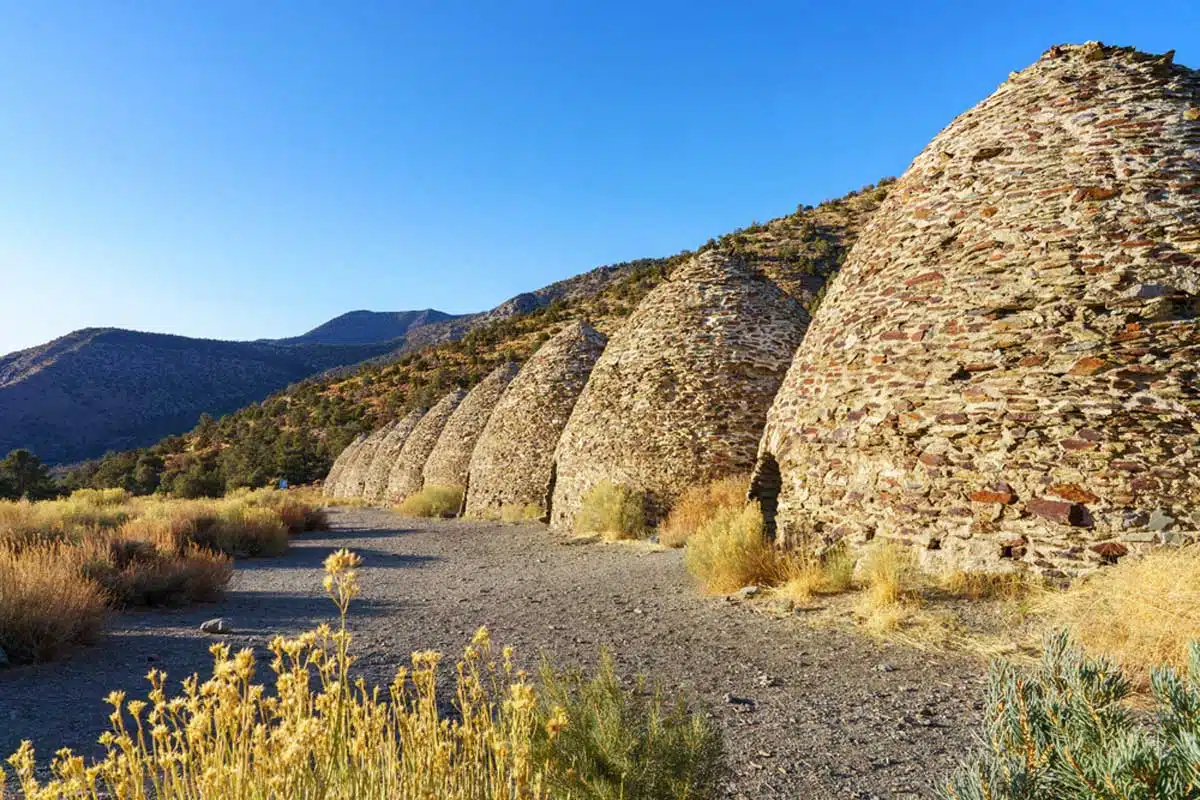
One of the more unusual things to do in Death Valley is to visit the charcoal kilns.
The kilns’ interesting conical beehive appearance with bits of dry scrub surrounding them gives off the vibe of a quirky abandoned village. They were in use back when the park was a mining hotspot to create charcoal.
You can find the Charcoal Kilns in the Wildrose section of Death Valley, but beware: the road to the kilns is bad, so a high-clearance or a 4WD vehicle is necessary to reach them.
Head Out to the The Ibex Dunes
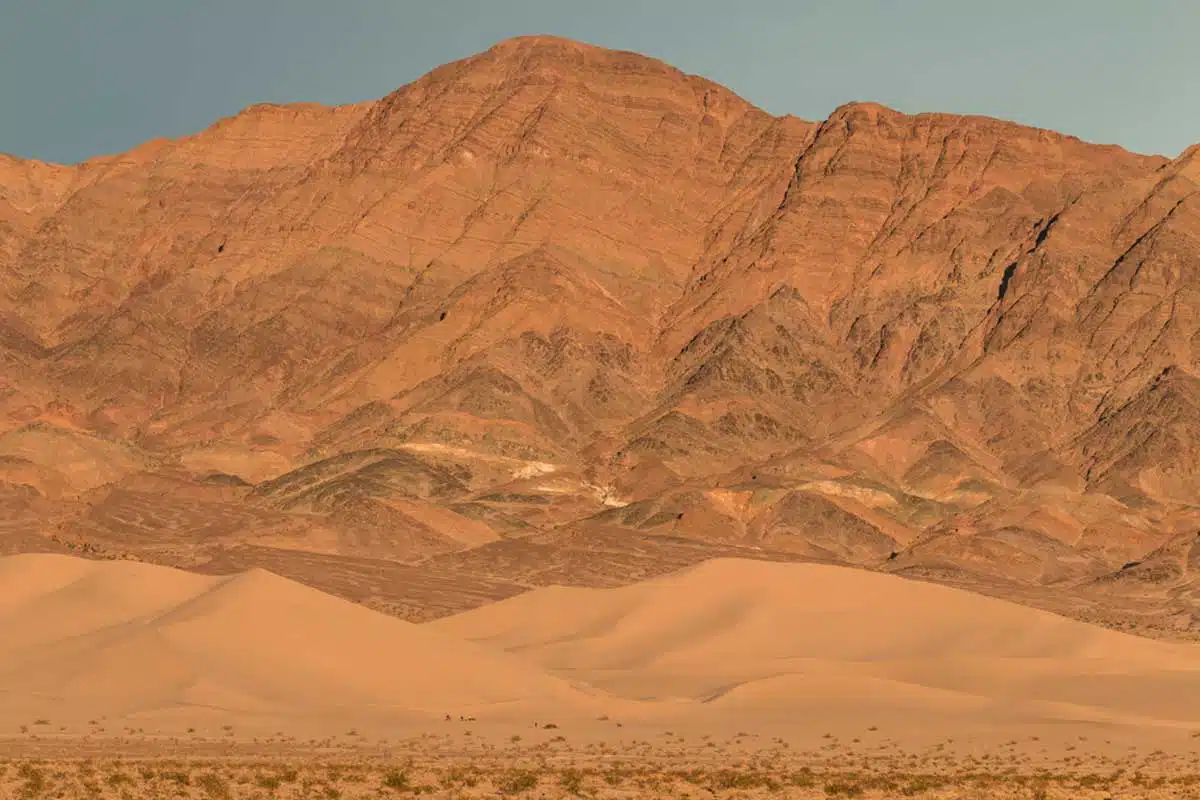
The Ibex Dunes are pretty remote, making them ideal for photography enthusiasts. It helps that they’re naturally superbly photogenic, too.
There’s an abandoned mine on the far side of the dunes by the mountain, an eerie reminder of days gone past and a great photo spot.
Heading out on the high-clearance road to explore the isolated dunes is one of the cool things to do in Death Valley, but do it early in the day. Even in winter, it gets hot quickly out there, and you wouldn’t want to end up in a dangerous situation.
Practical Tips for Your Death Valley Trip
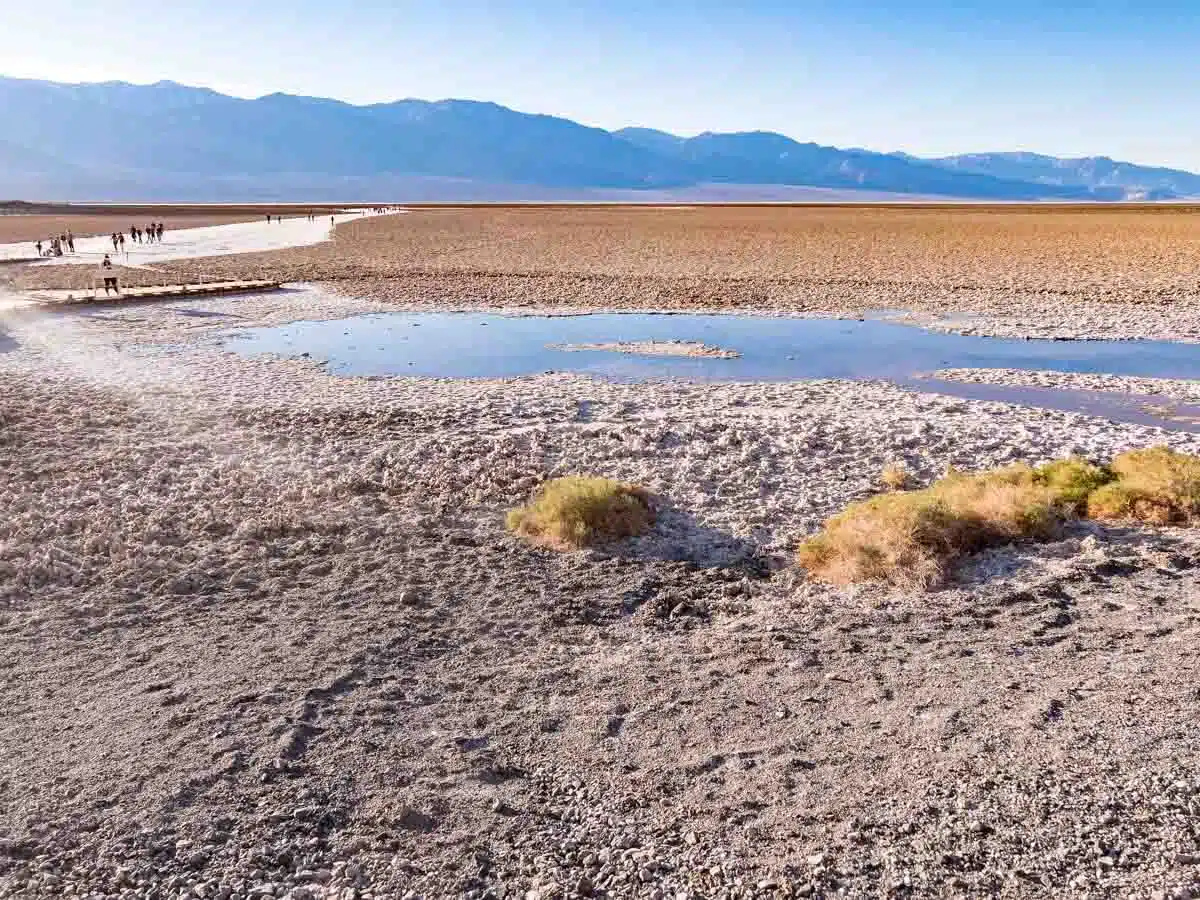
A standard entrance pass for a car to the park is $30 and is valid for a seven day period. Passes can be purchased from several locations in the park, including the Furnace Creek Visitor Center.
More than other places in the US, a little bit of planning goes a long way in Death Valley National Park.
The park’s main hotel, the Inn at Death Valley, books up well in advance, as do other hotels in the surrounding areas.
Then there’s the flooding and access. The park’s unique geography can lead to sudden and intense flash floods which can cause extensive damage to roads and landscapes – as illustrated in summer 2023 and the ensuing chaos of Burning Man.
Be very cautious if you’re visiting the park during a rainfall – even if you’re not, ensure you’re up to date with the current situation via the National Park Service’s website.
Other Top Tips for Your Visit
- There’s little to no mobile reception across most of the park. Buy a paper map or use the free map from the Visitor Center and ensure you let someone know your plans before heading to a remote area.
- Ensure you’ve filled up your tank prior to going into the park and keep a close eye on gas levels as you drive around. There are two gas stations – at Stovepipe Wells and Furnace Creek but both are more expensive than those in the surrounding areas.
- Sun protection is key – wear light, loose-fitting clothes to help keep you cool during the day.
- Stay hydrated – 4-8 litres per person per day is recommended thanks to the dry desert air and high temperatures.
- Stay on designated paths and preserve the park’s delicate ecosystem. It also helps you steer clear of hazards like old mines and unstable ground.
How Long Should I Spend Visiting Death Valley National Park?
While it’s possible to see Death Valley’s highlights in one day, it will be a rush. Plan to spend two to four days to see the park’s main sights at your leisure – or even a week if you want to include lots of hikes.
Best Time to Visit
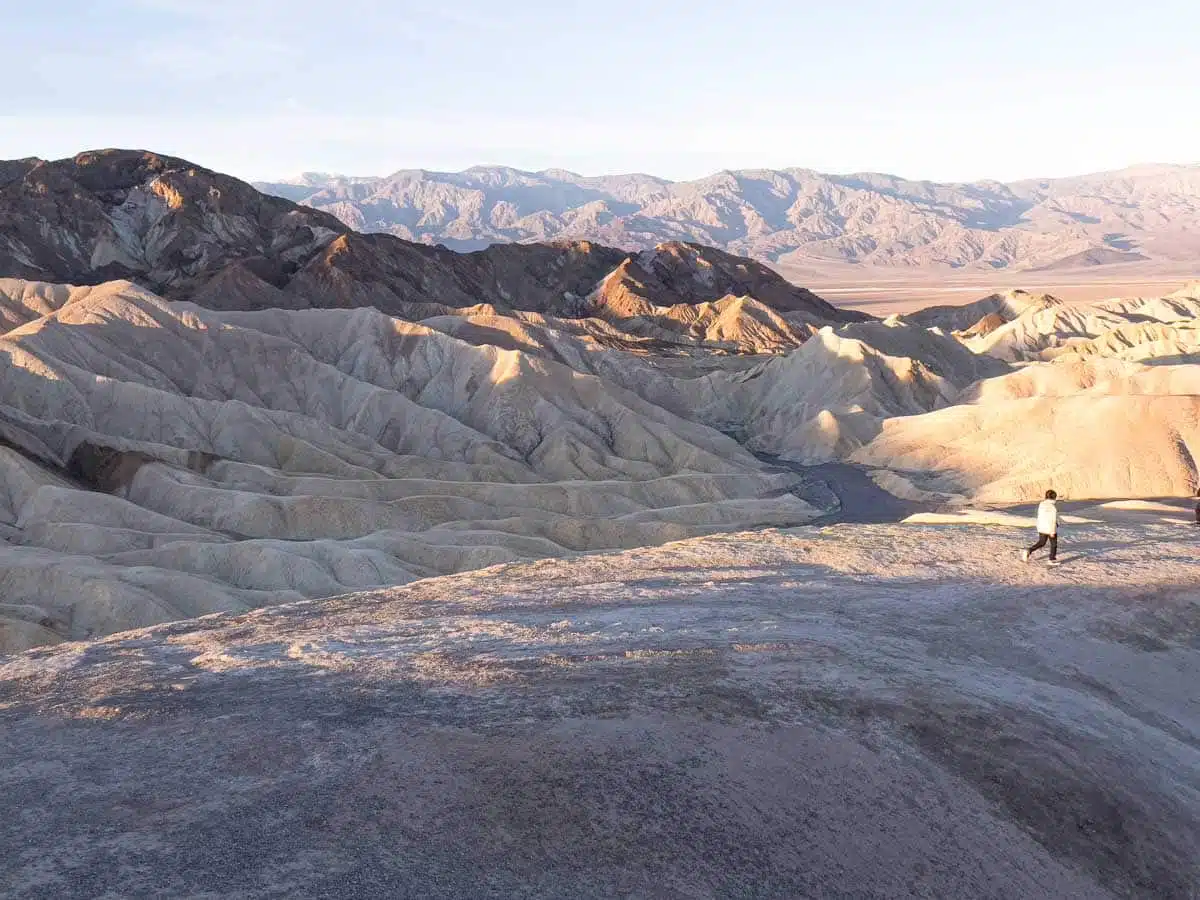
The best time to visit the valley is undoubtedly in spring, from March to May when days are warm and sunny but steer away from the unbearable temperatures of mid-summer. It’s also the most popular time, so don’t be surprised if many of the most popular spots are a bit busy.
Spring is also when the wildflower blooms take place – peak blooming time is late March to early April.
Where Should I Stay in Death Valley?
Holiday Inn Express & Suites (Mid-Range)
Although it’s not in Death Valley, the Holiday Inn in Pahrump is an unremarkable, if decent mid-range option with crisp modern rooms. It’s the best-value option near the park, which is only 24 miles away.
Check Rates and Availability for Holiday Inn Express & Suites on Booking.com
The Inn at Death Valley (Luxury)
Located inside Death Valley National Park, this luxurious hotel has all the trimmings. It is a beautiful place and offers a sauna, outdoor pool, bar and air-conditioning in the rooms. With uber-comfy beds and lush lawns and palms before the mountainous backdrop, you won’t want to leave.
Check Rates and Availability for The Inn at Death Valley on Booking.com
Recommended Tours
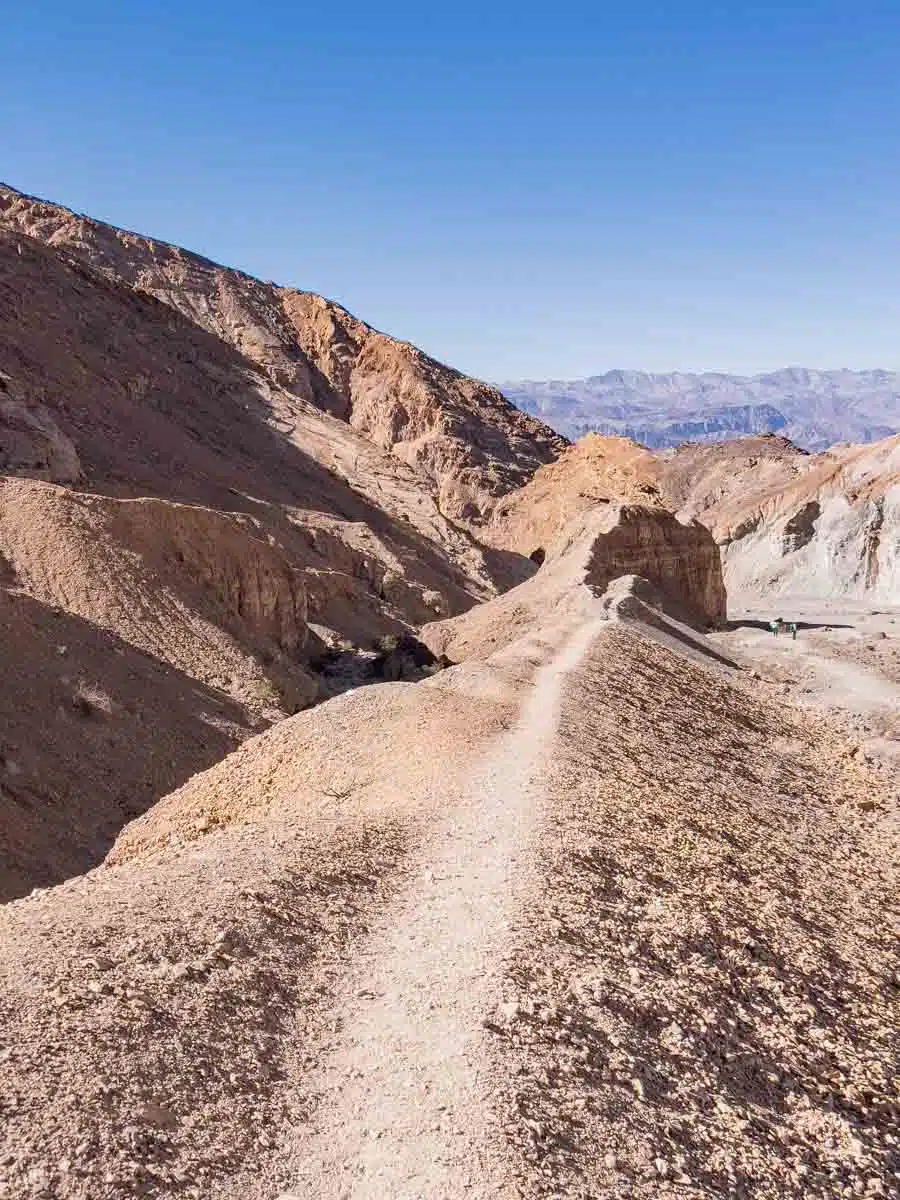
Things to Do in Death Valley: Map
Read More Death Valley National Park Guides
- 3 Days in Death Valley National Park Itinerary
- Where to Stay in Death Valley, Area by Area
- When’s the Best Time to Visit Death Valley National Park?
- Stunning Hikes in Death Valley You Have to Try
- Where to Catch Epic Sunrises and Sunsets in Death Valley National Park
Love This? Save and Share on Pinterest
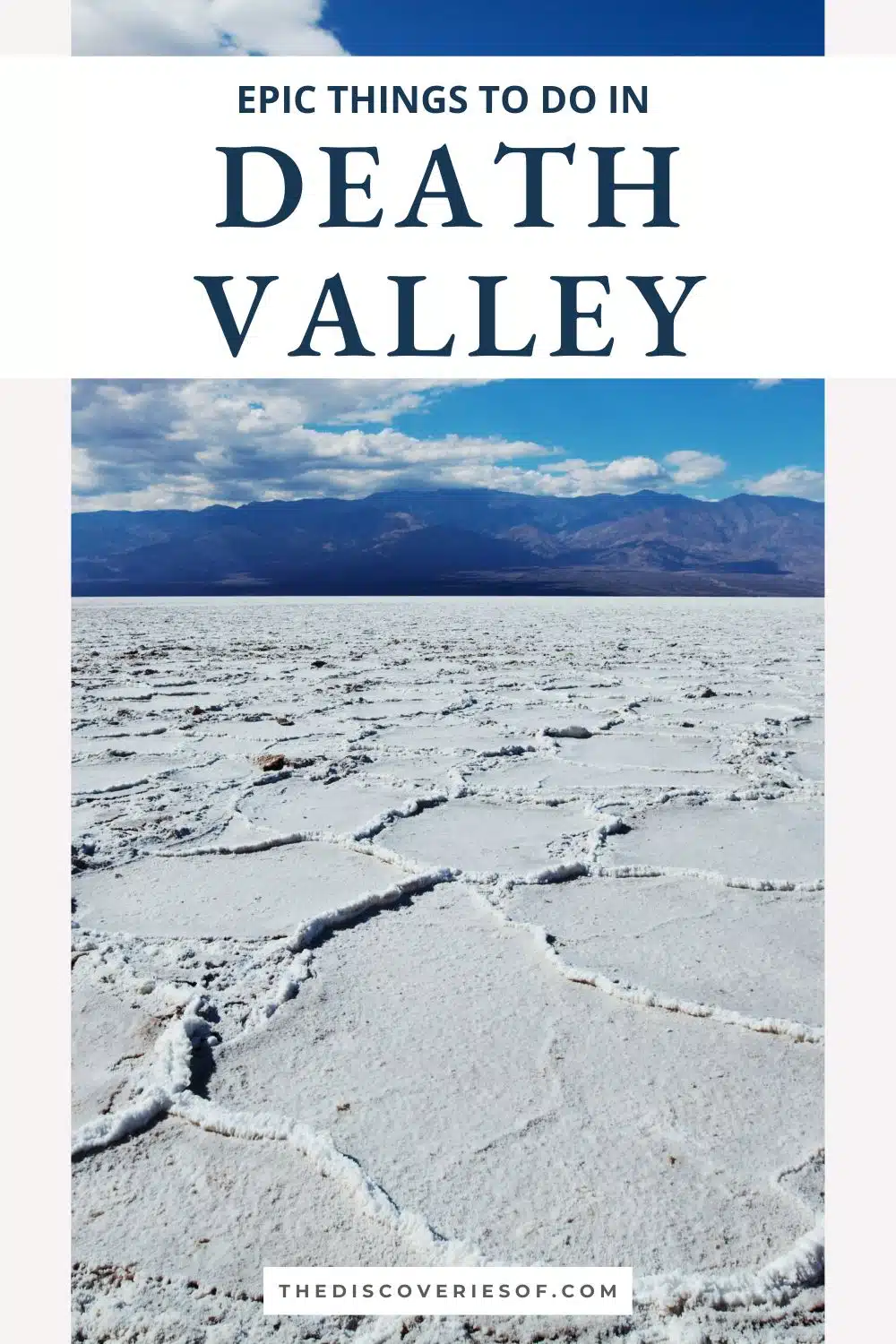
I’m Julianna Barnaby - a professional travel writer and geek extraordinaire. I started The Discoveries Of to help you to discover the best of new destinations from around the world.
Discovering new places is a thrill - whether it’s close to home, a new country or continent, I write to help you explore more and explore differently.
Related Posts
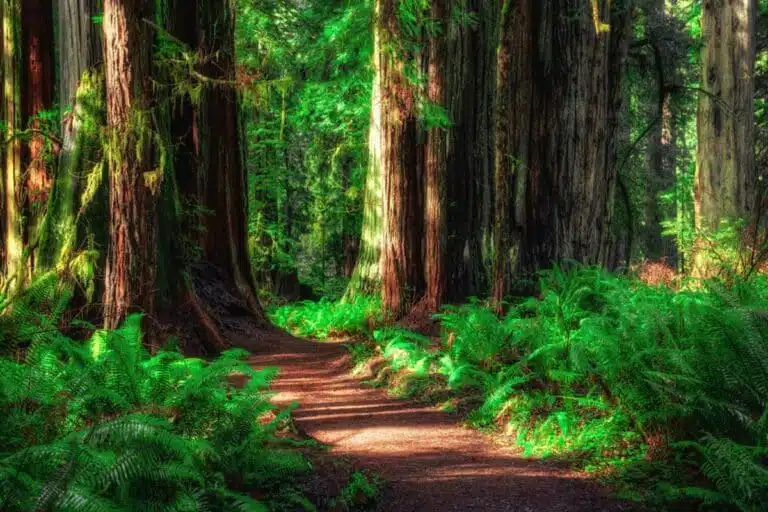
The Best Things to Do in Redwood National Park, From Camping to Hiking
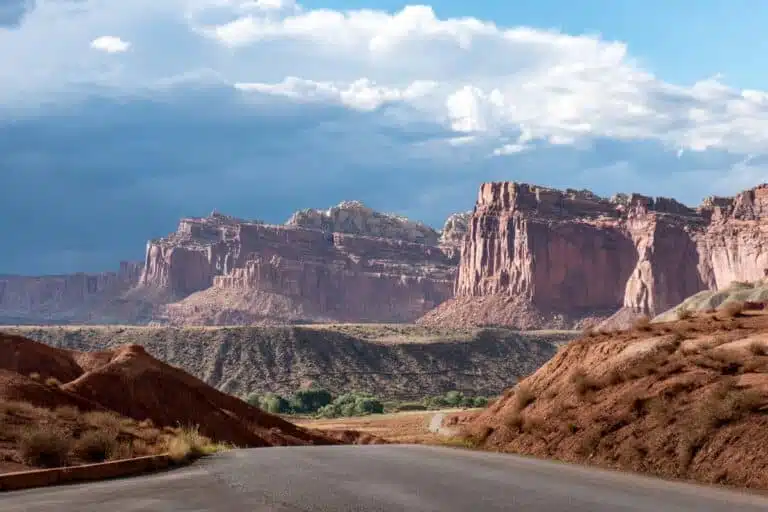
15 Things to Do in Capitol Reef National Park I Explore Utah’s Less-Visited National Park
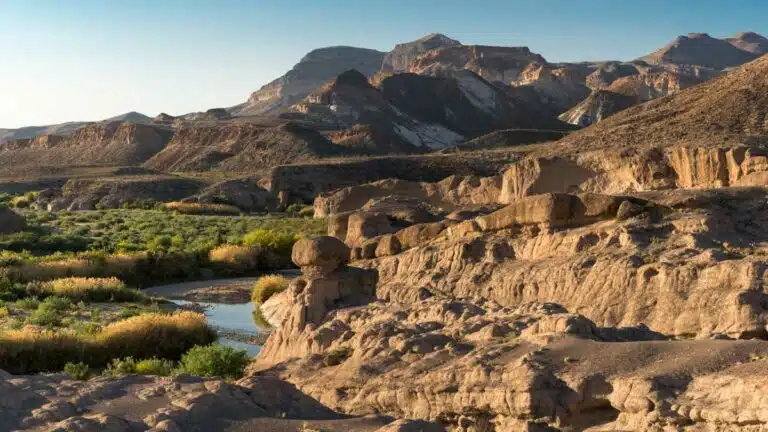
9 Unusual Places to Visit in West Texas You Didn’t Know Existed
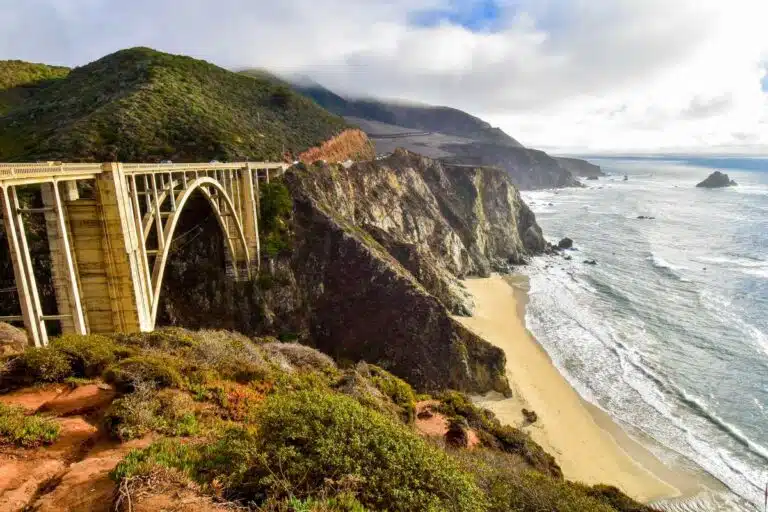
The Best Things to do in Big Sur: Explore California’s Rugged Coastline

Follow me on Instagram for travel inspiration, tips, and guides.

20 Great Things to do in Death Valley National Park
D eath Valley National Park is a captivating desert landscape brimming with intriguing geological formations, challenging hiking trails, and awe-inspiring vistas just waiting to be discovered. From the mesmerizing Mesquite Flat Sand Dunes to the otherworldly Artist’s Palette, there are countless things to do in Death Valley , must-see attractions and activities that will make your trip unforgettable.
Whether you are planning a long weekend or a short day trip from Las Vegas there is plenty to see and do. So grab your adventure hat and get ready to embark on a thrilling journey through our top 20 must-see attractions and activities in Death Valley.
Where is Death Valley?
Death Valley is located in Eastern California, in the northern Mojave Desert, bordering the Great Basin Desert. It is considered to be one of the hottest places on Earth during the summer months.
The Ultimate Guide To Exploring Death Valley: Top Things to Do in Death Valley
Discover the top 20 must-see attractions and activities in Death Valley National Park, experience hiking Eureka Dunes, witnessing the mysterious Racetrack Playa Rocks, and taking in the sunrise at Zabriskie Point plus many many more!
Take A Scenic Drive
One of the best ways to explore Death Valley National Park is by taking a scenic drive. With its diverse landscapes and breathtaking views, this park offers visitors plenty of opportunities for an unforgettable road trip experience. Whether you’re looking to see towering mountain peaks or colorful sand dunes, there’s something for everyone on these drives.
Some popular options include the Artist’s Drive, where you can marvel at the kaleidoscopic colors of the mountainside, or the Panamint Valley Road that winds through a dramatic canyon and features stunning desert wildflowers in springtime. No matter which route you choose, be sure to bring your camera because these vistas are Instagram-worthy!
Another option is to head out on one of the park’s famous “scenic loops,” such as Titus Canyon Road or Dante’s View Drive. These routes will take you through some of Death Valley’s most iconic landscapes and provide ample opportunity for wildlife spotting and birdwatching along the way. So pack a picnic lunch, load up your car (or rent one), and hit the road – adventure awaits!
Explore Badwater Basin
Begin your ultimate Death Valley National Park adventure by exploring the fascinating Badwater Basin. As one of the top attractions in the park, this unique destination offers visitors an unforgettable experience.
Badwater Basin is the lowest point in North America. At 282 feet below sea level, Badwater Basin boasts a surreal landscape of salt flats. The seemingly endless expanse of white salt flats creates a striking contrast against the surrounding mountains and deep blue sky – perfect for awe-inspiring photos.
For those seeking more adventure, tackle the Badwater Salt Flats Trail. This 5-mile round trip hike showcases exceptional views of Death Valley and its surrounding mountains.
Just a short distance away from Badwater Basin lies a small oasis where seasonal waters create a temporary natural pool – ideal for a refreshing break (and one of the best things to do in the hotter months).
Hike Eureka Dunes
If you’re an adventurous hiker looking for a challenging yet breathtaking experience in Death Valley National Park, hiking the Eureka Dunes should be at the top of your list. Often considered the tallest sand dunes in North America, these incredible mounds of sand rise to heights of nearly 700 feet, offering unmatched views of the surrounding desert landscape.
The journey to explore Eureka Dunes spans across a 14-mile long trail that takes around seven hours to complete, making it ideal for only experienced hikers who are equipped with proper gear and determination. This trail will have you conquer a whopping elevation gain of 3,000 feet as you trek through unspoiled beauty and remote wilderness areas.
During your hike, take solace under vast blue skies while marveling at contrasting wildflowers or listen for booming sounds created by sliding sands echoing off nearby mountains. After conquering this formidable hike, reward yourself with panoramic vistas from atop these magnificent tall sand dunes – an unforgettable memory etched into your Death Valley National Park experience.
See Zabriskie Point At Sunrise
Watching the sunrise from Zabriskie Point is a must-do activity when exploring Death Valley National Park. The golden glow of the morning sun casts a beautiful light over the surrounding terrain, making it an ideal time to take photos.
From Zabriskie Point, you can enjoy stunning views of the Panamint Range and the park’s badlands. The geological formations surrounding Zabriskie Point were carved out of unique materials that cannot be found anywhere else in the world.
Witness The Mysterious Racetrack Playa Rocks
One of the most mysterious and fascinating natural wonders in Death Valley National Park is the Racetrack Playa Rocks. These rocks seem to move mysteriously on their own accord across this remote valley.
Despite numerous scientific explanations for this phenomenon, mystery fans still find it incredible that these rocks can slide across a dry lakebed leaving trails behind them. To witness these sliding rocks in action, visitors can drive to Racetrack Playa and observe them themselves.
Kaleidoscopic Cliffs At Artists Palette
The eroded cliffs at Artists Palette were featured in the iconic opening scene of Star Wars Episode IV: A New Hope. The hillside is painted with a mosaic of red, gold, black, and green hues. The vibrant colors are the result of different minerals that oxidized over time.
Artists Palette is located conveniently on the scenic drive between Furnace Creek and Badwater Basin. Visitors can stop at several viewpoints along the road to take pictures.
The area also offers hiking trails and picnic areas for those who want to explore further. The best time to visit is during sunrise or sunset when the light enhances the colors even more.
Play In Mesquite Flat Sand Dunes
The Mesquite Flat Sand Dunes are an absolute must-visit destination in Death Valley National Park. These unique sand dunes offer a fun outdoor playground for both adults and children, with three types of dunes to explore: star, crescent, and linear.
For a more immersive experience, try hiking through the dunes or renting sand boards for some sledding down the sandy slopes. You can spend hours exploring this natural wonderland, admiring the delicate balance between nature’s elements that create such beauty in these mesmeric desert formations.
The ripples and edges in the dunes stand out in greater contrast during sunrise and sunset.
Discover The Lee Flat Joshua Tree Forest
If you’re looking for a mesmerizingly scenic spot in Death Valley National Park, the Lee Flat Joshua Tree Forest is an absolute must-visit. The Lee Flat Joshua Tree Forest is located in a remote area of Death Valley, about 30 miles from Panamint Springs.
The forest is home to a cluster of Joshua trees that stand tall and proud against the stark desert landscape. These trees are unique to the Mojave Desert and can live for hundreds of years, making them an important part of California’s natural heritage.
Visitors can drive or hike through the forest, taking in views of the surrounding mountains and valleys. If you’re in the area at night, be sure to stargaze – Death Valley has some of the darkest skies in North America.
Gaze Upon Ubehebe Crater
One of the most breathtaking attractions in Death Valley National Park is Ubehebe Crater. This natural wonder is a testament to the park’s unique geology, with its volcanic origins and dramatic erosion over time. From the rim of this massive crater, visitors can gaze upon an expansive view that stretches across miles of desert landscape.
To explore Ubehebe Crater more closely, many hikers take on the challenging but rewarding rim trail. This path winds through rocky terrain and offers stunning views from various vantage points along the way. For those looking for an even more immersive experience, hiking down into Ubehebe Crater provides a fascinating look at its multicolored walls up close.
No matter how you choose to see it, Ubehebe Crater is sure to leave a lasting impression on any visitor to Death Valley National Park. Its awe-inspiring size and striking beauty make it one of the top must-see attractions in this incredible destination.
See Darwin Falls
One experience you don’t want to miss while visiting Death Valley National Park is to take a scenic hike to see the beautiful Darwin Falls, one of the few water sources in Death Valley National Park.
It’s a 20-foot waterfall located in Death Valley National Park that provides a green oasis in the midst of the arid climate. The view from Darwin Falls overlook includes the Owlshead Mountains, Funeral Mountains, Panamint Range, and Green.
To get to Darwin Falls, you can take a hiking trail that’s accessible to most visitors.
Sunrise At Aguereberry Point
Watching the sunrise at Aguereberry Point is a surreal and breathtaking experience that should be on every Death Valley traveler’s bucket list. Located in the western part of the park, this viewpoint offers visitors stunning panoramic views of the surrounding mountains and valleys.
To fully enjoy your experience at Aguereberry Point, arrive early enough to secure your spot as it can get crowded during peak season. You’ll want to bring water and snacks as well since there are no food options nearby. Additionally, don’t forget your camera! The palette of colors that fill up the sky during sunrise makes for an incredible photo opportunity.
Play A Round At Devils Golf Course
Devil’s Golf Course is an iconic and unique feature of Death Valley National Park that attracts tourists from around the world. This jagged rock formation offers a challenging and entertaining round of golf in a breathtaking setting.
The natural wonder of the rocks and geological formations surrounding the golf course provide spectacular views that will leave you awestruck. Playing a round at Devil’s Golf Course is an outdoor recreational activity in Death Valley National Park that combines fun, adventure, and wildlife all in one experience.
Whether you’re an avid golfer or just looking for an entertaining way to spend your day in Death Valley, playing a round at Devil’s Golf Course is sure to be an unforgettable experience.
Venture Across Ibex Dunes
One activity you cannot miss during your visit to Death Valley National Park is venturing across the Ibex Dunes. Located in the southernmost part of the park, these stunning sand dunes stretch for miles and offer a unique experience unlike anywhere else in the world.
The soft sand creates a challenging hike, but once you reach the top, you’ll be rewarded with breathtaking views of the surrounding mountains and desert landscape.
Overall, venturing across Ibex Dunes should definitely be on your list of top must-see attractions and activities in Death Valley National Park if you’re looking for an outdoor adventure that’s both challenging and rewarding.
Walk Under The Natural Bridge
Take a three-mile round-trip hike to witness the awe-inspiring Natural Bridge in Death Valley National Park. The bridge was formed by the forces of erosion, carving through the serpentine and flood-carved Golden Canyon.
Be prepared to be amazed by the canyon walls surrounding you as you approach the bridge. The view from under the Natural Bridge is nothing short of breathtaking, with its unique geological formation and arid environment.
See The Charcoal Kilns By Night
One of the most fascinating places to visit in Death Valley National Park is the Wildrose Charcoal Kilns. These historic structures were used to produce charcoal nearly 150 years ago, and they remain a testament to western history and industrial heritage. While visiting during the day is popular, experiencing them at night offers a unique perspective on their haunting beauty.
The remote location of the charcoal kilns adds an extra layer of intrigue, as it requires a bit of effort to get there. But travelers who make the trip are rewarded with a cultural significance that can’t be found anywhere else. Plus, seeing these towering stone cylinders illuminated by starlight makes for an unforgettable sight.
Preservation efforts have ensured that this site remains intact for future generations, making it an essential stop for anyone interested in exploring Death Valley’s landmarks and outdoor activities.
Hike Through Surprise Canyon
The hike through Surprise Canyon is one of the 10 epic hikes in Death Valley National Park, taking you through a beautiful and rugged canyon landscape. This challenging hike is about 4 miles round trip and features steep climbs, narrow paths, and rocky terrain. It’s not recommended for beginners or those with mobility issues.
Despite its name, Surprise Canyon does have some surprises in store for hikers – including abandoned mining equipment and ruins from early settlements that add to the charm of this unique trail. Along the way, you’ll pass by rushing waterfalls, crystal-clear streams, and towering cliffs that are perfect for photo ops.
You can plan your visit to Death Valley National Park around hiking Surprise Canyon as part of a larger itinerary that includes other popular attractions such as Zabriskie Point and Mesquite Sand Dunes.
Ascend Telescope Peak
Telescope Peak is a must-see attraction when visiting Death Valley National Park. It’s the tallest point in the park and offers spectacular views of the salt flats to the east and Sierra Nevada mountains to the west.
There are hiking trails available for those who want to reach the summit of Telescope Peak. The trailhead is located at Mahogany Flat Campground, which can be accessed via a steep and winding road.
The total distance of the hike is approximately 14 miles round trip with an elevation gain of 3,000 feet. The hike itself is challenging and requires proper gear such as sturdy shoes, sunscreen, and plenty of water.
Sunrise views from Telescope Peak are breathtaking, and one of the best spots to watch it from is near Lee Flat Joshua Tree Forest off Hunter Mountain Road.
Find The Famous Death Valley Mud Cracks
One of the must-see attractions in Death Valley National Park is the famous mud cracks. These unique formations are caused by the drying up of shallow lakes and playas that exist in this desert landscape. The cracked mud patterns can be seen all around the park, but some of the best places to see them include Badwater Basin and Mesquite Flat Sand Dunes.
The mud cracks at Badwater Basin are particularly impressive, stretching for miles across the salt flats. Walking on these cracked surfaces can be a surreal experience since they create otherworldly patterns that seem like something out of a sci-fi movie. Some visitors even like to take photos lying down on these intricate designs to capture their perspective on this fascinating phenomenon.
Overall, exploring Death Valley’s famous mud cracks should be a top priority for any visitor who wants to experience one of nature’s most incredible geological formations firsthand.
Find Abandoned Historical Remnants
Did you know that Death Valley National Park has a rich history dating back to the gold rush era of the mid-1800s? If you’re interested in exploring the park’s past, be sure to check out some of these abandoned historical remnants.
- Ghost towns – Rhyolite and Skidoo were once thriving mining towns that are now abandoned.
- Charcoal Kilns – These historic structures were used to produce charcoal for use in nearby silver mines.
- The Harmony Borax Works – This site was used to extract borax from the surrounding salt flats.
- The Amargosa Opera House and Hotel – This unique building was once a bustling stop along the Tonopah and Tidewater Railroad.
- The Barker Ranch – This remote ranch was once home to Charles Manson and his followers.
Don’t miss out on these fascinating glimpses into Death Valley’s past!
Venture Out To Saline Valley Dunes
Venturing out to Saline Valley Dunes is a must-do activity for any traveler visiting Death Valley National Park. These sand dunes are located in the remote and wild Saline Valley area, and are named after the mesquite tree that grows there. The contrast of the deep blue sky against the pure white sand is truly breathtaking, making it an excellent spot for photography enthusiasts.
To get to Saline Valley Dunes, you’ll need to drive on dirt roads and cross through some washes. It’s definitely off the beaten path, but this just adds to its allure as a destination for adventurous travelers seeking something unique. Camping is also available in the area if you’re looking to spend more time exploring these gorgeous dunes.
While venturing out into extreme environments like Saline Valley Dunes can be daunting, with proper preparation and precautions it can be done safely. Make sure you bring plenty of water and sunscreen with you as temperatures can soar during peak season. But trust us, seeing these magnificent natural formations will make for an unforgettable experience!
Best Death Valley Tours
There are numerous tours available in Death Valley that offer unique experiences and insights into the area’s natural wonders and cultural history. Whether visitors choose to explore by jeep, on foot, or by air, there is no shortage of incredible experiences to be had in Death Valley.
- Death Valley National Park and Seven Magic Mountains Day Trip: This day trip from Las Vegas visits Death Valley and Seven Magic Mountains is a fun day trip combo. Spend about 2.5 hours exploring the national park and then visit the Seven Magic Mountains artworks, gravity-defying colossal stone forms across the desert south of Las Vegas. Read reviews and check prices for this tour .
- Death Valley Sunrise & Stargazing Day Tour: Experience the awe-inspiring Death Valley sunrise on a small-group day trip departing from Las Vegas. Departing in the middle of the night, the tour takes visitors to Dante’s View to witness the sunrise, followed by a visit to Zabriskie Point, Furnace Creek Visitor Center, and Badwater. End the trip stargazing before returning to Vegas. Read reviews and check prices for this tour .
- VIP Wine Tasting Death Valley Stargazing Photography Tour:
- Enjoy a unique combination of a wine tasting tour and visit to Death Valley National Park on a small-group tour from Las Vegas. Escape the city and learn about grape cultivation at Pahrump Valley Winery before heading to Dante’s View for stunning views of Death Valley. Receive personalized attention on this tour and immerse yourself in nature. Read reviews and check prices for this tour .
Where To Stay In Death Valley National Park
For those looking for accommodations in Death Valley National Park, the Inn at Death Valley, Stovepipe Wells Village Hotel, and Panamint Springs Resort are great options to consider. But wait until you read about the delicious dining options available in our next section!
Inn at Death Valley
Inn at Death Valley is a popular lodging option for those visiting Death Valley National Park. Located near Furnace Creek, the resort offers both luxury and affordable accommodations with amenities such as a restaurant, general store, café, pool, golf course, and basketball court. The Inn at Death Valley near Furnace Creek provides luxurious accommodations while the resort offers more affordable options without sacrificing comfort.
In addition to its great location and amenities, the Inn at Death Valley also serves as an excellent starting point for exploring top attractions like Dante’s View and Badwater Basin. Its central location makes it easy to explore all that Death Valley has to offer.
Whether you’re looking for relaxation or adventure on your trip to Death Valley National Park, the Inn at Death Valley has something that will suit your needs and budget.
Check Inn at Death Valley reviews on TripAdvisor and find the best prices at Hotels.com and Booking.com
Stovepipe Wells Village Hotel
Located within the breathtaking Death Valley National Park, Stovepipe Wells Village Hotel is a must-visit accommodation option for adventure travelers. This historic motel offers a range of rustic cabin-style rooms and tent cabins that provide guests with comfortable lodging options in the heart of one of America’s most beautiful landscapes. Whether you are looking to hike through stunning geologic features or simply enjoy scenic views, this hotel has something to offer everyone.
In addition to its unparalleled location within the park itself, the hotel boasts excellent onsite dining options such as the Toll Road Restaurant and Badwater Saloon which will surely satisfy any appetite after a long day spent exploring natural wonders like nearby Ubehebe Crater or driving along scenic routes like Artist’s Drive.
Check Stovepipe Wells Village Hotel reviews on TripAdvisor and find the best prices at Hotels.com and Booking.com
Panamint Springs Resort Motel & Tents
Located about an hour’s drive west of Furnace Creek, Panamint Springs Resort is perfect for those seeking adventures on the western side of the park. They offer comfortable lodging options including motel rooms, cabins and tents. There is a wide range of nearby activities available, including hiking, sightseeing, and more.
Panamint Springs Resort has been highlighted in various travel guides as one of the best places to stay while exploring Death Valley National Park. Whether you’re interested in camping under the stars or relaxing in a cozy cabin with all the amenities you need, this resort has got you covered.
Check Panamint Springs Resort reviews on TripAdvisor and find the best prices at Hotels.com and Booking.com
Where To Eat In Death Valley National Park
For dining options, the article recommends checking out Badwater Saloon, Toll Road Restaurant, and The Inn at Death Valley Dining Room – all of which offer delicious food with stunning views. Keep reading to make sure you don’t miss any must-see attractions on your trip to Death Valley National Park!
Toll Road Restaurant
Located in Death Valley National Park, Toll Road Restaurant (Address: Death Valley National Park, 51880 Highway 190, CA 92328) is a unique dining experience offering visitors scenic views while enjoying local cuisine. The restaurant is known for its outdoor dining where you can enjoy your meal with a breathtaking view of the valley.
Whether you’re fueling up after a day of hiking or looking to take a break from park ranger programs or one of the scenic drives, this restaurant has got you covered with its wide range of menu options. So make sure to add it onto your list when planning your trip to Death Valley!
The Inn Dining Room at The Oasis
As one of the most memorable restaurants in any American national park, the Inn Dining Room at The Oasis Resort (Address: California 190, Death Valley, CA 92328, Death Valley, CA 92328) offers delicious breakfast and dinner options that will leave you wanting more. The dining room’s scenic views are just as impressive as its food, with outdoor terrace seating overlooking the desert salt pans and the majestic Panamint Mountains.
Featuring a classic menu mixed with some local flair, don’t miss out on everything that makes The Inn Dining Room one of the finest restaurant experiences available amid all national parks across America – truly epicurean delights amidst uniquely breathtaking scenery!
Make The Most Of Your Trip To Death Valley National Park
In conclusion, Death Valley National Park is a must-visit destination for those seeking adventure and natural beauty. With a plethora of attractions and activities to choose from, you won’t be disappointed.
Whether you’re into hiking the sand dunes or exploring mysterious rock formations, Death Valley has something for everyone. Don’t forget to check out the historical remnants and ghost towns while admiring the beautiful wildflower blooms if visiting in the spring.
And with several fantastic places to stay and eat in the area, your trip will be complete. So what are you waiting for? Pack your bags and get ready for an unforgettable journey through one of America’s most beloved national parks!
Death Valley FAQ
Is death valley the largest national park in america.
Death Valley is the largest National Park in America outside Alaska.
Is Death Valley the Hottest Place on Earth?
Death Valley is famous as the hottest place on earth and driest place in North America.
How Hot is Death Valley in Summer?
The world record hottest temperature of 134°F (57°C) was recorded at Furnace Creek on July 10, 1913. Summer temperatures often top 120°F (49°C) in the shade with overnight lows dipping into the 90s°F (mid-30s°C.)
Does Death Valley have a Visitors Center?
The Furnace Creek Visitor Center serves as the primary hub for all activities related to Death Valley. Visitors can pay their park entrance fee, consult with rangers regarding their travel plans or any questions they may have, engage in the Junior Ranger program, view the 20-minute park film, peruse museum exhibits, and browse the park bookstore.
What is the Highest Point in Death Valley?
Telescope Peak Summit Telescope Peak sits 11,049 foot (3,368m) above sea level.
Recommended Travel Resources
- Travel Insurance: World Nomads .
- Transport: CheapOAir and Skyscanner (Best Sites to Research Flight Prices)
- Best Car Rental Deals: Rentalcars.com
- Best Sites to Find Hotel Deals: Hotels.com and Booking.com
- My Favorite Hotel Review Website: TripAdvisor
- Best Tours: Viator and Get Your Guide
Pin it for Later!
Follow 52 Perfect Days on
Facebook | Twitter | Pinterest | Instagram
The post 20 Great Things to do in Death Valley National Park appeared first on 52 Perfect Days .


- Travel Journal
- Travel Advice
- Travel Inspiration
- Photo Diary
- Photography Tips
- Photography Inspiration
- Destinations
- Home Inspiration
- Blogging Tips
- Work With Us

10 Best Places To See In Death Valley National Park

Death Valley National Park is one of the most inhospitable and beautiful areas of California to visit. This all makes it a totally unique and gorgeous national park to visit. Now, just like most national parks, it can be tough to whittle down a firm list of the top spots to see. This is why we wanted to share some of the best places to see in Death Valley National Park on your visit.
This way, you can plan and book your trip way ahead of time – limiting stress once you arrive!

With iconic vista, desert expanses and vast hills, it’s an environment you can’t miss when exploring the best places in California , or visiting the epic spots in Las Vegas in Nevada.
Wherever you’re coming from, take a gander at some of the best places to see in Death Valley National Park. Oh, and always make sure to take loads of water and plenty of sun block!
1.) See the landscape of Badwater Basin

Being the very lowest point in all of North America, Badwater Basin is one of the best places to see in Death Valley National Park when you visit.
The basin is covered with salt giving it the look of a snow-covered area of land. Around 282 ft lower than sea level, Badwater Basin is totally beautiful to see, especially within the salt flats.
Now, remember, you’re in one of the hottest places in the world, so take lots of water, take coverings for your head and always travel responsibly. This area can be dangerous if you don’t take care.
To make things easier, book this incredible Death Valley tour from Las Vegas. This way, you won’t need to worry about taking wrong turns or being without an expert during your trip.
Read more: Best national parks in the USA
2.) Hike towards Zabriskie Point

Probably one of the most iconic vistas in Death Valley National Park, Zabriskie Point is a spot you can’t miss.
Zabriskie points to a stunning overlook of the landscapes and views of the Death Valley.
It is one site you really shouldn’t miss!

Plus, if you fancy a hike, join the Badlands Loop Trail that’ll take you on a great route around some parts of the National Park. Best of all, it’s easily accessed from the Zabriskie Point parking area.
Read more: Best things to do in Yellowstone National Park
3.) See the vistas at Dante’s View

If you want some spectacular views across Badwater Basin, hike your way to the top of Dante’s view.
Now, the Dante’s View Trail can be a bit tasking (even if it’s only around 1 mile). So, don’t join the trail if you don’t feel fit enough (or prepared). You really don’t want to take risks in this environment.
That being said, from the top, you’ll enjoy a wide range of spectacular views including a clear view of the Badwater Basin.

Oh, and don’t forget that Death Valley National Park does charge a fee to enter the park. You can see a full list of these, here .
Travelling solo? Book this small group tour of Death Valley and explore the beauty of this stunning region.
Just be sure to book your spot before arriving in the area. Tickets can sell out during peak times.
Read more: Best places to see in Nevada
4.) Ride along Artist’s Drive

Take a gorgeous drive through the terrain of Artist’s Drive and journey to the Artist’s Palette.
It’s a totally beautiful driving route and well worth joining if temperatures become far too hot to join a hiking trail.
Now, one thing to note, the spectacular drive reaches as far as 10 miles but can be temporarily closed. This means it’s important to check your route before heading out to see this special area of Death Valley National Park.
Oh, and be sure to only join the route before if you’ve got a relatively small viechle. The road isn’t really suited to very large trailers.
5.) See Artist’s Palette

After a long ten-mile drive through the Artist’s drive (that I just mentioned), you will arrive at the Artist’s Palette.
It’s one of the best places to see in Death Valley National Park and the largest point of interest on Artist’s Drive.

Now, for me, one of the best times to visit is around sunrise or sunset – this is when the colours really pop and provide such a stunning vista to witness.

Fancy making your trip totally easy? Book this iconic Death Valley trip with transport from Las Vegas.
Best of all, you’ll have ample time to stop for stargazing and wine tasting to boot!
6.) Walk across the Mesquite Flat Sand Dunes

This vast dune field is easily one of the best places to see in Death Valley National Park and it feels totally unspoilt.
Now, one thing to note is that there are no official trails within the dunes themselves.
This doesn’t seem too much of a problem until you consider the blisteringly hot conditions and rattlesnakes that call this area home. Just be sure to hike responsibly and take very good care.

Also, remember, the National Park Service advises against all hikes after 10 am due to the unbearable heat. Listen to local advice and never venture out without the most up-to-date information – which, you can view here .
7.) Visit Furnace Creek

Furnace Creek is a must-see when exploring Death Valley National Park.
After arriving, make sure to make the first stop at Furnace Creek Visitor Center. Here, you can get more insights into the park and even go as far as getting a map for your adventure.

Also, you can check into the Ranch and Death Valley if you’re fancying a longer trip to the National Park.
Oh, and don’t forget to visit Harmony Borax Works that’s like a ghost town since its inception back in the 1800s.

Check out a whole heap of tours and trips to Death Valley, below. It’s a great way to secure a spot with a qualified guide and take out all the stress of planning your trip.
8.) Explore Ubehebe Crater

Probably the most magnificent crater in California, Ubehebe Crater is one of the best places to see in Death Valley National Park. It’s a whopping 600ft deep and can be seen right from the parking area (if it’s too hot to hike).
Though, if it’s safe to do so, you can enjoy a totally clear view of the crater thanks to the incredible vistas and viewpoints that can be reached by foot. Hike around Ubehebe Crater which is around 1.5 miles in length.

Oh, and make sure to wear good hiking shoes! This area has lots of gravel which can be unsteady.
Read more: Best places to see in California
9.) Head to Father Crowley Vista Point

Love the great outdoors? Then, take a long hike to Father Crowley Vista Point and enjoy the view of canyons and rocky hills all from a different perspective.
Now, the hike towards Father Crowley Vista Point can be tiring and exhausting – even if it’s only around 1.3 miles. The hike itself takes around 45-minutes and you can join in right from the parking area.
10.) Visit the Devil’s Golf Course

Trust me when I say, Devil’s Golf Course isn’t as scary as it sounds!
Easily one of the best places in Death Valley National Park to see – Devil’s Golf Course is a large stretch of land that covers the National Park and is really easy to visit.

Made up of a seemingly endless number of crusted salt formations it’s a totally special place. Just be sure to stay extra quiet. If you’re lucky, you can hear a range of ‘popping’ noises.
This is the actual salt crystals exploding in the desert heat.
10 Best National Parks In The USA To Visit
Check Out The Very Best Of Great Britain!

Pop Over To Our YouTube Channel For Travel Videos!
Puppy Defender. Foodie. Chocolate Fiend and Custard Lover. Dip, Cover or Wrap anything in sugar and I'm Yours!

8 Very Best London Christmas Markets In 2024

7 essential items all holiday makers and travellers should always pack
You may also like.

10 Very Best Things To Do In Columbus, Ohio

9 Very Best Things To Do In West Wales

12 Beautiful Places To Visit In Ireland
Looking for something, fellow connected travellers.
- 548k Facebook
- 0 Pinterest
- 1,202,450 TikTok
- 340,142 Instagram
- 23,800 X (Twitter)
- 33,250 Email Subscribers
Adventure Awaits!

Have You Seen These Yet?
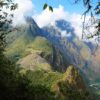
How To Book Tickets To Machu Picchu, Peru
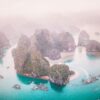
10 Best Places In Vietnam To Visit
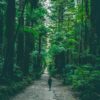
5 Useful Apps To Help When Travelling
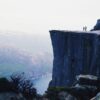
Photos And Postcards From The Nordics

10 Best Bars In Shoreditch, London
- Privacy Policy

Email address:

There's still time to check out Death Valley's wildflower blooms

DEATH VALLEY, Nev. (KTNV) — Right now, parts of the desert are turning technicolor, and there’s still a few more weeks left to check out the spring wildflower blooms in Death Valley National Park.
"It's finally warming up, and so the wildflowers are coming out," said Nichole Andler, chief of interpretation and education for Death Valley.

Andler said that while it’s not technically a super bloom this year, there are still some locations where wildflower growth stretches for miles.
“Over on the west side of the park in Panamint Valley, we are having a really massive bloom over there," she said.
At that location, Channel 13 caught up with Mesquite resident Dianna Brokling, who drove out with her husband and friends from Washington to see the sight.
"We were kind of gobsmacked when we drove down that street," Borkling said. "It's just flowers everywhere. Absolutely stunning.”
Lot’s of locals and visitors from out of state stopped to take photos, including Nadine Bowlling and Brody Wheeler, who were on their way to Ridgecrest from Pahrump.
“It’s spring break, time to hit the road," Bowlling said. “It’s a sight to see, especially living in Pahrump all these years. You don’t see it very often, so I strongly recommend coming to see this.”
There’s still time left to head out to the park and witness the blooms, but they won’t be there for long.
"We are probably going to have wildflowers through at least mid-April, and that's all going to depend on the wind and the heat," Andler explained.
Once you venture out to the desert, take your time and enjoy.
“You need to slow down, get out, take a walk and look down look for the little differences in colors," Andler said.
Report a typo

HOW TO WATCH

National Parks Traveler
Climate change and the parks
National Park Travel
You are here
Death valley national park backcountry permits going online.
Backcountry users enjoy solitude in a designated campsite along Echo Canyon Road/NPS, J. Hallett
Death Valley National Park's backcountry permits for specific areas will be available online beginning April 30.
The online system will make reservations available on Recreation.gov up to six months in advance of start dates. This permit system replaces the current system, which was only available on the same day and in person during business hours at the Furnace Creek Visitor Center or Stovepipe Wells Ranger Station.
This system adds convenience to visitors allowing them to plan ahead and acquire their backcountry permits online. Recreation.gov provides trip planning and reservation services for public lands nationwide and using it for backcountry permits issuance brings the park into alignment with other surrounding public lands. The new backcountry permit fees are $10/per night for Backcountry Roadside Camping Permits and $10/per permit for Wilderness Backpacking Permits. Permit fees will cover costs associated with the new system and fund park projects that provide additional visitor services, address deferred maintenance needs, protect resources, and improve and rehabilitate visitor facilities.
In the fall of 2022, Death Valley National Park acted on the previously developed Wilderness and Backcountry Stewardship Plan by requiring mandatory permits for overnight use of the park’s most popular backcountry areas. This was done to provide a less crowded experience for visitors while limiting impacts to the park’s resources. Permits are a way for the park to communicate with campers about Leave No Trace ethics, current conditions, including hazards, rules and regulations and how they can protect Death Valley. Permit usage information will provide insight for future management decisions to protect the fragile desert ecosystem.
Backcountry permits are required for roadside camping along Cottonwood Canyon, Marble Canyon, Echo Canyon, Hole in the Wall, and Greenwater Valley Roads, and for backpacking in the Cottonwood Canyon and Marble Canyon areas.
Backcountry permits for areas not listed above will continue to be free and optional. For more information where roadside camping and backpacking are allowed visit the park’s backcountry camping page .
- Death Valley National Park
- Parks in the News
- Add new comment
This is only benefits apple and google.
The tech takeover of the nps continues..
Add comment
This question is for testing whether or not you are a human visitor and to prevent automated spam submissions.
The Essential RVing Guide

The National Parks RVing Guide , aka the Essential RVing Guide To The National Parks , is the definitive guide for RVers seeking information on campgrounds in the National Park System where they can park their rigs. It's available for free for both iPhones and Android models.
This app is packed with RVing specific details on more than 250 campgrounds in more than 70 parks. You'll also find stories about RVing in the parks, some tips if you've just recently turned into an RVer, and some planning suggestions. A bonus that wasn't in the previous eBook or PDF versions of this guide are feeds of Traveler content: you'll find our latest stories as well as our most recent podcasts just a click away. So whether you have an iPhone or an Android , download this app and start exploring the campgrounds in the National Park System where you can park your rig.
- Death Valley National Park Tourism
- Death Valley National Park Hotels
- Flights to Death Valley National Park
- Death Valley National Park Restaurants
- Things to Do in Death Valley National Park
- Death Valley National Park Travel Forum
- Death Valley National Park Photos
- Death Valley National Park Map
- All Death Valley National Park Hotels
- Death Valley National Park Hotel Deals
- Death Valley National Park
- Things to Do
- Restaurants
- Vacation Rentals
- Travel Stories
- Rental Cars
- Add a Place
- Travel Forum
- Travelers' Choice
- Help Center
Vacation rental near DV NP - Death Valley National Park Forum
- United States
- California (CA)
- Inyo County
- Death Valley National Park
Vacation rental near DV NP
- United States Forums
- Europe Forums
- Canada Forums
- Asia Forums
- Central America Forums
- Africa Forums
- Caribbean Forums
- Mexico Forums
- South Pacific Forums
- South America Forums
- Middle East Forums
- Honeymoons and Romance
- Business Travel
- Train Travel
- Traveling With Disabilities
- Tripadvisor Support
- Solo Travel
- Bargain Travel
- Timeshares / Vacation Rentals
- California forums
- Death Valley National Park forum

I searched and found some old threads with varying opinions about this, so I thought I'd ask again and see if there were any updated options. We are visiting DV NP 12/28-31. We are a family of 5 with 3 teen boys, so we prefer rentals (AirBnB, etc.) to hotels when possible. I've looked at maps and reviews to get a sense of distance, and it looks like the closest options are in Beatty, which I've seen to be 10-30 minutes from a park entrance. Pahrump, seems to be pretty far but has the best home options, Lone Pine, Amargosa Valley, Bishop, and Kernville are other options.
I've looked at the lodging choices inside the park, too. If we do have to get a hotel, we would probably get two rooms, because it's just not fun with all 5 of us in one room, which makes the park options around $2k for 3 days. There are a couple of $2k home rentals that would be much nicer, but I'm not sure if the distance is worth it. There is also Death Valley Inn; we could do that very inexpensively, but it doesn't have the best reviews. We can do outdated, as long as it's clean.
We do splurge on lodging when it really enhances the trip experience, so I guess I'm just looking for 1) any other options that I'm not thinking of and 2) How bad is an hour drive or so in/out of the park each day? Is it pretty scenery/fun drive, or is it going to detract from our trip? I know that's very subjective, but I'd love to hear your opinions as we make our decision.
Thanks for any advice!
7 replies to this topic
I'd opt to stay inside the park if you can swing it - the lodging options are perfectly adequate, but the location makes up for the lack of frills. With 3 teenage boys, Furnace Creek would probably have more to interest them than Stovepipe Wells. Beatty is OK if you need to stay outside. Amargosa Valley and Pahrump are the very limit of reasonable distance & I wouldn't suggest either one. Lone Pine is a great little town if you're coming from the west on the way in or heading west on your way out. Bishop is way too far and Kernville may as well be on another planet.

How old are your kids? If they are young teens, like age 12-13, smaller, all one gender, less space could be doable; if they are closer to young adults or both boys and girls, then yeah, one hotel room can be cramped if you are staying several days.
Lone Pine is a couple hours from Furnace Creek. It’s one of my favorite places, but it’s too far to commute, including stretches of steep, twisty road. Bishop is 50 miles farther than Lone Pine, with the same mountainous stretches to navigate each time. Kernville… no; that’s 200 miles from Furnace Creek. These are nice places, with fine natural surroundings, some grand scenery along the way, and varying degrees of things to see and do locally; you could actually spend a weekend enjoying any of them. But as a base for visiting Death Valley, you will be spending too much time going back and forth.
Any drive to and from any gateway town will take time, because no town is very near Death Valley. IMO, if you want a vacation rental outside the park for a multi-day stay, you have to pick Beatty simply because it is the nearest, and it has amenities that a family is likely to want for a few days. IDK what places you are considering, but if you’re thinking of the one called Death Valley Getaway Cabins, with the prefabs that look like “park model homes,” they’d probably suit your family. It is toward the north end of town near a mountain, where it looks somewhat rural but is on the edge of “downtown” Beatty. The houses have kitchens and baths. You’ll find services typical of a very small town. No supermarket unless your definition includes Family Dollar, so forget about fresh meat, fruit, or tomatoes (nearest supermarket is 75 miles in Pahrump), but you can get all the canned food, Doritos, Chee-tos, Slim Jims, Jolly Ranchers, Starbursts, frozen waffles or pizza rolls, and giant bottles of soda your stomachs can take. Good local eateries include Gema’s Café, Roadhouse 95, Happy Burro, Smokin’ J’s BBQ, Mel’s Diner, and Death Valley Nut & Candy Co. with jerky and ice cream shops attached. Museum, ATM, churches, county library… what more could anyone ask for in a town of 2000 souls? Not that I would actively recommend staying in a town outside Death Valley, but if a family or other group needs more than a hotel can offer, Beatty is where I would send my cousins or best friends.
Thank you both for the detailed replies! They are all boys and are older teens. None of them want to share a bed any longer- they can deal with it or sleep on the floor if they choose, so that's not a deal breaker per se, but we do try to accommodate those wishes when possible. (Despite my best efforts to be a better teacher, they are also still very messy, and my husband and I do not relish sharing bathrooms with them any longer!) DV getaway cabins are on the short list, but there are two other rental options in Beatty to consider, too. You've both been immensely helpful in helping us to rule out options and narrowing it down to the park and Beatty. Thanks again!
A few thoughts...
Death Valley is HUGE, and you can spend considerable time driving within the park from one attraction to another. For example, the time from Furnace Creek to (one-way):
Ubehebe Crater - 90 min.
Mesquite Flats Sand Dunes - 30 min.
Badwater Basin - 30 min.
Dante's View - 45 min.
Panamint Springs - 60 min.
Father Crowley Overlook - 75 min.
And that's wheels-turning driving time. Throw in stops along the way, and it's longer.
The other factor is the amount of daylight available during your visit in December. On the days you're in the park, the sun will rise at 7 a.m. and sets at 4:40 p.m., so that limits what you can see or do during daylight hours.
I know you pay through the nose to stay at The Ranch (I've done it twice), but location, location, location makes it worth it in my book.
Death Valley is an other-wordly, amazing place that you'll love. Enjoy your trip.
Thank you, I didn't consider the amount of daylight. I think we are now leaning towards staying in the park. Will see if we can deal with one room or will splurge for two.
Thanks again!!
You may not be able to find accommodations for 5 adult-size people in one room, due to fire restrictions required by the motel.
This is a smaller resort 25 miles NW of Furnace Creek, about a half hour. In Death Valley, mileage is usually not a major factor because there is rarely much traffic and the scenery is marvelous any time, in any direction, so you have less of the feeling that you are “commuting.” Stovepipe is near Mesquite Sand Dunes and Mosaic Canyon, a bit closer to Ubehebe Crater and Rhyolite/Beatty than Furnace Creek, and within reasonable range of Father Crowley Vista and even Lone Pine and Mt. Whitney if you want to explore farther during your stay.
If, as you said, everyone can deal with some cozy togetherness for a few days, this might work out. Some years ago I had friends visit me in the park and stay in one of those suites – parents with boys 16 and 8, and it worked for them. The resort has changed management a couple of times since then, but the basic room sizes should be the same. If you fear that your kids are terrible slobs 😲, tell them the hotel will charge an extra fee for excessive cleaning and each of them will share in the cost, no matter who made the mess! 😆 (Or rent two adjoining rooms, which might be doable for you with currently posted rates of $226).
https://www.stovepipedeathvalley.com/
- *least* winding route from Northern CA to DV? 8:00 pm
- LA and DVNL in May this year... 6:50 pm
- December Trip Question 2:23 pm
- Vacation rental near DV NP yesterday
- Last Minute First Time Camper yesterday
- Remote backcountry adventure with lots of mining history Apr 06, 2024
- When to visit: Short hiking, sightseeing, added vegas trip Apr 06, 2024
- Trip Report - March 25-26 Apr 02, 2024
- Sacramento to death valley Mar 30, 2024
- Flowers next week Mar 27, 2024
- 4th day in Death Valley: revo for hikes ? Mar 26, 2024
- 2.5 day mid-March to DV (itinerary help) Mar 20, 2024
- Draft Itinerary - March 25-26 Mar 17, 2024
- Wildlife area on way from Las Vegas Mar 16, 2024
- Driving Las Vegas to Yosemite - Where to stop 17 replies
- best route from los angeles 3 replies
- Yosemite to Death Valley 10 replies
- How many days to stay in Death Valley? 6 replies
- Driving through Death Valley in August -advice please! 9 replies
- april weather in DV 4 replies
- 3 day itinerary 12 replies
- From Las Vegas to LA via Death Valley 8 replies
- Weather in December 6 replies
- Drive time to South Grand Canyon 3 replies
Death Valley National Park Hotels and Places to Stay
- ROUTES to Death Valley? How far to ____ ? What maps to use?
- LODGING: Where should we stay to enjoy Death Valley? (Jan. 2024 update)
- CAMPING - where and when can we camp in Death Valley?
- LAS VEGAS one-day turnaround trips - what can we see?
- BACKCOUNTRY road conditions - can I get to ...?
- WILDFLOWERS - will this be a superbloom year?
- WILDLIFE - do they bite? Is Death Valley wildlife dangerous?
- SUMMER - is it safe to go to Death Valley?
- WINTER - does it exist in Death Valley, or does summer last forever?
- SCOTTY'S CASTLE - what's happening?
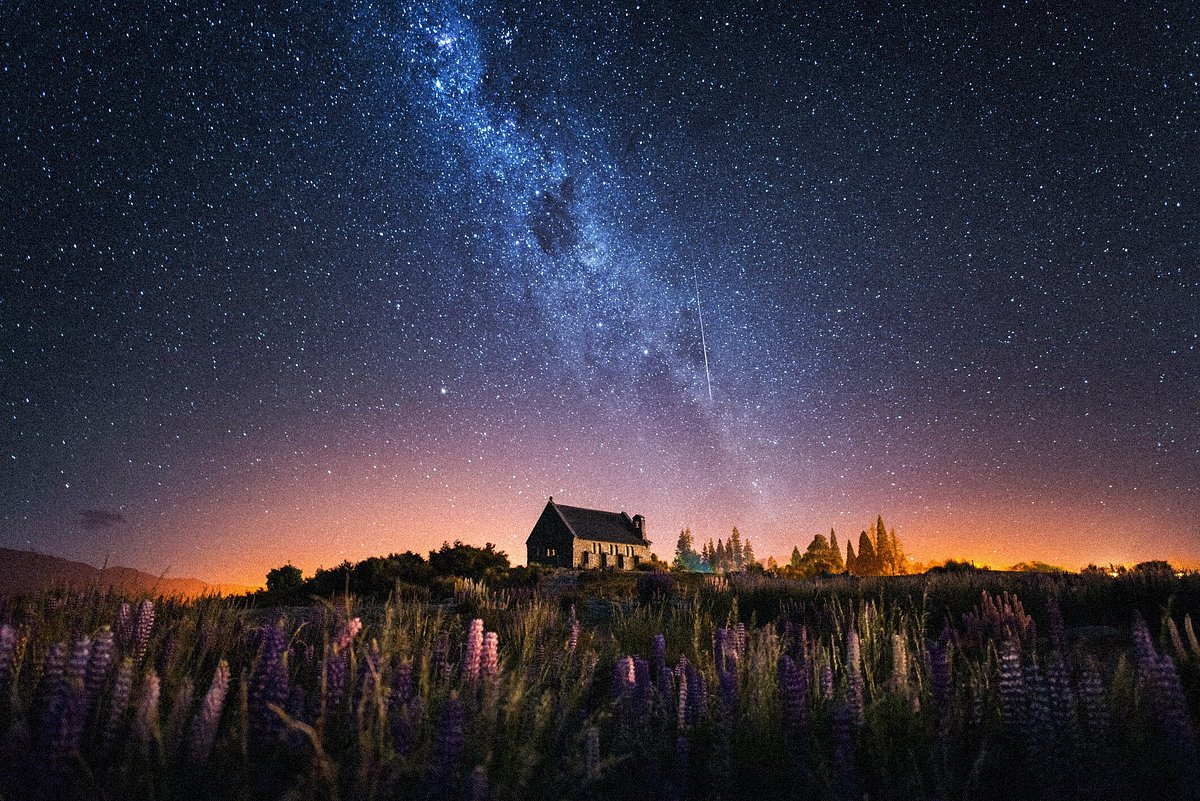
- Skip to main content
- Keyboard shortcuts for audio player

Solar eclipse 2024: Follow the path of totality
Thinking of taking a last-minute drive to see the eclipse here's what to know.

Geoff Brumfiel

RV traffic sits at a standstill along a two-lane road near Madras, Ore., a few days before the 2017 total solar eclipse. Experts say traffic could be heavy, but eclipse watchers shouldn't necessarily be deterred. AFP Contributor/AFP via Getty Images hide caption
RV traffic sits at a standstill along a two-lane road near Madras, Ore., a few days before the 2017 total solar eclipse. Experts say traffic could be heavy, but eclipse watchers shouldn't necessarily be deterred.
NASA says that roughly 31.6 million people live in the path of this year's total solar eclipse, and a little under half of the U.S. population lives within 200 miles driving distance of the path of totality .
That could mean many millions of Americans will hit the road to get a better view on April 8. If you're still pondering whether or not you want to make the journey, here's what to consider.
Have some destinations in mind, and check the weather and cloud cover forecasts in advance
It's a good idea to scout out one or more locations within driving distance, so that you have some flexibility if traffic or weather is threatening your plans, says Jonathan Upchurch, a professor emeritus of civil engineering at Arizona State University who has studied travel around solar eclipses.
There are several interactive tools that show the path of totality, including Eclipse2024.org and the National Solar Observatory . You can use them to figure out what sites might work best for you.
In terms of weather, check not just the weather forecast, but also the cloud cover forecast. Some websites, such as Windy.com will predict cloud cover ahead of time, giving you a sense of whether you'll actually be able to see the eclipse in all its glory.

Everything you need to know about solar eclipse glasses before April 8
During the total solar eclipse in 2017, Upchurch says he chose to go to Idaho "because there were some great chances of having sunny skies, and I had the opportunity to be nimble and relocate if I wanted to."
Before driving into the path of totality, make sure your gas tank is full and that you've got everything you need
During the last total solar eclipse in 2017, it's estimated some 5 million people took to the roads, and those numbers will potentially be much higher this year.
Given all that, Upchurch says it's important to make sure you're taking what you need into the path of totality. You should make sure your car is gassed or charged up, and that you have plenty of snacks and water with you in case you get stranded for a while, especially when trying to leave.

Solar Eclipse 2024: Totality stretches from Texas to Maine
Simple tips to safely photograph the eclipse with your cellphone.
Also don't forget to bring eclipse glasses, which must be worn anytime you're looking at the sun, except for the few minutes when it is completely blocked by the moon.
Some state emergency planners also recommend bringing a paper map or road atlas in case cellular networks become overloaded with visitors seeking directions from their phones.

Don't forget your eclipse glasses everyone! Erika Goldring/FilmMagic hide caption
Don't forget your eclipse glasses everyone!
Arrive early and stay late
Once you figure out where you're going to watch the eclipse, and you've got your supplies, try to get there early. Although traffic is likely to be heavier than normal on the morning of eclipse day, it still should be possible to reach many destinations without too much hassle, says Upchurch.
"Leaving is definitely going to be more of a problem," he says. As the eclipse concludes, people will take to the roads all at once to try and get home as fast as they can. In 2017, that led to traffic jams that lasted many hours in some areas. If possible, Upchurch says, people should stay put for a while to try and avoid the worst of the post-eclipse rush, which in 2017 stretched even into the following day in some parts of the country.

Here's what time the eclipse will be visible in your region
And one more thing: If you do find yourself on the move near the time of the eclipse, state officials stress that you should not simply pull over to the side of the road or highway you're driving on. It's important to be parked legally and safely at the moment of totality.
If you're already in the path of totality: Relax and enjoy!
Several major metropolitan areas including Dallas, Indianapolis, Cleveland and Buffalo are already inside the path of totality, so there's no need to seek a better view, Upchurch says. You'll probably have the most fun simply staying where you are.

Shots - Health News
Watching a solar eclipse without the right filters can cause eye damage. here's why.
If you're on the edge of the path of totality, however, you might consider making a short trip to get closer to the center of the eclipse's path.
"If you're within about 40 miles of the center line, you'll have two-and-a-half minutes or more" of complete totality, Upchurch says. It's up to you to decide whether it's worth making the trip to a more central location.
Despite studying the potential hassles of traveling extensively, Upchurch says he's still looking forward to seeing the 2024 eclipse, which he plans to watch from Texas.
"Totality is absolutely spectacular," he says. "If you have a chance to witness it, I would do it."
- 2024 solar eclipse
- eclipse 2024
- 2024 eclipse
- Traffic patterns
- total eclipse
- Skip to global NPS navigation
- Skip to this park navigation
- Skip to the main content
- Skip to this park information section
- Skip to the footer section

Exiting nps.gov
Alerts in effect, death valley summer visit.
Last updated: June 4, 2023
Park footer
Contact info, mailing address:.
P.O. Box 579 Death Valley, CA 92328
760 786-3200
Stay Connected

IMAGES
COMMENTS
Things To Do. Death Valley is a vast national park with over three million acres of designated Wilderness and hundreds of miles of backcountry roads. The park contains an amazing variety of terrain, historic sites, plants and animals for outdoor adventurers to explore. It is your responsibility to leave no trace of your visit so everyone can ...
25. Marble Canyon. Starting our list of the best things to do in Death Valley National Park is one of the coolest activities (literally) and a hidden gem. The hike through Marble Canyon is a great hot daytime activity (so long as you're prepared) as there is typically ample shade and places to rest.
21. Do Some Stargazing. As a Gold Tier Dark Sky National Park, Death Valley offers some of the best stargazing and astrophotography opportunities in the country. While you can enjoy stargazing and photographing the night sky year round, the park holds special dark sky events in the winter and the spring.
Finally, Death Valley has a number of roads within the park, but the most important ones you need to know for my recommended Death Valley itinerary are: California 190 (CA-190), which bisects the park from east to west (more or less). Badwater Road, which runs north-south from Furnace Creek to Badwater Basin.
3,058. Bodies of Water. Located in Death Valley, this small salt pond is more than 280 feet below sea level, making it the lowest point in North America. See full details. See ways to experience (13) 2023. 4. Artist's Drive.
5. Dantes View. Dantes View. Dante's View offers one of the best overall perspectives of Death Valley. The view from the top looks out over the valley floor, as far as the eye can see, and across to the mountains that line the far side of the valley. This lookout is a little out of the way but worth the effort.
Quick Summary: The 5 Best Highlights of Death Valley 1 Badwater Basin 2 Artist's Palette 3 Mesquite Sand Dunes 4 Zabriskie Point 5 Dante's View. The Best Things To Do in Death Valley National Park. At more than 3.3 million acres, Death Valley is the largest national park in the lower 48 United States, trailing only four Alaska parks in size ...
1. Badwater Basin. Of all the things to do in Death Valley, this is definitely the main attraction in the park. Badwater Basin is the lowest point in North America at 282-feet below sea level. There's a small parking area here, a boardwalk, and a trail to the salt flats.
4. Twenty Mule Team Canyon. Located near Zabriskie Point, Twenty Mule Team Canyon is an often-missed spot and one of the most underrated things to do in Death Valley. It is essentially a 2.7-mile road that features some incredible scenery and is surrounded by rock walls, mesas and hills.
It is the hottest and driest place in North America, and Badwater Basin is the lowest spot on the continent. Whew, Death Valley National Park has a lot going on, but that's not all! Located in both California and Nevada, Death Valley National Park was established in 1994 after holding the title of Death Valley National Monument for five decades.
Day 1 - Death Valley Itinerary. Take the entrance from the west side of the park at Father Crowley Vista Point for the sunrise. Head to the Darwin Falls two-mile trail for an early morning hike. Check-in at Stovepipe Wells Hotel and grab a meal. At midday, check out the Mesquite Flat Sand Dunes.
15. Seek Out the Star Wars Sites -. The Furnace Creek Visitors Center can provide a map of filming locations from the original Star Wars movies, which used Death Valley to create the harsh environment of Luke's home planet Tatooine. You see Luke and the droids wandering across the dunes in the original movie.
2. Badwater Basin. At 282 feet (85.5 meters) below Sea Level, Badwater Basin is the lowest point in North America and one of the lowest elevations on earth. This is the place that made Death Valley famous and is one of the most visited sites in the park. And indeed, Badwater Basin is absolutely worth a visit.
Best Time To Visit Death Valley National Park in the Winter. February is the best winter month to visit Death Valley National Park. The temperatures are warmer, with lows in the upper 40s and highs in the mid-70s. Not only is the weather ideal during February, but the crowds are much lighter. However, there is a greater chance of rain.
Best Things to Do in Death Valley National Park. Catch the Sunrise at Dante's View. Hang Out At America's Lowest Point: Badwater Basin. Marvel at the Views from Zabriskie Point. Hike Over The Mesquite Flat Sand Dunes. See the Volcanic Remains at Ubehebe Crater.
One of the most fascinating places to visit in Death Valley National Park is the Wildrose Charcoal Kilns. These historic structures were used to produce charcoal nearly 150 years ago, and they ...
Hottest, Driest and Lowest National Park. In this below-sea-level basin, steady drought and record summer heat make Death Valley a land of extremes. Yet, each extreme has a striking contrast. ... Find out where you can stay, where you can visit, and what you can do. Dark Sky Festival 2024. Click to check out this year's schedule! Camping.
Death Valley National Park is one of the most inhospitable and beautiful areas of California to visit. This all makes it a totally unique and gorgeous - 10 Best Places To See In Death Valley National Park - Travel, Travel Advice - California, Death Valley, North America, United States - Travel, Food and Home Inspiration Blog with door-to-door Travel Planner! - Travel Advice, Travel Inspiration ...
DEATH VALLEY, Nev. (KTNV) — Right now, parts of the desert are turning technicolor, and there's still a few more weeks left to check out the spring wildflower blooms in Death Valley National Park.
Death Valley National Park's backcountry permits for specific areas will be available online beginning April 30.. The online system will make reservations available on Recreation.gov up to six months in advance of start dates. This permit system replaces the current system, which was only available on the same day and in person during business hours at the Furnace Creek Visitor Center or ...
2 reviews. 1. Re: Vacation rental near DV NP. Apr 6, 2024, 8:11 PM. Save. I'd opt to stay inside the park if you can swing it - the lodging options are perfectly adequate, but the location makes up for the lack of frills. With 3 teenage boys, Furnace Creek would probably have more to interest them than Stovepipe Wells.
NASA says that roughly 31.6 million people live in the path of this year's total solar eclipse, and a little under half of the U.S. population lives within 200 miles driving distance of the path ...
Carry and drink plenty of water in the summer months. Death Valley is the hottest place on Earth. In the summer months (May-September) temperatures average over 100°F (38°C), and often exceed 120°F (49°C). Many visitors come here in the summer specifically to experience the extreme heat. The main points of interest remain open, but it is ...